FEATURING 341 Industry-First Reviews of Fiction, Nonfiction, Children’s, and YA Books


ATTICA LOCKE LOOKS TO THE FUTURE OF CRIME FICTION
The award-winning novelist headlines a special issue dedicated to mysteries and thrillers


FROM THE EDITOR’S DESK




FEATURING 341 Industry-First Reviews of Fiction, Nonfiction, Children’s, and YA Books


The award-winning novelist headlines a special issue dedicated to mysteries and thrillers


FROM THE EDITOR’S DESK



Mystery novels made me a reader. Let me qualify that: Mystery novels made me an adult reader; I’d already established the habit through children’s series like Little House on the Prairie and the Chronicles of Narnia. But classic whodunits by the grand dames of the genre— Agatha Christie and Dorothy L. Sayers—were the first adult books that I read and devoured, making me feel that I’d been admitted to an elite club where I could be entrusted with any subject or theme (and if I didn’t understand something, I’d figure it out). There was no turning back.
Thirteen-year-old me would have marveled that I’d quite literally joined the club when I attended the Edgar Allan Poe Awards ceremony, hosted by the Mystery Writers
of America, in New York earlier this year. Even better, I was seated at the Grove Atlantic table, along with publisher Morgan Entrekin, who accepted the award for best novel (James Lee Burke’s Flags on the Bayou) since the author was unable to attend. I couldn’t resist snapping a close-up photo of the Edgar trophy (it’s cute!) to post on Instagram.
This issue’s cover subject, Attica Locke, won the Edgar Award for best novel back in 2018 for Bluebird, Bluebird, the first of her novels about Black Texas Ranger Darren Matthews. Locke has now wrapped up that series with Guide Me Home (Mulholland Books/Little, Brown, Sept. 3), and on page 12 she talks with contributor Connie Ogle about her decision to stop with Book 3 (she originally
Frequently Asked Questions: www.kirkusreviews.com/about/faq
Fully Booked Podcast: www.kirkusreviews.com/podcast/
Advertising Opportunities: www.kirkusreviews.com/book-marketing
Submission Guidelines: www.kirkusreviews.com/about/publisher-submission-guidelines
Subscriptions: www.kirkusreviews.com/magazine/subscription
Newsletters: www.kirkusreviews.com
For customer service or subscription questions, please call 1-800-316-9361
envisioned six or seven entries) and her evolving feelings about law enforcement and guns. It’s a fascinating portrait of an evolving writer, and it leaves us eager to see what Locke (who’s also been a screenwriter for series such as Empire and Little Fires Everywhere) does next.
For this special Mystery Issue, we wanted to provide a snapshot of crime fiction as it is evolving today. (And nonfiction, too: On page 50, contributing writer Gregory McNamee rounds up some new stranger-thanfiction true-crime books.)
Laurie Muchnick spotlights some of her favorite mysteries this year (p. 4), young readers’ editor Mahnaz Dar celebrates the joys of the middle-grade mystery (p. 88), editor at large Megan Labrise talks with graphic novelist Sara Varon about how the ’80s TV show Murder, She Wrote inspired her new canine whodunit for children, The Case of the Golden Bone (p. 98), young readers’ editor Laura Simeon recommends YA mysteries for teen
readers (p. 136), contributor Marion Winik talks with bestselling YA phenom Maureen Johnson about her latest, Death at Morning House (p. 144), and senior Indie editor David Rapp pinpoints Texas as the setting for some outstanding self-published crime novels (p. 160).
Working on this issue certainly whet my appetite for the genre—especially the books from its 1930s heyday. Fortunately, publishers are bringing back forgotten classics and discovering overlooked gems. Two recent titles that caught my eye: Golden Age Whodunits, edited by Otto Penzler (American Mystery Classics, July 2), which collects 15 stories by Ellery Queen, Anthony Boucher, and others; and The Black Spectacles (Poisoned Pen, June 18), a 1939 mystery by John Dickson Carr. If you need me, I’ll be on my living room couch, solving crimes.



ISBN: 978-1-66-295017-9
“Flynn combines the best of noir detective fiction with spartan, a ecting prose.”
“Overall, it’s a riveting whodunit with surprising twists that call to mind the works of Raymond Chandler.”
“An a ecting and compelling crime novel.”
—Kirkus Reviews
For Information on Publishing and Film Rights, Email
Co-Chairman
HERBERT SIMON
Publisher & CEO
MEG LABORDE KUEHN mkuehn@kirkus.com
Chief Marketing Officer
SARAH KALINA skalina@kirkus.com
Publisher Advertising & Promotions
RACHEL WEASE rwease@kirkus.com
Indie Advertising & Promotions
AMY BAIRD abaird@kirkus.com
Author Consultant
RY PICKARD rpickard@kirkus.com
Lead Designer KY NOVAK knovak@kirkus.com
Kirkus Editorial Senior Production Editor
ROBIN O’DELL rodell@kirkus.com
Kirkus Editorial Senior Production Editor
MARINNA CASTILLEJA mcastilleja@kirkus.com
Kirkus Editorial Production Editor ASHLEY LITTLE alittle@kirkus.com
Copy Editors
ELIZABETH J. ASBORNO BILL SIEVER
Magazine Compositor
NIKKI RICHARDSON
Contributing Writers
GREGORY MCNAMEE MICHAEL SCHAUB
Co-Chairman
MARC WINKELMAN
Editor-in-Chief TOM BEER tbeer@kirkus.com
President of Kirkus Indie CHAYA SCHECHNER cschechner@kirkus.com
Fiction Editor
LAURIE MUCHNICK lmuchnick@kirkus.com
Nonfiction Editor JOHN McMURTRIE jmcmurtrie@kirkus.com
Young Readers’ Editor LAURA SIMEON lsimeon@kirkus.com
Young Readers’ Editor MAHNAZ DAR mdar@kirkus.com
Editor at Large MEGAN LABRISE mlabrise@kirkus.com
Senior Indie Editor DAVID RAPP drapp@kirkus.com
Indie Editor ARTHUR SMITH asmith@kirkus.com
Editorial Assistant NINA PALATTELLA npalattella@kirkus.com
Indie Editorial Assistant
DAN NOLAN dnolan@kirkus.com
Indie Editorial Assistant SASHA CARNEY scarney@kirkus.com
Mysteries Editor THOMAS LEITCH

Nada Abdelrahim, Colleen Abel, Mahasin Aleem, Brian Alessandro, Paul Allen, Stephanie Anderson, Jenny Arch, Mark Athitakis, Diego Báez, Audrey Barbakoff, Sally Battle, Robert Beauregard, Thomas Beheler, Heather Berg, Elizabeth Bird, Amy Boaz, Rhea Borja, Kimberly Brubaker Bradley, Cliff Burke, Catherine Cardno, Hailey Carrell, Tobias Carroll, Charles Cassady, Tamar Cimenian, Caridad Cole, K.W. Colyard, Rachael Conrad, Adeisa Cooper, Jeannie Coutant, Perry Crowe, MaryEllen D’Elia, Kim Dare, Michael Deagler, Cathy DeCampli, Dave DeChristopher, Elise DeGuiseppi, Amanda Diehl, Steve Donoghue, Anna Drake, Jacob Edwards, Gina Elbert, Lisa Elliott, Lily Emerick, Chelsea Ennen, Rosalind Faires, Joshua Farrington, Brooke Faulkner, Hillary Jo Foreman, Renee Fountain, Jenna Friebel, Roberto Friedman, Nivair H. Gabriel, Omar Gallaga, Laurel Gardner, Cierra Gathers, Carol Goldman, Amy Goldschlager, Melinda Greenblatt, Tobi Haberstroh, Geoff Hamilton, Peter Heck, Lynne Heffley, Matthew Heller, Mara Henderson, Zoe Holland, Abigail Hsu, Wesley Jacques, Jessica Jernigan, Danielle Jones, Betsy Judkins, Mikayla Kaber, Marcelle Karp, Ivan Kenneally, Colleen King, Stephanie Klose, Lyneea Kmail, Maggie Knapp, Alexis Lacman, Megan Dowd Lambert, Christopher Lassen, Hanna Lee, Judith Leitch, Maya Lekach, Donald Liebenson, Maureen Liebenson, Coeur de Lion, Barbara London, Patricia Lothrop, Kyle Lukoff, Leanne Ly, Kaia MacLeod, Joan Malewitz, Mandy Malone, Thomas Maluck, Francesca Martinez, Gabriela Martins, J. Alejandro Mazariegos, Breanna McDaniel, Kathie Meizner, Tara Mokhtari, Clayton Moore, Rebecca Moore, Andrea Moran, Yesha Naik, Christopher Navratil, Liza Nelson, Mimi Nguyen, Randall Nichols, Therese Purcell Nielsen, Katrina Nye, Tori Ann Ogawa, Connie Ogle, Mike Oppenheim, Emilia Packard, Derek Parker, Hal Patnott, Deb Paulson, John Edward Peters, Jim Piechota, Christofer Pierson, Margaret Quamme, Kristy Raffensberger, Kristen Rasmussen, Darryn Reams, Nancy Thalia Reynolds, Jasmine Riel, Erica Rivera, Kelly Roberts, Amy Robinson, Bella Rodrigues, Christopher R. Rogers, Lizzie Rogers, Kristina Rothstein, Lloyd Sachs, Bob Sanchez, Keiko Sanders, E.F. Schraeder, Gene Seymour, Jerome Shea, Madeline Shellhouse, Linda Simon, Jennifer Smith, Leena Soman, Margot E. Spangenberg, Mo Springer, Allison Staley, Allie Stevens, Mathangi Subramanian, Deborah Taylor, Eva Thaler-Sroussi, Desiree Thomas, Bill Thompson, Renee Ting, Lenora Todaro, Laura Villareal, Christina Vortia, Francesca Vultaggio, Elliott Walcroft, Audrey Weinbrecht, Kerry Winfrey, Marion Winik, Livia Wood, Bean Yogi, Jean-Louise Zancanella

The great thing about reading a mystery is that you know things will get tied up at the end; whether the book is a whodunit or a why-didthey-do-it, you’re going to get answers. And that makes mysteries perfect reading for an anxiety-ridden election season. Here are some of the best ones that have come out this year.
The Unwedding by Ally Condie (Grand Central, June 4): Condie, known as the author of bestselling books for children and young adults, including the dystopian Matched Trilogy, is now making her adult debut. Recently divorced Ellery Wainwright checks into a luxury Big Sur resort for the vacation she and her ex-husband had planned to

celebrate their 20th anniversary. That turns out to be a big mistake even before Ellery finds a man floating facedown in the pool—a man who was supposed to get married the day before but never showed up for his wedding. Then there’s a big storm, and Ellery’s got an Agatha Christie–like locked-room mystery on her hands. “A gorgeous murder mystery that explores what it means to be human—the pain and the love,” says our starred review.
It’s Elementary by Elise Bryant (Berkley, July 9): Another YA novelist making her adult debut, Bryant sets her book at a Southern California elementary school. Single mother Mavis Miller—one

of the school’s only Black parents—doesn’t really want to serve on the PTA’s DEI committee, but she does, which is why she’s at the meeting where the principal and the PTA president get into a heated fight. Then the principal goes missing, and Mavis remembers that she saw the president dragging trash bags from the school to her car. Our starred review says Mavis’ “narration evinces a razor-sharp wit, complementing the clever, twist-riddled plot.”
Death in the Air by Ram Murali (Harper, June 18): Like The Unwedding, Murali’s debut novel is set at a glamorous resort: Indian American jet-setter Ro Krishna is vacationing at an Ayurvedic spa in the

foothills of the Indian Himalayas when a guest is murdered. There’s a local detective, and there also happens to be a CIA agent at the resort, but Ro, of course, feels the need to lend a hand. “The easy rapport of the people at the spa creates a lovely foundation for the psychological intrigue of the mystery,” according to our starred review.
Death in the Details by Katie Tietjen (Crooked Lane, April 9): In another debut novel, we’re introduced to Mabel “Maple” Bishop, a lawyer who’s been widowed by World War II. She’d moved to Vermont with her late husband, a doctor, and finds herself still regarded as an outsider, especially since no one wants a female lawyer. Her hobby of creating highly detailed dollhouses turns into a means of supporting herself—and then leads to detective work when she finds her first customer’s husband dead in their barn. Drawing on the life of Frances Glessner Lee, a real-life pioneer of forensic science, “Tietjen gives all of her characters rich, full inner lives as they interact in ways that are both aesthetically and morally complex,” according to our starred review.

Laurie Muchnick is the fiction editor.
Just because he’s in prison doesn’t mean John Rebus can’t keep solving crimes, even if he does need a little help from outside.
Convicted of attempted murder after his attempt to scare Morris Gerald Cafferty—the unsavory client he’d taken on while working as an unofficial private eye in A Heart Full of Headstones (2022)—led to the man’s fatal heart attack, Rebus has been doing time in HMP Edinburgh. Howard Tennent, the prison governor, wants to move him from isolation to the general population in Trinity, where Cafferty’s successor, Darryl Christie, guarantees to protect him (yeah, right). Things work
out less well for Jackie Simpson, who’s been jailed for breaking into a nail bar owned by Everett Harrison, an enforcer for Liverpool refugee smuggler Shay Hanlon. Simpson’s found stabbed to death, his cellmate Mark Jamieson knocked out by drugs that mysteriously got into his system. As Rebus asks cautious questions around his cellblock while trying not to annoy anyone (quite a stretch for him), his former colleague DI Siobhan Clarke hunts for missing schoolgirl Jasmine Andrews. The two cases couldn’t be more remote from each other—until the murder of ex-footballer Zak Campbell forges a link between them without
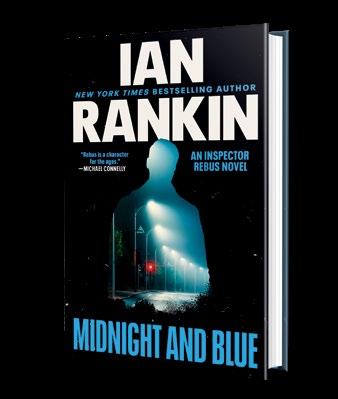
Rankin, Ian | Mulholland Books/Little, Brown
giving the slightest indication of who’s guilty. That may be because almost everyone in Police Scotland looks just as guilty as the inmates at Trinity. The special appeal of the entry in this celebrated series is its vividly detailed portrait of the labyrinthine corridors of
power in the prison, where everything is available for a price, and its unsettling connections to the corridors of power outside.
It’s inspiring to see that prison, along with the rotten system it represents, hasn’t gotten Rankin’s battered hero down.
BLOOD ON THE BRAIN
Adiga, Ranjan | Univ. of Wisconsin (164 pp.) $17.95 paper | Oct. 8, 2024 | 9780299348441
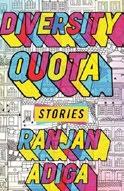
Ten stories about the plights and successes of Nepalis in both Nepal and the United States. In “Leech,” an unlikely bond between Ram, a member of the Madhesi minority and the son of two migrant farmers, and Juneli, a wealthy leftist activist from Kathmandu, is tested when Ram discovers a leech in his nose and can’t afford to visit a doctor. In “A Short Visit,” Nirmal’s Nepali father’s visit to his son in Denver reveals the intergenerational alcoholism that threatens to damage their family dynamic and their lives. In “Spicy Kitchen,” which takes place at a failing Indian restaurant in Utah, the Nepali narrator’s insecurity about his immigrant status causes competition with his Somali refugee coworker and disgruntlement with his bosses. In “The Diversity Committee,” a Nepali professor at a liberal arts college in Idaho crosses a line with a white student, forcing him to reckon with his relationship to women and his position of power as a professor. These stories share many similar details—familial expectations, struggling bachelors, immigrant outposts in underpopulated western and Midwestern American states—but each character is facing a distinct and individual set of circumstances. Adiga deftly complicates the conventional politics around immigrant narratives, instead drawing out the tender, lonely, shameful, and devoted qualities of his characters; he fruitfully pays equal attention and care
to the ill-at-ease immigrants in America and the isolated, stubborn, wealthy stay-at-home mother in Nepal. A thoughtful, encapsulating portrait of Nepali life.
Bándélé, Biyi | Harper/HarperCollins (288 pp.)
$26.99 | Sept. 3, 2024 | 9780063417083

Time and space are willfully shifted around in this historical fiction inspired by the life of a Nigerian-born man who, after having been enslaved, became a clergyman, linguist, and abolitionist in the 19th century.
Samuel Àjàyí Crowther (ca. 18091891) set an astonishingly triumphant example for his fellow West Africans in his rich, accomplished lifetime. After he was freed from Portuguese slavers by Britain’s Royal Navy and left in Sierra Leone, he added the first and last names to the one he’d had from birth, studied languages, and was eventually ordained an Anglican minister. He translated the Bible and other church texts into Yoruba, became the first African bishop of the Anglican Church, and campaigned against the slave trade throughout his life. This posthumously published novel by Bándélé (19672022), who was also a celebrated playwright and filmmaker in his native Nigeria, presents an impressionistic, mostly nonlinear narrative of this extraordinary life, beginning with Àjàyí’s childhood in his hometown of Ós . ogún just before it is laid siege by the “Malian swordmen” who sold its
thousands of residents into slavery. He tells his mother of a premonition he had of a god of “health and well-being” looking malarial, a sign of troubles ahead. Bándélé imposes his own imaginative resources on this and subsequent events of Crowther’s life. Only occasionally do Bándélé’s imaginative projections lead him to an anachronism—“We have heard of white men who turned the ocean into a highway,” Ájàyí’s mother tells him early on—but not often enough to obstruct the novel’s rich stew of historical perspective, storytelling brio, and humane insight. He shows as much acumen in staging conversations between the older, much-traveled Crowther and the people of his erstwhile homeland as he does in rendering a real-life meeting Crowther had with Queen Victoria and Prince Albert, whom he holds spellbound when he recites the Lord’s Prayer in Yoruba. The novel’s collagelike approach to Crowther’s story not only gives a rich sense of the dimensions of his achievement, but also offers a keener, broader perspective as to the nature of African slavery and those who were complicit in its execution, making Bándélé as effective a historian as he was a dramatist.
You’ll leave this book fulfilled in knowledge of its main subject, yet still yearning to know more.
Bediako, Esinam | Red Hen Press (248 pp.)
$18.95 paper | Sept. 17, 2024 | 9781636281803
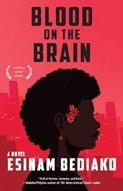
A young Ghanaian American woman fights through a complicated quarter-life crisis.
Akosua Agbe is a 24-year-old graduate student in history living in New York City. But instead of enrolling in classes, she pores over the course catalog until well after the term is underway. She’s recently broken up with her boyfriend, Wisdom, a medical student she still
loves, because he didn’t think she was Ghanaian enough for him, calling into question her sense of self. Akosua tries to pursue another Ghanaian fellow on campus, Daniel, but he rejects her and then toys with her emotions. He also gives her some devastating news: Her father, who abandoned her when she was 7, is also in New York, teaching at another college. Amid this turmoil, Akosua falls in the shower and hits her head. At first, she doesn’t think she’s been hurt too badly, but as Thanksgiving approaches, it becomes clear she’s sustained a serious head injury that’s causing debilitating symptoms. The people in her life just want her to heal and learn to take better care of herself. Akosua comes to realize that might mean defying her loved ones’ expectations of her and learning how to make her own choices. Debut author Bediako captures well that poignant moment in a young person’s life when they must differentiate their own desires from their family’s and community’s to forge their own path. The trauma to Akosua’s brain amplifies just how much she was allowing inertia, an adolescent need to seek approval and please her elders, to dictate her next steps—or lack thereof. She can’t own her decisions until she fully makes them herself. Bediako highlights how that’s easier said than done, especially while straddling two cultures and identities.
Smartly covers a few weeks of upheaval that push its heroine closer to adulthood.
Blue, Maame | Amistad/ HarperCollins (240 pp.) | $27.99 Oct. 8, 2024 | 9780063375963
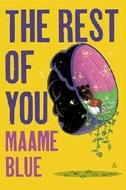
Whitney Appiah has just turned 30. Traumatized by a recent sexual attack, she is beginning to experience splintered dreams of her early childhood in Ghana, which she left with the aunt she calls Ma Gloria when she was 3, after the deaths of both her parents. Back in Ghana in 1995, the point of view shifts between Gloria and her younger sister, Aretha, who have helped raise Whitney since her mother died in childbirth and who observe the events leading up to the death of Whitney’s father and Gloria’s move with Whitney to London. Over the course of a year, with the help of her friends Chantelle and Jak as well as considerable pressure put on the loving but reluctant Gloria, Whitney begins to make sense of the past that has been concealed from her. The novel’s London sections are written in second person (“You felt like you were vibrating, the music adding to the pounding in your chest”), though it’s not clear why. The novel’s primary strength lies in its rich depiction of the lives of young women who have emigrated to London from around the world, whether in childhood or later, as they make the most of what the city has to offer and find their ways through multiple life changes. The secrets of Whitney’s past aren’t likely to surprise the reader, and some significant threads, including a supposed family curse and a revenge plot, are left dangling. Blue’s sympathetic, complex characters deserve a more developed story.
Kirkus Star
Burke, Katherine Packert | Norton (272 pp.)
$28.99 | Sept. 10, 2024 | 9781324076360
A young Ghanaian British masseuse comes to terms with longburied memories.
Blue’s first novel to be published in the U.S. moves between London in the present day and Ghana in the mid-1990s. In the present,
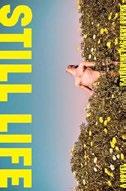
A transgender woman struggles to write about her tangled relationship with two women—one living and one dead—in this keenly observed debut. Edith met Tessa and Valerie in Boston during college, before she
knew she was a girl. Tessa identified as a lesbian and Valerie was a transgender girl from Texas who began her transition at 18. Both embraced the ostensibly straight, cisgender male Edith as a friend, while Edith harbored a secret crush on Tessa that she believed would not and could not result in anything real. But as is so often the case, identities, desires, and priorities shifted as the trio moved toward adulthood. Now, six years after Edith left the East Coast for graduate school, she’s living in Austin, largely estranged from Tessa, and Valerie is gone, having died in a car crash. Edith’s abiding love for Stephen Sondheim’s work— particularly Merrily We Roll Along and Into the Woods —brings questions about cause and effect and the value of wishes to the forefront of her mind. When a trip back to Boston, the deadline for a draft of her second novel, and the decision whether or not to stay in an increasingly transphobic Texas all converge, Edith must make sense of both her past and her future. Burke builds a captivating cast of funny, complicated people and deftly captures the warm and sometimes irksome elasticity of queer friendship. Her deceptively simple prose brings the bigness of life down to earth without trivializing. (“What was six years? A graduate degree, a tumultuous romance, the death of your closest friend. You became a girl and so what? Time kept passing. There was so much, too much, life left.”) Any reader who is on the precipice of change or feels like the universe might occasionally be playing a trick on them will find this novel deeply resonant. Wry and intimate and real, this character study is worth lingering over.

For more debut fiction, visit Kirkus online.
Kirkus Star
Chacour, Éric | Trans. by Pablo Strauss Coach House Books (232 pp.) | $18.95 paper | Sept. 24, 2024 | 9781552454855

The slow-burn story of Tarek, a Levantine Christian doctor whose life seems prescribed for him in every matter, even love.
As the book opens during Tarek’s boyhood in 1960s Cairo, an omniscient speaker says: “You were of an age to have no life plans beyond what others devised for you. Was it really just a matter of age, though?” The use of “you” throughout the first section creates a distinct separation between Tarek and the speaker, but there’s still a sense of intimacy. The speaker seems to know and deeply feel everything they write about Tarek’s life. Questions of who this speaker is, and whether it could be Tarek himself, hover over a good portion of the novel. Point of view plays an essential role in how the story unfolds over the course of three sections, titled “You,” “Me,” and “Us.” Tarek follows the path expected of him. He becomes a successful doctor with a practice in Dokki and a clinic in Mokattam, and he gets married. “In the Armenian tradition, it fell to your wife’s mother to welcome you into your new home. She offered you a spoonful of honey with nuts, to wish you a sweet life. The spell lasted barely a year.” Tarek’s daily routine is shaken when he meets Ali, who arrives at the clinic seeking help for his mother. The initial medical appointment turns into many visits Tarek pays to Ali and his mother, which now include dinner and conversation. Ali’s mother, whose health has deteriorated, asks Tarek to let Ali work at the clinic. He agrees, and the bond between Ali and Tarek becomes even stronger. Then everything changes for Tarek in a moment: “You were like a child who seizes a
momentary lapse in their parent’s attention to open a box of matches. The child doesn’t know when exactly it will happen, or what kind of fire they will spark. But they understand the possibility, however remote.” As they so often do, the speaker adeptly locates a metaphor for the situation and the feelings that result. Chacour’s exceptional restraint in divulging information lets the tension build, carrying the book into the revelation of who is writing Tarek’s story. All the author’s formal risks result in well-earned rewards.
de la Pava, Sergio | Simon & Schuster (288 pp.) $27.99 | Nov. 12, 2024 | 9781668056707

A genrehopping sojourn in a Colombia both real and improbable.
A New Jersey native of Colombian descent, de la Pava opens with a touch of the roman à clef: “The airport in Cali. It’s been an era since I’ve been, so the sight of so many authorized machine guns unsettles at first.” The story quickly morphs as the protagonist, Riv del Río, is called on to exercise his skills as a private eye. He’s an existential one at that, de la Pava seasoning his now-noirish broth with dashes of Roberto Bolaño and Arturo Pérez-Reverte: As Riv puts it, searching for documentation on the missing young woman he’s been hired to find, “Mysteriously evanesce into invisibility one day and a single sheet of paper will replace you. And eventually no one will read it unless someone like me comes in and asks.” That young woman is beautiful and brilliant, so much so that she scorns her MIT teachers with a taunting note on her thesis proposal: “I don’t expect you to understand.” Riv traces Angelica’s disappearance to a preternaturally evil crime lord who, boasting of having killed God, is worshipped by minions and fed grapes by “barely clad women.” Exeter Mondragon may be Satan in a
caftan, but he’s no match for Angelica, who turns up in a deus ex machina moment that recalls the bizarre science fiction conclusion of the film version of Peter Høeg’s novel Smilla’s Sense of Snow Angelica, who’s cooked up a program she calls Supra Hominin Cognition— don’t ask—harbors plans that include the mass extermination of humankind, about which Riv muses, once the dust has settled, “Sure, she wanted to eradicate us all, but not like I’m perfect.”
Put on your seat belt for this weirdly imaginative yarn and its endless hairpin twists and turns.
Desprairies, Cécile | Trans. by Natasha Lehrer New Vessel Press (208 pp.) | $17.95 paper Oct. 8, 2024 | 9781954404267

A French historian explores the secrets her family held for decades after World War II. Coline, Desprairies’ questioning narrator, grew up in 1960s Paris with an enigmatic mother prone to secrecy and inexplicable behavior. The youngest of Lucie’s three children, Coline was often present when a group of her mother’s female relatives would gather in the mornings to talk about beauty, fashion, and their lives as they also made oblique references to some past events that seemed to bind them together. As time passes, Coline pieces together the reason for the secrecy: Her family had collaborated with France’s Nazi occupiers. She traces the work of family members in the Occupation propaganda efforts, including her mother’s enthusiastic talent for sloganeering. Lucie’s first, youthful marriage was driven as much by Nazi ideology as romance. Her memories of and devotion to the late Friedrich loom large in the narrative. (Her second husband, Charles—Coline’s father— appears cipherlike in comparison until an uncharacteristic and unequivocal late-in-the-proceedings show of
gumption.) Coline’s matter-of-fact recounting of the familial facts she began gathering, if not understanding, during childhood includes episodes of casual cruelty to Jews and a generalized antisemitism, as well as venal self-interest. Desprairies, a specialist in Germanic civilization and a historian of the Nazi occupation of France, provides extensive background about the shifting alliances and political parties in play during the war years. The narrative is saturated with references to regional French history and notable French wartime figures. Ironically, Coline—a proxy for Desprairies—confesses experiencing youthful confusion about who were the “good guys” and who were the “bad” due to her family’s allegiances.
A sobering account of the confusion and damage wrought by unbridled ideology.
Flynn, Vince & Don Bentley
Emily Bestler/Atria (352 pp.)
$29.99 | Sept. 3, 2024 | 9781668045831
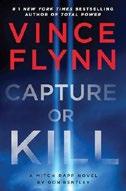
B entley’s first Mitch Rapp thriller in the series begun by the late Vince Flynn and continued by Kyle Mills. In 2011, saboteurs have blown up an Iranian nuclear facility, and Iran swears vengeance. Against whom, they don’t know yet. The head of Iranian intelligence, Azad Ashani, is dying of cancer and wants to both prevent a calamitous war and protect his family. But he sees his only chance as making a deal with the devil: “Malikul Mawt. The Angel of Death.” Mitch Rapp. Mitch surely merits that sobriquet, yet the author makes clear that the CIA operative is “neither a sociopath nor a troubled soul” but more like a plumber just doing his job, unclogging drains. Lots of drains. “Mitch was created to hunt his nation’s enemies on their turf,” that’s all. Over the nearly two dozen books in the series, he’s killed enough bad guys to fill a small phone book. His persona is a bit
BREAK EVERY RULE
over the crest of believability: “Managing Rapp wasn’t so much riding a bridleless mustang as trying to surf a tsunami.” “The man seemed born to kill terrorists in the same way in which Eddie Van Halen had been born to play guitar.” And to borrow a phrase, he jumps the shark when he plunges headfirst down a waterfall. But hey, what’s a hero for? He works in coordination with Army Rangers to “capture or kill” a high-value target—Osama bin Laden—over the Pakistani border in Abbottabad. The action hardly ever lets up, so Rapp’s legion of readers will find plenty to worry about—and enjoy. Author Bentley has successfully spun yarns in the Tom Clancy universe, and here he moves smoothly into Vince Flynn’s. Their writing styles and that of Kyle Mills are indistinguishable, as if they could slip into each other’s skins. There’s even a passing nod to Mark Greaney’s Gray Man, another plague on the world’s bad guys.
Action junkies will gobble this up.
Freeman, Brian | Blackstone (352 pp.)
$27.99 | Sept. 10, 2024 | 9781665109703
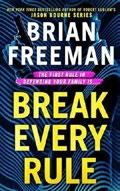
When a woman with a troubled history goes missing with her infant daughter, two searchers with very different agendas go looking for her.
The first of them, Tommy Miller, has been waiting for Venezuelan enforcer Mauricio Perez to catch up with him because he wrongly blames Tommy for the murder of his wife, Almu Perez. So although it makes
perfect sense that Perez would have in turn kidnapped Tommy’s wife, Teresa, and their daughter, Rosalita, Tommy wonders why Teresa would’ve packed an emergency bag in preparation for a danger Tommy never told her about. Like Perez, Tommy’s not one to let bygones be bygones, and his military training and connections make him just as likely an avenger as Perez—and much likelier than Lindy Jax, the Alachua County Sheriff’s Office detective Tommy reports the disappearance to. It doesn’t take long for Lindy, who’s driven by memories of her own brother’s unsolved disappearance when he was 6 and she was 11, to figure out that Tommy’s hiding several important details, like Teresa’s past connection to billionaire investor Martin Fell, her real name, and the identity of Rosalita’s biological father. Basing Teresa’s backstory largely on sordid real-life headlines about Jeffrey Epstein and his stable of young women and high-end companion abusers, Freeman ups the stakes by setting Tommy and Lindy against each other—each of them smart, capable, well provisioned, and willing to break every rule—and letting the chips fall where they may. Just in case a few readers find the competition between Tommy and Lindy too predictable, the author reveals a third interested party with a still different agenda. Reliable thrills, bone-crunching action scenes, and satisfying revelations of corruption in high places.

Gervais, Simon | Thomas & Mercer (351 pp.) | $16.99 paper Sept. 17, 2024 | 9781662518539
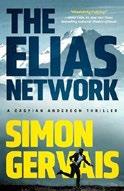
International assassins play a deadly game of cat and mouse…and cat…and maybe another cat. As a wetwork operative trained by Onyx, a secret program inside the U.S. Department of Homeland Security, Caspian Anderson has logged 33 kills under the code name Elias. Now he’s in the resort city of Zermatt, Switzerland, waiting for his latest assignment, banker Leonard Aldrich. Unbeknownst to Caspian, another assassin, Edgar Augustin, has been assigned the same target. The two are a study in contrasts, Caspian the cool lone wolf, Edgar the urbane patriarch of a ragged, dysfunctional family. What should be a routine job spools out over 100 pages, leaving Caspian with a bullet in the shoulder. He’s tended by an agent he met in training whom he remembers as “Amy from Arizona.” Back in New York, Caspian’s girlfriend, Liesel Bergmann, who’s also an operative with an elite team, awaits her own latest assignment. Both lovers are so skillful that neither seems aware of the other’s secret profession. Gervais, who’s created three previous thriller series, is at his most playful and character-driven here. The attenuated stalking of Aldrich, for example, culminates in a loopy, entertaining set piece featuring his wife, Florence. The plot focuses more on relationships and shifting alliances than scenes of action. Unexpected villains, plot twists, and
betrayals follow, but the big question in this series kickoff is what will happen after the big reveal. Will the story play out like Mr. & Mrs. Smith or like Prizzi’s Honor ?
A sly, stylish thriller with more scheming than slaughter.
Haig, Matt | Viking (368 pp.) | $30.00 Sept. 3, 2024 | 9780593489277
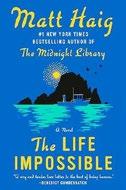
A British widow travels to Ibiza and learns that it’s never too late to have a happy life. In a world that seems to be getting more unstable by the moment, Haig’s novels are a steady ship in rough seas, offering a much-needed positive message. In works like the bestselling The Midnight Library (2020), he reminds us that finding out what you truly love and where you belong in the universe are the foundations of building a better existence. His latest book continues this upbeat messaging, albeit in a somewhat repetitive and facile way. Retired British schoolteacher Grace Winters discovers that an old acquaintance has died and left her a ramshackle home in Ibiza. A widow who lost her only child years earlier, Grace is at first reluctant to visit the house, because, at 72, she more or less believes her chance for happiness is over—but when she rouses herself to travel to the island, she discovers the opposite is true. A mystery surrounds her friend’s death involving a roguish islander, his activist daughter, an internationally famous DJ, and a strange glow in the sea that acts as a powerful
A British widow travels to Ibiza and finds it’s never too late to be happy.
life force and upends Grace’s ideas of how the cosmos works. Framed as a response to a former student’s email, the narrative follows Grace’s journey from skeptic (she was a math teacher, after all) to believer in the possibility of magic as she learns to move on from the past. Her transformation is the book’s main conflict, aside from a protest against an evil developer intent on destroying Ibiza’s natural beauty. The outcome is never in doubt, and though the story often feels stretched to the limit—this novel could have easily been a novella—the author’s insistence on the power of connection to change lives comes through loud and clear. Haig’s positive message will keep his fans happy.
Kashiwai, Hisashi | Trans. by Jesse Kirkwood | Putnam (208 pp.) | $26.00 Oct. 8, 2024 | 9780593717790

A former police detective and his grown daughter research and re-create strangers’ half-remembered meals to help them overcome obstacles in their lives.
Koishi is in her 30s and works at a restaurant in Kyoto—it’s known as the Kamogawa Diner, though it doesn’t have a sign— with her father, Nagare Kamogawa, the chef. Both miss Koishi’s late mother, Kikuko. Their cat, Drowsy, spends its days trying to get into the restaurant, though he’s banned to protect the customers from wayward strands of hair. The book is a series of six small vignettes about unrelated people who arrive at the diner through the seasons to ask for help re-creating dishes from their pasts. Kyosuke Kitano is an Olympic-hopeful swimmer who isn’t sure if he should reach out to his sick father but yearns for a lunch dish his father made for him as a child. Kana Takeda is a single mother and food writer who is eager to prove her child wrong about the best dish he has
ever eaten—a hamburger steak made by his grandfather. And Hatsuko Shirasaki, Koishi’s childhood best friend, is a successful model who’s unsure if she should accept a marriage proposal until her boyfriend understands her impoverished roots. Each of them, as well as the others, arrives, eats, speaks with Koishi about their lost meal, and then departs. Two weeks later they return to eat the meal that Nagare has meticulously researched and prepared. Readers looking for a throughline in the vignettes or a conclusion that ties them together or dives into why Nagare and Koishi have reached this point in their lives will find more questions than answers. This cozy book delights in Japanese cuisine.
Kinsky, Esther | Trans. by Caroline Schmidt New York Review Books (176 pp.) | $16.95 paper | Sept. 3, 2024 | 9781681378510
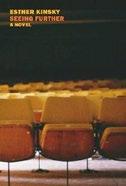
German author Kinsky’s spare, abstract fiction centers on a woman’s nostalgia for experiencing movies in a theater.
Like the iconoclastic filmmaker John Cassevetes, whom she quotes throughout, Kinsky avoids conventional plot structure and psychological probing. Her unnamed narrator spends pages describing the physical world, often as a vista of “flatness and vastness”—vastness being a favorite word—and musing about the relationship between image and memory, cinema as “vastness… bound to this physical place,” and the “communality of the cinematic experience.” Meanwhile, she reveals little about the emotional landscape of the people around her and shares only the barest details of her own story. As a child in an unnamed, probably Eastern European country (given that she studied Polish and Russian), she watches no television and only occasionally visits the cinema with her father, whose
reticence is the only characteristic she mentions. As an adult, she takes photographs, but whether as a career or hobby isn’t clear. No intimate friends show up, only acquaintances. After years in London, described by the names of movie theaters she frequented, she moves to Budapest, where an elderly neighbor named Julika mentions that she once “had a fellow who was a great cinema man.” Traveling around southeast Hungary, the narrator finds a small town with an abandoned movie theater she decides to buy and restore after meeting its former projectionist and some other locals. At this point, Kinsky drops in an “interlude” telling the story of a young cinema enthusiast known as Laci who brings movies to his hometown during World War II with the help of a young woman named Julika; while their romance is half-baked and Julika eventually leaves, Laci’s lifelong obsession with cinema is passionate. The narrator takes up her own story again as she completes her restoration and attempts to reopen what had been Laci’s theater. Ultimately, sorrow bleeds through the narrator’s (and author’s) reserve, the decline of cinema epitomizing profound loss—of place, of beloved people (see the dedication at the end), of optimism.
A cerebral elegy that demands patience, even from serious film lovers.
Kois, Dan | Harper Perennial/ HarperCollins (208 pp.) | $16.99 paper Sept. 17, 2024 | 9780063358751
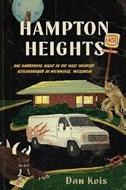
A ragtag group of Wisconsin paperboys grapples with fear and friendship during an ill-fated excursion one night in 1987. You can draw a perfectly straight line through 1980s-themed
supernatural horror like The Goonies and Stranger Things to contemporary novels like Jason Rekulak’s The Impossible Fortress and Edgar Cantero’s Meddling Kids to this novel’s closest analogue, Brian K. Vaughan’s influential graphic novel series, Paper Girls. Where the girls were navigating weirdness like time travel and alternate dimensions, Kois drops his six tweenage monsters into a neighborhood full of real ones. Lured by Kevin, their scumbag newspaper delivery manager, into canvassing an unfamiliar neighborhood to sell subscriptions to the Milwaukee Sentinel, the kids eagerly attack their mission for the promise of a Burger King dinner and a little extra pocket money. Bitching about his ex and generally a miserable SOB, Kevin is soon off the board, waylaid by a mysterious siren in the local dive bar. Thoughtful and observant Sigmone, one of his school’s only Black kids, teams up with rich kid Joel, only to discover his long-lost grandfather leading a gang of neighborhood enforcers. Nursing a wicked crush on his classmate Heather, hopeless romantic Mark teams up with his rule-abiding pal Ryan, only for a stray gingerbread treat to lead them both astray for quite a while. Fortunately, budding grifter and self-described hustler Business Al and his new partner, Nishu, have their wits about them when they’re held up by an unusual extortionist who demands payment for passage, turning the tables on him. Delightfully immature and authentic dialogue, a refreshing lack of cynicism, and some genuinely unnerving threats all help elevate what could have been a slapdash assembly of tropes to an engaging and eerie adventure —as advertised.
A fractured fairy tale, as much about getting out with your skin intact as the friends we made along the way.

As she wraps up her Highway 59 trilogy, the acclaimed crime novelist rethinks the genre and her place in it.
BY CONNIE OGLE
FIVE YEARS HAVE passed since Attica Locke published Heaven, My Home, her second novel about Black Texas Ranger Darren Mathews, but the writer always knew she was going to revisit his story.
“I left it on a cliffhanger,” she admits via Zoom from her home in Los Angeles. “You can’t do that. It’s not fair. The beauty of writing a series in the way I wanted to, you could leave all these dangling questions you can answer later. And it was time to find the answers to those questions.”
Also the author of the novels The Cutting Season, Pleasantville, and Black Water Rising, Locke started the Highway 59 series—named for the road stretching north through rural East Texas—with 2017’s Bluebird, Bluebird. Over two compelling books, Darren Mathews faced off with creeps, criminals, racists, his family’s past—and his own darker nature.
In Guide Me Home (Mulholland Books/Little, Brown, Sept. 3), the last of the trilogy, it’s still 2019. Darren has turned in his badge but is drawn into the disappearance of Sera, a Black college student. He must also unravel the mystery of the community Sera’s family calls home: Thornhill, a modern-day factory town that claims to provide everything from housing to medical care for its employees. Its ominously responsive security force suggests a different agenda.
Locke had originally envisioned “six or seven” Highway 59 novels but found herself delayed by the pandemic and her job as a television writer and producer on such projects as Empire, Little Fires
I was afraid readers would want shoot’em-up bang-bangs. I wanted to write a different kind of crime novel.

Everywhere, and the miniseries When They See Us, about the Central Park Five.
Now, she’s decided to take a step in a new direction. A big part of Guide Me Home is Darren coming to terms with his troubled mother, whose actions have threatened his career, and the repercussions of his own personal and professional mistakes.
She’s not sure if readers will follow her but hopes they will.
“I was afraid readers would want shoot’em-up bang-bangs,” she says. “I wanted to write a different kind of crime novel. The mystery I was most interested in was between Darren and his mother. I was OK with this book moving at a different pace. It’s about being invested at the level of the heart.”
The following interview has been edited for length and clarity.
Why did you decide to close out the series after three books?
My feelings began to change about law enforcement and guns. This series became a treatise on the Trump era. When I wrote Bluebird, Bluebird, he hadn’t been elected. He was just a candidate. Nobody thought we’d be where we are now.
So he’s elected, and I seem like a Cassandra and prescient because of the nature of the book. It’s about a Black Ranger working around issues of the Aryan Brotherhood. There was no way to get around what was happening to the country. I want to continue to write about this era in our country’s history, but maybe in a different way. I can’t attack it from the point of reverence for guns and violence.

So are you done writing crime fiction?
I don’t want people to think I’m done with crime fiction! It’s this particular character having a hard time with it. But one of the most interesting things was when my husband read the book and said, “It’s as if your protagonist wants out of this genre.”
Why is writing about social justice important to you?
It’s the air I breathe. It’s just what comes out. I’m interested in politics from the point of view of distribution of power. What’s funny is that even in my TV work it’s there. I’m in a development phase,
working with my sister on developing shows about real estate, and the themes that come out are: Who owns land? They have power. I am just naturally drawn to looking at the distribution of power.
What was it like to write the character of Sera’s father, a Black man who sees Donald Trump as a savior?
I tiptoed up to it. I was definitely trying to understand how your psychology can make you a true believer in the thing that is your undoing. We talk about it from a class perspective, where people vote against their own economic interest to align themselves with an economic population they don’t belong to. I took that and extrapolated race. Trump is lying about how many Black followers he has, but he has some, and most are men.
How did you come up with Thornhill, the factory town that claims to have its residents’ best interests at heart but doesn’t?
I had an idea early on for a Highway 59 book set at the border, about labor and factories, and I had read about the harrowing work of meat processing. I can’t say where I made the leap, but I’ve seen TikToks from young people saying, “One of these days we’re going to live at Target.” That’s the very thing Thornhill is. If government fails everybody, that’s when capitalism will swoop in. People are so desperate to be cared for as citizens, they’re willing to exchange any idea of building wealth for medical care. If building wealth isn’t possible, forget it. People would give up a lot simply to have basic human rights like medical care.
Will we see Darren in another setting some day?
There’s hope in the ending—him saying, “There will be a fight and I will join the fight, but I don’t know that I can do it this way as a man with a badge who lies and manipulates and does things that I accuse other people of doing.” So you never know. Scott Turow did a sequel to Presumed Innocent!
Darren could come back, but this era of his life is coming to a close. We don’t know what the rest will be. It mirrors a part of me. It’s very hard on the other side of the multiple shootings, on the other side of
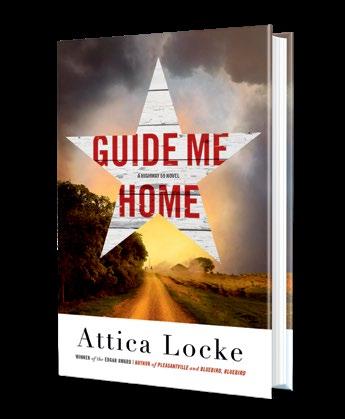
Guide Me Home
Locke, Attica
Mulholland Books/Little, Brown | 320 pp. $29.00 | Sept. 3, 2024 | 9780316494618
George Floyd, to revere gun violence. And that’s Darren’s job. He’s not only wrestling with that but also wrestling with the dangers of how easy it is for people in authority to lie. What kind of moral rot does that lead to? That’s what we’re seeing, the prospect of electing a liar who says, “The truth is whatever I want it to be.”
Do you hope to keep writing novels and working in television?
Here’s the thing: I happen to be able to do both, but I wish I only did one thing. It’s weird going back and forth. They’re so different. I love the solitude of writing a book, but working with other people is a lot of fun, even when it’s difficult. It’s like the writers bring in symphonic horns here, and costume design brings in the drums, and it makes a gorgeous symphony. It’s really awesome to watch that happen. But if I had my druthers, I would make a couple of great shows that can have legs, and once I get my daughter through college, I want to live in a Nancy Meyers movie and write from 10 to 3, then go pick sea glass on the beach.
Connie Ogle is a writer in Florida.
Kirkus Star
Clive Cussler Ghost Soldier
Maden, Mike | Putnam (416 pp.) | $32.00 Sept. 3, 2024 | 9780593719244

The Oregon crew takes on a villain who bears a longfestering grudge. In 1945, a captured American soldier unwillingly took part in a ghastly experiment. In the current day, a malign force has built on that research and plans to wreak unholy vengeance on Guam and, ultimately, on the United States. A mysterious, much-feared man called the Vendor, an arms purveyor whose increasingly dangerous weapons have just slaughtered soldiers in Niger, is testing his killing craft in the Indian Ocean. The Vendor’s reach extends as far as Kosovo and the Celebes Sea off the Philippines, where North Koreans try out some of his handiwork. Luckily, a modest-looking cargo ship plies the seas. It’s the Oregon, with all the internal wizardry one might wish for. It has a Cray computer, Cordon Bleu–trained chefs, and plenty of amenities to keep a top-notch crew dedicated. The seawater-powered ship can even change its outward appearance to disguise itself as the lowliest third-world rust bucket. In charge of this marvel is Juan Cabrillo, the protagonist. The crew of the Oregon are independent contractors and undertake an urgent mission from the CIA to investigate arms trafficking by the Taliban. That leads to an inevitable collision with the Vendor, whose tentacles reach far and wide. This might spell the end for Cabrillo because the Vendor “had proven himself unequaled in unarmed combat.” The Oregon Files series is always fun, and this episode is no exception. Cabrillo is a terrific leader in top physical shape, but he and the ship itself are tested to their limits. Of course, some of Oregon’s features beggar belief, but never you mind. They fit in well with the now-and-then over-the-top writing: “A giant piece of red-hot
aluminum sliced through Juan’s fragile canopy like a drunken samurai’s katana through a rice-paper wall.” It’s hard to read a simile like that and not stop and smile. And in the same action sequence, the hero hits an object “like a speeding hockey forward cross-checking a parked Zamboni.” Ouch. It all “hurt like the dickens,” which is about as salty as the language gets. Exciting adventure that’s worthy of the Cussler name.
Marino, Andy | Redhook/Orbit (592 pp.) $19.99 paper | Nov. 5, 2024 | 9780316563994
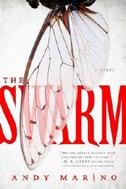
Cicadas hasten the end of the world in this unnerving novel. In Fort Halcott, a small city in upstate New York, police officers Vicky Paterson and Ken Grimes investigate a dead body found with its fingernails, toenails, and teeth cleanly removed and no sign of insects feasting on the remains even though the woman has clearly been dead for several days. Elsewhere in town, Will Bennett and Alicia Bennett, a divorced pair of “fixers,” track down a young woman who’s fallen in with something called the Order of Hemiptera. When they encounter the cult, it’s in the midst of a bizarre ritual that changes something in Will, prompting him to occasionally utter things like “The signal begins in the soil.” Gradually our heroes note that the hum of cicadas is omnipresent, a year ahead of their scheduled appearance. Readers who savor bugs and body horror will find plenty to enjoy here, though if you find these things icky you may get nightmares. Gradually the scope of the novel widens to incorporate the perspectives of Rebecca Perez, a forensic entomologist, and Anton Hajek, the founder of a possibly failed tech company. (The board meeting that introduces the company feels a bit digressive but also provides some of the funniest moments in the book.) As the
reason cicadas are attacking people becomes clear and the scope of the problem expands far beyond one city in the Adirondacks, Marino weaves in more and more elements, from mysterious World War II–era experiments to philosopher Timothy Morton’s concept of the hyperobject. It’s a lot—at one point, a character summarizes the story thus far as “Possible occult bug ritual sparks a mutant cicada uprising. Comm networks go down. Unknown force cordons off the entire city”—but the book’s blend of ambition and viscera works more often than not. Shaggy, kinetic, and relentless.
Mattes, Amy | Nightwood Editions (240 pp.) | $17.95 paper Sept. 3, 2024 | 9780889714564
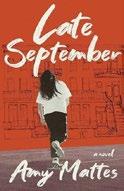
In 2000, Ines boards a Greyhound bus, leaving her claustrophobic hometown and troubled past behind for a new life in Montreal.
A skateboarder equipped with a journal, a Discman, and very little French, Ines soon becomes friends with April, a goth working as a cam girl. The two become regulars in Montreal’s raucous late-night bar scene, and one night at their favorite spot, a fight breaks out and Ines is hurt. Through the blood and chaos, she meets Max, a filmmaker mixing in the same social circles. There’s an instant electricity between them, and their summer romance soon becomes all-encompassing. Despite some red flags, Ines is swept up in their relationship—finally allowing herself to experience love and desire without shame. But things gradually worsen between them, and she realizes that Max is struggling with mental health issues. As his behavior becomes increasingly erratic, Ines is often unable to reach him and suspects infidelity. In the meantime, she is fired from her kitchen job, so April enlists her to join her work world. With Ines’
demons, money troubles, and a regular cam customer overstepping boundaries, she begins to lose a grip on her new life. Her sense of self becomes increasingly muddled as she struggles to accept care from those around her, and the precarity of her life in the city only heightens her despair. Disillusioned, Ines is mentally back where she began before moving to Montreal—as profound self-doubt sets in, her drug use spirals and the darkness encroaches. Mattes’ unflinching depiction of early adulthood in a new city—fraught with challenges and full of intense relationships—feels utterly authentic. Dealing with themes of grief, trauma, mental illness, sexuality, and love, this novel covers a great deal of ground, staying relatable through the intimacy of Ines’ stream of thought. Her character—flawed, paralyzingly self-conscious, bewildered, craving tenderness and recognition, lost, wounded—will be recognizable to many readers going through, or looking back on, their early 20s.
Mattes depicts the gritty realities of mental illness without glamour in this refreshingly frank coming-of-age novel.
McDermid, Val | Atlantic Monthly (144 pp.)
$25.00 | Sept. 24, 2024 | 9780802164292

One of Scotland’s premier crime writers takes on the legendary life of Macbeth’s fiery queen, Gruoch. Medieval Scotland is a violent landscape, where kingdoms are passed down not merely through bloodlines but through battle and bloodshed. For years, Gruoch has been at its center, first as the wife of the tyrannical Gille Coemgáin, then reigning for nearly two decades alongside the love of her life, Macbeth, and finally as the queen mother when her son assumes the throne. Offering a completely different take from Shakespeare’s gloomy, guilt-ridden Lady Macbeth, this slim novel uses a dual
A love letter to Scotland via a fresh look at one of its monumental figures.
QUEEN MACBETH
timeline. In the present, McDermid tells the story of Gruoch and her three ladies in waiting (a sly spin on Shakespeare’s “toil and trouble” witches), who all become fugitives as they flee from an attempted coup during the reign of Gruoch’s son. In the past are flashbacks to Gruoch’s life with her first husband, Gille, her schemes to wind up with Macbeth, and their life together as rulers of the kingdom of Moray. Part of the Darkland Tales series, in which Scottish writers take on foundational moments in the country’s history and mythology, this novel seems unexpected territory for McDermid, but she plays to her strengths. The result is a surprisingly suspenseful tale—a special challenge in historical fiction when the general contours of a narrative are already known. Even within those confines, McDermid manages twists and turns that not only show her chops as a mystery novelist, but upend the cultural stranglehold Shakespeare’s antiheroine has on our understanding of this intriguing real-life woman.
A love letter to Scotland via a fast and fresh look at one of its monumental—and monumentally misunderstood—figures.
Palahniuk, Chuck | Simon & Schuster (240 pp.) $26.99 | Oct. 8, 2024 | 9781668021446

The kids are most definitely not all right in a near future that can’t decide whether to drug them, kill them, or promote them.
“WAKE UP, YOU BASTARDS!” That barbaric yelp might not
be the most traditional finale, but here we are back in the land of Chuck. This is not Palahniuk’s first foray into teen angst—see Damned (2011) and Doomed (2013) for lighter fare. This time he’s way more interested in pulling apart the building blocks of story and self than subverting conventional dystopian tropes. In this bizarro version of America, the powers that be launch an ill-fated attempt to rescue society—covertly encouraging the country’s largely illiterate youth to read books laced with everything from Ritalin to powerful hallucinogenics. Simultaneously, our best and brightest are targeted with a standardized test that neutralizes societal disruptors: “You cherry-pick. You hunt for kids likely to create seismic shifts in culture and technology, and you weed them out.” Once ripe, they’re sold by their parents to a postmodern slave market and repurposed from saviors into heads of state and corporate overlords: “Okay, it was a severly fucked-up system, buut a systm.” Here comes steely-eyed Samantha Deel, destined to become the actual Queen of England, but so unhappy to be losing her dreams of singing that she maims herself. Yes, she’s the hero, along with her formerly dead boyfriend, Garson, and a gender-bent, self-described “interventionist” named War Dog, but don’t get too excited. Although there are a few familiar wisps of YA dystopia here, The Hunger Games it’s not. Peppering his book with passages and phrases from The Great Gatsby, Anna Karenina, and The Hunchback of Notre-Dame, Palahniuk is clearly enjoying himself, but he’s also drilling down into the titular idea—a psychic or spiritual kick that gets you out of your own head for once. Readers’ choice whether this is a coded message, a spiked cocktail, or just a secret love letter to art.
Peace, David | Norton (480 pp.) | $29.99 Nov. 12, 2024 | 9781324086260

A storied soccer team struggles to recover from tragedy. On February 6, 1958, a plane carrying Manchester United soccer team players and staff crashed shortly after takeoff from Munich, Germany. The disaster killed eight players, three staffers, eight journalists, and one of the pilots, most instantly. This historical novel, one of a series by Peace focused on British soccer (Red or Dead , 2014, etc.), explores the lives of the nine players who survived, as well as coach Matt Busby, who’d led “Busby’s Babes” to glory in previous seasons. As the title suggests, each survivor has a different recovery and relationship to trauma—a couple of players were able to return to the pitch in short order, others (and Busby) needed weeks to recover, and others were unwilling or unable to play ever again. Peace takes a roving-camera approach, shifting from hospital wards to the Man U front office to funerals to matches to hearings over who was at fault for the crash. (Investigators concluded that the plane’s wings weren’t de-iced before takeoff.) For fans of the game—and those with long memories of the disaster—Peace’s comprehensive fictionalization of events has obvious appeal. But most of the characters feel undifferentiated from one another, aside from Busby, whose long recovery and leadership role make for an engrossing subplot, and Liam “Billy” Whelan, an outlier as an Irishman. Peace’s effort to give every victim his due feels padded, a sense that’s exacerbated by the habitually recursive, run-on prose (“the hour was late, so very late, and the night so cold, so wet, so very cold and wet…”). Peace is aiming for melancholy, but too often the story is just drowsy. A baggy tribute to a devastating moment.
Pullen, Nicholas | Redhook/Orbit (400 pp.) | $18.99 paper
Oct. 8, 2024 | 9780316573054

An epistolary novel about an apocalyptic Buddhist sect’s untimely reemergence in 19thcentury Tibet.
Awaiting his inevitable demise, studious, loquacious Orientalist John Sackville, the Lord Dalwood, summons the energy to narrate in painstaking detail the story that brought him to his proverbial deathbed. In a lengthy diary entry dated Feb. 18, 1921, Sackville describes his romanticized childhood (“I would doze off to Walter Scott novels and old collections of Arthurian folk tales”), his arrival at boarding school, and his blossoming relationship with Garrett Benson, a younger, poorer schoolboy introduced to Sackville through the practice of “fagging,” whereby underclassmen performed the roles of servants for older students.
Sackville and his manservant-cum-lover journey to Tibet, where the former’s research in Urdu, Hindi, and Sanskrit lead him to discover an underground Buddhist order, the Dhaumri Karoti, which seeks the destruction of the world. Intimate depictions of Sackville’s relationship with Garrett comprise the most compelling portions of the novel, and Pullen also drops occasional and refreshingly blunt social commentary: “The Empire relies for much of its strength on brutalising children in the system of organised violence and torture that we call the Public School System.” But for all its fastidious attention to
Tibetan lineages, regional Asian power struggles, and obscure Buddhist dogma, Pullen’s novel too often wavers between baroque info dumps and stilted dialogue. The novel eventually finds its form, picking up steam as disturbing reports roll in from across the Himalayas, but a marked fixation on physical appearances borders on fetishization. And while the characters’ racist, outdated attitudes may ring true for the era, they can strike an uncomfortable tone. It’s one thing to have a privileged English aristocrat remark on an Indian peer’s linguistic proficiency (“I admired the idiomatic fluency of his English”). It’s another to put those words into the mouths of deferential imperial subjects themselves: “There is much to learn from the British. If we’re ever to make something of India….” Readers with a penchant for ornate tours through colonial academia and slavish dedication to verisimilitude will appreciate this title.
Impeccably detailed if sometimes didactic, this book reads like the creative indulgence of an erudite scholar.
Rima, Barrack Zailaa | Trans. by Carla Calargé & Alexandra Gueydan-Turek
The Invisible Press (112 pp.) | $19.95 paper Sept. 17, 2024 | 9781778430480

This collection of Rima’s three graphic novels from across two decades rambles through the streets of Lebanon’s capital, a city driven by politics, war, and family.
An epistolary novel about an apocalyptic Buddhist sect in 19th-century Tibet.
THE BLACK HUNGER
An introduction by the translators frames Rima’s work in the tradition of the flaneur, a wandering and enraptured observer of a city, and contextualizes Rima’s connection to the titular city as a visitor rather than a resident, coming to the bustling metropolis with hungry eyes. The first volume opens with the dialogue of two old intimate acquaintances reuniting after decades of separate lives, reminiscing about a political movement that electrified the moment but has been mostly forgotten as the city weathered decades of war and rapacious commerce, becoming mired in corruption and mountains of literal waste. The opening lines of white text on black give way to rich, expressive patches of ink carved up with stark white forms and fine lines, building a city through its architectural geometry and imperfections and through the body language of a street vendor negotiating his cart against heavy traffic and a young refugee shot dead in the street. The panels click along like a film reel, narrated by a Hakawati, a storyteller who speaks through the entire cast: cab driver, singer, author surrogate, mother and daughter in search of the sea, Greek chorus of trash shovelers questioning the nature of the narrative in which they find themselves. The three volumes grow progressively personal, and the art becomes more representational, stiffening into detailed figures cut out against their backgrounds like a black box stage play, delivering elegiac dialogue that dissects existence. All three volumes favor atmosphere over narrative as they wryly but earnestly ponder the refugee’s wandering out of time, a mother’s long-ago involvement in a movement, the machinery of political change, and historical amnesia. Opaque but arresting.

Ruiz, Rudy | Blackstone (256 pp.)
$27.99 | Aug. 27, 2024 | 9798212545266
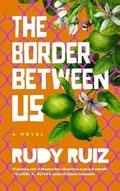
A Mexican American aspiring artist pursues his dream despite harsh political, geographic, and familial realities.
Elaine
Self, Will | Grove (336 pp.) | $27.00 Sept. 17, 2024 | 9780802163530
For more by Rudy Ruiz, visit Kirkus online.
In 1977, 9-year-old Ramón Lopez, born in the U.S. near the border with Mexico, dreams of an adult life in New York City as a celebrated artist. His family’s fraught dynamics serve as both an inspiration and a roadblock to his pursuit. His father sells tires and covertly transports undocumented Mexican immigrants, including children and babies, across the border by hiding them beneath the tires he carts every day. Ramón’s newborn brother is developmentally disabled. With an abundance of care and incisiveness, the novel charts Ramón’s journey and inner turmoil. Ruiz’s prose is lively, and his insights into daily life at the border are authoritative: “Beggars lined the street, shambling in grimy rags, shaking rusted cups jingling with loose change. Cars snaked towards the crossing. The queue would swell throughout the day. At the right instant, crossing could take merely five minutes, but during busy times it might consume an hour. Radiators would rebel. Steam would hiss. Tempers would flare….What did the innocent know about immigration officials and drug-sniffing German Shepherds salivating over the slope of the bridge? What did the baby comprehend about being discreet while breaking the law?” Ruiz is examining timely issues while remaining focused on the humanity of the immigrants, their desperation and desires. Seeing Ramón’s creative aspirations as representative of the immigrant border crossing, his father tells him, “You have to stick with it. And here, unlike south of the river, you have a chance to make it. That’s why we’re here. That’s why it’s called the American Dream, not the Mexican Dream.”
A moving story of one family’s toil amid a cultural struggle, told with precision and authenticity.

The provocative British novelist imagines his mother’s complex inner life.
As a child, Self briefly lived in Ithaca, New York, where his father, John, taught at Cornell and his mother, Elaine, served as her husband’s well-read assistant. This book, covering roughly a year in the family’s life there in 1954 and 1955, is inspired by his mother’s diary and tracks Elaine as she ponders motherhood, squandered ambitions, and (especially) infidelity. She dwells on what she suspects about John, naturally, but also on her own flings, mainly with Ted Troppmann, one of John’s professorial colleagues. Marriage is just one institution that makes her feel constrained: The day-to-day business of running a household chafes, forcing her to suppress her own intellectual ambitions, and though she loves her preadolescent son, Billy, motherhood alone does little for her. Self has long been an admirer of the modernists, and stylistically this novel strongly recalls Mrs. Dalloway, as Elaine’s mind flits from place to place and an overall mood of dissatisfaction sets in (“bitterness, pain, confusion, and sadness in the sightless, senseless, grimacing face of the act of love”). It also gets deeply intimate with Elaine physically, from lust to migraines to periods to bouts of heavy drinking. The novel is a smart portrait of starchy academia and literary life (Vladimir Nabokov and Saul Bellow have brief cameos) and how misogyny runs at the core of society, sometimes violently so. But its chief strength is as a showcase of a woman who’s had it up to here with good manners (she is “a diary keeper and a diary burner, an unfaithful wife and an unloving mother, an angry gouger and a hysterical screamer”). The digressive, at times rambling, prose that’s long been
common for Self is present, but there’s no question that his chosen subject has focused his mind.
A striking study of a woman on the verge.
Sivinski, Stacy | Atria (336 pp.) | $18.99 paper | Oct. 1, 2024 | 9781668058398
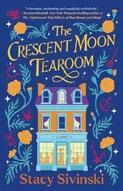
T hree magical sisters, who make a living in the late 1800s divining the futures of visitors to their family’s Chicago tea shop, find themselves pulled in different directions after a surprise visit from the Council of Witches.
Ever since the untimely deaths of their parents when they were young, triplets Anne, Beatrix, and Violet Quigley have been inseparable. Together they spend their days reading tea leaves and interpreting the images they find at the bottom of their customers’ cups. It’s a peaceful, pastry-filled, if somewhat uneventful existence, but all that changes when two things happen: First, the three members of the Council of Witches show up to ask an unexpected favor—they want the sisters to help the city’s Diviner, who suddenly finds herself without access to magic. Then, the sisters learn from a friend of their mother about a curse that has the potential to separate them by their next birthday. Soon enough they find themselves being pulled in different directions—Anne’s magic begins to grow and evolve in unexpected ways; Beatrix, after years of writing, finally catches the eye of a publisher; and Violet is swept off her feet (both literally and figuratively) by a trapeze artist when the circus comes to town. Sivinski’s novel is positively delightful, and the Quigley sisters are wonderfully different from one another despite being identical triplets. But it’s the house where they
A maid tells the story of a child’s death in a series of meanders.
live and run their business that takes center stage. As their lives change, and they experience trials and tribulations, the house changes empathetically to reflect the ways they’re feeling, making it a character in its own right. The result is a tale of family, love, and the things that make a house a home.
A delightfully sweet and cozy novel that’s as comforting as a warm cup of tea.
Trabucco Zerán, Alia | Trans. by Sophie Hughes | Riverhead (272 pp.) | $29.00 Oct. 15, 2024 | 9780593850510

A maid tells the story of a child’s death in a series of meanders. On the first page of Trabucco Zerán’s novel, the narrator, Estela García, offers a deal to the people who may or may not be on the other side of a mirrored glass pane: “I’m going to tell you a story, and when I get to the end, when I stop talking, you’re going to let me out of here.” Estela, it seems, is waiting to be interrogated in connection with the death of a girl, Julia, the daughter of a couple for whom Estela has worked as a housemaid for seven years. What follows is Estela’s account of her time as a domestic, from her responding to a want ad—“Housemaid wanted, presentable, full time”—to her experience working for the couple, whom she refers to as “the señor and señora.” Estela clearly resents her bosses—he’s a doctor, she’s a lawyer, and both are condescending snobs, chiding their employee for every oversight and
expecting her to essentially raise Julia for them. Estela is painfully conscious of the class differences between her and the couple, and she disdains their family, “an unhappy little girl, a woman keeping up appearances and a man keeping count: of every minute, every peso, every conquest.” Estela talks for more than 250 pages, eventually getting to the story of Julia’s death, which is of course tragic but also (perhaps by design) anticlimactic. Trabucco Zerán has crafted an interesting narrative setup, but she can’t quite make it work—Estela’s frequent asides to her apparent interrogators (“Did I tell you about this?” “Do you see what I’m getting at?”) quickly wears thin, and the suspense never really materializes. Her treatment of the theme of class differences is shallow, and the character development just isn’t there.
A novel that can’t get itself off the ground.
Trussoni, Danielle | Random House (336 pp.) $30.00 | Oct. 8, 2024 | 9780593595329

Puzzle genius
Mike Brink, invited to Tokyo to open a booby-trapped puzzle box containing imperial secrets, risks becoming its latest victim. No run-of-themill puzzle expert, Brink can suss out seemingly impossible solutions with the savant syndrome and synesthesia he acquired as the result of a freakish head injury during high school. But his “nuclear brainpower” intensifies his need “to put [himself] in psychic
danger to feel alive.” In Japan, he feels as alive as he ever will, knowing that all six puzzle masters who attempted to open the deviously designed Dragon Box died trying. Constructed in 1868, “a time of unimaginable upheaval in Japan,” it is equipped with such charming features as a guillotine to cut off a misplaced finger and a lethal aerosol spray containing arsenic. But Brink’s tense adventure, which culminates in a cave on the island of Kyushu, “where the sun disappeared,” only begins with his efforts to open the box. He is pursued by dark forces who are so desperate to keep him from its secrets—which are said to hold a key to the future of humanity—that they had his doctor-mentor in America murdered. At the center of the drama are two estranged sisters, one Brink’s ally and the other part of the opposing faction. In different ways, both women, descendants of a samurai family, are beholden to Jameson Sedge, a tech billionaire who set up Brink’s ex-girlfriend for murder in Trussoni’s previous novel, The Puzzle Master (2023). Though he died by suicide, his downloaded consciousness is “digitally alive.” The sequel takes a while to get going, but once its hero starts applying his special gifts, learning things he has kept secret from himself, the pages turn and the suspense kicks in. A smart, captivating novel about unraveling secrets.
Westlake, Donald writing as Richard Stark Hard Case Crime (224 pp.) | $16.99 paper Oct. 8, 2024 | 9780857683328
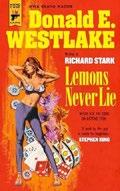
Westlake’s fourth and last novel about actor/thief
Alan Grofield, originally published in 1971 under the Stark name, focuses on the perilous consequences of refusing an offer you can’t refuse. Even though Grofield’s old acquaintance Dan Leach has made a
point of inviting him to join in the payroll theft of a brewery in Monequois, New York, masterminded by thoroughgoing Andrew Myers, the job doesn’t tempt him once Myers explains it. The logistics are complicated, and the estimated haul of $120,000 is too small to split six ways, especially after the local mob takes its cut. So Grofield bows out. As a result, so does Leach, and Myers ends up canceling the job. Still in need of a bankroll for the summer theater he owns in Mead Grove, Indiana, Grofield joins the crew of another heist in a St. Louis supermarket that looks much more manageable. And indeed this job goes off without a hitch until the moment it’s disrupted by Myers, who’s still holding a grudge over the job he had to scratch after putting all that work into it. Although Grofield manages to escape, he knows he’s in serious danger, and he resolves to take out Myers before Myers comes after him again. But his general distaste for killing people puts him at a serious disadvantage when he returns, against all odds, to Monequois, New York. Throughout it all, the author maintains the dead-eyed tone of Stark while plotting as generously and inventively as Westlake.
Trust Stark, or Westlake, to make even the most ordinary heist nail-biting.
Kirkus Star
Williams, Niall | Bloomsbury (304 pp.)
$28.99 | Nov. 19, 2024 | 9781639734207

In a small Irish town, the local doctor deals with the very young, the very old, and the possibility that he’s ruined his daughter’s life.
“To those who lived there, Faha was perhaps the last place on earth to expect a miracle. It had neither the history nor the geography for it. The
history was remarkable for the one fact upon which all commentators agreed: nothing happened here.” Well, they are wrong about that. This sequel to Williams’ much-loved This Is Happiness (2019) is set in the same town several years later: Christmas season 1962, a period when smalltown machinations of all kinds come to a head. These are presented in Williams’ signature prose style: sinuous sentences that may seem at first a bit hard to follow but in short order reveal themselves to be full of music, humor, and insight. Like the work of writers from James Joyce to Anna Burns, Williams’ novel is one of those books that teach you how to read it, ultimately staking out its own linguistic territory in your brain. As for the idea that “nothing happens here”—nothing except that 12-yearold Jude Quinlan finds an abandoned and possibly dead baby in a courtyard; the assistant priest is scheming furiously to replace his geriatric superior, who keeps wandering off, both physically and mentally; and Dr. Jack Troy, healer, brains, and backbone of Faha, fears he has made a terrible mistake. His oldest daughter, 29-year-old Ronnie, who after her mother’s death and the departure of two younger sisters still keeps house for her father and helps him run his practice, was courted by a young man named Noel Crowe. Troy shut down the relationship, thinking the boy unsuitable, but now gleans that Ronnie has been inquiring about Crowe, apparently crushed to learn he’s emigrated to the U.S. Overcome with remorse, the good doctor cooks up a daring if cockamamie plan. One need not have read the first installment to enjoy the second; reading them in the opposite order is just as good.
Treat yourself to this.

Ten authors are in contention for the award for imaginative fiction.
The Ursula K. Le Guin Prize for Fiction revealed its shortlist, with 10 authors in contention for the annual award for a book of imaginative fiction.
Vajra Chandrasekera’s The Saint of Bright Doors, which won the Nebula Award for best novel, made the shortlist, as did Samantha Harvey’s Orbital, which was previously shortlisted for the Orwell Prize for political fiction, and Nghi Vo’s Mammoths at the Gates, which was a finalist for the Nebula and Locus awards.
Sarah Cypher was named a finalist for The Skin and Its Girl, which was longlisted for the PEN/Hemingway Award, while Emily Tesh made the list for her Hugo Award–shortlisted Some Desperate Glory Anne de Marcken was shortlisted for It
Lasts Forever and Then It’s Over, alongside Alissa Hattman for Sift, Alaya Dawn Johnson for The Library of Broken Worlds, Premee Mohamed for The Siege of Burning Grass, and Micaiah Johnson for Those Beyond the Wall
The judges for this year’s prize are authors Margaret Atwood, Omar El Akkad, Megan Giddings, Ken Liu, and Carmen Maria Machado.
The Ursula K. Le Guin Prize, named for the late legendary science fiction and fantasy author, was first awarded in 2022 to Khadija Abdalla Bajaber for The House of Rust ; last year’s winner was Rebecca Campbell for Arboreality. The winner of this year’s award, which comes with a $25,000 cash prize, will be announced on Oct. 21.
—MICHAEL SCHAUB

For more great speculative fiction, visit Kirkus online.
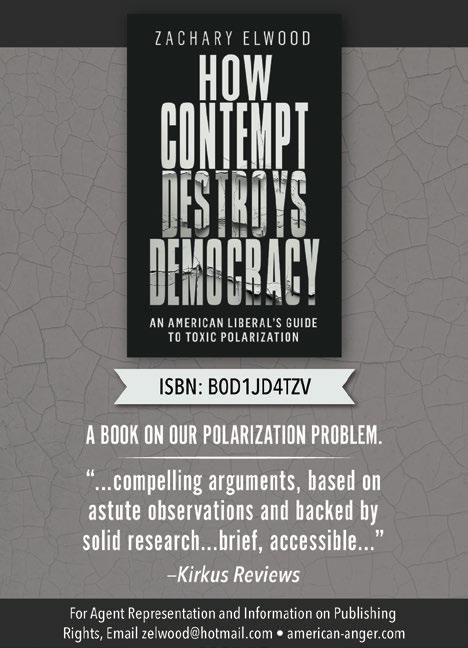




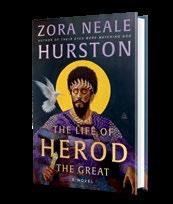
Amistad will publish The Life of Herod the Great next January.
A previously unpublished novel by author Zora Neale Hurston is coming in 2025.
Amistad will publish Hurston’s The Life of Herod the Great next year. The press says the book reveals “the historical Herod the Great—not the villain the Bible makes him out to be but a religious and philosophical man who lived a life of valor and vision.”
Hurston grew up in Alabama and Florida and studied anthropology at Barnard College. Her studies and fieldwork informed many of her books, including Mules and Men, Tell My Horse, and her most famous work, Their Eyes Were Watching God

For a review of Hurston’s
She died in 1960, and 15 years later, an essay by Alice Walker, “Looking for Zora,” rekindled interest in her work. Several of her books have been published posthumously, including Barracoon: The Story of the Last “Black Cargo” (2018).
The Life of Herod the Great tells the story of the first-century Judean king who, according to the biblical Book of Matthew, ordered the Massacre of the Innocents, in which male children were slaughtered in and around Bethlehem. Historians do not believe the massacre actually occurred.
The Life of Herod the Great will be published with an introduction and afterword by scholar Deborah Plant. It’s slated for publication on Jan. 7, 2025.—M.S.
,
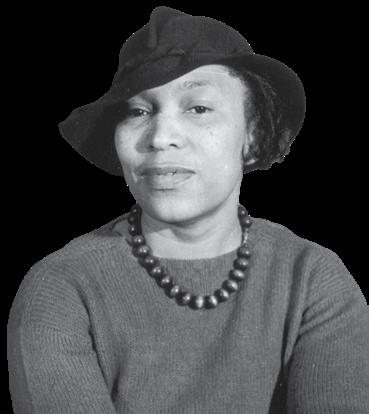
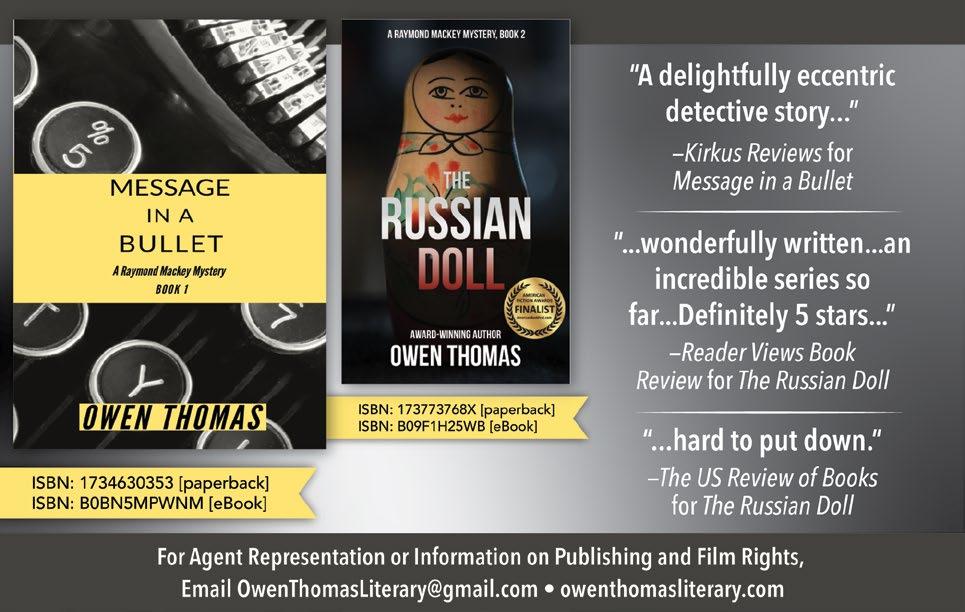

These new audiobooks will satisfy listeners who hunger for suspense.
BY CONNIE OGLE
ACTOR WILL PATTON has had experience with the tough yet eloquent works of James Lee Burke: He has voiced Burke’s laconic Cajun detective, Dave Robicheaux, since 2005’s Crusader’s Cross , the 14th book in the series. Now, with his 24th novel, Clete (Simon & Schuster Audio, 9 hours and 20 minutes), Burke has finally produced a story told from the point of view of Dave’s protector and best friend, Clete Purcell, and Patton is along for the ride.
The story follows Clete’s meandering yet increasingly dangerous investigation into the appearance of a deadly new drug with world-altering potential. The usual criminals, lowlifes, and big-city outsiders eager to exploit Louisiana’s rich history and resources add intrigue, including a film crew in town to scout for a movie entitled Flags on the Bayou (Burke’s Civil War novel, which won the Edgar Award earlier this year).
The violent Clete has long been larger than life, his background the stuff of legend. Believing in him as a person who might actually exist, though, has been hard at times. Patton’s gruff reading brings the
man back down to earth. His interpretation helps Burke reveal a vulnerable streak that makes Clete feel more real than he ever has.
A crime novel that jumps around in time can be tricky to follow via audio, but listening to Liz Moore’s The God of the Woods (Penguin Audio, 14 hours and 35 minutes) is anything but a struggle. Moore carefully labels each chapter with the date, and you do need to pay attention. But narrator Saskia Maarleveld draws in listeners with a terrific performance, persuasively embodying characters of different ages and backgrounds.
When a teenager disappears from her camp in the Adirondacks in the summer of 1975, counselors, cops, and rescuers leap into action. She isn’t just any lost camper: She’s rebellious Barbara Van Laar, daughter of the camp’s wealthy owners, and her older brother Bear vanished under similar circumstances years earlier and was never found.
The God of the Woods unspools as a crime procedural, but Moore (Long Bright River) infuses the familiar missing-girl story with an
understanding of decades of wealth inequality in upstate New York. Maarleveld, who also read this year’s entertaining thriller First Lie Wins , puts you in the heads of the women at the heart of the story and makes you care deeply about the outcome.
Don’t be surprised if you feel a flutter of déjà vu while listening to Nicola Yoon’s riveting One of Our Kind (Random House Audio, 8 hours and 31 minutes). This satiric thriller feels like the child of Get Out and The Stepford Wives , with a touch of Rosemary’s Baby, all seasoned with Yoon’s devastating take on

racial justice and cultural responsibility.
The story follows a Black couple, Jasmyn and King Williams, who move into an affluent Black community called Liberty with their young son. King relishes the utopian neighborhood, but Jasmyn, an attorney driven by the desire for social justice, is troubled. Why don’t her neighbors care about the oppressions she has devoted her life to fighting? And what’s going on at Liberty’s mysterious wellness center? Reader Nicole Lewis helps hammer home Yoon’s points, capturing Jasmyn’s rising unease so thoroughly it shakes your own sense of well-being.


In Buell’s thriller, a cold-case inspector investigates a pattern of missing Indigenous girls in Alaska.
Dr. Bethene Dubrow, a psychologist working as a consultant in Analoon, a small village in the hinterlands of Alaska, makes an alarming discovery about female students who have gone missing over a span of years. Annie Brewster, lead inspector with the Cold Case Unit of the Alaska Investigation Bureau, and her partner, Arturo Feliz, take up the case when this information reaches them; they’re grimly certain the peculiar pattern can’t be explained by random chance. The situation is affectingly depicted by the author: rationally, “the lack of girls in three of the five village schools, other than teachers’ children, [must have been] a coincidence. It didn’t feel that way: the great mentor in the sky said there were no coincidences.” The vanishing girls are Indigenous, which adds obstacles to their inquiries,
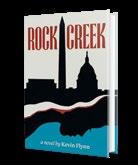
given the culturally closed world from which they come. Annie and Arturo, undaunted, doggedly chase down leads and start to uncover a grisly picture of organized human trafficking that appears to involve a school principal, Alan Prold, rumored to have had inappropriate sexual relations with young village girls. Additionally, Octavia Tallignuit, a young Indigenous girl who was reported to have been drowned by her family in 1990, mysteriously turns up dead years later.
With remarkable lucidity and great suspense, Buell unpacks this densely complicated case, in which unalloyed evil tragically intersects with youthful innocence. Her characters are just as complex as the plot— they’re tightly woven personalities, too dynamic to ignore or be fully understood. Annie is the most memorable character among the cast, a remarkably perceptive detective motivated in part by her own residual trauma from sexual assault. The author sensitively
Rock Creek Flynn, Kevin Kilimanjaro Press | 348 pp.
$27.53 | May 14, 2024 9781662950179
This review originally ran in the June. 1, 2024, issue.
In Flynn’s mystery set in 1950s Washington, D.C., a self-destructive detective risks everything to learn the truth behind the death of a young woman.
Detective Shane Kinnock, a traumatized World War II veteran, was once a man of principle who thanklessly investigated

Buell, Nancy With Buell, Bill Self-published | 428 pp. | $10.99 Sept. 28, 2023 | 9781737557982
This review originally ran online Nov. 1, 2023.
portrays a strange feature of the crimes—they’re basically perpetrated in plain sight, yet conducted with relative impunity. Without offering any simplistic or didactic commentary, Buell sketches a picture of how that can occur—how amoral people can avoid the interference of the decent. At the heart of the book is the peculiar nature of cold cases, and the ways in which they stymie the normal methods of investigation. “In cases proceeding from a missing person, the victim was the investigation. You couldn’t ‘see’ the crime. There often was no obvious evidence, in the classic sense. You were seeking a ghost.
The daily habits of the victim became the path to follow, moving out in concentric relationship circles until you found someone who knew something.” The entire book is written in this manner—the prose is impressively clear and concise, as is the way in which the author’s unsentimental, even journalistic descriptions accrue a power of their own, unforced by writerly exertions. Any book that handles the abuse of children courts mawkish melodrama. Buell artfully avoids this trap, and the result is an exceedingly thoughtful and dramatically moving novel. A stirring crime story with real psychological depth. (Fiction.)
police corruption and longed to right the world’s wrongs. Now he’s a heavy drinker who’s only hanging on to his job because his congressman father knows the right people. In Rock Creek Park, an untamed wilderness in the middle of Washington, D.C., he finds the body of a long-dead
young woman. It’s a mystery that will test him to the breaking point before he learns the truth of who this woman was and who wanted her dead. Shane becomes a man driven by his own ghosts, determined to find justice for this victim, and perhaps redemption for himself. Flynn combines the best of noir detective fiction with spartan, affecting prose. The tale highlights the rampant corruption and flagrant racism of 1950s Washington (“a town full of hatreds”) while still weaving a thread of hope via the character of Shane, a grieving knight errant who still longs to do right by a world that has often cast
him as a villain. He travels the streets of beautiful, broken Washington following desperate leads, trusting the wrong people, and finding unlikely allies, unable to stop until he finds his answers. Readers will hope he finds some relief for his self-hatred and begins to find his true self again. Flynn’s writing also drives the story of a young woman with a tortured past and intertwines it with the protagonist’s determination to solve the mystery of her death. Overall, it’s a riveting whodunit with surprising twists that calls to mind the works of Raymond Chandler. An affecting and compelling crime novel. (Fiction.)
Charles offers the second installment in a cozy murder mystery series for book lovers, following Murder at the Estate Sale (2020).
The Antiquarian Book Fair in St. Petersburg, Florida, seems like an unlikely setting for foul play, but it provides a rich background for this appealing whodunit. Emma Clarke and Molly O’Donnell are both antiquarian booksellers based in Atlanta, and each year they meet up at the fair to show off, and hopefully sell, their most valuable acquisitions. When fellow bookseller Jasper Ross goes missing, along with several of Emma’s most sellable books, she teams up with Molly to find him. Shockingly, Jasper’s corpse turns up by a local hotel’s dumpster. Emma is horrified by his demise, and also concerned

that the valuable books he borrowed may be lost forever. As local police investigate, other booksellers find that their own most valuable items are vanishing, too. When some of the tomes mysteriously reappear, the sellers are aghast that pages with color plates have been “surgically cut out.” Suddenly, the friendly, close-knit world of the fair takes on a sinister aura as Molly and Emma suspect customers and colleagues alike. They scour used-book and print shops looking for missing volumes, excised color plates, and clues regarding Jasper’s death. Along the way, they find allies and informants, including print dealer Stewart, who understands but deplores the illicit trade in stolen color plates. None of the characters in
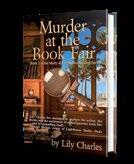
Charles, Lily Black Opal Books | 218 pp. | $12.06 Oct. 21, 2023 | 9781953434906
This review originally ran online Dec. 14, 2023.
Charles’ novel are explored in great depth, although romantic tension between Molly and Emma builds to a crescendo, and Emma fights off pangs of jealousy when she meets one of Molly’s former loves. The plot is also sometimes slowed by the author’s atmospheric descriptions: “The shop had a lot of floral and herbal prints, maps, and advertisements from early twentieth-century
magazines—hair tonics, radios, shoes, remedies: old ads for ‘Brylcreem—a Little Dab’ll Do Ya.’” As the plot unfolds, however, readers with interest in the world of booksellers, and the unusual characters who inhabit that world, are likely to be charmed and delighted. An eccentric world of antiquarian booksellers comes alive in this uneven but often delightful mystery. (Fiction.)
The Legacy
Gilbert, James Joshua Tree Publishing 150 pp. | $15.95 | Sept. 9, 2023 9781956823219
This review originally ran online Nov. 27, 2023.
In this novella, a freshly minted attorney at a prestigious firm becomes suspicious that his superiors are involved in a fraudulent scheme.
Adam Chauncey is as green as a lawyer can get, occupying the lowest rung on the ladder at Smithson and Dwyer, one of the toniest firms in Chicago. He’s invited to lunch by a senior partner, Bill Evans, a strange request that sparks another: The veteran attorney asks Adam to become a co-executor of a will he’s in charge of and refuses to name the document’s author. Naïve and quick to please a superior, Adam reflexively agrees.
Suddenly, when Evans shows signs of cognitive diminishment and steps aside, Adam finds himself in charge of a will that represents a considerable estate, one formerly owned by Percy Landsman. The will is complex and peculiar—Percy has left much of his largesse to his estranged brother, Eric, and mentions his “original birth family.” Adam discovers Percy was the product of an illicit affair between an unknown father and a Latine housemaid. With tantalizing suspense, Gilbert follows Adam’s gathering suspicions that something is amiss at his own firm, especially when he finds,
with the help of Sally Warren—a paralegal for whom he develops romantic affections—a copy of the will. The duplicate document features contradictory scrawled notes. When he turns to his bosses for clarity, he encounters a “conspiracy of silence” or vague threats. The author skillfully combines an utterly dark subject matter—the furtive exploitation of the dead—with generally lightsome prose and plenty of comic relief, often conveyed in the flirtatious banter between Adam and Sally. They are outsiders in this world of powerful privilege. With great delicacy, Gilbert explores the ways in which both of them are simultaneously (and contradictorily) repulsed by this cosmos and pine to belong to it. In fact, they’re eventually faced with a stark moral dilemma that compels them to choose either their upwardly mobile ambitions or their sense of decency. It’s intriguing to see
Adam, an “innocent, gangly young lawyer,” transform from a callow dupe into a more mature man who reflects with depth on what motivates him. When Sally suggests he might be inspired by a sense of justice, he’s uncertain: “That’s a nice way of putting it, but I’m not sure of my motivation anymore, except that something bothered me from the start—and is still bothering me. I thought I had put it to rest. But I guess I hadn’t. And I don’t like the feeling.” While there’s obviously a potent moral dimension to Gilbert’s tale, this is not the literary expression of some stale lesson drawn from a catechism, or a simplistic parable offered in a professorial spirit of didacticism. The author avoids any hint of tendentious proselytizing or facile reductionism. This is a marvelous novella, piercingly intelligent yet thoroughly unpretentious. An absorbing legal thriller that’s both powerful and delightfully nuanced. (Fiction.)
An inspired street artist in an alternate-universe Los Angeles accused of murder struggles to clear his name in this debut novel by S. California graffiti artist Tyler declares: “Graff is my life. I was born to get up on walls.” His dedication to a life decorating buildings and billboards is realized by seeing the four letters of his tagname, “SOBR,” all across Los Angeles. But in this futuristic setting, defacing public property is a heinous crime (the text includes pages of laws for these and other offenses). Over time, Tyler has emerged as a notorious, law-skirting graffiti artist in the novel’s futuristic, bizarro version of the United States in which a “king” reigns supreme enforcing an expansive array of ultraconservative laws. One night, while he is on a South-Central LA rooftop, Tyler witnesses a shadowy figure disposing of a body in an alleyway below him. After noticing Tyler hovering stories above him, the murderer cleverly manages to frame him for the crime and flees the

scene. An APB for Tyler’s arrest leads to a series of exciting adventures around the city as the protagonist evades the law and a dogged media as he desperately searches for a way to exonerate himself.
S. is an impressive writer able to conjure a futuristic Los Angeles complete with draconian laws and a constrictive conservative governmental hierarchy. The author’s intriguing premise of an anarchic graffiti artist on the run from the law is unconventional and will draw the interest of suspense, mystery, and crime-fiction readers who enjoy a little noir atmosphere with their action scenarios. The story also incorporates Greek mythology, highlighting the spiritual aspects of the hymns, verses, and prayers to Dionysus/ Bacchus Tyler utters in his most desperate moments. Tyler is an immediately enticing character—an artist who scales structures, ascending like Spider-Man in the name of tagging billboards and the sides of buildings for art’s sake, always remaining on vigilant
Raven’s Grave
Stuart, Charlotte
Vine Leaves Press | 300 pp. | $17.99 Sep. 19, 2023 | 9783988320223
This review originally ran in the Nov. 15, 2023, issue.
Stuart presents a murder mystery set in small-town 1970s Alaska.
Jonah St. Clair, the only police officer in the tiny Alaskan town of Koloshan, investigates the death of 10-year-old Johnny Simpson. The boy seems to have died as the result of a potion given to him by a native Tlingit shaman named Chaaky, who
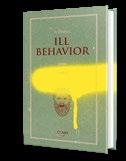
S., M. Steven
Clash Books | 254 pp. | $18.95 Nov. 23, 2021 | 9781944866983
This review originally ran online April 16, 2024.
watch for law enforcement. In often breathless prose, S. realistically details the stealthy nature of SOBR’s art escapades, which result in a series of close calls while he tags structures and then skillfully and swiftly evades surveillance officers on his bicycle “with a duffle bag (filled with illicit items) at one in the morning, swinging from a rope under a billboard like Errol Flynn in some goddamn urban swashbuckler film.” Peripheral characters, like Tyler’s skeptical friends; housemates who argue about wealth disparity, corporate power, and excessive consumption; and sneaky art gallery owners intermingle with descriptions of artwork and religious hymns to add spice to the story. The plot itself is riveting and transgressive, with
philosophical introspection adding rich counterpoint to all of the action. A digression contemplating the differences between graffiti and outdoor advertising is as thought provoking and compelling as the segments about how government ignores the urgency of climate erosion. Ultimately, readers will root for the hero to freely fulfill the “inspired genius” of his artistic destiny and escape the steely clutches of a wrongful allegation. This novel’s combination of an engaging protagonist, evocative detail and setting, and riveting plot makes for a winning debut for an author with obvious potential. A uniquely imaginative and enthralling suspense thriller set in a futuristic LA. (Fiction.)
was trying to cure the boy’s limp. St. Clair is trying to withhold judgment; although the locals have already mentally tried and convicted Chaaky, St. Clair reminds himself that the death could have been an accident, although other events—including a disappearing man and a disappearing fortune—start
to seem interconnected in ways that will test St. Clair’s skills, which were honed by six years with the LAPD (and two years of service in Vietnam). At first, the case of the missing man seems more straightforward, particularly since the world of Tlingit mysticism is, in many ways, the antithesis of the scientific, forensic world of modern crime: “With less science to explain their world,” St. Clair reflects at one point, “the Tlingits, like other people throughout the world, had welcomed actions that had the appearance of exerting control over the unknown.” But if Chaaky is innocent, who might be
responsible for little Johnny’s death? His father? His older brother? And how does it all connect to the missing man and the missing money? Patiently and skillfully, the author unfolds a story that’s equal parts traditional mystery and atmospheric evocation of Alaska’s people and customs, in the tradition of Dana Stabenow’s beloved Kate Shugak novels. St. Clair emerges as a stolid, self-possessed rock of a hero for the book, and Stuart is equally adept at fleshing out her cast of supporting characters. A solidly constructed and very satisfying murder mystery set in a largely vanished Alaska. (Fiction.)
Heras delivers a rollicking murder mystery—starring cats and dogs—set in 1950s New York City.
Flint Lockford, an Irish wolfhound, is a top investigative reporter at the Knickerbocker Gazette and is preparing to propose to his girlfriend, an Angora cat named Bianca Moon. Things couldn’t be better— until he is unexpectedly crushed by a falling piano. Left to wander the city as a ghost, he is quickly taken in by a group of fellow shades and waits for the detectives assigned to his case to figure out his death was murder, not an accident. Junior detective Morton Digby, a border collie mix, has a new partner, a Scottish terrier named J.B. Puddleworth,
who is slow to figure out that they’re at the bottom of the pecking order at the precinct—they have a hard time convincing their superiors that the piano was cut loose on purpose. The duo begins to investigate suspects who might have had a bone to pick with Flint over one of his articles. Meanwhile, Flint’s bereaved girlfriend, Bianca, is spitting mad and not about to sit idly by while the detectives bungle the case. Along with her alley cat friend, Roxy, and the ghost of Flint whispering in her ear, she begins asking her own questions. Anthropomorphic cats and dogs living in 1950s New York is a tricky conceit to pull off, and the author does
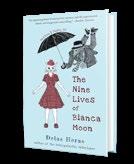
Heras, Delas
Double Six Books | 416 pp. | $17.00 June 20, 2023 | 9781735317557
This review originally ran in the July 1, 2023, issue.
so with flair (“Adapting to apartment-style living was proving to be a big adjustment for the Scottie and his wife, especially as they had a family of Saint Bernards living directly above them”). There is a large cast of characters, both alive and spectral, and they are all vividly drawn without pulling attention from the protagonists. These are cats
and dogs you’d want to be friends with (well, most of them). The period detail in the descriptions of the city is impressive, and the story does a deft job making light entertainment of a tale filled with murder and vengeful criminals. A quirky premise and sharp twists and turns make this mystery page-turning fun. (Fiction.)

Self-published | 198 pp. | $22.50 Aug. 1, 2023 | 9781734464160
In Wiseman’s third series installment, Sherlock Holmes delves into a baffling case of apparent death by magician.
In 1894, three years after his confrontation with Professor Moriarty at Reichenbach Falls, the famed sleuth of London’s 221B Baker St. is tackling a new case—a highly peculiar one involving apparent blackmail.
Someone has been sending wealthy widow Margaret
Jones what appear to be diary entries in her own handwriting that allude to her brief extramarital affair. However, she swears she didn’t write them, and oddly, the sender has made no demands or threats of any kind. Meanwhile, magician Percy Simmons, who had the affair with Jones, has his own troubles: He believes that another unknown conjurer is somehow sickening and killing people connected to
Simmons’ secret theosophy order. Soon, the ever dependable Dr. John Watson lends his expertise and social graces to becoming a prospective member of Simmons’ group. Meanwhile, Simmons’ talk of “evil” unsettles Holmes, who seems particularly distraught over the fact that he’s at least partially responsible for Moriarty’s demise. Wiseman’s latest series installment is a worthwhile, intricate whodunit. Holmes investigates dual cases with an “unseen enemy” or two and varied crimes, including murder and burglary. The mystery deepens as the body count rises and alleged feats of magic, like astral travel, seem to defy Holmes’ cherished logic. Readers will likely predict some of the final-act
events, but there’s more than one turn they may not expect. The sleuth’s mental turmoil in this story is convincing and effectively shows his humanity; it also coincides with his typical, familiar anti-social behavior. Watson, although he doesn’t fill a more familiar role as narrator, is an endearing counterpart to Holmes, and he meticulously relays to the detective his own experiences and observations. Throughout, the author’s measured prose is comparable to Sir Arthur Conan Doyle’s literary style: “Cooing and consolation might have tipped my client over into hysterics, whereas my uncompassionate question had a sobering effect.”
A smartly written and riveting detective story. (Fiction.)
Hubbard’s historical novel, loosely based on a true story, transforms a 19th-century scandal into a multifaceted detective story with modern resonances.
Charles Kelsey, a “small, eccentric” poet “with long hair and mismatched clothing,” is an outcast in the community of Huntoria, New York, in 1872. He takes an interest in Lucy Jane Hanson, who’s engaged to a prominent member of the esteemed Royals family, and they have a secret, months-long affair. Lucy Jane, overwhelmed, concocts a malicious (and fictitious) rumor about Charles, which swiftly spreads through town. One night, Charles, while waiting outside of Lucy Jane’s
window, is dragged off, tarred, feathered, and made to disappear. The town’s elite, eager to bury the scandal, claim he was merely sent away on a boat to Connecticut. However, Cathleen, Charles’ resolute sister, suspects a more sinister truth. Teaming up with the weary and aged local constable, Alexander Ruggles, she embarks on a quest for answers, delving into the murky depths of small-town politics and social stratification. As the investigation deepens, the narrative seamlessly shifts through multiple third-person perspectives and timelines, each adding depth to the well-crafted cast of characters. The narrative structure skillfully melds the familiarity
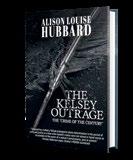
Hubbard, Alison Louise Black Rose Writing | 360 pp. | $24.95 Jan. 25, 2024 | 9781685133597
This review originally ran in the Feb. 1, 2024, issue.
of a crime procedural with historical insights into a real-life scandal that once shocked the citizens of Huntington, New York. The stark contrast between the poor Kelsey and rich Royals families not only captures the era’s class dynamics, but also echoes relevant, contemporary themes of social inequality. Although the story’s pace occasionally slows, and
reader engagement may fluctuate among the different characters, the steadily unraveling mystery maintains a consistent momentum. As Hubbard fills in more backstory with each chapter, readers will root for Cathleen to finally uncover the truth. A captivating journey that offers historical intrigue and modern social commentary. (Fiction.)






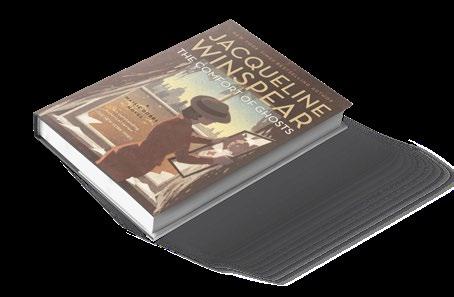
The
provide the setting for two interlinked tales.
DEATH BY MISADVENTURE
Alexander, Tasha | Minotaur (304 pp.)
$29.00 | Sept. 24, 2024 | 9781250872364

The beautiful Bavarian Alps provide the setting for two interlinked tales. In the winter of 1906, Lady Emily Hargreaves and her clever husband, Colin, are staying with Baroness Ursula von Düchtel in the modern villa built to show off her eclectic art collection. The most unpleasant of Ursula’s equally eclectic guests is her son-in-law, Kaspar Allerspach, a handsome boor who seems cool toward his wife, Sigrid. Among the topics discussed by the guests is the death of Ludwig the Second, aka Mad King Ludwig, who either died by suicide or was murdered 20 years earlier. Alternating chapters set in 1868 present Ludwig’s relationship with Niels von Schön, son of a baron who disapproves of his lifestyle, and provide clues to solving a murder that won’t take place until 1906. After Kaspar narrowly escapes death in a skiing accident, it’s clear that someone has it in for him. Then, on a visit to Ludwig’s Castle Neuschwanstein, someone shoots at Kaspar. It seems inescapable that the shooter is one of Ursula’s guests. Lady Emily questions everyone but comes away with nothing more than suspicions. Although Kaspar seems to be the one in danger, it’s Sigrid who’s shot dead while they’re out on a sleigh ride. Because she’d been supported financially by Ursula, her death leaves her husband distinctly worse off. But more intrigue swirls around the tangled relations among the
diverse group of guests, including a beautiful narcissist who’s having an affair with Kaspar. Once a snowstorm cuts them off from help, it’s up to Emily to unmask a killer.
A mystery that keeps you guessing while you enjoy the historical retrospective on the Mad King.
Brand, Christianna | Poisoned Pen Press (256 pp.) | $15.99 paper Sept. 24, 2024 | 9781464216411

Brand (1907–88) locates this Golden Age whodunit, first published in 1947, in a setting both cozy and hellish. Even in his palatial English estate of Swanswater Manor, it doesn’t take much to set off Sir Richard March for reasons that have nothing to do with the Blitz of 1944, which is littering the neighborhood with bombs on a regular basis. When his adult grandchildren’s idle discussion is suddenly punctuated by Edward Treviss’ revelation that his cousin Dr. Philip March has been exiled to the spare room because he’s cheating on his wife, Ellen, with another cousin, Claire March, Sir Richard grows testy and vows to disinherit the lot of them, even nurse Peta March, who as the daughter of his firstborn son is his heir apparent. Demanding that family solicitor Stephen Garde get down to the business of drafting a new will posthaste that leaves everything to Bella, the former mistress he married after his beloved first wife died, Sir
Richard, who’s clearly never read any detective stories, hies himself off to the estate’s lodge, where he’s found dead the next morning, poisoned by the coramine someone pinched from Philip’s medical bag. That someone was obviously very close to Sir Richard and all the suspects, and it’s no easy task for Brand’s franchise detective, Inspector Cockrill, to interrupt the witty buzz of their theories, suggestions, and accusations long enough to identify the killer just as the Blitz strikes alarmingly but predictably close to home. Despite the small number of suspects, fans with a taste for formal whodunits can rest assured in the certainty that they won’t beat Cockie to the solution.
Perhaps the most underrated country-house mystery of them all.
Byron, Ellen | Severn House (256 pp.) $29.99 | Sept. 3, 2024 | 9781448312658

Joining forces with their neighbors brings both rewards and challenges for the staff at Bon Vee Culinary House Museum.
It’s hard to imagine a celebration better suited to showcase the essence of New Orleans than Halloween, whose antic revelry digs deep into the city’s historic multicultural roots. And it’s hard to imagine a better guide to that celebration than Miracle Fleur de Lis James-Diaz. Born in New Orleans but raised by an adoptive family in the San Fernando Valley, Ricki returns to “The City That Care Forgot” to work at Bon Vee, in the Garden District, where she discovers a birth-family connection to Genevieve Charbonnet, Bon Vee’s original owner. As Ricki prepares for the massive collision of drinking, partying, and spookiness that mark Halloween in her new hometown, she runs into a traumatic reminder of her life in California. Actor Blaine Taggart, who took part in an internet stunt that led to the death of Ricki’s husband, moves into
Duncan-Sejour, the mansion next door to Bon Vee. Ricki struggles to balance her resentment of Taggart with her appreciation of his boundless energy and willingness to partner with Bon Vee’s efforts to take Halloween in New Orleans to a whole new level. Even the murder of his assistant, Miranda Fine, can’t dampen Taggart’s gung-ho spirit. Ricki’s attempts to merge the Bon Vee gang with the Taggart clan have more ups and downs, especially when they shine new light on her mysterious family origins.
Byron’s heroine navigates a bumpy road with grace and panache.
Chouinard, Michelle | Minotaur (336 pp.)
$28.00 | Sept. 24, 2024 | 9781250359308

The guide who launched the SF Killer Crime Tours turns her attention to sleuthing, bolstered in both capacities by a most improbable qualification.
Capricorn Sanzio’s grandfather, William Sanzio, was convicted years ago of being Overkill Bill, a serial killer who took an exceptionally thorough approach to his profession. Now, years after her grandpa died in prison still protesting his innocence, it looks very much as if someone is imitating Overkill Bill’s not-just-dead-but-reallydead approach to homicide. When Sylvia Clement, the old-money mother of Capri’s cheating ex, Todd, announces that she’s done paying tuition for her granddaughter Morgan’s graduate school, Capri, desperate to raise money, hatches the idea of writing a true-crime book about Overkill Bill and his copycat. No sooner has Capri reached out to homicide inspector Dan Petito to get his take on the murder of socialite Katherine Harper than the copycat claims a second victim: Sylvia Clement, whom both Capri and Morgan had abundant reason to want
dead. Once Capri’s motive switches from financing Morgan’s education to keeping her daughter and herself out of prison, her detective skills get sharper, and she’s willing to learn from any source, even a YouTube tutorial on picking locks. Despite its trendy title, this is really a story about family ties, and the complicated connection that emerges between murderer and murderees is both ingenious and deeply felt. Capri even gets another crack at solving the mystery of Overkill Bill in an epilogue that’s as heartwarming as it is anticlimactic.
Just the thing for readers who want to learn about all those other hearts that got left in San Francisco.
Dara, Maxie | Berkley (352 pp.) | $19.00 paper | Oct. 1, 2024 | 9780593815793

The unlikely duo of a grim reaper and her teenage catch investigate the boy’s insistence that his death was murder. Everything you’ve heard about death is true, from the soul moving on to another place to the grim reaper coming to collect you. Well, that last part is a little more bureaucratic than you’d think, thanks to S.C.Y.T.H.E. (Secure Collection, Yielding, and Transportation of Human Essences), an under-the-radar agency that’s just like the post office except that instead of delivering mail, it collects souls. Like all bureaucracies, S.C.Y.T.H.E. is full of employees who are just doing
their jobs without asking a lot of questions, and middle-aged Kathy Valence is one of them—at least until she goes on a routine pickup and learns that 507032, the soul of 17-year-old Conner Ortiz, is nowhere to be found. With just 45 days to get Conner to move on or become a ghost, Kathy has no idea what to do, and her intense boss, Stu Calhoun, seems to have a bee in his bonnet about the case. Weird. Nor is that the extent of Kathy’s troubles, since she’s still sorting things out as a soon-to-be first-time mother with her almost-exhusband, Simon. Maybe this crazy case is the perfect distraction from her personal life. Once Kathy finally finds Conner, things only get more complicated. He insists that he’s been murdered by someone within the S.C.Y.T.H.E. organization, and he refuses to go with Kathy until she helps him figure it all out. Unsure whether she has any other options, Kathy teams up with Conner in a chalk-and-cheese combination sure to lighten the darkest mood. Come for the mystery, stay for the punched-up pairing. This new series is one to watch.
Delany, Vicki | Crooked Lane (288 pp.)
$29.99 | Sept. 24, 2024 | 9781639108794

America’s Christmas Town also celebrates Easter, but murder spoils the fun. Although Rudolph, New York, is a town
America’s Christmas
Town also celebrates Easter, but murder spoils the fun.
A SLAY RIDE TOGETHER WITH YOU
that lives for Christmas, it’s nice to take a break. Merry Wilkinson has reopened her gift shop, and her best friend, Vicky Casey, is busy baking Easter treats before her approaching wedding. Despite her excitement, Vicky is upset about her fiance Mark Grosse’s desire to buy Cole House, a big old Victorian in a state of disrepair and rumored to be haunted. Fortunately, there are enough rooms in decent shape to accommodate them while they slowly work to restore the rest of the house. After they move in, Vicky’s sleep is disturbed by odd noises. Far worse is the arrival of Jim Cole, a relative of the former owner who thinks the place should belong to him. During a visit from Merry, both women hear loud noises, but a search of the house reveals nothing. When Mark arrives, he goes out to look around and finds Cole’s body in the garden. Once the police learn about Cole’s attempts to claim the house, Mark naturally becomes their prime suspect. Since Merry’s helped Det. Diane Simmonds solve other murders, Diane is annoyed but not surprised when Merry begins her own investigation into this one. Merry, her boyfriend, and even her mother, a famous opera singer, all pitch in to identify other suspects before the town gossips can convict Mark of murder. A look into the past helps the intrepid sleuths solve the mystery in a very satisfying way.

EXPOSURE For more by Vicki Delany, visit Kirkus online.
Emerson, Ramona | Soho Crime (288 pp.)
$29.95 | Oct. 1, 2024 | 9781641294768
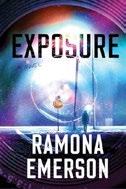
A pair of antagonists with eerily complementary vocations square off against each other.
Rita Todacheene, a Navajo photo specialist for the Albuquerque crime lab, not only sees dead people but hears them too, and they have plenty to say. Margarita Montaño, one of six children shot to death along with their parents, tells Rita that even though her surviving brother, Jude, has been in police custody ever since he walked into the First Desert Light Church with an empty revolver, he didn’t murder his family: “It was Daddy.” But although Steven Montaño left behind photographic evidence that he abused all three of his daughters, he was a retired Albuquerque PD detective, and the blue wall closes around him. Since no one credits Rita’s secondhand testimony—which, granted, does sound a little far-fetched—and the cops insist that she keep her ideas to herself, she quits her job, leaving herself unmoored and adrift. In the meantime, Brother Gabriel Jensen, who’s moved by an equally strong passion to help the street people of nearby Gallup by setting them free of their mortal coils, graduates to murdering former Gallup mayor Emmitt Gurley, whose ghost threatens Rita with serious harm if she doesn’t bring his killer, whom he declines to identify, to justice. The high-profile deaths that follow lead
Det. Arviso to ask Rita for help. Rita, who can’t turn down another Navajo, takes up the gauntlet, setting the stage for a final battle with an adversary who also hears voices and acts on them even more decisively than she does.
Less a mystery than a compelling, interlocked portrait of two troubled souls.
Falco, Michael | Kensington (368 pp.)
$27.00 | Sept. 24, 2024 | 9781496742162

A young widow finds adventure on the beautiful Amalfi Coast. It was Bria Bartolucci’s dream to run a B&B in beautiful Positano with her husband, Carlo. After he dies in a plane crash, she honors his memory by opening Bella Bella as planned, showing her young son, Marco, that it’s “better to confront a challenge than to cower from one.” Maybe it’s her love of challenges that leads Bria to probe the death of Luigi “Chef Lugo” Gordonato, who dies suddenly while filming a TV show at the cafe owned by her friend Annamaria. Or maybe it’s her friendship with handsome police chief Luca Vivaldi, her best friend Rosalie’s brother. There’s no dearth of clues— from notes crammed into fake cannoli to mysterious women canoodling with the victim-to-be on the beach, Bria’s got plenty to work with. But the sheer density of details weighs down what could have been a lighthearted frolic in a spectacular setting. After the long climb up the stairs to Bella Bella, Rosalie has an asthma attack, and it takes four paragraphs to get her breathing regularly again. Bria’s handyman replaces a tile “that had broken, thanks to the overgrown roots of an overzealous lemon tree.” It’s hard for readers to tell what’s a clue and what’s just a display of adjectival exuberance, and in either
case, their reaction is likely to be relief that it’s finally over. Too many subplots, too many distractions, even too much pastry.
The Saint Gerhardsen, Carin | Trans. by Paul Norlen Mysterious Press (336 pp.) | $17.95 paper Sept. 24, 2024 | 9781613165553
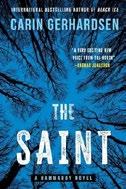
The latest case for the Police Violent Crime Unit in Hammarby, Sweden, starts with the murder of an apparently inoffensive banker and then spreads and spreads some more. None of his neighbors has anything but praise for Sven-Gunnar Erlandsson. He was kind to everyone, generous in volunteering for local causes, and conscientious about underwriting his regular poker game’s bank without calling attention to it. So why did someone shoot Svempa execution style when he was on his way home from his most recent poker session? At first DCI Conny Sjöberg and his mates wonder if the four cards found in his pocket might indicate that he was cheating at the rounds of poker he subsidized. But there are only four cards, not the five required for a poker hand. Cracks begin to appear in Svempa’s facade when Adrianti, the wife he met and married on a trip to Singapore, admits that in addition to the son and two daughters they’ve raised together, she has a daughter of her own who left home four years ago and whom she never talks about. Gradually Sjöberg and company discover that Svempa’s stepdaughter isn’t the only young woman who’s gone missing from the community. Larissa Sotnikova, an 11-year-old summer visitor staying with Staffan and Marie Jenner, vanished eight years earlier just before she was to return home. And Rebecka Magnusson, a 15-year-old with ADHD, ran away from home five months ago.
Working with a cast of characters who stubbornly refuse to develop any complexity, Gerhardsen labors to connect the disappearances at the heart of her story in ways that manage to be both obscure and obvious. A frustrating slog for all concerned.
Gilbert, Victoria | Crooked Lane (304 pp.) $30.99 | Sept. 24, 2024 | 9781639106431

A wealthy North Carolina man and his personal librarian make an odd but effective detective team. Cameron Clewe has been searching for the identity of his birth father with no luck. Brought up by a stepfather who left him the beautiful Aircroft estate and a great deal of money, Cam finds life joyless without knowledge of his biological father. Jane Hunter, who handles his library, and personal assistant Lauren Walker somehow keep him on track until Eloise Anderson, an antiquarian bookseller from Chapel Hill, arrives to ask Cam and Jane, who’ve already solved one mystery, to help prove that her mother—who recently died in prison—was innocent of murder. The sleuthing duo take on the case even though Eloise may be hiding things that make her mother look guilty. When Eloise herself is arrested for the murder of Det. Bruce Parker, who was in charge of her mother’s case, few believe that she’s innocent. But Cam pays her bail,
hires a lawyer, and takes her into his household while he and Jane search for another suspect. Parker had been looking for a book in Eloise’s storeroom, a book that may provide a motive for murders now and in the past. Jane is also searching for the identity of a woman whose photo was found in Aircroft’s attic along with a drawing of her. A servant who never knew her last name identifies her as Lily, the love of Calvin Airley, son of the estate’s former owners. Both the real motive for murder and the identity of Cam’s father are shrouded in secrets from the past.
The finely drawn characters are the stars in this complex batch of mysteries.
Goldberg, Lee | Thomas & Mercer (288 pp.) $28.99 | Sept. 17, 2024 | 9781662512384
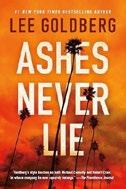
A series of suspicious fires proves to be only the tip of the iceberg in Goldberg’s latest dispatch from the San Fernando Valley. L.A. County Sheriff’s Department arson investigator Walter Sharpe and his gung-ho new partner, Andrew Walker, are called to the Chatsworth Nature Preserve, where someone has set a Toyota Camry ablaze. Soon afterward, following the trail of devastation left by a deadly virus that’s disappeared from Triax Biotech, homicide detectives Duncan Pavone, back from
The latest case for the Police Violent Crime Unit in Hammarby, Sweden, starts with the murder of a banker.
SAINT
retirement, and Eve Ronin, who’s recently had a TV series based on her work, track down Triax microbiologist Patrick Lopresti, only to watch his house explode in a fireball before their eyes, leaving Lopresti inside, shot in the head in a bizarre apparent suicide. Justine Bryce, Lopresti’s lover and presumed partner in crime who’s also been exposed to the virus, has reacted by going on the lam. Even when the cops confront her, she refuses to surrender for fear of infecting someone else. In the meantime, Sharpe and Walker have uncovered an epidemic of house fires in and around the Twin Lakes development blamed on the remarkably similar failures of domestic electrical appliances. There’s clearly a mastermind behind this crime wave. But what’s the connection between this mastermind and the Triax employee who’s blown up his own house rather than give himself up along with the virus? The path to answers and convictions leads to a San Diego SciCon in which Eve and Walker dress up as Wonder Woman and the Mandalorian in order to approach their suspect without arousing any suspicion and, incidentally, to provide a suitably colorful not-quite-finale to this knockabout procedural. Pure enjoyment for anyone who doesn’t happen to own a home in the Valley.

Hall, Traci | Kensington (320 pp.) | $17.95 paper | Sept. 24, 2024 | 9781496744395

A little friendship is a dangerous thing in the Scottish town of Nairn.
The Christmas season finds business booming at Paislee Shaw’s yarn and sweater shop, Cashmere Crush, but her living situation more questionable. Ever since she; her grandfather; her son, Brody; and their Scottie, Wallace, were displaced from their house by a burst pipe, she’s been staying in a flat owned by her best friend, Lydia Barron-Smythe—who refuses to take any rent—but hoping to return home soon. Amelia Henry, a receptionist at the police station who helps Paislee in the shop on Saturdays, mentions that her brother, McCormac, has returned from Ireland with an assortment of purebred pups, one of which might make a nice gift for Brody. He’s already given one of the pups to Amelia, along with a gift certificate for the dog’s first visit to the veterinarian. McCormac is handsome, apparently well off, and clearly admired by a number of ladies. But then he’s shot to death in front of Paislee and Amelia during the fireworks display at the Hogmanay festival, and Amelia begs her friend for help. Amelia loved her brother but admits that her entire family has been in trouble with the law, and
discovering a suitcase full of cash makes her suspect that McCormac was involved in something illegal. When Amelia’s puppy gets sick, Paislee drives them to the vet McCormac had prepaid, a decision that leads to many complications. Soon all the puppies are getting sick, raising further perils with the possibility that McCormac was smuggling puppies from Irish puppy mills and selling them for big bucks. Could that scheme have provided a motive for murder? Despite warnings from handsome DI Mack Zeffer, Paislee and Amelia put themselves at risk to find out.
This latest adventure of a charming Scottish family is perfect for readers who like thorny mysteries and puppies.
Hollis, Lee | Kensington (368 pp.) | $8.99 paper | Sept. 24, 2024 | 9781496743510
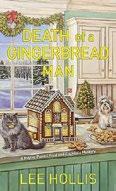
The return of a deadbeat dad throws a Downeast Maine town into a tizzy. Hayley Jordan’s father, Dwight, took off from Salmon Cove when she was just a girl, leaving her mother to raise Hayley and her brother, Randy, with no support. Hayley’s best friend Mona’s father, Bubba, stuck around to raise his family, satisfying his need for adventure with a yearly solo ice-fishing trip. But this year, Bubba’s forgotten his blood pressure medication, and when Mona and Hayley drive out to bring it, they get the shock of their lives: Bubba’s excursion isn’t a one-man jaunt after all. For the past few years, he’s invited his old friend Elmer Crawford—the amicably divorced dad of Hayley and Mona’s third best friend, Liddy—and Dwight Jordan, who is kinda-sorta hoping to worm his
way back into the bosom of Salmon Cove society. None of these players are spring chickens (Hayley just had her first grandchild), but they react to Dwight’s surprising return the way a bunch of middle schoolers would treat a new kid in town. Some folks see him as the flavor of the month; others are still stung by the way he mistreated them before he left. After a lot of bickering and side-choosing, the stakes go way up when people start getting killed. Carroll Flood is poisoned shortly after losing the town’s gingerbread house contest to Dwight. Then someone starts taking potshots at Dwight. There’s no dearth of suspects who might want to harm him: Hayley assembles a list of more than 100 people he’s hurt. Though ultimately Hayley cracks the case, the biggest mystery is why folks remain so enamored of someone who has done nothing but harm his whole life.
A weird tale of crime without punishment.
Horowitz, Anthony | Mysterious Press (512 pp.) | $28.95 Sept. 17, 2024 | 9781613165515
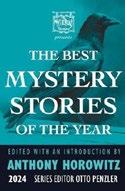
Nineteen of the year’s best stories highlight the healing power of crime fiction. In his introduction, editor Horowitz— whose works range from the
English village–set Midsomer Murders television series to James Bond novels based on unpublished material by Ian Fleming—advances the surprising proposition that what unites crime fiction is its ability to offer “kindness, decency, justice, and truth in a world that increasingly seems to have none.” A remarkable number of the year’s choices in this venerable series focus on the redemptive power of families.
In Shells Legoullon’s “The Backwoods,” Peter W.J. Hayes’ “El Paso Heat,” and Archer Sullivan’s “Good Harvest,” parents take extraordinary measures to shield their children from danger. Sometimes, it’s left to a grandparent or even a sibling to save a child, as in Fleur Bradley’s “How To Teach Yourself To Swim” and Cameron Sanders’ “Billowing Down the Bayou.” Public servants fill in when families fail in Dan Pope’s “Snow Over Hartford” and Annie Reed’s “Dead Names,” while Victor Methos offers a tale of two good Samaritans who join forces to reunite a family torn apart by a shocking incident in “Kill Night.” Parents struggle to make peace with their adult children in Ace Atkins’ “Stunts,” Leonardo Padura’s “A Family Matter,” and Andrew Welsh-Huggins’ “Wonder Falls.” And a son struggles to avenge his father’s death in Nils Gilbertson’s “Lovely and Useless Things.” Even nephews have their moment in Michael Bracken’s “Beat the Clock.” Like the arc of history, Horowitz says, these tales bend toward justice “at a time when it has never mattered more.”
Fans tired of meaningless violence should welcome this showcase of the redemptive side of the genre.
What do you do if a woman is found stabbed by shears engraved with your name?
Howell, Dorothy | Kensington (256 pp.)
$27.00 | Sept. 24, 2024 | 9781496740458

What do you do if a woman is found stabbed to death by shears engraved with your name? If you’re Abbey Chandler, you realize that you have to launch your own investigation yet again. Abbey left Los Angeles to live with her aunt Sarah in small-town Hideaway Grove, where Sarah’s bakery is a Main Street favorite. Abbey’s business of specialized tote bags has not taken off, so she works part time at the local visitor center. When she arrives early for work one morning, Abbey spills tomato juice on herself; Paige Easton, who arrives a few minutes later, screams when she sees Abbey, thinking she’s bleeding. Eleanor Franklin, the center’s most reliable staffer, is unusually late for work—and then Abbey finds her dead body in a bin of lost-and-found clothing. It’s hard for the sheriff, who’s not fond of Abbey, to believe she’s innocent when her engraved sewing shears are buried in Eleanor’s chest, and even Deputy Zack McKenna, her sorta boyfriend, is worried. Harriet Griffith, Abbey’s boss, is eager to keep the murder as quiet as possible so as not to ruin Hideaway Grove’s reputation as a friendly tourist town. Eleanor seems to have been well liked around town, known for helping people out, but once Abbey starts digging she finds that Eleanor actually had quite a few enemies. On top of the murder, Abbey finds that there have been high-end lost-and-found items going missing from the center. Before she loses her job and is arrested for murder, Abbey pulls out all the stops to discover the real killer.
All the cozy requirements of romance, plenty of suspects, and a warm small-town vibe.
Hyde, Katherine Bolger | Severn House (256 pp.)
$29.99 | Sept. 3, 2024 | 9781448311873

A reference librarian takes on the research task of a lifetime: unraveling the story of her mother’s disappearance.
Erin Washington feels that she’s been orphaned twice: once at 12, when her mother vanished, and again now that she’s 32 and her father’s died of cancer. The loss of her father, an airline pilot whose remote parenting style seemed at best attenuated, gives Erin some modest financial resources to take time off and properly explore her earlier loss. Starting in Pacific Grove, California, Erin finds her way to Seafarer’s Rest, where her mother stayed a few months after she disappeared. Besides the curiosity and orderly way of thinking Bolger Hyde evidently regards as the natural province of librarians, three strokes of good fortune power Erin on her journey. First, she has a vivid vision of her mother, Gina, staying in a room where she’s menaced by a man who means her harm. Second, her mother left a series of notes and postcards that help Erin track her journey northward. Finally, Erin finds someone at each stop who remembers her mother well and can provide information about what Gina might have been thinking and feeling. The result is a highly linear narrative that, despite the massive unlikeliness
that anyone would remember a single guest who stayed one or two nights in a resort 20 years ago, packs quite an emotional punch. Erin’s yearning to connect with her lost parent makes a case for overlooking the improbability and getting carried along on her trip up the scenic Pacific seacoast.
A picturesque picaresque.
Ireland, Liz | Kensington (304 pp.) | $17.95 paper | Sept. 24, 2024 | 9781496748935

Bad weather and unwelcome guests pose unexpected challenges for the redoubtable Mrs. Claus.
The Christmas Eve launch of Santa’s sleigh always provokes a frenzy of merriment as it rises into the skies above Santaland. But unpredictable weather and the constant threat of reindeer flu have made this year’s trip especially worrisome for April Claus. Although she’s shown increasing poise in her role as Santa’s wife, there are some things her Oregon upbringing just hasn’t prepared her for. So when a rogue sleigh crashes in front of Christmastown Municipal Hall, she and Constable Crinkles need to think fast. They transport the three unconscious passengers to the hospital knowing that when the patients come to, they’ll discover the
A reference librarian takes on the research task of a lifetime: unraveling the story of her mother’s disappearance. GINA WASHINGTON SLEPT HERE
secret of Santaland’s existence. That discovery would almost certainly lead hordes of tourists to descend, robbing the hidden spot of its unique character. April’s efforts to protect Santaland’s secret by pretending the magic place is actually part of Canada—for example, camouflaging the elves’ pointy ears with a variety of scarves and hats and playing Anne Murray and Celine Dion songs instead of the usual Christmas tunes—have a certain zany charm. But ultimately, the dodges become so comprehensive they get tedious. There’s a murder mystery that feels like an afterthought, and the problem of how to return the stranded travelers home turns out to be easy to solve. But the real problem here is that the charm of the franchise lies in its dedication to all Christmas, all the time. Making its inhabitants less Christmassy makes Santaland less fun. Here’s hoping Ireland’s next outing restores the most wonderful time of the year to all its glory.
Jónasson, Ragnar | Trans. by Victoria Cribb | Minotaur (320 pp.) | $29.00 Sept. 10, 2024 | 9781250770769
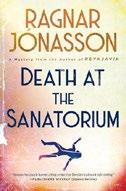
The retro title introduces a valentine to Golden Age whodunits relocated to Iceland.
Helgi Reykdal, a graduate student in criminology at an English university, has returned to Iceland. Last summer he interned with Reykjavík’s criminal investigation department, and there’s a job waiting for him there if he wants it. But he’s torn by his conflicting desires to return to the U.K. and to appease Bergthóra, the increasingly violent live-in girlfriend who wants him to stay. An additional inducement arrives with the possibility of
links to a high-profile murder compel her to investigate.
DANGEROUS PLAY
writing his dissertation on the deaths a generation ago of a nurse and doctor at a sanitorium in the provincial northern town of Akureyri. When both Tinna Einarsdóttir, the nurse who discovered both bodies, and Sverrir Eggertsson, the police investigator who allegedly solved the case back in 1983 by arresting what even he came to admit was the wrong suspect, summarily refuse to talk to him, his interest is naturally piqued. The circle of possible killers is tiny— Tinna herself, along with her colleague Elísabet, ambitious Dr. Thorri Thorsteinsson, and Broddi the caretaker—and in the course of Helgi’s investigation, one of them obligingly narrows it even further by killing one of the others. Inspired by his reading of classic mysteries with similar settings, from Patrick Quentin’s A Puzzle for Fools to Ellery Queen’s The Dutch Shoe Mystery, Helgi digs into the archives and questions the people who are willing to talk to him. The story, which toggles back and forth between 1983 and 2012, generates considerable suspense from a remarkably limited cast of characters living and dead. Clever, absorbing, and no more uplifting than you’d expect from this master of Icelandic noir.

For more by Ragnar Jónasson, visit Kirkus online.
Kipness, Elise Hart | Thomas & Mercer (286 pp.) | $16.99 paper Sept. 17, 2024 | 9781662512681

A sports reporter’s links to a high-profile murder compel her to investigate. Kate Green, a former Olympic gold medalist in soccer, is covering a high-stakes match the U.S. Women’s National Team is playing at Yankee Stadium. Reconnecting with old colleagues brings up some unsettling memories, and several controversies surround the current roster, including threats they’ve allegedly made against a competing team. The U.S. team’s celebration after their victory is short-circuited when Kate’s former teammate Alexa Kane, now a celebrity jewelry designer, is found dead in an ice bath in the training room. The death, which is clearly murder, triggers intermittent flashbacks for Kate about her complicated relationship with Alexa, which ended after a hazing incident 30 years ago. Kipness adds suspense by doling out the details of the hazing gradually through the rest of the story. When she’s questioned by aggressive special agent Mae Flynn, Kate fails to mention that she and Alexa have a history. Could her failure to disclose it jeopardize her journalistic career? She decides to probe the mystery on her own, motivated by a combination of
guilt, curiosity, and an unexpected email that she had received from Alexa shortly before her death but that Kate didn’t discover till later, after she returned home. The plot in Kate’s second case is a bit unwieldy, featuring an overabundance of suspects past and present, each with an attendant backstory. But Kipness’ depiction of the world of women’s sports, featuring crisp character portraits, is both relevant and well executed.
A brisk whodunit set in the world of women’s soccer that arrives at an appropriate moment.
Klein, Libby | Kensington (448 pp.) | $8.99 paper | Sept. 24, 2024 | 9781496744425
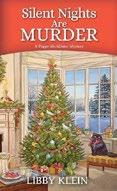
A woman renowned on the Jersey Shore for finding bodies is dragged into a murder case when a note left on a victim points directly at her. Middle-aged widow Poppy McAllister helps run her aunt Ginny’s B&B in Cape May, somehow staying levelheaded among all Ginny’s odd friends. As Christmas approaches, Ginny is competing with her neighbor to see who can stuff more decorations into their yards. Poppy’s police officer pal, Amber, often leaks information to her, but nothing before has approached the note saying “Get Poppy” found on a body in a freezer at the restaurant where Poppy used to work. The news brings out her sleuthing instincts, and she’s determined to save the owner, Tim, her ex-boyfriend, and Gigi, his very pregnant wife, from arrest. The dead man is Wes Bailey, the hated owner of Deepwater Fisheries, who Poppy discovers was pressuring people to buy his stock by means fair or foul. Ever since Poppy chose her current boyfriend, Gia, over Tim, Tim’s been bitter. Poppy knows sous chefs Chuck and Tyler from when she worked at
Tim’s restaurant, but the rest of the staff is new. So when Tim begs her to help clear him and Gigi by working undercover in the restaurant, she agrees. To add to her angst, Poppy’s mother, who dumped her as a child with Ginny and Grandma Emmy, books into the B&B under an assumed name and promptly begins searching the place. Poppy discovers plenty of problems among the restaurant staff and unearths lots of enemies Bailey had made, but finding the right motive is no easy task. Keeps you guessing and laughing from beginning to end.
Penrose, Andrea | Kensington (368 pp.) $27.00 | Sept. 24, 2024 | 9781496739964

The Regency period produced many inventions. The plans for one of them provide a motive for murder.
Charlotte, Countess of Wrexford, rejoices in the wedding of her best friend, Christopher “Kit” Sheffield, to mathematician Lady Cordelia Mansfield. All goes as planned until an intruder to Wrexford Manor must be driven off by Charlotte’s husband, the Earl of Wrexford, and “the Weasels,” two street lads educated and adopted by her family. After the ceremony, a magistrate and a surgeon arrive to announce the murder of an unidentified man with a wedding invitation in his pocket, whom they assume to be Cordelia’s cousin Oliver Carrick. Hearing their description, Cordelia realizes that the dead man is actually Oliver’s fellow scientist and her old friend Jasper Milton, immediately making Oliver a suspect. The four friends and the Weasels, who’ve been instrumental in solving previous mysteries, quickly delve into this one. Jasper had been working on ideas to improve bridges in a time when transportation is mostly for the rich. A brilliant engineer, he was also
philosophically opposed to the rich getting richer on the backs of the poor. Apparently several French factions are desperate to get the plans, including one that hopes to sell them to Russia for enough money to return Napoleon to power. Since His Majesty’s government and plenty of businesspeople are also anxious to get the plans, it’s no easy task to figure out which of them murdered Jasper. A conference brings many of the players together, giving the sleuths a chance to search for answers. They go down several dangerous and blind alleys in their painful hunt for the truth. A complex and surprising mystery enhanced by historically accurate information about the science and society of the period.
Quartey, Kwei | Soho Crime (336 pp.)
$27.95 | Sept. 3, 2024 | 9781641295888
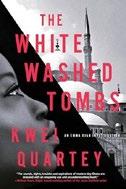
Quartey’s most personal crime novel asks Emma Djan and her colleagues at the Sowah detective agency to figure out who’s running through Accra’s LGBTQ+ community silencing its loudest voices.
Even before he’s killed, Marcelo Tetteh has already paid a high price for his activism. When he speaks out at a rally of the right-wing International Congress of Families, he’s grabbed by security officers, and his community is targeted by an aggressive new series of anti-gay laws backed by ICF leader Christopher Cortland; Peter Ansah, the minister of tourism, arts, and culture; and their allies in the ultraconservative religious and government communities. So it’s shocking but not entirely surprising when he’s hacked to death by what forensic evidence indicates are two assailants. Godfrey Tetteh, his grieving father, wants the Sowah Agency to identify his killers, who may also have executed Marcelo’s co-worker and friend Abraham
Quao. So Yemo Sowah, the agency’s founder and owner, sends Emma and Jojo Ayitey undercover to infiltrate the ICF. Jojo backs out because he’s a closeted gay man who doesn’t want his identity to compromise the investigation, or vice versa. But his reticence doesn’t protect him from getting arrested for the murder of famous transgender singer Henrietta Blay, who’s killed before she can talk to Emma. It’s hard to tell whether the murders are the work of a single mastermind or a wave of vigilantes because the public stance throughout Ghana is so horrendously antiLGBTQ+. Even though the persecutors’ obvious hypocrisy makes them all look guilty, Quartey manages to produce a culprit who’ll surprise most readers. Murder is only the tip of a ferociously toxic iceberg.
Riley, Vanessa | Kensington (320 pp.)
$27.00 | Sept. 24, 2024 | 9781496738684

Brought together by murder, Lady Worthing and her neighbor Stapleton Henderson are once again involved in a case that may prove the death of them.
Abigail Carrington Monroe, Lady Worthing—a half-Jamaican, half-Scottish aristocrat of mixed race—ardently hopes for the abolition of slavery in Britain. She and her cousin Florentina are attempting to cross London to spend Christmas with the Jamaican side of her family when their plans are almost derailed by a major snowstorm. Stapleton, her neighbor and partner in crime-solving, offers to take them in his sturdy carriage providing he can make a stop first in Berkeley Square to beg off a dinner party he was happy to get out of attending. But when they arrive at the home of Lord Duncan, they find the body of barrister Benjamin Brooks covered in blood and snow on a nearby
MURDER IN BERKELEY SQUARE
bench. As the storm rages, everyone is forced to stay at Lord Duncan’s dinner party, which he calls the Night of Regrets. No love is lost among the guests, who go one by one to their deaths, with Brooks followed by Duncan’s valet, a Black man named Peters. The deaths seem to follow the events in “The Rebel’s Rhyme,” a West Indian poem, part of which was on Stapleton’s invitation to the dinner. Even though they’re threatened, the men are unimpressed by Abigail’s reputation as a sleuth, and solving a series of murders may turn out to be simple compared to managing her personal life. Her seldom-seen husband has written suggesting that she have an affair and a child, and her feelings for Stapleton, a former Navy physician, are fanning the flames. Each death is different and few of the suspects have alibis. Who will remain alive when the poem is completed?
Lovers of Agatha Christie will find this puzzle both disturbing and delightful.
Walker, Martin | Knopf (304 pp.) $29.00 | July 30, 2024 | 9780593536629

Relax. All the deceased in police chief Bruno Courrèges’ latest case have been dead for a long time. But that doesn’t mean there’s no mystery about them.
Bruno returns from medical leave to his office, which has been commandeered by Colette Cantagnac, his overbearing new executive administrator, just in time to hear that English ex-chef
Tim Birch and his wife, Krys, want to purchase a vacant hotel, the Domaine de la Barde, and refit it as a cooking school. It sounds like a win-win for everyone, but there’s one problem: what to do about the neglected grave on the building’s grounds. A quick excavation in the presence of visiting American archaeologist Abigail Howard reveals a dog buried there; a deeper dig discloses three human skeletons—two naked females and one fully clothed male. The women are pretty clearly Luftwaffe officers Anna-Liese Weber and Hannalore Franke, who died in 1944, but it’s not at all clear how the man can really be Italian captain Salvatore Todaro, whose identification papers he carries, since Todaro was killed in 1942 on board the submarine he commanded. By the time this third corpse is properly identified, the brew will include other complications: attempted cyberattacks on Bruno and others, the threat of some once-in-alifetime floods, and the difficulties in both establishing the truth of what happened back in 1944 and what the French, Italian, British, and American authorities who are involved can do about it now. The questions Walker raises about the wartime foundations of the comfortable social fabric and rituals Bruno and his friends in St. Denis take for granted are so ambitious that it’s no great surprise that they’re more compelling than their answers. An overstuffed memorial to the days of World War II.

Wetsel, Laura | CamCat Books (320 pp.) $29.99 | Sept. 24, 2024 | 9780744311211
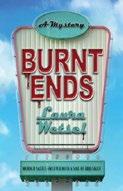
A K ansas City detective gets drawn into an accidentaldeath case that forces her to confront raging personal demons as she investigates members of her estranged family.
For more by Martin Walker, visit Kirkus online.
Tori Swenson doesn’t especially want to investigate a cook’s accidental death at her uncle Charlie’s barbecue restaurant. A backsliding opioid addict, she has enough to deal with without reopening old family wounds. But she’s also determined to exact revenge on her uncle for cutting her out of the lucrative business he stole from her father, even if it means resorting to underhanded tactics like submitting a false case request to look into the cook’s death. Under pretense of seeking reconciliation, she attends a Fourth of July barbecue at Charlie’s house only to witness her uncle’s sudden, inexplicable demise. When Tori is fired from her agency for unofficially taking on the accidental death case, she knows that someone—perhaps the killer—wants her out of the way. She presses forward, seeking answers from the rich, eccentric cousins she loves and hates, even as severed piglet heads, death threats against her beloved aunt Kat, and her own intensifying addiction to OxyContin jeopardize her investigation at every turn. With every secret Tori uncovers on her quest—infidelities, abuse, and plots to gain control of (or destroy) Uncle Charlie’s barbecue empire—she comes closer to a killer who nearly transforms her into the dead meat that represents everything Tori hates about her dysfunctional family. Quirky and entertaining, this book and its unforgettable characters, tight plotting, and clever twists make for a reading experience as suspenseful as it is satisfying.
A toothsome treat of a book by a debut mystery writer.
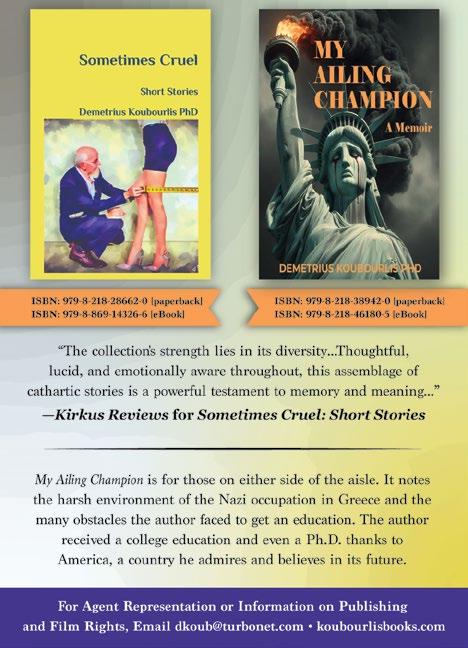



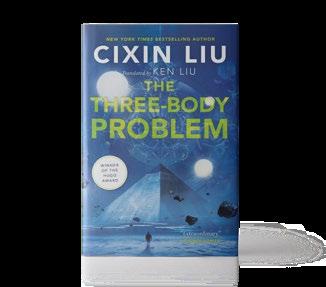
Shōgun and 3 Body Problem are among the series in the running for the TV prizes.
Literary adaptations are amply represented among the finalists for this year’s Emmy Awards, to be presented later this month.
Shōgun, the series based on James Clavell’s 1975 bestselling novel, scored 25 nominations, including nods for drama series, lead actor in
a drama series (Hiroyuki Sanada), lead actress in a drama series (Anna Sawai), and supporting actor in a drama series (Tadanobu Asano and Takehiro Hira).
Two other adaptations were nominated for drama series: 3 Body Problem, based on Cixin Liu’s Remembrance of Earth’s Past series of science fiction novels, and Slow Horses, based on Mick Herron’s Slough House series of spy novels. Slow Horses actors Gary Oldman and Jack Lowden also secured nominations.
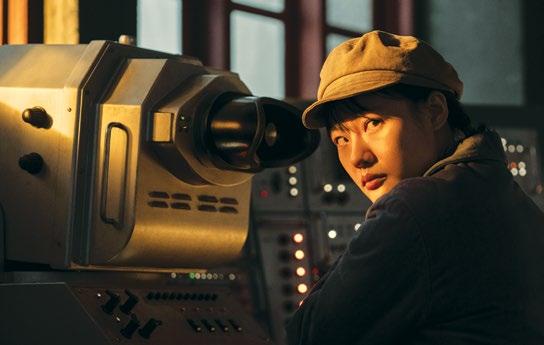
Palm Royale, an adaptation of Juliet McDaniel’s Mr. and Mrs. American Pie, was nominated for comedy series, with two actors gaining nods: Kristen Wiig for lead actress in a comedy series and Carol Burnett for supporting actress in a comedy series.
Two adaptations were nominated in the limited or anthology series category: Ripley, based on Patricia Highsmith’s series of novels featuring the character Tom Ripley, and Lessons in Chemistry, an adaptation of Bonnie Garmus’ bestselling 2022 novel. Ripley garnered

acting nods for Andrew Scott and Dakota Fanning, while Lessons in Chemistry drew acting nominations for Brie Larson, Aja Naomi King, and Lewis Pullman.
Other limited series to gain nominations were Feud: Capote vs. the Swans, based on Laurence Leamer’s Capote’s Women (Tom Hollander for lead actor, Naomi Watts for lead actress, Diane Lane for supporting actress, Treat Williams for supporting actor); Under the Bridge, based on Rebecca Godfrey’s book (Lily Gladstone for supporting actress); Fellow Travelers, based on Thomas Mallon’s novel (lead actor for Matt Bomer, supporting actor for Jonathan Bailey); and The Sympathizer, based on Viet Thanh Nguyen’s Pulitzer Prize–winning novel (Robert Downey Jr. for supporting actor).
The winners of this year’s awards will be revealed at a televised ceremony on Sept. 15. —M.S.

For a review of FX’s Shōgun series, visit Kirkus online.
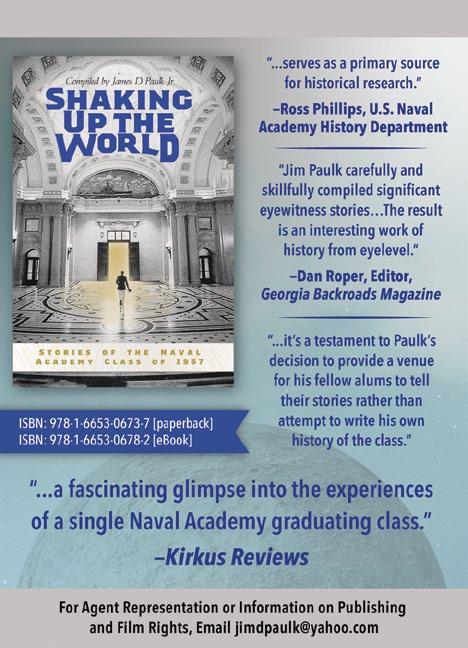





EDITORS’ PICKS:
The Worst Perfect Moment by Shivaun Plozza (Holiday House)
Samira’s Worst Best Summer by Nina Hamza (Quill Tree Books/HarperCollins)
The History of Sound by Ben Shattuck (Viking)
THANKS TO OUR SPONSORS:
Not That Kind of Call Girl by Nova García
The Optical Lasso by Marc Corwin
Rock Creek by Kevin Flynn
Fully Booked is produced by Cabel Adkins Audio and Megan Labrise.

A woman, a house, and the history that haunts them: J. Courtney Sullivan’s The Cliffs
On this episode of Fully Booked , New York Times –bestselling author J. Courtney Sullivan discusses The Cliffs (Knopf, July 2). Her latest novel—this month’s pick—chronicles the rich history of a coastal Maine property that offers refuge and vexation to generations of women. As Kirkus writes in a starred review, “Sullivan...writes with her usual compassion, insight, and sensitivity, creating multidimensional characters about whom, even as they make regrettable mistakes, the reader unwaveringly cares.”


Sullivan is the author of Commencement, Maine, The Engagements, and Saints for All Occasions, as well as the forewords to new editions of the classic novels Anne of Green Gables and Little Women . She lives in Massachusetts with her husband and two children. Here’s a bit more from our starred review of The Cliffs :
“Jane Flanagan, who lives in Awadapquit, Maine, with her alcoholic mother and chip-off-the-old-block sister, is in high school when she first sees the house, perched on a cliff overlooking the water. Deserted, rotting, and creepy, but boasting colorful turrets and an abiding sense of mystery, the abandoned Victorian home fascinates Jane. It becomes her refuge, where she can escape her life’s hassles and feel at peace. Eventually, Jane goes to college (Wesleyan) and gets a graduate degree in American history (Yale). She lands her ‘dream job’ as an archivist at Harvard and her dream husband, a handsome, kind economics professor who runs marathons and bakes. Then, in one boozy blowout of a night not long after her mother’s death, Jane explodes her whole dreamy life. When she returns to Awadapquit to ready her
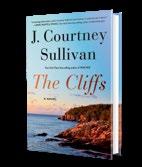
The Cliffs Sullivan, J. Courtney Knopf | 384 pp. | $29.00 July 2, 2024 | 9780593319154
mother’s cluttered home for sale and contend with her equally messy legacy, Jane connects with Genevieve Richards, a wealthy woman who’s bought the old house and, while renovating, heedlessly bulldozed its history.…Hired by Genevieve to unearth the house’s secrets and its often painful past, Jane must contend with her own.”
Sullivan and I discuss what it’s like to have your novel chosen by a big book club (#ReadWithJenna, Reese’s Book Club). We talk about what’s possible for whom at what time in history, vis-a-vis the characters in The Cliffs; why contemporary homeowners with large renovation budgets are obsessed with white walls and open-concept kitchens; and how this novel got its title. Then editors Laura Simeon, Mahnaz Dar, and Laurie Muchnick share their top picks in books for the week.
Editor-at-large Megan Labrise hosts the Fully Booked podcast.
Berry, Jedediah | Tor (384 pp.)
$28.99 | Sept. 24, 2024 | 9781250907981

Language is rediscovered— and strictly controlled—in Berry’s post-apocalyptic fantasy. They call it the Silence—the massive event that wiped out all language from the world. In the aftermath, the dead walked aimlessly as ghosts and monsters came to life from nightmares. Eventually, humans rediscovered the means to “divine” new words and slowly rebuilt civilization. In this strange landscape, where words are precious and the people who produce new ones also create law and order, anything unnamed is extremely dangerous. The civilized, named people put their trust in the committees of maps, ghosts, dreams, and names, to protect them from the horrors of the wild unknown world. That’s why it’s so hard for the courier, who works for the names committee delivering new names to the world, to feel at home anywhere: She doesn’t have a name. Even her sister has abandoned her, refusing to respond to her letters. For some reason, the courier’s father never gave her a name, even though it set her up to be feared, especially when the savage unnamed people started mounting violent attacks against the named. When her boss with the names committee is killed, the courier flees, setting out to find the truth behind the attacks and about her past. The importance of language and communication is a naturally compelling theme for a book, and Berry aptly describes the intangible magic of the courier delivering a new word where none existed before. Sometimes the dreamy tone makes worldbuilding a little muddy. But though she doesn’t have a name, the courier is a lively, effective protagonist who finds more lovable misfits along her journey. An unusual fantasy about reshaping the world with words.
Gong, Chloe | Saga/Simon & Schuster (384 pp.) | $28.99
Sept. 10, 2024 | 9781668000267

At the end of Immortal Longings (2023), the first book in Gong’s trilogy about the twin cities of San-Er, Princess Calla Tuoleimi got what she wanted—the head of her uncle, King Kasa. But her problems are just beginning.
Calla saw killing the oppressive monarch as her only means of getting justice for the people of San-Er, and it was her sole reason for taking part in the fight to the death that is the king’s games—even though everyone thought she was dead. The last person standing in her way was someone she’d grown to care about, someone who’d discovered her secret and still loved her: Anton Makusa. But while Calla was willing to sacrifice Anton and all they were to each other, even accepting her own death in order to free the cities from the tyrant’s reign, Anton had plans of his own. To survive Calla’s fatal blow, Anton took advantage of an ability some people have in Gong’s world: He jumped bodies, guiding his qi into the most powerful person in San-Er—Prince August Avia, the heir and soon-to-becrowned monarch. Now in control of August’s body, Anton enjoys the power of being king if only for a moment, and then everything spirals out of control. Calla and Anton dance around each other interminably while mysterious deaths occur in the provinces, a once fringe cult grows more powerful, and the most unlikely adversary emerges, waking up from an incurable coma. This book introduces new characters and bloodlines, new feuds and rivalries. It’s all pointing fingers and swaying allegiances until everyone is pushed to their wits’ ends. The rollout of qi rule bending through the larger ensemble continues at an
unsustainable rate, and the book loses depth and connection with its main characters in pursuit of plot twists and big reveals.
This sequel stumbles where the first book soared, but a compelling setup for a third points to hope of recovery.
Harkness, Deborah | Ballantine (464 pp.)
$32.00 | July 16, 2024 | 9780593724774

Two professors who happen to be a witch and a vampire face new challenges in the fifth volume of what was originally a romantasy trilogy. Despite the conclusive-seeming confrontation that the witch Diana Bishop and the vampire Matthew de Clermont had with the Congregation—the governing body of witches, vampires, and demons—over their taboo relationship at the end of Book 3, The Book of Life (2014), it seems the group will not let this couple and their gifted twin children alone. An ominous visit from ravens, an invitation from a previously unknown great-aunt, and a summons from the Congregation to examine 6-year-old Pip and Becca for the often-feared potential for higher magic lead Diana to travel to Ravenswood, home of her late father’s family. As Diana connects with these new relatives, uncovers fresh secrets about her heritage, and begins to travel the first steps of the Dark Path to higher magic, enemies both new and old attempt to block her from proceeding. Like Diana, Harkness treads a tricky path that many others have attempted before her: in this case, trying to extend the magic of her epic trilogy into future volumes without it seeming contrived. The author is not entirely successful in this endeavor, alas. Book 4, Time’s Convert (2018), was a reasonably diverting but entirely unnecessary coda that mainly focused on secondary characters from the
THE LAST DRAGON OF THE EAST
previous works. This novel returns to the original two protagonists, filling in some gaps from the original trilogy while opening the storyline to multiple future installments. Diana and Matthew have an entertainingly angsty relationship and it’s always fun to spend time with them. However, the book’s plot retravels a great deal of territory. Harkness has demonstrated enough creativity in her previous books that she could take her tale in a fresh direction; whether she will remains to be seen. Not without its charms and rewards; read on, if you must.
Kwan, Katrina | Saga/Simon & Schuster (320 pp.) | $17.99 paper Oct. 8, 2024 | 9781668051238

A bid to save his ailing mother turns into a literal date with destiny for a young teahouse owner.
For as long as he can remember, 25-year-old Sai has been able to see the red threads of fate, ties that link people to their Fated Ones or soulmates. Sai’s own limp gray thread is unlike any others he’s seen, but he has no time for romance, anyway. Not with his mother in such a frail state. After an illegal substance—powdered dragon scales— restores her health for a time, Sai makes it his mission to find more. Unfortunately for the young man and his mother, the emperor himself catches wind of the miracle cure and demands that Sai find the dragon who shed those scales and bring it to him. Accompanied
by a huntress named Feng, who procured the original scales for his family doctor, Sai crosses the border into enemy territory in search of his mother’s salvation. Color him surprised when he discovers his thread of fate is tied to that very dragon—who is not at all pleased to see him. Kwan crafts a fascinating world in which the figures of Chinese myth and legend are real, breathing people. There is plenty to like here, along with a few disappointing details. The decision to make same-sex partnerships a normal part of Sai’s world is admirable, and Sai himself does not seem to care what gender his Fated One turns out to be. But the flagging middle portion, in which the stakes seem to vanish entirely, turns this cozy, low-fantasy story into a slog. Gentle Sai’s gradual transformation into a fierce fighter may appeal to fantasy readers, but the novel’s focus on his journey toward coming into his own makes it feel more suited to a teenage audience. Feng, who may be the most compelling character of the lot, disappears early and returns late, nearly forgotten as Sai continues his adventure with his dragon love.
An unevenly paced romantic fantasy adventure that feels too young for its intended audience.
Stewart, Andrea | Orbit (528 pp.)
$30.00 | Sept. 3, 2024 | 9780316564892

and magic— and feuding gods do battle to restore the world.
After humans selfishly consume much of the magic on the planet, the Shattering changes everyone who lives in its various realms.
Kluehnn—who called himself the “one true god”—makes a pact with his followers after hunting down and killing most of the other deities. He will systematically restore each realm back to its pristine environmental state, but half the population will be “altered to suit the new landscape.” The other half will be destroyed, their matter used to reshape the terrain. As the country of Kashan is being forcibly restored by a relentless black wall sweeping over the land, chaos ensues as people attempt to escape.
The first installment of Stewart’s Hollow Covenant trilogy is set in a fantasy world where humans have destroyed the planet’s sustainability—
Fifteen-year-old Hakara desperately tries to save herself and her little sister, Rasha, but they are separated in the turmoil. Hakara awakes safely in the neighboring realm, but her sister’s fate is unknown. An environmental cautionary tale blended with an impressively intricate fantasy backstory, the premise here is strong, as are the multiple intertwining storylines exploring a diversity of perspectives. The problem is with the major plot thread revo lving around the two sisters’ search for one another—particularly Hakara’s obsession with crossing the barrier to the transformed Kashan to find Rasha, who may be dead or altered. The intensity is initially high, but it loses power quickly as secondary characters and storylines take over. Compared to fully realized and impressively complex characters like Thassir, an emotionally scarred god in disguise; Mullayne, an explorer in search of Unterra, the mythical subterranean home of the gods before the Shattering; and the courageous Sheuan Sim, who must use her wits and savvy to survive an impossible situation that puts her entire clan at risk, the sisters are unremarkable. Intriguing worldbuilding can’t compensate for two-dimensional lead characters and a lackluster primary storyline.
Allen, Samantha | Zando (304 pp.) | $18.00 paper | Sept. 10, 2024 | 9781638931539
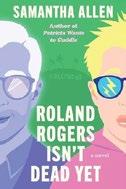
A downand-out writer lands a gig ghostwriting a celebrity’s memoir— only to discover he’s writing for an actual ghost
Adam Gallagher’s career is, for lack of a better word, dying. A decade after publishing Salt Lake City Sodomite, the bestselling recount of his Mormon upbringing and public excommunication, Adam hasn’t written anything nearly as successful. Paul, his agent, has barely spoken to him in ages when he invites him out to a swanky steak dinner to tell him that Roland Rogers has personally requested him to write his coming-out story. Roland is a household name, a modern-day Cary Grant who stars as Crag Dynamite in a popular action movie franchise. After decades in the limelight as a charming bachelor, Roland is ready to speak his truth: He’s gay. Who better to write his story than his favorite author, who publicly came out all those years ago? After getting all the details from Paul, Adam sets out to spend a month at Roland’s Malibu mansion and transcribe the superstar’s story, as requested, by hand. But when Adam arrives at the celebrity’s doorstep, there’s just one tiny little hiccup: Roland is dead. After having suffered an accident on a solo backcountry skiing trip, Roland’s body remains buried under mountains of snow, but his spirit haunts his California mansion through various electrical appliances. With Adam’s help, he plans to use his book to come out before news spreads of his death. After the initial shock of meeting a ghost, Adam is prepared to fulfill Roland’s dying wish—his own career depends on it. As weeks pass, Adam and Roland develop a connection neither has felt, alive or dead, but Adam can’t help but wonder…Why now? Allen’s supernatural tale is eccentric, funny, and
pleasantly peculiar. Adam and Roland are unconventional protagonists: two middle-aged men, one wildly famous and the other comically downtrodden, both searching for a sense of self. Allen offers readers an unlikely romance, sprinkled with lust, regret, humor, and even paranormal activity, and somehow it absolutely works.
A wacky yet touching tale about love, truth, and acceptance.
Ballard, Falon | Putnam (256 pp.) | $17.99 paper | Sept. 24, 2024 | 9780593851845
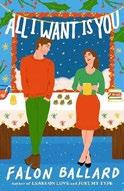
Romance-author exes wind up sharing a bed (and a book idea) when they get snowed in at a publishing event.
Jessica Carrington and Nick Matthews once had the kind of relationship that happily-ever-afters are made of. They were head over heels in love and both pursuing their dreams of writing romance novels. But then Nick’s career took off faster than Jess’ and he broke up with her, breaking her heart. Nick made a name for himself writing love stories without happy endings (a cardinal sin in the romance world), earning himself movie adaptations and bestsellers. Jess, meanwhile, grew a steady but much less financially rewarding career. Seeing her ex succeed for writing books that aren’t even technically romance is too much to take, so she’s avoided him for years… that is, until they end up at a charming inn for their publisher’s annual holiday party. Jess is enraged that she’s asked to present an award to Nick, although she goes along with it to look professional. She hopes to get through it with as little interaction as possible, but perhaps she should see what’s coming next: They get snowed in, and they’re forced to share a hotel room—and there’s only one bed. Jess can’t deny that she and Nick still have chemistry and all the snappy banter
of an enemies-to-lovers rom-com. When their publisher suggests they work on a book together, her initial hesitation turns into excitement as the words flow easily. But just because they work well together doesn’t mean they’d make a good couple, and Jess still doesn’t know why Nick broke it off all those years ago. Ballard has written another fun and impossible-to-put-down romance with engaging leads. Readers will enjoy the peek behind the curtain at the world of publishing, and the sexual tension between Nick and Jess will keep them turning the pages. The cozy setting and Christmas details make for strong holiday vibes, no matter the season. A short, sweet, and extremely festive romance that will put readers in the holiday spirit.
Jordan, Sophie | Avon/HarperCollins (336 pp.)
$30.00 | Sept. 24, 2024 | 9780063399990
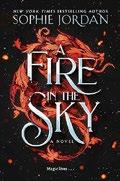
A whipping girl’s life is transformed beyond her wildest dreams. Tamsyn is a beloved member of the royal family of Penterra—sort of. Abandoned on the castle doorstep when she was a baby, she’s been raised alongside the young princesses as their whipping girl, taking the physical punishment whenever one of the untouchable royal sisters does something wrong. Penterran society no longer fears dragons a century after their eradication, but fear of raiders has kept Tamsyn and her sisters close to home. She’s starting to look forward to independence in the next chapter of her life, but then her family asks one more sacrifice of her: She must marry Lord Beast, the so-called barbarian whose people keep her city safe, who has requested a royal marriage as recompense. The Beast of the Borderlands, better known as Fell to friends and companions, is desperate to improve life for the impoverished northerners he rules, so he hopes that a royal marriage will help. That’s why he’s horrified to
learn, after publicly consummating their hasty marriage, that he’s been tricked into wedding the less-than-royal Tamsyn. Despite his anger and her fear, they find that they have an intense, unusual connection, and they set off north together, going home to Fell’s people. When a surprise attack leads Tamsyn to learn she has the ability to turn into a dragon, their world expands far beyond what they initially expected for their lives together. This book, the first in a new series, serves as a prequel to Jordan’s YA Firelight series, which centered romantasy before the current vogue for it. It will be enjoyed by many fans of the original tales, especially if they’re now adults; though it has several explicit scenes that are decidedly not YA, it ticks all the romantasy boxes. Fans of Jordan’s historicals, on the other hand, may be disappointed by a lack of the depth they’ve come to expect from her work—though that may be worth overlooking thanks to the compelling plot. A cliffhanger ending will leave readers anxious for the next installment. A promising adults-only continuation of a YA romantasy series.
Lim, Dominic | Forever (368 pp.) | $17.99 paper | Sept. 17, 2024 | 9781538725405

A Filipino American man dusts off his internet-famous drag queen persona to help save his ex’s karaoke bar. Rex Araneta has a lot of desires: his former college boyfriend, fashion and drag, and a place to go for a damn good karaoke performance. By fate, those interests all converge when he realizes that Aaron Berry, the guy who got away, is the new manager at the Pink Unicorn, a failing gay bar in Oakland. To help breathe some energy into the place, Rex decides to revive his drag persona, Regina Moon Dee, a former viral sensation, to host a karaoke night. As the Pink Unicorn’s drag-hosted
A man dusts off his drag queen persona to help save his ex’s karaoke bar.
KARAOKE QUEEN
karaoke nights gain more and more attention, Rex worries about the potential fallout should he be exposed as Regina. Not only is he still healing from a long-held trauma and his father’s stark disapproval, but Aaron has been vocal about his own dislike of the drag scene. Thankfully, the romance is a bit of a bait and switch, as Rex begins to realize that his found family might contain a new love and that he doesn’t need to waste time pining for a man who only accepts half of him. More and more people get roped into covering up Rex’s secret identity, from his sister to his mom to the bar’s energetic and very cute DJ, Paolo; it’s only a matter of time before things come to a head. At its core, this is more a love letter to the drag community and to the theater and artistry of drag performance than a romance. The relationship blossoms slowly, is more sweet than sexy, and doesn’t quite feel like the focal point. Funny and earnest, just like a perfect drag performance.
Lorret, Vivienne | Avon/Harper Collins (400 pp.) | $9.99 paper Sept. 24, 2024 | 9780063352476
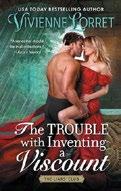
A con artist meets his match with a gambler in disguise. Honoria Hartley never wants to marry or have children, and she’s found a clever way to avoid it. Her
grandmother betrothed her long ago to Viscount Vandemere, and since no one has ever met the man, she’s spent years
“clinging to the betrothal contract like a shield,” sending herself letters in which “Vandemere” always has an excuse for why he can’t yet marry her. As she’s exempted herself from the marriage mart, she’s freed up considerable time to do things like disguise herself as Signor Cesario, giving herself the freedom to live as a man and especially to gamble. She’s wearing her Cesario drag the first time she meets ruthless gambler Oscar Flint, and after she wins a large pot he was counting on, he becomes the first person to realize she’s wearing a disguise; only a well-timed kiss allows her to slip away. One year later, he gets his revenge. Honoria is comfortably at home in her normal attire when Oscar reappears, and this time he’s the one in disguise—as her fiance. Flint moves into the Vandemere home and openly courts Honoria, and as their attraction is obvious, both are secretly happy to goad the other. But there’s a good reason Flint escaped to the country to act as Vandemere, and it may put all of them in danger. In the second book in her Liar’s Club series, Lorret turns her attention to the middle Hartley sister. As usual, her writing sparkles, and it’s a delight that Honoria and Oscar can admit their attraction early on, providing for many witty exchanges (and a few spicy ones as well). The plot, however, droops a bit under unnecessary complexity—it’s tempting to think of that as a nod to Shakespeare, given the Hartley family’s theatrical leanings, but it doesn’t quite hold together. Still, the emotional depths of both Honoria and Oscar, the quasi-enemies-to-lovers chemistry between the two, and the charms of the Hartley family provide more than enough reasons for readers to roll the dice on this one.
An enjoyable romance from a Regency fan favorite.

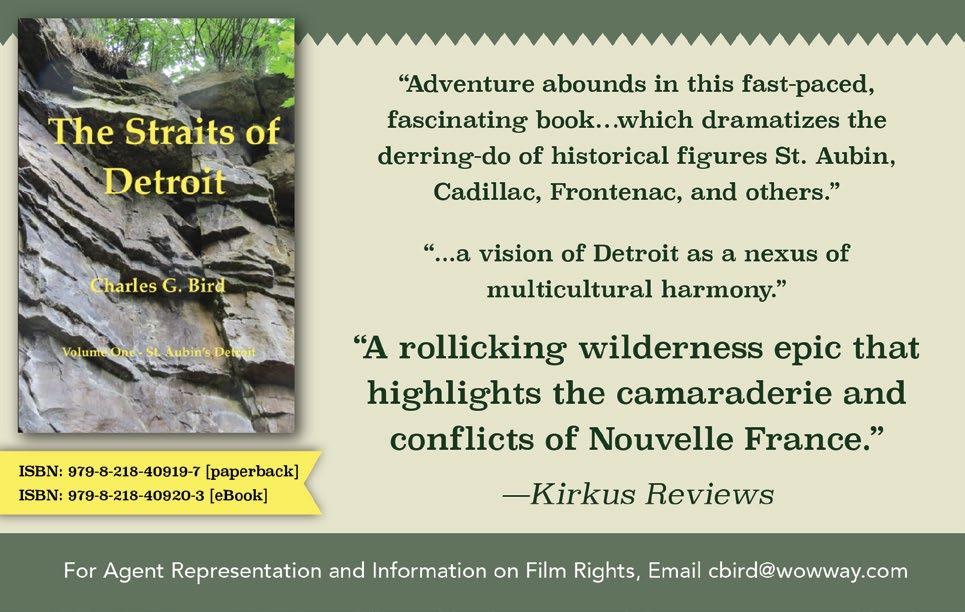
Moira Walley-Beckett will run the adaptation of Rebecca Yarros’ romantasy novel.
Amazon’s series adaptation of Rebecca Yarros’ Fourth Wing has found its showrunner, Variety reports.
Moira Walley-Beckett, creator of the show Anne With an E and a former writer for Pan Am and Breaking Bad, will run the series for Amazon MGM Studios.
Yarros’ romantasy novel, published in 2023 by Red Tower, follows Violet Sorrengail, a 20-year-old woman whose military general mother forces her to attend a school for dragon riders. The book, the first in Yarros’ Empyrean series, became a No. 1 New York Times bestseller after catching the attention of readers on TikTok. A critic for Kirkus wrote of the novel, “Read this for the action-packed plot, not character development or worldbuilding.”
Yarros followed up Fourth Wing last year with Iron Flame ; the next book in the
series, Onyx Storm, is scheduled for publication in January.
The Amazon series adaptation is being produced by Outlier Society, actor Michael B. Jordan’s production company.
Walley-Beckett, Jordan, and Yarros are among the series’ executive producers.
Walley-Beckett announced her involvement in the series on Instagram, writing, “I am SO EXCITED to be adapting brilliant @rebeccayarros

FOURTH WING into series! Thank you to Amazon MGM Studios and Michael B. Jordan’s Outlier Society for trusting me to bring this incredible book series to life!”—M.S.


MUCH CRIME, AS Raymond Chandler delighted in telling us, hinges on two human failings. The first is that most of us are greedy. The second is that most of us are chumps, easily distracted by shiny things and the promises of con artists.
Consider Alex Murdaugh. The South Carolina lawyer, whose inherited wealth rested on a legacy of corruption and violence, wasn’t content with his millions. He wanted more, as Valerie Bauerlein writes in her superb real-life whodunit The Devil at His Elbow (Ballantine Books, Aug. 20). And not just money: Murdaugh could swallow a case of whiskey and a trunkload of oxycodone, it seems, and still demand another round. To fund his habit, he conned millions from his unknowing clients while the bankers and other solid citizens of Hampton County looked the other way. To keep that habit a secret, among other motives, he murdered his wife and son. The law finally caught up with
Murdaugh, but not without plenty of cat-andmouse that Bauerlein recounts with a fine sense of both the drama and the mundane details of police work. The moral? Given local politics, if Murdaugh hadn’t been a touch too greedy—to say nothing of murderous—he might well be free today.
Murdaugh looks to be a rank amateur, though, next to a “morbidly obese, fifty-seven-year-old felon with two bad knees and kidney cancer,” as Craig Whitlock describes the subject of his book Fat Leonard (Simon & Schuster, May 14). A Malaysian street hustler, Leonard Francis believed he was smart enough to get away with anything. He did, for a time: he made millions by swindling the U.S. Navy, keeping the brass knee-deep in enough hookers, fine drink, and gewgaws that they looked the other way, too.
Eventually someone in accounting figured out what was going on, more than 90 admirals came
under investigation, still more junior officers fell on their swords, and a great crime spree came to an end—not bad work for a high school dropout with an unfailing sense of exactly where the officers’ moral compasses could be made to go off course. Did Fat Leonard get that way from fast food? We don’t know. Neither do we know why, given billions of burgers sold, McDonald’s needs to advertise at all. Yet for many years McDonald’s offered a kind of Willie Wonka ticket with million-dollar prizes—and for many years, every winner was connected, mysteriously, to every other winner. It took another accountant, this one with an FBI badge, to figure out how the scam worked, write James Lee
Hernandez and Brian Lazarte in McMillion$ (Grand Central, Aug. 2). As they recount, a bottom-tier ex-cop wormed his way into the confidences of the advertising firm that administered the contest, then joined forces with a dimwitted mobster to con a bunch of guppies into believing that his Ponzi scheme would earn them fortunes as they scammed the burger giant—which, though embarrassed, pitched in to help the FBI bring the grifters down. As so often happens, the biggest crook in the yarn earned less time than some of his minions, some of them greedy, some of them mere chumps—and that, dear reader, brings us full circle.
Gregory McNamee is a contributing writer.
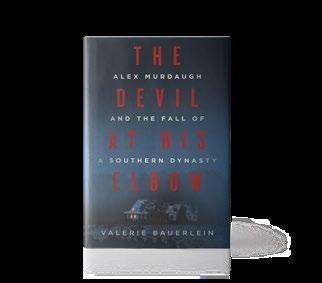

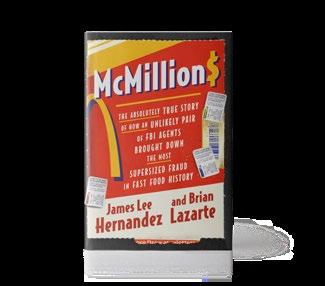
Bearing witness to oppression.
Award-winning journalist and MacArthur Fellow Coates probes the narratives that shape our perception of the world through his reports on three journeys: to Dakar, Senegal, the last stop for Black Africans “before the genocide and rebirth of the Middle Passage”; to Chapin, South Carolina, where controversy erupted over a writing teacher’s use of Between the World and Me in class; and to Israel and Palestine, where he spent 10 days in a “Holy Land of barbed wire, settlers, and outrageous guns.” By addressing the essays to students in his writing workshop at Howard University in 2022, Coates makes a literary choice similar to the letter to his
son that informed Between the World and Me ; as in that book, the choice creates a sense of intimacy between writer and reader. Interweaving autobiography and reportage, Coates examines race, his identity as a Black American, and his role as a public intellectual. In Dakar, he is haunted by ghosts of his ancestors and “the shade of Niggerology,” a pseudoscientific narrative put forth to justify enslavement by portraying Blacks as inferior. In South Carolina, the 22-acre State House grounds, dotted with Confederate statues, continue to impart a narrative of white supremacy. His trip to the Middle East inspires the longest and most impassioned essay: “I don’t think I ever, in my life, felt the glare of racism
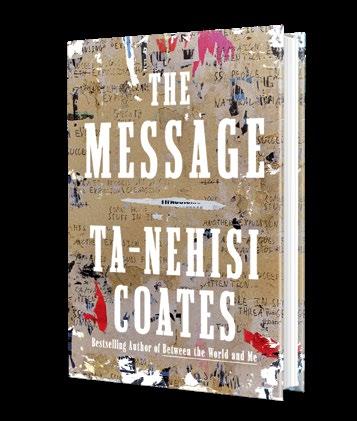
Coates, Ta-Nehisi | One World/Random House 176 pp. | $28.00 | Oct. 1, 2024 | 9780593230381
burn stranger and more intense than in Israel,” he writes. In his complex analysis, he sees the trauma of the Holocaust playing a role in Israel’s tactics in the Middle East: “The wars against the Palestinians and their Arab allies were a kind of theater in which ‘weak Jews’ who went ‘like lambs to slaughter’ were
supplanted by Israelis who would ‘fight back.’” Roiled by what he witnessed, Coates feels speechless, unable to adequately convey Palestinians’ agony; their reality “demands new messengers, tasked as we all are, with nothing less than saving the world.”
A revelatory meditation on shattering journeys.
Amrith, Sunil | Norton (432 pp.) | $35.00 Sept. 24, 2024 | 9781324007180
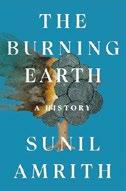
Broadly ranging history of how we arrived at “this point of planetary crisis.” The human destruction of nature began a long time before the Industrial Revolution hastened the process along, writes Yale historian Amrith. Taking an appropriately long view, he considers such events as the British enclosure of the commons and forests, “landscapes on the margin of settled cultivation,” leading to wide-scale deforestation; the Mongol invasion of Central Asia and western Eurasia, with its horse-borne warriors scorning agriculture; conversely, the Chinese importation of rice from Indochina, where farmers had developed more than 100,000 varieties of the grass; and so forth. All of these events speak to want and greed. So do Amrith’s more recent cases, such as the indenture of Black South Africans to work the mines of the Transvaal, leading to a global trade in gold, the development of gold standard economies, and London’s emergence as a leading financial center; just so, the discovery of the Azerbaijani oil fields, which preceded the first American well by a decade, transformed the czarist economy and helped usher in centuries of fossil fuel dependence, exemplified by not just car-crazy America but also petrochemically addicted East Germany, with its mania for plastic goods that “embodied a future where anything was possible.” Today, Amrith writes, the contest for resources increasingly includes water. Gaining a handle on the planetary crisis is complicated by
the fact that the wealthy nations, having got theirs, have precious little moral high ground to occupy in making the case that the poorer nations need to stop their clamoring demand for the stuff of wealth: cars, consumer goods, and perhaps above all meat (ecologically disastrous and fostered by government handouts), for “now it was others’ turn to eat.”
A far-reaching survey of the central role played by human needs and desires in the destruction of Earth.
Andrews, Robin George | Norton (336 pp.)
$29.99 | Oct. 1, 2024 | 9781324050193

Big asteroids rarely strike our planet, but smaller ones not so rarely, and scientists are worrying.
Science journalist Andrews, author of Super Volcanoes, writes that an asteroid blew up over Chelyabinsk, a Russian city of 1.2 million, in 2013. Disintegrating before reaching the ground, it produced a vivid flash and deafening explosion that broke windows and damaged thousands of buildings. More than a hundred citizens were hospitalized. The explosion, equal to that of 500,000 tons of TNT, was caused by an asteroid 60 feet wide. History buffs remember the 1908 Tunguska meteor, which destroyed 800 square miles of remote Siberia, flattening 80 million trees with a blast equivalent to that of 12 million tons of TNT. It was 160 feet across. Surprise asteroids thrill
movie audiences, but astronomers have detected most of the big ones. On the other hand, readers may be startled to learn that of the several hundred thousand Tunguska-size asteroids that astronomers call “near-Earth objects (NEOs)” (they’re also called “city killers”) thought to exist, only 7 percent have been found. Having set the scene, Andrews describes a NASA mission, DART, to send a spacecraft crashing into a distant NEO to shift its orbit. Launched in November 2021, it successfully completed its mission the following September, proving that this could be done. Andrews describes other missions to asteroids and comets, as well as ongoing NASA efforts at planetary defense, although readers may be dismayed to learn these are not a priority. A high-tech satellite, NEO Surveyor, designed to detect the mass of undetected asteroids, was proposed in the early 2000s, approved after many delays, and scheduled to launch by 2028, but that date became uncertain when its budget was cut. A member of the “science is boring” school, Andrews writes breezy prose peppered with flippant asides, jokes, and apologies for technical terms, but he has done his homework. A skillful review of NASA efforts to save the Earth.
Anton, Betina | Diversion Books (320 pp.) $28.99 | Oct. 1, 2024 | 9781635768824

A Brazilian journalist investigates the network that sheltered Auschwitz’s “Angel of Death” until his death in 1979.
Anton opens with Mengele’s last day in 1979, a trip to the Brazilian seaside with the Austrian family that harbored his secret. It ended in his drowning and subsequent burial under the name Wolfgang Gerhard, one of
the multiple false names he used after leaving postwar Germany for sanctuary in South America. Before this, he was a doctor at Auschwitz who oversaw the “selection” of prisoners to be sent to the gas chambers and who performed bizarre experiments, many on twins. Writes Anton: “For Mengele, Auschwitz was a great deposit of human material to be used in his private research.” The author was haunted by his total amorality, “even more so knowing that, when hiding from justice, he received protection from my childhood teacher,” who abruptly vanished from Anton’s primary school in 1985 when her complicity was uncovered. Years later, Anton began to investigate how Mengele could have stayed hidden for so long. Her survey of his Auschwitz career is valuable for keeping fresh the collective Holocaust memory but breaks no new ground. The contrast of these activities with his postwar life recalls Hannah Arendt; it’s hard to imagine anything much more banal (albeit creepy) than the image of a cranky old man who watches the Brazilian soap opera The Slave Isaura “for the pleasure of seeing enslaved people mistreated.” Some of the abettors who took considerable risks to hide him were motivated by ideology, others by money; the Mengele family owned a successful business in Bavaria and supported him for decades. Anton’s disgust at the relative comfort Mengele enjoyed while his surviving victims suffered is plain. To construct her picture of his years in hiding, she draws on personal interviews, police records, and Mengele’s copious letters. The last reveal no sense of unease or remorse, perhaps the most unsettling element of all.
A provocative contribution to the literature of the Holocaust.

Arillotta, Anthony with Joe Bradley Hamilcar Publications (220 pp.) | $34.99 Sept. 17, 2024 | 9781949590753

For an account of
A former Mafia boss tells his story. The reflections of Arillotta, former boss of a New England faction of the New York City Genovese crime family, make an entertaining contribution to the venerable genre of Mafia memoirs. Arillotta tells his story to former Massachusetts police officer turned novelist and screenwriter Bradley. Following the usual pattern, he recounts his youthful crime apprenticeship in Springfield, Massachusetts, followed by ritual induction into the Mafia family. Readers familiar with complex portrayals of organized crime (à la The Sopranos) should adjust their expectations here. Considerably less affluent and now retired after a tedious prison term, Arillotta traces a career in which the nuts-and-bolts details of protection rackets, drug dealing, robbery, gambling, and extortion take second place to cheating, murder, deceit, and brutal fights between fellow Mafiosi, many of whom turn out to be government informants. Readers will discover that job security for career mobsters has deteriorated since the “golden age” of their lore. Arillotta himself suggests that the problem lies in drug dealing, once forbidden by traditional dons but now a source of immense profits. The downside is that prison sentences for carrying out historic Cosa Nostra business are tolerable, but those for trafficking narcotics can be very severe. “Drug dealers could not be trusted to keep their mouths shut when looking at doing hard time.” It was murder, not drug dealing, that finally tripped Arillotta up, but informants made a critical contribution. Faced with life in prison, he took the same road and turned government informant. Colorful if unedifying.
Code Name Puritan: Norman Holmes Pearson at the Nexus of Poetry, Espionage, and American Power
Barnhisel, Greg | Univ. of Chicago (392 pp.) $32.50 | Oct. 8, 2024 | 9780226647203
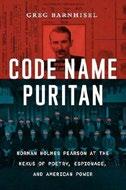
Engaging, erudite biography of a little-known Yale literature professor, champion of women poets— and counterespionage officer during World War II.
The legacy of Norman Holmes Pearson, “a privileged, well-connected, Mayflower -descended white man from New England,” has been largely invisible, despite his contributions to both scholarship and espionage, writes fellow academic Barnhisel. Pearson quietly made an impact not only on Yale during his long tenure there, but on the Office of Strategic Services (OSS) in London, where he worked during the war. Pearson could not talk about his work at the time, but multiple Yale memoirs recall him as “the genial, eloquent, bent-over little professor whom everyone knew was a spy.” He was born in 1909 in Gardner, Massachusetts, where his father (and later his older brother) ran a successful department store. At age eight, Norman fell from a barn roof and broke bones in his back, pelvis, and femur, injuries that would bedevil him his whole life, requiring surgeries that often interrupted his studies. Brainy and literate, he attended Philips Academy Andover and then Yale, arriving in the fall of 1928 to spend virtually his entire career there until his death in 1975. He was a passionate advocate of American literature and especially Nathaniel Hawthorne (whose letters he tried to publish), who was just emerging as a recognized subject for study; he included in his lectures and writings authors such as Willa Cather, Wallace Stevens, Ezra Pound, William Carlos Stevens, and H.D. He helped edit many important anthologies still used today. Barnhisel, who is evidently fond of his subject, traces Pearson’s
wartime activities as a brilliant counterespionage expert in X-2 under England’s M16 and his later friendships with poets H.D. and her partner Bryher, Muriel Rukeyser, Marianne Moore, W.H. Auden, and others. Illuminating study of an important literary light long forgotten.
Kirkus Star
Brand, Dionne | Farrar, Straus and Giroux (224 pp.) | $27.00 Oct. 1, 2024 | 9780374614843

Black lives in literature.
Award-winning novelist Brand, Toronto’s former poet laureate, melds autobiography and literary criticism to offer a shrewd, intimate reading of the 17th-, 18th-, and 19th-century novels that shaped her sense of self. She terms this fictional trove a “wreck,” from which she aims to salvage “the literary substance of which I am made.” As a Black girl attending an Anglican school in Trinidad, she was schooled in “the racial work of literature, whose most abiding feature will be our absence, on the one hand, and our eternal subjugate presence, on the other hand.” From novels such as Thackeray’s Vanity Fair, Defoe’s Adventures of Robinson Crusoe, Austen’s Mansfield Park, Aphra Behn’s Oroonoko, and Charlotte Brontë’s Jane Eyre, which she reread later at the University of Toronto, she came to understand the power of narrative structure and style—sentences, character, dialogue—to teach her “how to feel and what to feel” about her identity as a Black woman in a “world of coloniality.” “I am not interested in the morality of any given writer,” she asserts; “I am interested in the construction of, and the information contained in and relayed by, their paragraphs. I want to see what the writing imports from the systems in which the writer (and the
work) is immersed.” That system was imperialism, dependent on the slave trade, on the suppression of non-whites, and on a firm belief in the unbridgeable chasm between civilized and savage—a depiction, Brand finds, that persists even in contemporary novels. J.M. Coetzee’s Foe, for example, insists on reviving the question, “Can Black people be trusted with freedom?” Paintings, movies, photographs (especially a significant portrait from her childhood), and American novels and popular culture are all part of the wreckage that Brand astutely analyzes.
Penetrating cultural criticism.
Brathwaite, Lester Fabian Tiny Reparations (288 pp.) | $28.00 Sept. 10, 2024 | 9780593185087
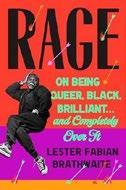
Debut memoir critiquing race and sexuality in contemporary America.
Brathwaite, Entertainment Weekly writer and former editor of Out magazine, invites readers into his love life and shares his experiences growing up in America as a Black queer person. Having moved from Guyana in 1990 at age four, he started bingeing American cable television, which significantly influenced his life. Because his mother enjoyed watching daytime soap operas, he was exposed to many shirtless men on screen, and they attracted his curiosity. “My first loves were Saved by the Bell ’s Zack Morris and Blossom’s Joey Russo,” he confesses, but he began developing crushes on white boys in his real life too. One of them was Jake Capella, “my main antagonist throughout middle and high school, but, what can I say, I love a challenge.” The media he consumed and Hollywood’s depiction of straight white males affected the way Brathwaite
viewed himself, and his desire for white men made him question his own identity: “I always thought Black masculinity was violent. Never tender. Never fatherly. Never loving.” Yet, he sprinkles wit and humor in his critique and begs us to laugh with him: “If I don’t believe that I’m, with all due respect to Trina, da baddest bitch, it’s only a matter of time before I backslide into questioning if I’m even a worthwhile human being.” More seriously, he engages in a thought-provoking critical discourse about how perceptions of masculinity are, in part, a product of the media. Despite the fact that America has a long way to go to overcome its race and gender biases, he ends on a positive note, stating that now is the best time to be a Black queer man, because he is allowed to be who he wants to be and not be punished for it.
An honest exploration into Black queer identity.
Brock, David | Knopf (368 pp.) | $30.00 Sept. 17, 2024 | 9780593802144

A full-throated denunciation of a corrupt, thoroughly politicized Supreme Court in which the true chief justice is Clarence Thomas. It was Brock, then a writer for right-wing publications, who coined the infamous slur on Clarence Thomas accuser Anita Hill, “a bit nutty and a bit slutty.” He’s been atoning ever since. Thomas, as recent news accounts have made clear, has no qualms about accepting gifts from wealthy supporters of extreme right-wing causes; nor will he recuse himself from cases that by all ethical standards he should not hear, including recent rulings on executive power and on the Jan. 6, 2021, Capitol attack. The Court, writes Brock, became Thomas’s the minute Amy Coney Barrett took Ruth Bader Ginsberg’s seat
on the bench in 2020: “[John] Roberts could no longer preside over a conservative court that respected precedent. This was no longer the Roberts Court.” The Court was really owned, Brock holds, by right-wing fixer and ultra-Catholic Leonard Leo, the source of so many of those gifts to Thomas: it was Leo, Brock chronicles, who essentially brokered the morally compromised Donald Trump’s acceptance by the Christian right with the understanding that Trump would appoint an Opus Dei–leaning, hard-Catholic justice, and so he did. Citizens United was an early test case, and with its victory, which allows Leo to make his contributions in secret, “the power of Thomas and Leo was only just ramping up— and it would take years for anyone to survey the extent of the damage to the viability of the U.S. experiment in democracy,” Brock writes. The other conservative justices, notably Brett Kavanaugh—whom Brock accuses of multiple counts of perjury—are nearly as bad, but Brock is clearly focused on Thomas; he closes by laying out a convincing case for impeachment. Critics of the current Supreme Court will find plenty of support in Brock’s aggrieved, well-documented exposé.
Brown, Christopher | Timber (320 pp.)
$30.00 | Sept. 17, 2024 | 9781643263366

Discovering nature in urban “brown lands.” The image of the frontier runs so deep in American culture, writes SF novelist Brown, that we
take for granted that to find nature you have to drive out of town. In fact there is another, hidden wilderness that hides in plain sight around abandoned buildings and empty lots, behind chain-link fences, and along the pathways of infrastructure, rights-of-way, traffic islands, and medians often littered with decades of trash. “The city contains green frontiers that are very real, but the line that defines them is often a ‘No trespassing’ sign.” Brown’s unusual combination of memoir and “natural history” contains many surprising images. Strolling through a parking lot, he looks up to discover five great blue herons going about their business in treetop nests. He sees a fox and then, after setting up a trail cam, records a steady stream of them. Wild plants and animals thrive in spaces from which the city excludes human inhabitants, he finds. This encompasses the pests that find urban areas irresistible (rodents, pigeons, deer) as well as the more exotic animals that eat them: owls, hawks, coyotes, even the occasional wolf. “The wildflowers in the right-of-way and the coyotes in the alley remind us that wild nature is always ready to come back, to adapt to the opportunities we give it,” he writes. “But they also remind us that nature is mostly losing.” Readers who find this material unpromising may change their minds as Brown discovers a rich natural history in unexpected places. An appealing mixture of nature writing, memoir, and self-reflection.

Brown, David S. | Scribner (352 pp.)
$32.00 | Sept. 17, 2024 | 9781668022818
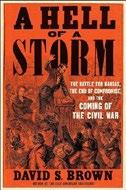
How an incendiary piece of legislation brought on a national crisis. The KansasNebraska Act of 1854 was, as Brown explains here, “almost certainly the most lethal piece of legislation to ever clear Congress.” In reversing the Missouri Compromise of 1820 and allowing slavery to expand into vast new western territories, the act deepened divisions between North and South and pushed the country toward civil war. This engaging history first examines the precarious balance struck between sectional differences at the nation’s founding, then charts its dramatic demolition in the mid-19th century. Brown offers revealing studies of central figures in this historical period, from politicians Stephen A. Douglas and Abraham Lincoln, to authors and social commentators Harriet Beecher Stowe and Ralph Waldo Emerson, to abolitionist activists Harriet Tubman and Frederick Douglass. Particularly rewarding are the author’s analyses of Stowe’s Uncle Tom’s Cabin and its indictment of “those various northern networks of complicity—merchants and insurers, lawyers and creditors—that [kept] the business of bondage strong, expansive, and legal.” Emerson’s complex attitudes about racial differences are also given sensitive and revealing consideration: “Unable to grieve for a race he did not know, Emerson ultimately entered the public outcry against slavery when he recognized the institution as an infringement of white freedom.” Another intriguing and persuasive feature of this book’s commentary is its suggestion that the polarized conditions of antebellum America parallel those of the contemporary moment. Brown’s ultimate
conclusions are apt, compelling, and memorably expressed: “Ill served were the youth who came of age when a divided Congress passed the Kansas-Nebraska Act, in whose wake came a great reckoning, the measured resonance of an original sin that had long shaken the country—and stirs through it still.”
A lively, incisive examination of the social and political background of a tumultuous era.
Bruno, Stephen | Harper/ HarperCollins (256 pp.) | $27.99 Sept. 24, 2024 | 9780063347557
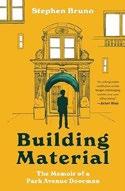
A Park Avenue doorman reflects on the path that led to his transformation into an observer and writer.
Bronx native Bruno grew up in a working-class household dominated by a strict Nuyorican Pentecostal father. High school in Manhattan became an escape from his parents’ disapproval and religious extremism with its mix of interesting people and pretty girls— one of whom kept a diary that disgraced him and his family when her mother found its explicit record of their sexual relations. Bruno fought his parents to attend college outside the city, only to get expelled his junior year for sneaking into the cafeteria after hours. He immediately moved in with a group of college misfits, one of whom invited him to Minnesota and introduced him to the cousin who became his girlfriend. Bruno returned to NYC, took a summer job as a Park Avenue doorman, then returned to Minnesota and a crumbling relationship. When a rare job as a full-time doorman unexpectedly dropped into his lap, he was unwilling at first to leave his girlfriend but finally decided he would use the money he earned to resume his education more seriously
and “take control of my story” by becoming a writer. (The girlfriend drops out of his story after that.) In between opening doors, running elevators, and catering to the whims of the wealthy tenants he sometimes lampoons in the book, Bruno finished an English degree at John Jay College and began an MFA at Hunter College. Yet the most significant lessons Bruno learned, he writes, came from his job. As a doorman, he was a gatekeeper charged with protecting the rich against everything from dogs that defecated on the lobby floor to the vagrants and panhandlers who served as living reminders of wealth inequality. Candid and always animated, his memoir offers a unique perspective on achieving the American dream that is as timely as it is refreshing. Engaging reading.
Burkeman, Oliver | Farrar, Straus and Giroux (208 pp.) | $27.00 Oct. 8, 2024 | 9780374611996

An exploration of ways to escape the trap of perfectionism and step into a happier, more productive life. Much in the modern world, from climate change to global social and political upheaval, is beyond human control, yet people continue to live according to the “fatally misguided idea that reality can and should be made ever more controllable,” writes British journalist and nonfiction author Burkeman. The resulting malaise has contributed to widespread feelings of burnout and anxiety. He posits that the
way forward lies in accepting what he calls imperfectionism, the idea that humans are finite creatures with limited agency. To work toward that end, Burkeman offers 28 Zen-inflected essays on the art of living and staying sane in a messy world; he suggests reading them one at a time over four weeks. He begins by offering liberating insights into letting go of to-do lists and the exhaustion that comes from trying to absorb too much information and care about everything that happens in the world. Only then can individuals finally begin to focus on not only navigating the inevitable problems and distractions of everyday life but also making time for the self-enlarging “life task” that brings satisfaction rather than immediate gratification. In taking action, however, people must beware of “making things happen, through willpower or effort,” which adds unnecessary complications or “feelings of unpleasant exertion.” Ambition has its place, but, Burk eman observes, that too must be balanced so that the present—and all the potential it offers for satisfaction—does not get sacrificed to the unknowns of the future: “We have to show up as fully as possible here, in the swim of things as they are.” Liberating and humane.
Christie-Miller, Alexander | Pegasus (416 pp.) $28.95 | Oct. 1, 2024 | 9781639367344

A revelatory exploration of the ancient city’s four miles of land walls, which enclose the entire western side of its peninsula.
Turkey corre spondent for the London Times for six years in the 2010s, Christie-Miller is a knowledgeable and ideal guide to this terrain. Chapters of his sprawling investigation into centuries of Turkish and Ottoman history alternate with passages grounded in contemporary Istanbul and the vibrant if impoverished neighborhoods that surround its crumbling walls, complete with towers still standing, if partly in ruins. These walls were built by the Byzantines as fortifications, protecting their imperial capital from invasions for a millennium. Christie-Miller centers his history on two momentous events: the siege and capture of the city, then named Constantinople, by Ottoman Sultan Mehmet II in 1453, and the precipitous rise to power of Recep Tayyip Erdogan’s authoritarian, Islamist-rooted AK Party in 2002.
We see how this history has a direct impact on ordinary Turkish citizens: a family turned out of its ancestral home as the urban landscape is razed for residential developments, for example, or a heroin addict whose precarious recovery leads to his work as a counselor in a live-in rehab clinic. We learn how redevelopment projects shut down factories and docks in the former industrial zone on the city’s Golden Horn, to be replaced by tourist-friendly cafés and beachfront. A Roma community is displaced by luxury villas. It’s a very urban history, appropriate since the city’s name comes from the medieval Greek phrase stin polin , “in/at/to the city.”
Throughout the book, Istanbul’s storied past and tumultuous present coexist along miles of the historic walls, now listed as a UNESCO World Heritage Site.
Istanbul’s city walls become the backdrop to compelling human stories of survival and resistance.

Cobb, Russell | Beacon Press (304 pp.) $31.95 | Oct. 8, 2024 | 978-0807007372
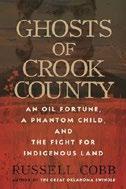
largely because “the mainstream stories Oklahoma tells about itself” are incoherent, and white residents’ desperation to hold on to them in any way possible becomes painfully clear. A worthy, if at times befuddling, attempt to wrangle truth from history.
For a portrait of Istanbul by a native son, visit Kirkus online.
The great-grandson of an Oklahoma oilman interrogates a legal conundrum that lays bare the corruption beneath the creation of his home state.
The “Crook County” of Cobb’s title is in actuality Creek County, just southwest of Tulsa, where two 80-acre parcels were allotted in 1903 to a Muscogee boy who may never have existed. It was also in 1903 that one of the area’s most prominent white philanthropists, Charles Page, began to exploit the oil that lay beneath the soil of the Muscogee Nation. Cobb’s task here is not an easy one. He must explain the displacement of the Five Tribes (Cherokee, Chickasaw, Choctaw, Muscogee, and Seminole) to Indian Territory, U.S. Indian law, U.S. mineral rights as they relate to landownership, and the complexity of race and identity in both the Five Tribes and the United States. And that’s before he tackles the case of Tommy Atkins, “a fictional boy with three mothers,” which spawned four separate trials between 1913 and 1922. Cobb gamely wades into what one interlocutor describes as “some deep shit,” introducing readers to Page, the three claimant mothers, and a dizzying host of supporting characters ranging from a Black Kansas madam to President Woodrow Wilson. Many of the characters overlap from trial to trial, making it hard for both readers and author to follow the winding threads, and the need to continually retreat in time to fill in each trial’s backstory further unmoors readers. “My head continues to spin,” Cobb confesses at the outset, and readers’ will frequently do likewise. If his narrative is at times incoherent, it’s
Cohan, Steven | Oxford Univ. (224 pp.) $29.95 | Sept. 1, 2024 | 9780197668283
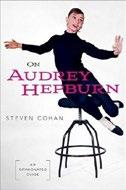
An “opinionated” biography focused on Hepburn’s fame as a fashion icon and movie star. Cohan, a lifelong fan, argues that Hepburn was more than just a charming, lovely presence in her films and earned her fame through her acting skills and eye for fashion. Generally scanting Hepburn’s personal life, he spends most of his time looking specifically at each of her movies, from the well-known to the less-appreciated work from her final years as an actor, also paying attention to her collaboration with Herbert Givenchy, whose clothes helped establish her reputation as a fashion icon. Hepburn’s movies from the 1950s and ’60s, which Cohan dubs “the Audrey films,” include Breakfast at Tiffany’s, Funny Face, and Roman Holiday; in these, arguably her most popular movies, she played a Cinderella-like role close to her actual personality, but they are not the sole focus of Cohan’s analysis. He spends equal time discussing her thrillers, including the acclaimed Wait Until Dark, and the dramatic roles she took in films such as The Nun’s Story and The Children’s Hour. Detailed summaries unpack these movies and others, drawing comparisons between them and showing Hepburn’s growth across the different eras of her career. Even when her characters were mere extensions of her own persona, Cohan argues that her keen timing and expressive movement on screen evidence her skill as an actor. Though his


IN 1986, WORKING as an undercover narcotics agent, Ron Stallworth bought a gram of crack cocaine from a dealer for $100. That wasn’t unusual: The country was awash in cocaine of every variety, and never mind Nancy Reagan’s exhortation to “Just say no.” What was unusual was that the buy was in Salt Lake City, the capital of the straight-laced Church of Jesus Christ of Latter-day Saints, and that the seller was a young Black man from Los Angeles, a member of the street gang turned crime syndicate called the Crips.
As Stallworth recounts in his new book, The Gangs of Zion: A Black Cop’s Crusade in Mormon Country (Legacy Lit/Hachette, Sept. 17), he wasn’t surprised to find a Crip within a rock’s throw of the Tabernacle. A decorated agent in the employ of the Utah State Police, he’d been reading reports from the Los Angeles Police Department warning municipalities that both the Crips and the Bloods—mortal enemies on their own turf but allies in expanding the drug trade outside it—were spreading out along
A retired undercover cop recounts the battle against gangs in an unexpected locale Salt Lake City.
BY GREGORY MCNAMEE
interstate highway corridors to places like Denver, Kansas City, Phoenix, and, yes, Salt Lake City.
“What did surprise me,” Stallworth writes, “was how those reports and their warnings were being ignored by my peers. A flood was coming our way, but nothing had changed. Nobody was responding to the threat, so I had to.”
Further surprises were to come, not least the fact that within no time locals, mostly young white men looking for excitement and cash, were signing up to join the gangs. “I believe in my Mormon faith. One hundred percent,” one young man who’d been busted told Stallworth. “But I also believe in being a Crip. I’m a Crip and will always be a Crip.” Replied Stallworth, nonplussed, “Mormonism doesn’t teach drive-by shootings. Mormonism doesn’t teach throwing Molotov cocktails at your enemies’ houses. How do you reconcile the two?” He didn’t get a good reply.
Speaking with Kirkus from his home in West Texas, where, long since retired from law enforcement,
he spends his days writing, Stallworth recalls his lonely battle to interdict the drug trade in Salt Lake City. “The street officers knew what was going on,” he says. “Everybody knew what was going on except the administration, which denied that there was a problem. They had their heads stuck up their butts. None of the higher-ups in Utah law enforcement paid attention to the warnings. The attitude was always, This is Utah. We’re a pure, homogenous community. We don’t have to worry about stuff like that. Religion will cover us .”
Well, as the aforementioned episode demonstrated, religion didn’t quite do the trick. The next card to play in the denial game, Stallworth says, was for the SLCPD to suppress any mention of the problem. “We were forbidden to use the word gang ,” he says. “They would call them youth groups, organizations, youth organizations, or whatever. Any metaphor, but the word gang was not used.”
A born contrarian, Stallworth refused to play. “I started using gang.
I openly used it, and since I was a state cop, they couldn’t stop me from saying it.”
He sent a report up the chain of command, saying that it was time to acknowledge that Salt Lake did indeed have a crack problem. He also pitched creating a task force under the aegis of the city’s police department to coordinate communication across law enforcement agencies. All the while, he kept working undercover, as he’d done for a decade and a half, first in Colorado, where the seemingly improbable events of his 2014 memoir BlacKkKlansman , turned into a film by Spike Lee four years later, took place. “I wasn’t put in narcotics because I was exceptional,” he writes in Gangs. “I was put in narcotics because they needed a Black face to penetrate Black environments.”
He then moved on to Wyoming to serve, as he puts it, as “the only Black undercover investigator in the whitest state in the country.” He soon had occasion to underscore that distinction when a clutch of cowboys repeatedly called him “boy” before selling him a gram of powder cocaine. Busted hard, the cowboys got their comeuppance. Counsels Stallworth, “The moral to this story? Never call a Black man ‘boy.’”
After three years on the job, Stallworth finally got the Salt Lake Area Gang Project going, and there he increasingly encountered the “gangs of Zion” of his title. “They did not disavow their religion,” he says. “They clearly identified themselves as Crips who happened to be Mormon. My partner was a devout Mormon. We cracked up when we first heard it—we thought it was hilarious. But we realized these kids were serious.”
One sign of that seriousness was that the young gangsters listened not to the Osmonds but to so-called gangster rap and hardcore hip-hop. Mystified at first, Stallworth began listening to the likes of Public Enemy and N.W.A., increasingly realizing that the rappers had a point: They had legitimate grievances, many of them centered on the police.
Even with the formation of the gang unit—still operative, under a different name, four decades later—police leadership and city government took predictable views. Against all evidence, they blamed the gang activity and drug trade strictly on outsiders—and then, when that didn’t work, on the city’s Pacific Islander and Latinx communities. The late Margaret Corradini, Salt Lake City’s first female mayor, went so far as to call for a ban on the sale of gangster rap records and any movies with a hint of gang activity. “I asked her if she was willing to ban the movies of John Wayne, which depict violent genocide against Native Americans,” Stallworth says. “Hell, in the first Terminator movie, Arnold Schwarzenegger kills 30 cops in the first minute. And I asked her if she was willing to ban the showing of the old Untouchables TV show, because every week they did a drive-by shooting. No? So why are you picking on movies made by and for young Black people about their
society, their environment? Why are you picking on them and ignoring all this other stuff by white artists?”
Such questions didn’t make Stallworth many friends among the brass, and he was eventually reassigned to a desk job. It didn’t take, and one day, he writes, he looked around and thought, I don’t like any of you people
He left law enforcement, but his experiences gave him plenty of material to write about. He publicly advocates against both gang violence and policing excesses, frequently speaking about the issues at conferences and to the media. “One thing I want readers to take away from my book,” he says, “is that you have to be willing to stand up for your beliefs and speak truth to power. I hope people recognize that everything that I did, I believed in. I got into trouble with my superiors at the Department of Public Safety. They didn’t want me to say certain things in public, and I politely told them to fuck off and did what I had to do. I’ve never regretted it.”
None of the higher-ups in Utah law enforcement paid attention to the warnings.
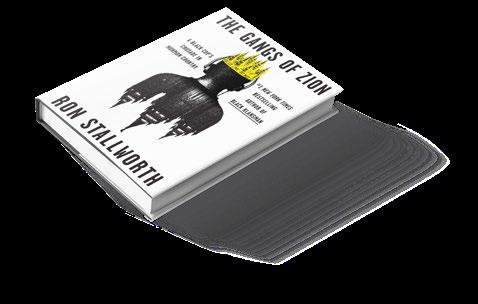

The legendary singer and actor’s Cher: The Memoir, Part One has a November release date.
Fans of Cher have been waiting for the legendary singer and actor to turn back time in a memoir—and now their wait is almost over.
Dey Street will publish Cher: The Memoir, Part One later this year, the press announced in a news release, saying that the book—the first of two planned volumes—“re -
veals the daughter, the sister, the wife, the lover, the mother, and the superstar.”
Cher, a California native, first gained national prominence in the 1960s as part of Sonny & Cher, the pop duo that she formed with her husband, Sonny Bono. The two had hits with songs including “I Got You Babe” and “The Beat Goes On,” and in the 1970s they co-hosted a TV variety show that ended after the couple’s divorce.
She became known as an actor in the 1980s, with prominent roles in films such as Silkwood and Mask, and she won an Academy Award in 1988 for her memorable performance as Loretta Castorini in Moonstruck Her musical career also saw a resurgence in the late 1980s and 1990s, with songs like “If I Could Turn Back Time” and “Believe” dominating the pop charts.
Cher: The Memoir, Part One is slated for publication on Nov. 19, with the second volume scheduled for release in 2025. —M.S.


For more celebrity memoirs, visit Kirkus online.
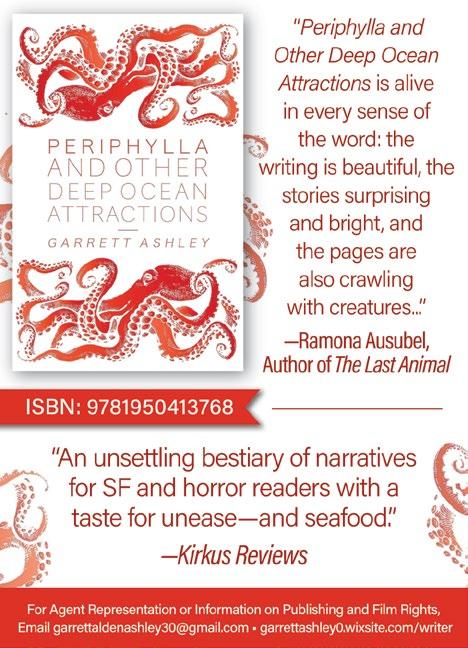

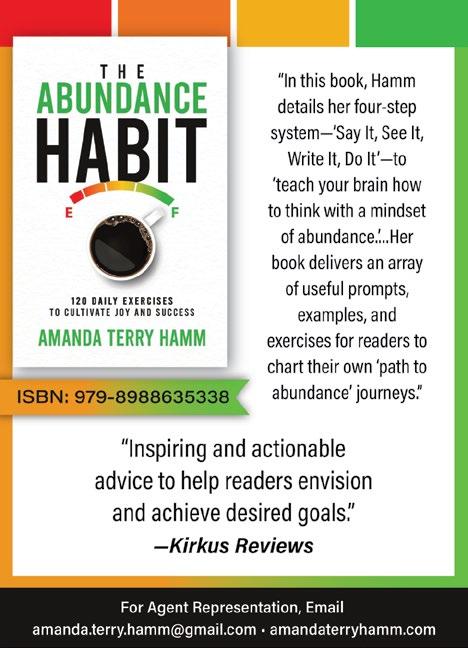

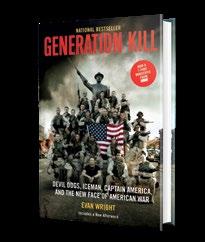
The journalist was known for his award-winning 2004 book about Marines in the Iraq War.
Evan Wright, the author of the award-winning 2004 book Generation Kill, has died by suicide at 59, the Washington Post reports.
Wright, a Cleveland native, had a troubled childhood, spending time at a juvenile delinquent facility. He was educated at Vassar College and later moved to Los Angeles, where he worked as a pornographic movie reviewer for the infamous adult magazine Hustler
He then began writing for Rolling Stone, immersing himself in various subcultures for his long-form articles. In 2003, he published a series of pieces in the magazine chronicling time spent alongside U.S. Marines in Iraq; that reportage led to Generation Kill,


which Putnam published in 2004.
The book won the J. Anthony Lukas Book Prize and the Los Angeles Times Book Prize for current interest and was adapted for a 2008 HBO miniseries starring Alexander Skarsgård, James Ransone, and Jon Huertas.
Wright’s other books include Hella Nation, American Desperado (co-written with Jon Roberts), and How To Get Away With Murder in America
Wright’s admirers paid tribute to him on social media. On the platform X, author Matt Gallagher posted, “Rest in Peace to Evan Wright, who hated the war and loved the soldier.”—M.S.

analyses are often bogged down by dense passages of summary, he does add a fresh perspective on Hepburn’s acting, arguing that it “now speaks to those contemporary viewers like me, who understand the artifice of genders, how ‘masculinity’ and ‘femininity’ are neither monolithic nor organic but are cultural constructs and performances.”
A densely detailed guide, especially suitable for fans of Hepburn’s movies.
Collins, Francis S. | Little, Brown (304 pp.)
$30.00 | Sept. 17, 2024 | 9780316576307

Prescriptions for change. Collins, a physician, evangelical Christian, and former director of the National Institutes of Health, seeks a remedy for the divisiveness and anger that beset our nation. Healing, he asserts, depends on four sources of clarity and wisdom: truth, science, faith, and trust. The Covid-19 crisis, especially, darkened his “usual optimistic view of society,” making him realize “how much we have lost track of the sources of wisdom—how we have let politics on both the right and the left become our touchstone.” He examines controversies that emerged about protocols for managing the virus (masking, business and school closures, social distancing), the cause of the pandemic, and the effectiveness of vaccines; he also discusses other incendiary topics, including climate change and the results of the 2020 presidential election. People’s opinions on these issues have been swayed, Collins asserts, by six kinds of untruth: ignorance, falsehood, lies or “intentional distortion of the truth,” delusion, bullshit, and propaganda. Those who use social media as their main source of information about the world can be “unwittingly manipulated” by these forms of untruth. Collins asserts
that identifying falsehoods boils down to trust in the integrity and competence of the person or institution conveying information, and he cautions against believing only those whose values align with one’s own. Drawing on examples from his personal and professional experiences, he reveals times when his trust has been honored and times when it has been broken. As a scientist who finds belief in a Christian God “entirely consistent” with his faith in evidence-based truths and scientific methods, he recounts his journey from atheism to Christianity. Overall, Collins urges each reader to create a renewed sense of community through “reanchoring your worldview”; engaging with family, friends, and community; and carefully distinguishing facts from fakes. Thoughtful guidance in tumultuous times.
Technology Became the World’s Most Powerful Religion, and Why It Desperately Needs a Reformation
Epstein, Greg | MIT Press (368 pp.) $29.95 | Oct. 29, 2024 | 9780262049207
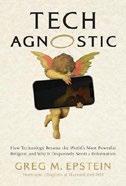
We live in the church of the Wi-Fi connection, avows this interesting investigation. The ubiquity of the screen, the pervasiveness of the net, the omnipresent power of the tech corporations: these are the elements that drive our civilization, according to Harvard/ MIT “humanist chaplain” Epstein. Technology has become a modern religion, reaching into every corner of our lives. Epstein touched on some of these ideas in his 2010 bestseller Good Without God: What a Billion Nonreligious People Do Believe, but here he focuses on the psychological impact of computer tech on our society. Many people are willing to put their faith in technology as a means of solving all problems, and
social media groups are starting to look like religious congregations, he states. The founders of the tech behemoths seem to see themselves as the saviors of humanity because they offer digital connectivity and vast stores of information. The experts who know how to create, manipulate, and spread the technology have become a priestly caste, armed with secret rituals, impenetrable language, and disdain for the masses below them. These ideas are interesting but, in the end, Epstein’s case is not really persuasive. Many of the connections he makes in this book are tenuous, and some of the detours he takes are distracting rather than illustrative. However, his call for putting the screens aside to build true contact is welcome. “We can create a reformation—in our technology, but more importantly, in our common humanity—that might just flower into a renaissance,” he concludes. “May it be so.”
A wide-ranging, provocative, and energetic deep dive into the role that technology plays in our lives.
Garringer, Rae | Haymarket Books (208 pp.) $24.95 | Oct. 8, 2024 | 9798888902486
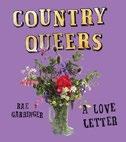
Hidden life stories buried in small towns across America. Oral historian and audio producer Garringer has spent a decade collecting stories and photos of rural queer folks around America. Themself a country queer, they felt as if the rural LBGTQ+ community had very little representation in comparison to those living in big cities. On a mission to cultivate and collect interviews with country queers, Garringer has threaded every session with fondness and care so that the reader is personally affected by each of them. The interviewees, young and old, hail from Appalachia to Texas to Massachusetts, offering their neighborly wisdom. You can imagine
rocking chairs, iced tea, and cicadas while Garringer records. (They do a podcast with the same title.) Questions that he they frequently ask: What is the difference between a city queer and a country queer? Does a smaller queer population equal a lesser community? What is the largest issue facing country queers today? With the political climate, is it safe? Why do you think there is little to no representation of rural queer people? These are hard questions with no easy answers, but Garringer jubilantly proclaims to the world, Hey! We’re here! Always have been and always will be! The photos, taken by the author and the interviewees, give this work the feel of a homemade, handcrafted scrapbook, with images of catfish, goats, lawn mowers, ceramic cows, actual cows, and lots of beautiful scenery enlivening the pages. Near the end of most interviews, Garringer asks their subjects where they are happiest—the question behind the question being “Is there anywhere else you’d rather be?” Most people laugh and respond with some version of “I’m happiest just being right here”—readers can almost feel the room brighten with these assertions of pride and place. This is indeed the love letter of the subtitle: to the country, to queer friends and neighbors, to the small pieces of life. Slow down and flip through this uplifting, hand-threaded quilt of lives. Fans of the popular podcast of the same name will yeehaw with joy over this collection.
Gilbert, Mark | Norton (448 pp.) | $35.99 Sept. 24, 2024 | 9780393867084
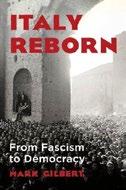
Despite the hysteria over the recent ascent of the right-wing Brothers of Italy party, Gilbert asserts that democracy in Italy has firm foundations thanks to the decisions of its postwar leaders. He concentrates on the key decade after the fall of Mussolini and his fascist state, which marked the lowest point for the defeated Italian people. Gilbert asserts that the many prisoners and partisan resisters of the fascist-Nazi regime would prove to be the “protagonists of democratic Italian politics for the next five decades.” Emerging from the “abyss” were the main parties of Christian Democracy (DC), headed by De Gasperi, and the communist party, PCI. Gilbert describes the country at the end of the war as being in a miserable state of poverty and illiteracy, especially in the south. The Truman administration was leery of both the monarchy, discredited by its support of Mussolini, and the left-leaning government in place after liberation; the U.S. advocated for elections to prove that Italy was now a democratic nation. Two-thirds of the country’s towns and villages voted in the spring 1946 local elections, many for the first time (particularly women), in what Gilbert calls a “symbolic act of political maturity.” A referendum on the monarchy and elections to a Constituent Assembly were held on July 2, 1946, and the republic prevailed. The “hinge year” of 1947 would see the hammering out of a new democratic constitution and alignment of the government, with De Gasperi as prime minister, firmly with the United States. De Gasperi’s party would steer the country into “centrismo” with the help of the Marshall Plan over the next five years, despite left-leaning turbulence and the Cold War.
A detailed, nuanced work that sheds new light on a crucial era in Italian history.
Shakespeare Lied
Gilbert, Sky | Guernica Editions (150 pp.) $17.95 paper | Oct. 1, 2024 | 9781771839037
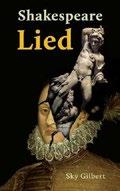
No moral lessons, just gorgeous language and vibrant voices lie at the heart of Shakespeare’s plays So argues Canadian multihyphenate Gilbert (a novelist, playwright, and founder of a gay theater in Toronto), who also argues that “the recent intrusion of the woke left into aesthetics…threatens to destroy art.” This mindset, he states, has transformed artistic works into vehicles for didactic and/or propagandist ends. In this collection of essays, Gilbert, working from the premise that the analytical, “left brain cultural takeover” began during Shakespeare’s life, analyzes how the Bard’s plays and poems reveal a rejection of reason and empiricism. He begins by observing that Shakespeare’s writing style is as complex as it is heavily connotative, which he sees as atypical for an era when most writers followed one of three styles: “grand, middle or low.” Indeed, the Bard often adopted a variety of styles within single passages of text. His stylistic “slipperiness” extends to how he played arguments and counterarguments against each other to create works “steeped in paradox.” That, Gilbert suggests, marks Shakespeare’s plays as amoral and the playwright as a skeptic. He further argues that the playwright’s commitment to rhetoric and language before all else placed him in a position where he could simply allow his
British scholar Gilbert argues that Alcide De Gasperi’s postwar leadership of Italy established the foundation for its embrace of democracy ever since.
Provocative, intelligent reading for literary scholars and Shakespeare aficionados.
Fans of the original will learn much from Gladwell’s thoughtful, carefully written reconsideration.
REVENGE OF THE TIPPING POINT
characters to speak and act rather than use them to reveal any particular social or political bent. Working during a time when theater was under attack by Puritans, who favored plays that moralized, the Bard chose instead to follow a Classical aesthetic grounded in the thinking of philosophers like Gorgias, who believed that “what is real is defined by the artist in collaboration with the audience.” Shakespeare, then, was not only a literary craftsman but also an early modern aesthete dedicated to creating beauty rather than delivering messages for the ages. This view of Shakespeare is hardly new, but its application to today’s woke culture is stimulating, if not necessarily persuasive.
Provocative, intelligent reading for literary scholars and Shakespeare aficionados.
Kirkus Star
Revenge of the Tipping Point: Overstories, Superspreaders, and the Rise of Social
Gladwell, Malcolm | Little, Brown (368 pp.)
$32.00 | Oct. 1, 2024 | 9780316575805
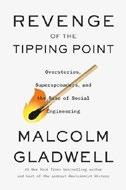
A quarter-century on, Gladwell revisits his best-known book and examines some of its assumptions and conclusions.
Rereading The Tipping Point, Gladwell writes, made him realize “that I still do not understand many things about social epidemics.” The tip point of real estate parlance—it refers
to things such as the ethnic composition of a neighborhood when, once a percentage in the growth of race x is reached, members of race y will move up, on, or otherwise out—explains only so much. Often, he writes, “social contagions,” a metaphor used to describe how ideas spread like viruses, can be traced back to just a handful of innovators (or viral superspreaders, for that matter): What matters thereafter is how the ideas (or viral loads) are received and dealt with. For example, why does Illinois have a low rate of opioid abuse relative to Indiana? Because Indiana, like many states, doesn’t require monitoring, which explains why swarms of Big Pharma salespeople descended on those states to push OxyContin and other drugs to epidemic levels. Illinois, by contrast, is one of the states that require triplicate prescriptions: one copy goes to the pharmacist, one to the patient’s records, one to a regulatory agency. That three-tiered pharmaceutical pad, Gladwell writes, “evolves into an overstory,” or governing idea, “a narrative that says opioids are different, spurring the physician to pause and think before prescribing them.” Refining and deepening his and our understanding of the spread of customs, mores, and practices, Gladwell emphasizes those overstories, illustrating them with twisting and turning tales of, for example, how the word holocaust came into general usage (surprisingly, via TV), how the idea of gay marriage gained acceptability, and how widespread social engineering “has quietly become one of the central activities of the American establishment.”
Fans of the original will learn much from Gladwell’s thoughtful, carefully written reconsideration.
Gore, Gareth | Simon & Schuster (448 pp.) $30.99 | Oct. 8, 2024 | 9781668016145
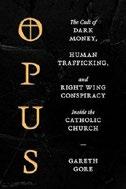
Investigation of a failed Spanish bank reveals unsavory ties to a secretive religious organization determined to “take back control” of a world tainted by secularism.
The 2017 collapse of the Banco Popular took the world—and financial journalist Gore—by surprise. The many shareholder interviews he conducted after moving to Madrid eventually led him to one of two brothers who had served as bank chairmen. From Javier Valls-Taberne, Gore learned that Opus Dei, an influential conservative Catholic sect, had controlled his older brother and dismissed Javier while bilking Banco Popular of millions, which the sect used to promote itself and its “works” around the globe. Gore’s investigations revealed that beneath the mask of extreme ascetic piety Opus Dei presented—to individuals, communities, and even John Paul II, the pope who elevated the group to a personal prelature—were power-hungry men who worked to create schools and other organizations all over the world meant to “educate” rising generations in extreme religious conservatism. Digging deeper, Gore learned that Opus Dei had ties to American conservative elites that had funded the Jan. 6, 2021, “March to Save America” through “dark money vehicles” and helped bring down Roe v. Wade. Other unethical practices included recruiting young girls from poor countries, then using religion to force them into serving without pay all-male Opus Dei elites. Moving with the suspenseful twists and turns of a political thriller, this well-documented book reveals the hidden agendas and intrigue that belie institutional structures in a post-truth world. Unsettling, informative reading.
Goza, Joel Edward | Eerdmans (344 pp.)
$34.99 | Sept. 24, 2024 | 9780802884312
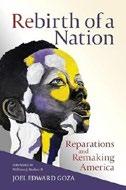
A call for reparations, among other actions, to atone for enslavement and subsequent human rights violations over the course of American history.
A longtime activist working at the intersection of race, religion, and politics, Goza lays out a program that involves not just monetary reparations to the descendants of enslaved Black people, but also repentance and repair. By the former he means a recognition of the white supremacism that enabled slaveholding and which has been transmitted, fairly well unmodified, down to permeate all the trappings of today’s systemic racism. Goza charts the trajectory from Thomas Jefferson’s apparent foreclosure on the possibility that Blacks were fully human, through Abraham Lincoln’s willingness to allow slavery to endure to preserve the Union, to LBJ-era laws authorizing the militarization of the police “to ‘control’ urban unrest.” All of this leads directly to the issue of reparations, which, Goza reminds us, have a precedent in the Civil Liberties Act of 1988, which provided $20,000 in payment to each Japanese American person who had been interned during World War II. Granted, though Ronald Reagan approved of that legislation, some within his administration worried that “the bill could establish a bad precedent for other groups who feel they have suffered injustices”—namely, of course, Black Americans. Goza skims over the fiscal implications of reparations, which many economists hold to be impractical if not ruinous, but he makes a good case for the power of those reparations to “close the racial wealth gap at an individual and family level.” Given that this gap was deliberately engineered over
generations, Goza’s conclusion that reparations would constitute “the paradigm shift we must embrace if we are to thrive as a nation” seems on point and certainly, from an ethical if not economic viewpoint, persuasive and well defended.
A welcome and timely contribution to the conversation around civil rights.
Greenberg, David | Simon & Schuster (704 pp.) $35.00 | Oct. 8, 2024 | 9781982142995
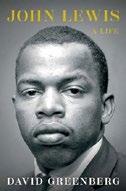
C omprehensive biography of the late civil rights leader and legislator. John Lewis practically emerged from the womb with his habits fully formed: at a very early age, he became entranced by books, taking as a lifelong talisman the poem “Invictus” and its closing: “I am the master of my fate, / I am the captain of my soul.” Born in 1940 to tenant farmers in southeastern Alabama, Lewis came of age as the Civil Rights Movement was gathering force; while a student at the American Baptist Theological Seminary in Nashville, he helped organize lunch-counter sit-ins and even tried to organize an NAACP chapter on campus until warned that the white churches funding the college “would never tolerate it.” Organizing voter drives during Freedom Summer 1964, Lewis practiced Martin Luther King Jr.’s doctrine of nonviolence, which he held to for the rest of his life, even as he endured beatings by white supremacists and police. He made news for refusing to give in and later, having taken the case for civil rights to first John and then Robert Kennedy, for entering national legislative politics. Greenberg allows that Lewis could be a contrarian with a radical edge; he stated at the March on Washington, for example, “We are involved in a serious social revolution.” He remained a force
for progressivism in Congress—and, Greenberg notes, an early and strong ally of the LGBTQ+ community and advocate for the environment. Greenberg also points to uncomfortable moments, including Lewis’ divisive primary race against fellow Black progressive Julian Bond, whose enmity extended unto death (Lewis was not invited to Bond’s funeral). Greenberg also writes perceptively about how Lewis finessed his friendship with Hillary Clinton to become a champion of Barack Obama during the 2008 presidential race and how Lewis became a leader in the repudiation of Trump-era white supremacism before his death in 2020. An exemplary life, and an exemplary biography that will rekindle readers’ commitment to racial justice.
Han, Hahrie | Knopf (304 pp.) | $29.00 Sept. 24, 2024 | 9780593318867
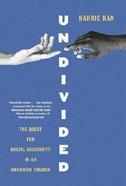
A Protestant megachurch struggles to reckon with systemic racism and inequity. In 2016, in Cincinnati, voters overwhelmingly approved raising their taxes to fund city preschools, “with targeted resources for poor—mostly Black—communities.” Johns Hopkins political scientist Han took note, especially because the numbers were markedly different in the presidential election: Cincinnati went for Clinton by 10 points, but the voters approved the school initiative by 24, so that “thousands of voters who supported Trump must have also supported Issue 44.” Digging deeper, Han discovered that a Cincinnati megachurch called Crossroads had mounted an antiracism training program called Undivided, one of whose outcomes was that many conservative members supported more funding for minority schools by way of a curriculum very much like the “diversity,
equity, and inclusion (DEI) training programs that pervaded corporate America”—a source of loud outrage for right-wing politicians. Han examines the many paths Crossroads clergy, staff, and parishioners took to arrive at views about structural racism that, as Han writes, defy received wisdom about evangelicals on many points. It helped that the megachurch’s demographics skewed younger and more racially diverse than most, with many members who “believed the core theological tenets of evangelicalism, but explicitly or implicitly rejected the right-wing politics associated with it.” Many of those members also voted for Trump, but no one can doubt that on some matters concerning race, doors to understanding were opened rather than slammed shut. “At the most basic level,” writes Han, “Undivided equipped [its] participants to understand both the interpersonal and systemic dimensions of racial injustice and offered them tools to have difficult conversations around race.” Her book ably charts that course even as it illustrates the Christian concept of grace in action. Inspiring: a key text for any reader seeking strategies for racial reconciliation—or at least beginning to talk about it.
Lost in Austin: The Evolution of an American City Hannaford, Alex | Dey Street/ HarperCollins (240 pp.) | $30.00 Oct. 1, 2024 | 9780063253025
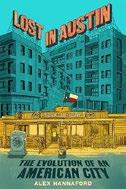
Austin is a city suffocating from endless growth, a disenchanted former resident reports. For all its fame, this celebrated Texas town has gone sadly astray, writes Hannaford, a British-born freelance journalist now based in New York. It is a victim of its own success, having succumbed to the same forces of rampant overdevelopment, gentrification, racism, gun
proliferation, homelessness, and environmental decay that are turning other American cities into enclaves almost exclusively for the wealthy. And in his estimation, there’s little or no political will to stop it. Hannaford barely recognizes his erstwhile home of 20 years, once a progressive, funky, laid-back, culture-rich haven for creatives and misfits. While it grew into its (manufactured) reputation as a live music capital, Austin lured and was inundated with new residents and tech corporations, then did its utmost to destroy all the characteristics that had made it so appealing. Austin is now the 10th-largest city in the U.S., with all the ills that come with it. Hannaford chronicles the development of each issue in meticulous detail (albeit from a strongly left-of-center perspective), including the effects of climate change exacerbated by corporate and political disregard. The evidence he presents is damning. Although he apportions credit to what Austin is trying to do right, he fears that it may be too little too late if things continue as they are in this increasingly homogenized city lodged in a deep red state. Happily, he offers more than a litany of malfeasances. Hannaford also invests his book with personal anecdotes, arresting profiles, and the vivid stories of a diverse group of citizens and undocumented immigrants. Nonetheless, the ultimate impression is that of a city steadily losing its distinctiveness and livability. A model of first-rate reportage.
Hare, Jodie | Verso (160 pp.) | $19.95 paper | Oct. 8, 2024 | 9781804291535

A muddled argument for neurodivergent liberation.
First-time British author Hare was diagnosed with autism in 2020 and at that point became involved with online autistic
and neurodivergent communities. Her book is an earnest but often disjointed attempt to make the obvious case that “neurodivergent and/or disabled people belong in this world just as much as anyone else.” Though Hare does not believe that autism (a word she uses interchangeably with neurodiversity) is a disease, she does believe that it is a disability. “Being disabled is not shameful, and I will not treat it as such,” she writes. When discussing autism, she tends to conflate it with other forms of disability, to the point where any discussion of the particular challenges and possible advantages of autism gets lost in calls for “abolishing capitalism, racism, imperialism, the patriarchy, and every other system that works against a system in which we are all liberated.” At the same time, her own point of view is often buried in the frequently conflicting opinions of the many authors she cites as she explains one point of view and then moves on to the next. Occasionally, Hare offers practical advice on, for example, how to make the workplace more friendly to autistic people (a term she prefers over “people with autism”): provide a less intense sensory environment, implement neurodiversity training, offer opportunities to work from home, and so forth. More frequently, she drifts away from practicalities to make jargon-filled statements such as, “The binary oppositions that have been created in the service of hegemony and the status quo have been built within strict boundaries that alienate parts of the population.” Readers looking for insight into the experience of autism or the specific ways in which people with autism are discriminated against will likely be frustrated. Flawed treatment of an important topic.

For a memoir about autism’s impact on a family, visit Kirkus online.
Jarvis, Jeff | Basic Books (272 pp.) $29.99 | Oct. 8, 2024 | 9781541604124
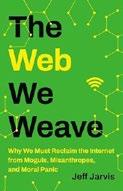
A nostalgic bid for a return to a more open, more diverse, and less commodified internet.
Jarvis—journalist, co-host of the This Week in Google podcast, author of The Gutenberg Parenthesis —believes that the internet, social media, and artificial intelligence are victims of a moral panic that seriously distorts their social and economic impacts. Attention-seeking politicians, dissenting technologists, academic doomsayers, and newspaper, magazine, and television pundits claim that these technologies are responsible for a variety of ills, from spreading hate and disinformation to corrupting youth and undermining economic competition. In its place, Jarvis offers what he deems a saner, more productive, and evidence-based assessment. Central to his case is that the internet, social media, and AI are mere tools, neither inherently dystopian nor utopian forces. Their problems are solely the responsibility of the humans who develop, manage, and use them. The technology, he asserts, is not complicit and not to blame. Because Jarvis considers the internet as primarily a culture of information and conversation, his main concern is with speech: how to ignore bad speech and encourage good speech. Regrettably, he writes little about how this might be done. His overall goal is to recapture the internet’s original
intent of connecting people and giving voice to once-marginalized groups. To this end, he calls for restructuring the industry to be more “open and free,” demoting the geeks (he means you, Elon Musk), and finding ways to make the internet more local and community focused. These are not tasks he wants to give to government, however. Instead, Jarvis dreams of covenants in which we all “take on a sense of responsibility and obligation to one another.” Lacking a blueprint for making that happen, his well-intentioned book doesn’t seem to have much of a point.
A loving critic hopes to resurrect the lost promises of the internet.
Jones, Dan | Viking (432 pp.) | $35.00 Oct. 1, 2024 | 9780593652732

Mostly known for winning the battle of Agincourt, Henry V turns out to be competent as well as pugnacious. Author of Magna Carta: The Birth of Liberty, Jones specializes in traditional greatmen-and-politics histories of the Middle Ages, and this is a good one. Sticking to chronology, he begins with his subject’s 1386 birth, oldest son of a great nobleman, Henry Bolingbroke, during the reign of Richard II (1377-1399). Richard was unpopular, and Bolingbroke led a faction that deposed and finally murdered him. Taking the throne as Henry IV, Bolingbroke began his teenage son’s apprenticeship by taking
A loving critic hopes to resurrect the lost promises of the internet.
Kahler, Abbott | Crown (288 pp.) | $32.00 Sept. 24, 2024 | 9780451498656
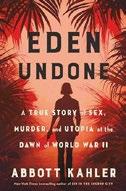
Strangers in paradise. Kahler (aka Karen Abbott), host of the podcast Remus: The Mad Bootleg King, biographer of famed stripper Gypsy Rose Lee, and chronicler of sin and scoundrels, briskly recounts the mysterious history of the small Galapagos island, Floreana. Drawing on diaries, letters, and news reports, Kahler follows the
>>> him on a campaign against the Scots and then sending him off on his own to suppress a rebellion in Wales. Unlike many English rulers, Bolingbroke possessed good political skills, especially in dealing with parliament and raising money, which he passed on to his son. He became chronically ill several years into his reign, so young Henry took on more responsibilities. Assuming the throne, he determined that it was a perfect time to resume the Hundred Years’ War. France’s king, Charles VI, was often insane, and his nation verged on civil war as two factions struggled for power. The 1415 Agincourt campaign takes less than 30 pages, but readers will not complain as Jones proceeds to demonstrate how war is generally a bad idea, even one begun with an immortal victory. Henry V’s campaign continued, winning several less-than-immortal victories that cost increasing amounts of money and lives. In 1420 he married Charles VI’s daughter and was declared heir to the French throne but died even before Charles, in 1422, as France was getting its act together. Joan of Arc soon appeared on the scene, and most readers know how that turned out. Expert life of a celebrated English king whose greatest legacy is probably Shakespeare’s play about him.
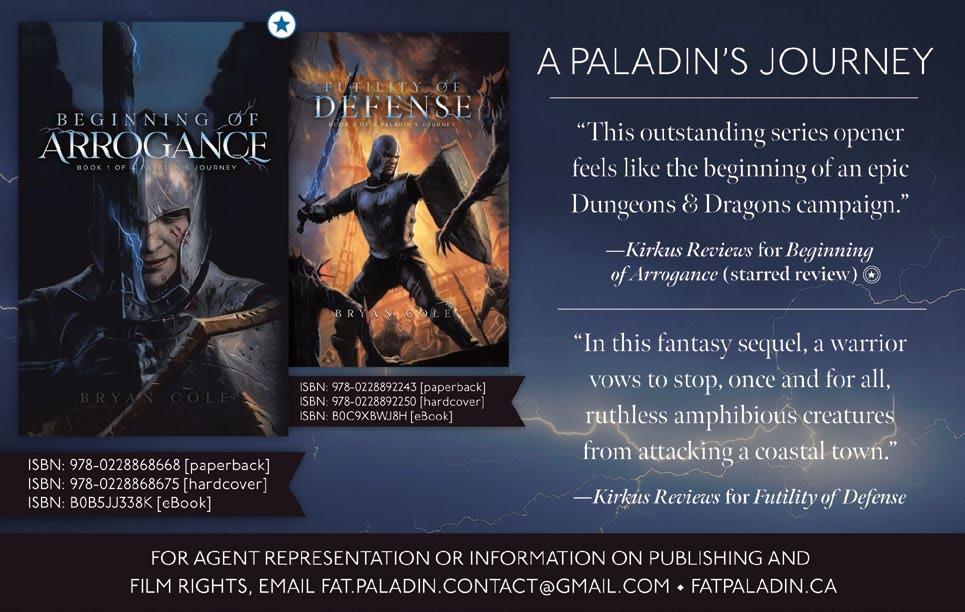
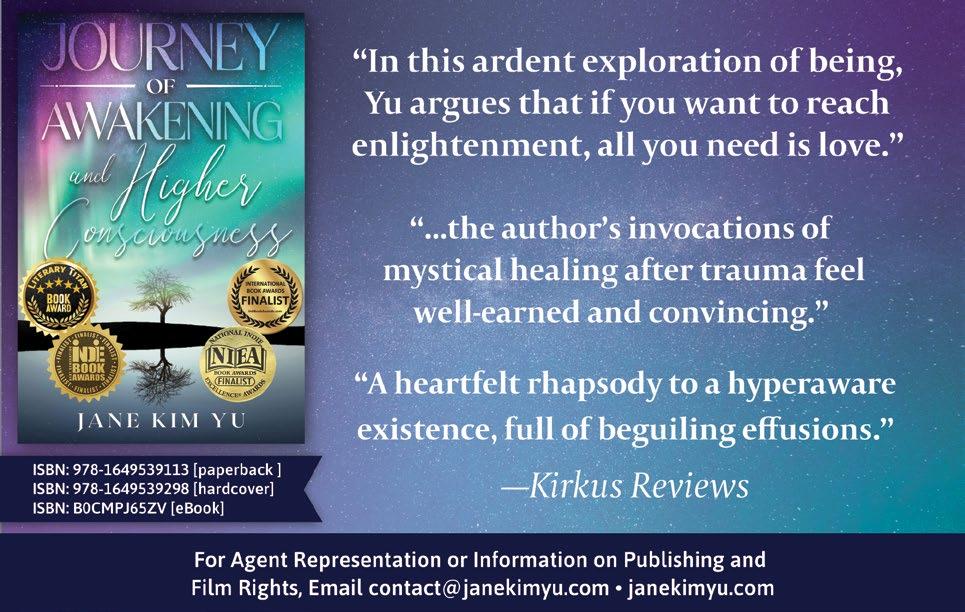






Lindsay M.
By Corey Brettschneider
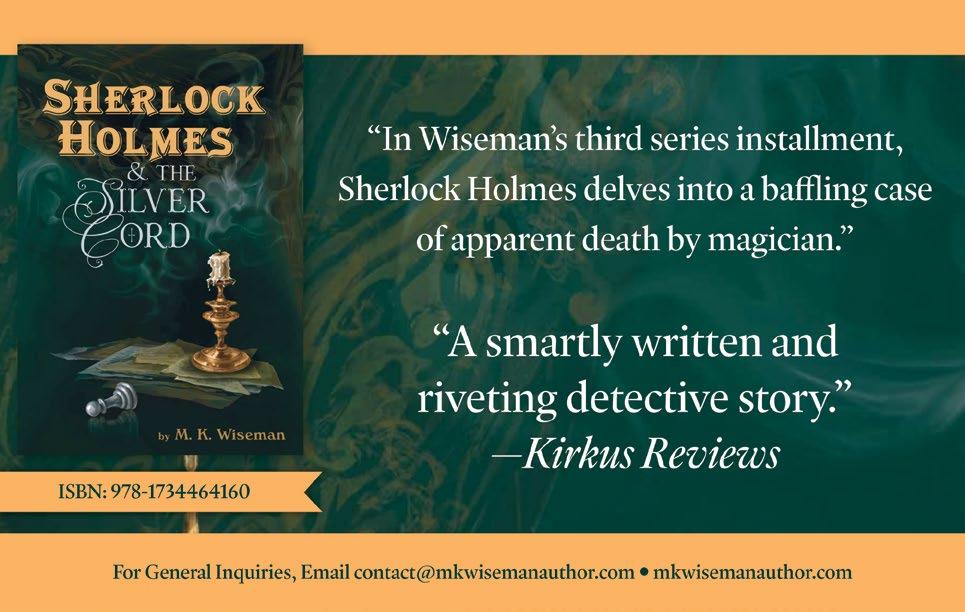


A Complete Unknown, based on a 2015 book by Elijah Wald, stars Timothée Chalamet.
Searchlight Pictures has released a trailer for A Complete Unknown, its upcoming Bob Dylan biopic starring Timothée Chalamet as the musical legend. The
film is based on Elijah Wald’s Dylan Goes Electric!: Newport, Seeger, Dylan, and the Night That Split the Sixties
Wald’s book, published by Dey Street in 2015, is the story behind Bob Dylan’s controversial appearance at the Newport Folk Festival on July 25, 1965. Dylan, at the time mostly known as a folk singer, played with an electric band, angering many traditional folk fans. A critic for Kirkus called the book “an enjoyable slice of 20th-century music journalism.”
The film adaptation is directed by James Mangold (Walk the Line, Indiana Jones and the Dial of Destiny) and

also stars Edward Norton, Elle Fanning, and Monica Barbaro.
The trailer opens with Norton as folk legend Pete Seeger telling an audience, “I want to tell you a little story. Few months back, my friend Woody Guthrie and I, we met a young man. He dropped in on us out of nowhere, and he

For a review of Dylan Goes Electric!, visit Kirkus online.
played us a song. In that moment, we got a feeling we were getting a glimpse of the future.”
The trailer then cuts to Chalamet as Dylan, performing “A Hard Rain’s A‐Gonna Fall,” which continues to play over scenes of him walking by New York’s legendary Cafe Wha?, being accosted by clamoring fans, and riding a motorcycle.
A Complete Unknown is scheduled to premiere in theaters in December.—M.S.

fortunes and misfortunes of a handful of eccentric Europeans who settled on the island, beginning in 1929, sharing the fervent desire “to create a utopia, although each of them had different visions as to what a utopia might be.” First to arrive were Dr. Friedrich Ritter, a narcissistic German physician, and his patient Dore Strauch, who left their respective spouses with the plan “to live a life of contemplation, of mutual love and simple work with natural things.” But news reports about their endeavor turned the “Modern Adam and Eve” into the objects of such sensational publicity that others followed. Some—journalists, scientists, and wealthy Americans eager to see exotic wildlife— made brief recurring visits; among those who stayed, intruding on the couple’s life of contemplation, were a German war veteran, his pregnant lover, and his sickly teenage son and the rapacious Baroness Wagner, accompanied by two lovers, who planned to build a luxury hotel. “My companion and I cannot but laugh at the ‘Galapagos psychosis’ which is reported to have broken out in Germany,” Ritter wrote. “It is the result of entirely wrong notions of our so-called paradise.” Life on the island was physically challenging for all of them; Friedrich, notably, was “an absolute dilettante in terms of survival skills.” But equally challenging was a deepening atmosphere of hostility and distrust: Friedrich’s cruelty toward Dore; the Baroness’ viciousness, greed, and betrayal; and the eruption of violent rages—leading, Kahler reveals, very likely to murder.
A spirited page-turner.

Kanakamedala, Prithi | Washington Mews/ New York Univ. (288 pp.) | $30.00
Sept. 24, 2024 | 9781479833092
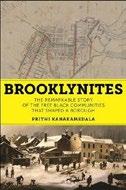
Vigorous history of a free Black community in Brooklyn and its contributions to the making of modern New York. In the late 18th and 19th centuries, writes Bronx Community College professor Kanakamedala, Black people constituted a large percentage of the population of Brooklyn, then an independent city. Unlike Manhattan, most of the land around the settlement was agricultural, and many of those Blacks were enslaved as farm workers. Even after their “gradual emancipation”—a charged term that speaks to the fact that it took three full decades after the end of the American Revolution for New York to end slavery—the Black workers of Brooklyn were confined to manual labor as “blacksmiths, boot blacks, cartmen, dock workers, general laborers, and whitewashers.” Some free Black people formed communities away from Brooklyn itself, places now enfolded by Williamsburg, Vinegar Hill, DUMBO, and other locales. Brooklyn proper also saw the formation of urban villages that were “part of a sophisticated Northern anti-slavery space rooted in, and integral to, Brooklyn’s own steady growth.” These communities were the sites of sui generis public libraries, schools, churches, and other institutions that resisted the structural racism of the era. Examining archival records and focusing on several Black families, and especially
Black women, Kanakamedala charts changes in that community over the decades, with Brooklyn serving as a key transit point in the Underground Railroad network that was “by no means, a bastion of liberty.…But it did offer pockets of safety and refuge to its resident free Black communities— anchored by Weeksville— and to others seeking freedom in the North.”
Brooklyn was a center of military recruitment for Black troops during the Civil War and, during Reconstruction, a place from which several Black activists relocated to the South, “where they could help newly freed people.”
A solid contribution to the history of Black New York.
Kearns, Burt | Applause (271 pp.)
$32.95 | Oct. 1, 2024 | 9781493074211

The life of comic actor and original Three Stooges member Shemp Howard. Born Schmuel Horvitz in 1895 to Lithuanian Jewish immigrants, comic and character actor Shemp Howard was the elder brother of Three Stooges performers Moe and Curly (nonrelative Larry Fine was the third). But to most, he is known as the “fourth wheel” Stooge who replaced his popular brother Curly in 1946. Kearns argues—and argues, and argues—that despite being overshadowed by his brothers, Shemp was the Stooge’s “original star” who helped give birth to the comedy trio. As youths, both Shemp and his younger brother Moe demonstrated an aptitude for comedy, though it was Moe who, at age 11, struck out first into the world of acting. By 1910, they were a duo in a blackface act; when they managed to land gigs with both the RKO and Loew vaudeville circuits, they evaded the ban on double-booking by doing the same act in whiteface for
Loew. Invited onstage at a performance by Moe and fellow comedian Ted Healy in 1923, Shemp incited a “roughhouse ruckus,” and from then on, the act was known as “Ted Healy and His Stooges.” Shemp, Moe, and comedian Larry Fine eventually launched their own vaudeville act in 1930. They rejoined their old boss in 1932, but Shemp quit less than two weeks later after a financial dispute with Healy, to be replaced by Curly. Shemp began a solo acting career at Vitaphone studios in Brooklyn. In the 1940s, he landed significant character actor roles at major Hollywood studios and played alongside screen legends like Marlene Dietrich and John Wayne. Through extensive research that includes interviews with film experts, family members, and fellow celebrities, Kearns strives strenuously and mostly successfully to demonstrate that “underrated, underappreciated” Shemp Howard was a “comedic superlative” who deserves a place on the “Mount Rushmore of comedy” and a gifted character actor who was his own man before he was a Stooge. An illuminating, albeit slightly one-note, reworking of the Stooges mythology.
Lang, Nico | Abrams (272 pp.) | $30.00 Oct. 8, 2024 | 9781419773822
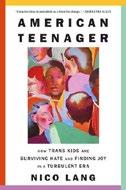
A tender and informative narrative told from the perspective of transgender and nonbinary teenagers. Prolific and award-winning LGBTQ+ reporter and editor Lang documents the lives of eight American teenagers in a deeply informative and moving chronicle of their constant fight for equal human rights. Drawing from conversations and hundreds of hours of interviews with nonbinary, transgender, and gender-nonconforming youth and
their respective families and communities, Lang invites the audience to hear from the sources themselves: kids who are experiencing what it means to be a trans individual in the U.S. today. Lang gives them the spotlight to tell their often difficult but also joyful experiences in the ongoing struggle for their identities and human rights. Emphasizing the importance of sharing their stories, Lang writes, “Every transgender child should get the chance to be spoiled rotten. America would be a better place if all its teenagers were so lucky.” Noting the multiple bills proposed to make trans individuals’ lives harder and more dangerous, Lang evokes a strong sense of urgency and importance in shifting the perspective on what it means to be a trans teenager in the current heated political climate. The right-wing narrative often depicts nonbinary and trans individuals as villains, when they are really just trying to make space for themselves and fight for their right to exist peacefully. Lang ends on a resonant and important note, “All of our lives are fuller when transgender kids have the freedom to grow up happy and healthy, to greet the universe on their own terms, to not only tell us who they are but also show us.”
A necessary and compassionate collection of stories that is a mustread for anyone looking to expand their horizons.
Lennon, John | Thames & Hudson (288 pp.) $60.00 | Sept. 24, 2024 | 9780500027783
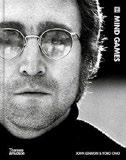
Lavishly illustrated volume chronicling Lennon and Ono’s years in New York, leading up to the recording of John’s 1973 album, Mind Games
The book is
organized largely along chronological lines, with photos, interviews, letters, and poems from each period. The photos are the weakest element, with too many minor variations of the same shots. There is a fair amount of material
on their political activism, a lot of it in response to Richard Nixon’s 1972 campaign for reelection. At first the couple associated with American radicals such as Abbie Hoffman and John Sinclair, but the attraction wore off when it became clear that they saw Lennon mainly as someone who could help draw attention to the movement. Lennon underwent a protracted battle to avoid deportation, nominally because of his 1970 London arrest for possession of marijuana, but just as likely because of his political activism. There is also a good bit of material on Lennon’s conversion to feminism and his work for women’s rights, on the mystical influences on his and Ono’s work, and on their lives together. The most interesting aspect of the book to students of Lennon’s music is undoubtedly the inclusion of lyrics from his songs of the era, usually accompanied on facing pages by the former Beatle’s handwritten drafts, with guitar chords indicated and his comments on the song’s inspiration. The final few pages are given up to interviews of the backing musicians and recording engineers who worked on the Mind Games album. A detailed look at an important chapter in the life of one of the iconic artists of the late 20th century.
Levy, Gideon | Verso (288 pp.) | $24.95 paper | Oct. 1, 2024 | 9781804297506

Israel’s assault on Gaza is a war without victories or victors, according to a respected journalist. The Middle East is a labyrinth for which no one has a map, and finding an escape path has become immensely more difficult since the Hamas attacks on Israel in October 2023. The Israeli counterassault on Gaza ratcheted conflict to a new level. Levy, an award-winning Israeli journalist, has long been a voice
of dissent about many aspects of Israeli policies, and his columns in the newspaper Haaretz are widely read. This book collects his columns from mid-2014 to mid-2024. Levy is clear about his love for Israel but acknowledges that the country has often failed to live up to its ideals in both its domestic politics and its treatment of the Palestinians. He was horrified by the ferocity of Hamas but says, “I cannot help but feel a profound shame over what my country is doing to Gaza.” He understands that Israelis wanted retribution but believes that an all-out invasion was morally and strategically wrong and turned Israel into “a pariah state.” Many of his recent columns deal with the innocent victims of Israel’s attacks, and some of the stories he tells are heart-rending. But it must be said that sometimes Levy’s idealism and compassion seem to blur into naïveté. Important as it is for a journalist to report accounts of atrocities, it’s possible to wonder whether endlessly doing so fuels the fire more than douses it. In fairness to Levy, it’s difficult to know where the point of balance lies. The Killing of Gaza is an important book, but readers hoping for a way to break the cycle of violence will not, unfortunately, find it here. Shines an important light on a brutal conflict, without pretending to have a resolution for it.
Liebenthal, Ryann | Dey Street/ HarperCollins (336 pp.) | $29.99 Sept. 10, 2024 | 9780358353966

A well-reasoned argument for remaking the federal student-loan system. Mother Jones writer Liebenthal, who confesses to carrying a heavy debt load herself, examines the system by which so many college students find themselves owing
thousands and even hundreds of thousands of dollars to loan agencies— and, too often, in jobs that offer little hope of ever paying them back. Liebenthal traces that system to the GI Bill, which paid out $7 billion after World War II for 2 million veterans to attend college; the economic productivity in tax revenue alone was $12 billion, so that the grants paid for themselves. Yet that’s not how lawmakers, and particularly conservatives, want to think of loans: they’re private and not collective goods, with education itself “a commodity delivering benefits to individuals, who must also bear its costs.” Hidden within the GI Bill system, then, Liebenthal asserts, are mousetrap conditions meant to disqualify aspirant minorities from those benefits. The results linger: today, she holds, “women hold two-thirds of all debt and earn 26 percent less than men do from their degrees,” while Black students have double the debt of whites. These are not evenly distributed: public schools are more burdened than private ones (only 3 percent of Harvard undergrads, she notes, take out loans). Liebenthal proposes a general amnesty, noting that if the loans were forgiven, the massive debt (more than $1.6 trillion by some measures) would be redirected into the economy as consumer spending, benefiting the whole of society. Moreover, she argues, “we need a massive new investment in public higher education,” with an emphasis on public : private schools such as Harvard and especially for-profit schools, she urges, should be ineligible for federal support.
A strong case for turning onerous student loans to more economically productive ends—and for rethinking them altogether.
Lipshutz, Jason | Hachette (368 pp.)
$30.00 | Oct. 1, 2024 | 9780306832505

A band beloved by millions and largely ignored by critics gets an admiring history from the senior director of music at Billboard Originally considered part of the nu metal scene that included Korn, Limp Bizkit, and Slipknot, Linkin Park was never actually part of any scene. A forgettable first gig in November 1997 at the Whisky a Go Go under the name Xero (the author describes them at that time as “a rap-rock rough sketch”) was one of their rare performances that was not a showcase for record company scouts. By the time their first album, Hybrid Theory, came out in 2000, most rock critics had already written them off as manufactured. But music company executive Jeff Blue took an interest in the band, mainly because guitarist Brad Delson was his intern, but also because he heard promise in the mixture of hip-hop and metal in rapper/composer Mike Shinoda’s bedroom demos. When lead singer Chester Bennington, with his emotional range from boy-band sweet to grunge-tinged furious, joined, the chemistry gelled for the monster hit-maker Linkin Park was to become. Lipshutz’s fondness for the band from his teenage years doesn’t blind him to their imperfections, but it puts him firmly in the fan camp. He does his best to impress with sales figures and details of the band’s creative processes. He argues that Bennington’s emotionally
Shines an important light on a brutal conflict, without pretending to have a resolution for it.
THE KILLING OF GAZA
raw lyrics, rooted in his troubled past and struggles with addiction (he died by suicide at age 41 in 2017), connected with fans viscerally, and he suggests they may have contributed to a sea change in attitudes about mental illness, both in rock and in society.
Probably won’t change many critics’ minds, but a must-have for Linkin Park fans.
Macintyre, Ben | Crown (352 pp.)
$30.49 | Sept. 10, 2024 | 9780593728093
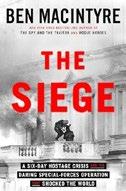
Fly-on-the-wall account of an Iranian embassy siege other than the one most Americans remember.
On April 30, 1980, six young Arab men, seeking independence for the Arab-majority Iranian province of Khuzestan, entered the Iranian embassy in London and seized more than two dozen hostages, including Britons. Macintyre turns all this into high drama: after all, as he notes, “Britain had never before faced an international hostage-taking incident on this scale, and the siege changed forever the way terrorism was perceived, and dealt with.” The hostage takers were new at the game, too, and the Iranian captives, representing the new government of the ayatollahs, were hapless, albeit McIntyre writes of the young ambassador, “His revolutionary credentials were impeccable, his religion extreme, and his devotion to Khomeini obsessive.” Both the Iranian government and the British government refused to negotiate, the Iranian authorities adding that the hostage takers were doubtless in the employ of the CIA. One captive was killed, after six days, to force some sort of resolution. It came, writes Macintyre, in the form of a counterterrorist attack, something that the leader of the captors
divined: “They are going to invade,” he said, promising that, if so, every hostage would be killed. Instead, a detachment of Special Air Service commandos breached the embassy and killed five of the six young Arabs; all the remaining hostages but one survived. In the end, Macintyre writes, the SAS action “cemented Margaret Thatcher’s reputation as an iron-willed leader,” which was further bolstered by Britain’s victory in the Falklands War shortly thereafter. McIntyre makes a good case in closing for considering the hostage crisis the opening shots of the eight-year Iraq-Iran War, an appalling bloodletting in which more than a million soldiers died.
A capable work of true-crime writing that connects many subsequent geopolitical dots.
Magruder, James | Yale Univ. (400 pp.) $60.00 | Sept. 24, 2024 | 9780300215007
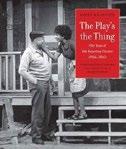
A n opportunity to go behind the scenes—literally— at a groundbreaking, standard-setting theatrical institution.
As Rocco Landesman points out in his introduction, playwright, dramaturg, and fiction writer Magruder takes on the formidable challenge of writing “a history of something ephemeral, that exists for a moment then disappears into the ether”—that would be the roughly 200 productions at the Yale Repertory Theater, from Dynamite Tonite in 1966 to Scenes From Court Life; or the whipping boy and his prince in 2016, with a procession of dramatis personae including Meryl Streep, Paul Giamatti, Tony Shalhoub, James Earl Jones, Frances McDormand, Dianne Wiest, and many more. Using breathtaking still photos from the productions (you could buy this book just for the pictures), plus
127 interviews, 40 linear feet of scrapbooks, and other archival odds and ends (some featured in entertaining sidebars of their own), Magruder (Yale MA ’84, MFA ’88, DFA ’92) sets himself a Horatian goal, “to instruct and delight,” and does he ever. Bringing his encyclopedic knowledge, his delightful vocabulary, and his witty, exquisitely wrought prose style to bear, Magruder offers a wide-ranging class not just in Yale Rep, but in the history and culture of the theater. He ranges from the role of Luigi Pirandello as the granddaddy of fourth-wall-breaking metatheatrical flourishes to the importance of the American Family Play, branching from Arthur Miller and Eugene O’Neill through Sam Shepard to fascinating-sounding modern productions called War and Lydia. In an aside, he scorns British director Trevor Nunn as the man responsible for what Magruder terms “the global contagion of Cats and Les Misérables.” Often his sentences contain so many layers of information and analysis that how much you learn from them depends only on how much time you have to spend with them, e.g., “As with Stoppard or Kushner or Churchill, a well-done Shaw can leave an audience giddy with thought.” We are left giddy with thought.
Makary, Marty | Bloomsbury (288 pp.)
$28.99 | Sept. 10, 2024 | 9781639735310
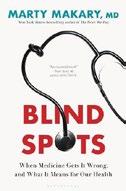
The misguided prevalence of “gut feeling” in medical dogma. In his follow-up to The Price We Pay (2019), Makary, a public health researcher and professor at Johns Hopkins School of Medicine, elaborates on the enduring misconceptions plaguing modern medicine in terms of research breakthroughs that have been largely underappreciated, overlooked, or simply ignored in a
Blueprint for a balanced, sustainable business model, backed by solid research and relevant case studies.
THE EMPLOYEE ADVANTAGE
clinical setting. He cites several recent studies to bolster his position, such as a 16,608-woman study on menopausal hormone replacement therapy concluding that it causes breast cancer development. Despite the lack of evidentiary support for this conclusion, the study’s authors continue to tout it to clinicians while overlooking HRT’s considerable benefits. The overuse of prescribed antibiotics for infections is juxtaposed against research citing the microbiome imbalance they cause by obliterating beneficial bacterium. Makary also discusses the medical groupthink about dietary cholesterol, ovarian cancer, silicone breast implants, and complicated childbirths, among others. Presenting a fascinating study on peanut anaphylaxis, Makary rails against the American Academy of Pediatrics’ recommendation that children avoid the nuts altogether instead of considering research indicating that reintroducing small doses of peanuts (in conjunction with powerful immune suppressants) can actually prove curative. He pauses midway through the book to lucidly examine how the mechanisms of the human mind naturally resist innovative ideas and approaches. As a public health advocate, Makary is simultaneously dazzled by the sophistication of modern medicine and alarmed by the medical industry’s stubborn reluctance to adapt and evolve in the midst of supportive research meant to challenge interventional therapies and procedures. The author’s critical eye is well suited to this clinically sound report appealing for closer scrutiny and a redesigning of the medical establishment, and he coaches readers with or without clinical expertise to “ask for the underlying evidence or
rationale to support a health recommendation.”
An eye-opening look at how the American medical industry’s rigidity has stunted its reliability.
McMahon, Sharon | Thesis/Penguin (320 pp.)
$32.00 | Sept. 24, 2024 | 9780593541678

A survey of footnote-level historical figures who exemplify McMahon’s declaration, “the best Americans are not always famous.”
“America’s Government Teacher,” as McMahon brands herself, turns out to be a reliable guide into lesser-known corners of history as well. Her initial specimen is Gouverneur Morris, a friend of Alexander Hamilton and signer of the Declaration of Independence who is unjustly forgotten in our day, McMahon holds. Morris, after all, wrote the preamble to the Constitution (“We the people…”). Many more of McMahon’s subjects were never known to history in the first place: the enslaved Clara Brown, for instance, who moved westward to frontier Colorado and built a tidy fortune that, alas, did not outlive her. McMahon calls on the clothier Levi Strauss, who added rivets to jeans and then “marketed the heck out of them” as “the only kind made by white labor” (though enslaved people grew the cotton and indigo). The
mid-19th-century president James Buchanan openly lived with a man who “helped found a city you may have heard of because of the Civil Rights movement: Selma, Alabama.” Katherine Lee Bates, author of “America the Beautiful,” also had a same-sex partner; as a couple, they “were obviously in love and ‘together’ together.” McMahon tips her hat to Daniel Inouye, the Hawaiian senator who, in the era of Japanese American imprisonment during World War II, distinguished himself as a battlefield hero. The author is generally nonsectarian, though she gets in a subtle dig or two at Trump, denounces the “moral panic” that is the enemy of progress, and defends critical race theory. Her carefully researched book is just plain fun to read, especially at moments such as her takedown of those who hold that the Civil War was about states’ rights: “Calmly look them in the eye, and ask, politely and inquisitively, what exactly the states wanted the ‘right’ to do?”
An accessible, cheerful, and affectionate portrait of Americans who, though little known, made a difference.
Meier, Stephan | PublicAffairs (288 pp.)
$30.00 | Oct. 15, 2024 | 9781541703889
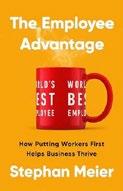
Employees should be seen as investments rather than costs, argues a professor at Columbia Business School. The business mantra of “putting customers first” has been around long enough for its weaknesses to show, states Meier, whose academic specialty is the intersection of behavioral economics and corporate strategy; the emphasis on customers has blinded many leaders to the value of their own employees. Meier emphasizes that he is not opposed to good customer service but believes that it is both possible and necessary for companies to broaden the focus to include their employees. If employees feel they are being treated
mainly as costs to be squeezed, their dissatisfaction will eventually impact customers and therefore profits. Meier provides many examples of disenchanted employees doing the minimum possible in order to collect the paycheck while avoiding any innovations, new thinking, or special effort. Some will even make anonymous posts on social media, which can seriously damage a company’s reputation. Conversely, Meier also examines cases in which companies have benefited from proper engagement with employees. His research suggests that workers want training and advancement possibilities, recognition and reward for achievements, and the opportunity to interact with colleagues. Many companies know more about their customers than their employees, he notes, but the tools used to gather information on customers can easily be adapted to improve employee communication. Meier acknowledges that some companies are profitable even though they treat their employees with disdain, but he identifies them as organizations with little public interface. Throughout, he offers lessons for leaders at every level in an organization, expressed in plain, accessible language.
Blueprint for a balanced, sustainable business model, backed by solid research and relevant case studies.
Mohseni, Saad & Jenna Krajeski HarperCollins (320 pp.) | $32.00 Sept. 24, 2024 | 9780063299801
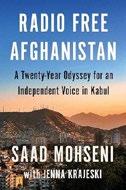
The founder of an intrepid Afghan media company recalls its 20-year run as a source of independent news. Mohseni was part of the Afghan diaspora fleeing Afghanistan after a communist coup d’etat in 1978. His father, a diplomat, moved the family to Japan, then to Australia, where the author grew up and became a banker before
venturing back to his native country after the fall of the Taliban regime in 2002. He and his siblings hit on the daring idea to start one of the first independent radio stations in Afghanistan; they called it Arman, the Dari word for hope. Its launch in spring 2003 was followed by TOLO TV the next year. The parent company, which they named Moby, hired women for the first time, offered content of public interest, and aired entertainment that had been previously banned, all the while navigating the tricky shoals of growing corruption and sectarian violence in the country. Their forthright news coverage earned them harassment from the Hamid Karzai government numerous times, including a 2007 police raid ordered by the attorney general. In 2008 the author brought on board Tom Freston, formerly of MTV and Viacom. His connections, and the financial backing of Rupert Murdoch, spurred Moby to international heights. However, the “brazenly fraudulent election” that brought Ashraf Ghani to power as president in 2014 eroded any hope of democracy. In 2016 a Taliban attack on the Moby offices killed seven employees. America’s withdrawal and the return to power of the second Taliban regime in 2021 spelled the demise of many of the shows Mohseni and company had created, and he writes with sorrow about the loss of gifted colleagues and their programming. He was out of town when Kabul fell and hasn’t returned since. A moving account of light brought to the Afghan audience, tragically eclipsed.
Across Time
Molesworth, Helen | Ballantine (336 pp.) $30.00 | Sept. 17, 2024 | 9780593500880
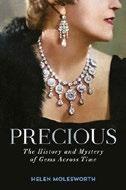
A brightly entertaining natural and cultural history of gemstones and the worlds they contain. The title may bring to mind
Tolkien’s ring-obsessed Gollum, and indeed there are a few grasping, jewel-smitten characters in Molesworth’s survey. The book, she writes, was born of her long career in gemology, inspired by a remark her father made when she confessed that she wanted to work in neither the corporate world nor academia: “Hair, makeup, clothes, jewelry. Pick one.” She chose wisely, for, as her book recounts, she’s done a little bit of everything, serving as curator, cataloger, auctioneer, appraiser, and all-around scholar, working in a field that is “almost a perfect synthesis of every subject under the sun.” Sometimes her enthusiasm builds to a geekfest, as when, in a swoon of gemological language, she recounts all the different jades that aren’t really jades: “a mishmash of tough, translucent-to-opaque greenish materials such as serpentine, bowenite, amazonite, marble, quartzite, and chrysoprase.” In fact, as she goes on to note, what is classified today as “true jade” is either nephrite or jadeite. There’s a lively smattering of cocktail-party-worthy trivia on every page: the origins of the “eternity ring,” courtesy of a marketing genius at De Beers who had to figure out what to do with a glut of small diamonds introduced from Siberian mines in the 1950s; the history of the massive tanzanite ring that Beyoncé wore after her first child was born, as well as the tsavorite ring Jay-Z gave her, “now in the Victoria and Albert Museum in London.” A highlight in a book full of them is Molesworth’s considered judgment that the references to rubies in the Old Testament “were almost certainly to garnet,” a little stone that earns a little more love thanks to her generous assessment of its significance. An overstuffed, endlessly interesting treat for anyone interested in any aspect of jewels.

For a history of jewelry, visit Kirkus online.
Monaghan, Shannon | Viking (400 pp.)
$32.00 | Sept. 10, 2024 | 9780593491225
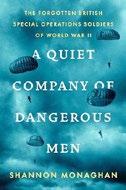
Eventful study of four British agents who waged war first on the Axis and then on the Soviet bloc. Fans of espionage fiction might, well, smile to see that one of military historian Monaghan’s four heroes is named David Smiley. Her other three heroes, Julian Amery, Billy McLean, and Peter Kemp, enjoyed long careers making mischief behind enemy lines as they “worked with some of the most elite special-operations units of their time.” They lived out a James Bond–ish existence—and indeed had access to lethal gear from a secret lab, “the real-life inspiration behind Q’s gadget shop,” complete with exploding pen. The four cut their teeth fighting the Italians in the pre–World War II invasion of Ethiopia and then in Albania, a place that, she writes memorably, “looks as though a small, angry child had balled up a piece of stiff felt and thrown it down on the floor.” Their actions in the latter were critical, for the Germans and Italians had to commit a full 30 divisions to the Balkans that otherwise might have turned the balance on the Eastern Front. Monaghan capably paints a fraught political backdrop, including the fact that Amery’s brother was a full-tilt fascist who was hanged for treason, as well as the dangers imposed by the treasonous behavior of another player in the great game, Kim Philby. She turns in some interesting historical tidbits along the way, too, such as the de facto collaboration of the victorious Allies and the Japanese in Indochina. In closing, she asks whether her hot and cold warriors won, noting, “There is a reason why so many of the places in which they operated remain conflict zones to this day.”
A well-told tale that sets the fictional worlds of Ian Fleming and John le Carré in real-life perspective.
Moore, Louis | PublicAffairs (320 pp.)
$30.00 | Sept. 24, 2024 | 9781541705098

A history of Black athletes who crossed the color line that kept them from playing quarterback.
“Being a black quarterback,” wrote a Los Angeles Times sports columnist, “is like being a member of the bomb squad.” Make a mistake, in other words, and Boom! you’re done. In 1979, an era in which, writes Moore, “it was still a foreign concept that Black men could be the field generals,” two Black players set the field on fire: the Chicago Bears’ Vince Evans, the fastest quarterback in the league, and T Doug Williams, a man with the best arm in the game but “the wrong paint job” who played for several teams before becoming a coach. They were the only two starters; before them, coaches rerouted Black players with quarterback skills to play as running backs, with the assumption that, regardless of speed and strength, Blacks lacked the intelligence to helm a team. Indeed, for decades “all the so-called thinking positions” in football were the province of white players only. When Williams and Evans faced off at Soldier Field on September 30, 1979, it was rightly seen as a historic moment. Moore looks back in time at the lineage of Black players who by rights should have preceded them (who knew that Jesse Jackson played quarterback for his HBCU?) and notes a few good-faith efforts in the mid-1970s, as when, for instance, Joe Gilliam started for the Steelers ahead of Terry Bradshaw. Discerning social critics pointed out that the question wasn’t whether Black players were ready for the slot but whether football was ready for them. The answer came with Evans and Williams and then with their many successors, including Patrick Mahomes and Jalen
Hurts who, astonishingly, as late as 2023 were the first Black QBs to face off in a Super Bowl.
A piercing look at racial politics on the gridiron.
Kirkus Star
Nenquimo, Nemonte & Mitch Anderson
Abrams (368 pp.) | $28.00 Sept. 17, 2024 | 9781419763779

A young woman’s life among her people in the Ecuadorian rainforest, battling the onslaught of bulldozers and oil wells. It has long been an anthropological desideratum to describe the world from “the native’s point of view.” Nenquimo, a member of the Waorani people of Amazonian Ecuador, does far more: her memoir reveals her world directly through her eyes, albeit as rendered into English by her American husband while taking pains to assure readers that “these are her memories.” Some of those memories are terrible; much of what she has seen, brutal. Her earliest encounter with non-Waorani people is with the earthly representatives of “Wengongi, the white man’s big spirit in the sky,” Christians whom Waorani warriors would once have speared to death but who now accuse the village’s teenage boys of “being influenced by the communists” simply because they are skeptical about an oil company drilling on Waorani land. Against these values are posed a Waorani elder’s assurance that Nenquimo’s ailing brother would grow up to be a brave hunter, acting as an intermediary between the human world and the world of the deceased ancestors, who “roam in these woods” as spirit jaguars. A stint in a missionary school in Quito—“You’re here to become God’s servant. Not another pregnant jungle girl”—doesn’t rid her of carefully guarded beliefs in the old ways. On returning to discover that her village is being besieged by invaders—foresters,
cattlemen, and especially all-destructive oil companies—she becomes a fierce defender of her people, taking their arguments against dispossession up a steep legal ladder to victory: “We had protected a half-million acres of our rainforest. And we had opened a legal pathway, a bright trail, that other Indigenous nations could follow to protect their territories as well.”
An essential memoir of Indigenous resistance to economic subjugation and cultural extinction.
O’Reilly, Bill; Martin Dugard
St. Martin’s (432 pp.) | $35.00 Sept. 10, 2024 | 9781250346414

A shallow dive into the POTUS pool. George Washington enjoyed snacking on “nuts, cheese, and bread.”
Omnivorous Bill Clinton “openly admits a fondness for enchiladas and jalapeño cheeseburgers.” Thomas Jefferson “prefers a great assortment of vegetables with a small portion of meat.” Of Trump’s devotion to hamberders we learn nothing, but George Bush dug a lunchtime BLT, Barack Obama a breakfast of “eggs, potatoes, and wheat toast,” Abraham Lincoln a hard-boiled egg, Richard Nixon “cottage cheese doused in ketchup.” For a book not explicitly called “Favorite Foods of the Presidents,” there’s a lot of attention to our leaders’ culinary leanings. Apart from that, fallen Fox News star O’Reilly and sidekick Dugard skim over the presidents’ histories for a few pages apiece, always taking care to state the well known: “Harry S. Truman has no middle name.” “Abraham Lincoln does not live to see the party. Six days earlier [sic], he is shot in the head while watching a play with his wife in a place called Ford’s Theater.” “The safety nets [Franklin] Roosevelt put into place protect vulnerable Americans to this day.” Following these cursory biographies, the authors
rank the presidents: Washington and Lincoln were great, and FDR too, even if “he enabled Stalin and the Cold War” (a remark with which historians may differ). Nixon is remembered as corrupt: “That may not be fair, but history often isn’t.”
(The possibility that Nixon actually was corrupt is, unsurprisingly, not discussed.) Millard Fillmore was in over his head and “failed to grasp the growing danger America was facing from a slavery-driven insurrection.” And so on.
For those in need of a handy checklist of who was who in the White House, here it is.
Payne, Keith | Viking (272 pp.) | $29.00 Oct. 1, 2024 | 9780593491942
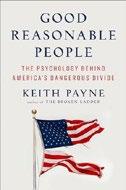
An examination of the psychology of our increasing political division.
“This book is not about politicians or political strategists or party organizations. It is about ordinary people making sense of their world in the best way they know how to,” social psychologist Payne asserts in the opening pages. He stays true to this promise, beginning first with his own upbringing. Raised in a house off the highway in Kentucky by working-class, Christian parents, his childhood was characterized by conservative leanings. When Payne left for college, his dad told him he’d better not return a “long-haired hippie.” But after only three months away, Payne began to stray from his family’s beliefs, returning with hoop earrings and untrimmed hair—things his father chose not to mention. “So many families like mine have reached a brittle peace in recent years,” he writes, “holding their breath, limiting their conversations to the weather and sports and children”—but why? How did our differences in political beliefs gain so much animosity in recent years? Payne uses psychology to demonstrate that people aren’t fundamentally different from one another. Belying the
stereotype that liberals are inherently more open-minded and conservatives more dogmatic, beliefs are a product of circumstance. Given the option, we all defend our own viewpoints before considering others. Cognitive research shows that “all persuasion is self persuasion,” as we confirm what we already suspected. And those viewpoints are largely from chance elements of our upbringing and other life encounters. Interesting, compassionate, and ultimately a bridge between those too often depicted as opposites, this book provides background for why we believe what we do and what makes us stick to it. Remarkably accessible despite its academic nature and rigorous research, it opens dialogue about how we can consider both sides as people, not concepts.
Compelling, eye-opening research that humanizes political discord and encourages understanding and compassion.
Pishko, Jessica | Dutton (352 pp.) $32.00 | Sept. 17, 2024 | 9780593471319
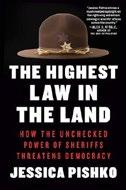
A damning exposé of the rise of “constitutional sheriffs,” a law unto themselves. Read investigative journalist Pishko’s carefully reported history, and you’ll appreciate how spot-on Jon Hamm’s evilly unlawful lawman Roy Tillman was in the 2023-24 season of the drama Fargo. One of Pishko’s archetypes is Arizona sheriff Mark Lamb, who proclaims to his constituents, “Sheriffs are the last line of defense in this country. We don’t work for anybody but you.” But that’s not really true: whether directly or not, and whether knowingly or not, he works for a network of extremist right-wing groups, most based in the West and grounded in the John Birch Society and

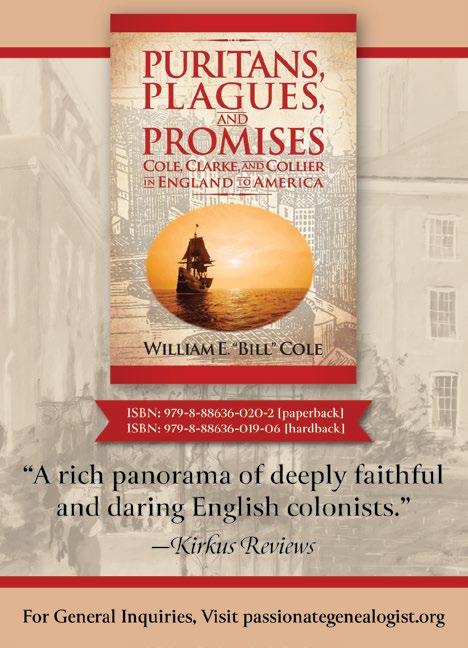
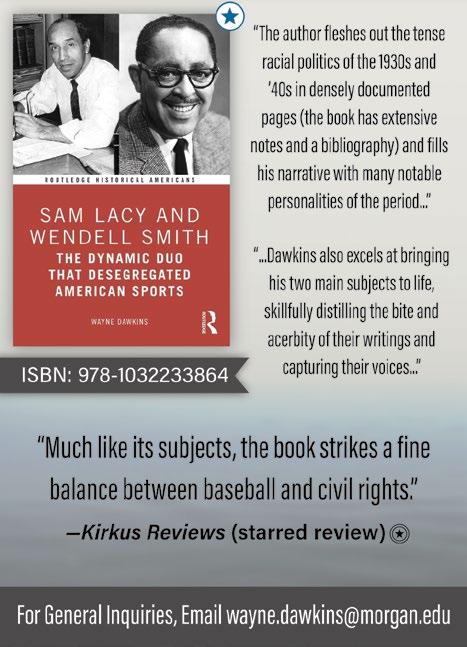
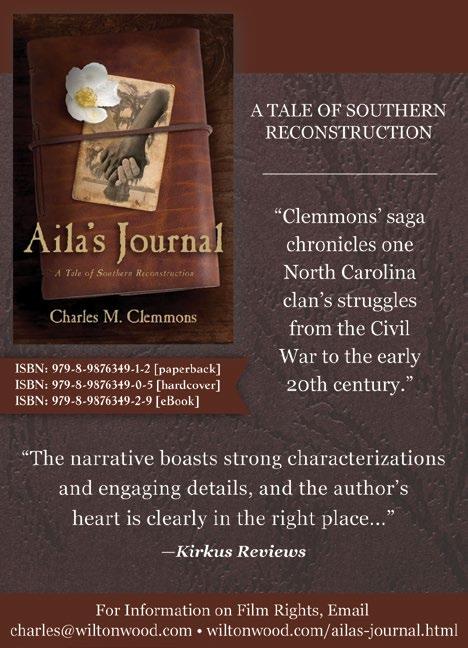


EDITORS’ PICKS:
Age 16 by Rosena Fung (Annick Press)
That Always Happens Sometimes by Kiley Frank, illus. by K-Fai Steele (Knopf)
A Refiner’s Fire by Donna Leon (Atlantic Monthly)
THANKS TO OUR SPONSORS:
Resilient: Achieving the American Dream by Lenny Bazemore
The Buddha and the Bee by Cory Mortensen
Isosceles by Scott R. Caseley
The Good Driver by Gary A. James
Fully Booked is produced by Cabel Adkins Audio and Megan Labrise.

Stacey D’Erasmo ponders artistry and longevity in The Long Run BY MEGAN
LABRISE
On this episode of Fully Booked , Stacey D’Erasmo discusses The Long Run: A Creative Inquiry (Graywolf, July 9), an essay collection that takes on a timeless question for artists: “How do we keep doing this—making art?” In a series of interviews with dancers, writers, sculptors, and other long-standing creatives, she explores a number of potential answers. “A rich meditation on the artist’s life and work over time,” Kirkus writes in a starred review.
D’Erasmo is the author of two nonfiction books and five novels, including Wonderland and The Complicities, a 2022 finalist for the Joyce Carol Oates Prize. She co-directs and teaches in the Creative Writing program at Fordham University.
Here’s a bit more from our review of The Long Run :
“‘In my own long run, one of the main things I have always reached for to sustain me is company,’ [D’Erasmo] writes. ‘The company of lovers. The company of friends. The company of other writers and artists, living and dead.’ D’Erasmo’s essays invite readers to be part of that company, to find themselves in her pages, and, in turn, to invite other artists into the conversation. Though each essay stems from an artist the author interviewed, D’Erasmo’s associative genius takes her into new and surprising territory.…[She] explores not just what it means to have a long career in the arts, but what it means to be an artist, to be queer, and to be a citizen of the Earth, making this book a unique contribution to the canon of work about the life of an artist. Artists of all kinds will find inspiration and good company within these thoughtful essays.”



The Long Run: A Creative Inquiry D’Erasmo, Stacey Graywolf | 192 pp. | $17.00 July 9, 2024 | 9781644452929
D’Erasmo and I discuss The Long Run’ s main inquiry: How do we keep making art over time? She discloses that she’s been thinking about this subject for a long time—publicly, since 2010, with an essay in the Rumpus . We discuss her perspective on the matter then versus in 2024. We talk about a few of the artists she interviewed for The Long Run , including dancer Valda Setterfield, who gave her the most access, and Pulitzer Prize–winning composer Tania León. We consider whether great artists must be charismatic, what audiences want from art, whether there’s a wrong way to read this book, and much more.
Then editors Laura Simeon, Mahnaz Dar, and Laurie Muchnick share their top picks in books for the week.
Editor-at-large Megan Labrise hosts the Fully Booked podcast.
its offshoots, “who all believed that the county sheriff was the only legitimate law enforcement.” Ironically, Pishko adds, these groups “were often in conflict with law enforcement on federal, state, and local levels”; they brought us Waco, the Cliven Bundy ranch standoff, Ruby Ridge, and other such confrontations, a ll born of an “originalist” reading of the Constitution that holds that the county is the fundamental building block of American political organization and that the sheriff is the moral equivalent of its feudal lord. The movement has lately been fueled by the populist rage that whirls around in the Republican Party of Donald Trump. Pishko reports that sheriffs do indeed have those lordly powers, and in most instances they report to no one. Although the “constitutional sheriffs” are a minority, sheriffs lean to the right almost everywhere, especially in the West, and are drawn to Trumpism because they “sympathized with [Trump’s] overt opposition to immigration, his dalliance with white supremacists, and his stalwart defense of the Second Amendment,” all red-meat issues. Pishko’s proposed remedy is controversial but well defended: “Eliminate the institution altogether.”
A fluent, well-reasoned contribution to the movement to reform policing in America.
Popova, Maria | Illus. by Ofra Amit Storey Publishing (112 pp.) | $22.00 Oct. 1, 2024 | 9781635868838

A fluent, well-reasoned contribution to the movement to reform policing in America.
Essayist and cultural critic
Popova collaborates with an award-winning illustrator to explore how poetry and science offer interconnected ways of “knowing the world more intimately and loving it more deeply.”
With its emphasis on emotion and feeling, poetry would at first seem the polar opposite of science, an endeavor that seeks to understand “the fundamental nature of reality.” But for Popova, the two are closely related—if not intertwined—in their shared preoccupation with the search for truth. In this book, she creates a genre-defying literary and visual experience for curious minds. Each section centers on stories taken from the history of science, which Popova links to poems by the likes of Maya Angelou, Diane Ackerman, and Sylvia Plath. In “Flowers and the Birth of Ecology,” for example, she muses on the improbable rise of flowers in the Cretaceous era and the color and life they brought to the planet. The fruits—and specifically, the sugars in the fruits—that evolved with the flowers gave rise to mammals. Among the new species to emerge were the ancestors of the humans who would probe the workings of nature. One, German marine biologist Ernst Haeckel, would coin the term ecology. Popova follows this essay with “Bloom,” a poem by Haeckel’s 19th-century contemporary Emily Dickinson that celebrates the ecological interdependence of insects and flowers. Popova adds drama to this and every other essay/poetry pairing through the addition of bold yet delicately poetic artwork created by co-author Amit. The result is a thought-provoking, aesthetically stunning volume that will appeal to a broad range of readers. A feast of stories, ideas, and beauty for the mind and heart.

Ramos, Paola | Pantheon (256 pp.)
$28.00 | Sept. 24, 2024 | 9780593701362

A piercing look at the phenomenon of Latino right-wing extremism—not new, but ever more pronounced. It defies logic, suggests Vice News/MSNBC correspondent Ramos, that Latinos should be found among the ranks of the Proud Boys and other far-right groups, but there they are. In the wake of the El Paso Walmart mass shooting of 2019, she writes, “it was so clear in my mind that Latinos’ common enemy was the anti-immigrant, white nationalist voice.” And yet, there was the likes of Enrique Tarrio, who, though of at least 40 percent African origin, “had turned into one of the far right’s most ardent spokespersons.” Ramos identifies three cultural strains that contribute to Latinos’ prominence in the ranks of the white supremacist/right-wing/nationalist movement. The first strain is tribalism, the need to identify with a group and, in doing so, sometimes to stand in opposition to another group, presumably inferior to one’s own; while not exactly a case of Stockholm syndrome, somehow the white nationalists’ fear of non-whites “replacing” them has become part of the political baggage of a sizable number of Latinos, most but by far not all young men. The quest to become “real Americans,” Ramos hazards, “could be increasingly driving some Latinos toward extreme nativism, for there is nothing more nationalistic than making
immigrants, a sworn enemy of many white Americans, your enemy as well.” Another aspect is traditionalism, which reinforces leanings toward stances such as Christian nationalism and antiLGBTQ+ activism; still another is the trauma of racism and its poisonous, ego-destroying effects. While decrying the result, Ramos suggests that only when Latinos embrace “both the beauty and the darkness of our roots” will the population, by then the demographic majority—sometime around the year 2045, she adds hopefully—become self-confident, independent, and even “liberated.” A smart and empathetic analysis that seeks to understand, but not to condone.
Robertson, Aaron | Farrar, Straus and Giroux (400 pp.) | $30.00 Oct. 1, 2024 | 9780374604981
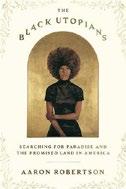
Inventing an ideal. Translator, editor, and essayist Robertson makes his book debut with an informative history of Black Christian Nationalism, an ambitious utopian experiment begun in 1967 by radical activist pastor Albert Cleage Jr. Predicated on “the historic truth that Jesus was the Black Messiah,” Cleage called his church The Shrine of the Black Madonna; its central image was a startling mural of a Black Madonna, painted by iconoclastic artist Glanton Dowdell. Under Cleage’s leadership, the shrine served as a cultural center and the launching place for a larger mission for Blacks to take control of institutions that had been oppressing them. By 1971, Robertson reports, “the Shrine’s agricultural, technical, and manufacturing (ATM) program was conceived so that the Black Christian
Nationalists could one day grow and can their own food, train their own corps of construction, electrical, and plumbing specialists, and provide resources to meet whatever unforeseen needs would one day arise.” Interwoven with the eventful life stories of Cleage and Dowdell are nine letters written by Robertson’s father, Dorian, who had been in prison for robbery for ten years as his son grew up. As he reflects on the circumstances that led to his imprisonment, and on God, freedom, and family, Dorian exemplifies a man “born into a land of evil and violence,” depressed and alienated. He was precisely the kind of man to benefit from Cleage’s vision of a New Black World, “where evictions did not happen, where there were few worries, no social disorganization, no isolation, no abuse of women, no abandonment of children, no bad schools, no diseased spirits.” Those ideals, Robertson finds, continue to inform many recently established intentional communities that prioritize the care and dignity of people of color.
A fresh perspective on Black history.
Rosenblatt, Roger | Illus. by Fred Newman San Diego State Univ. (112 pp.) | $21.95 paper | Sept. 1, 2024 | 9781938537394

A series of short, linked meditations from a life winding down.
After a successful outing deploying a similar structure to illuminate a similar theme in Cold Moon, Rosenblatt returns to an emptier well, here focusing his attention on the idea of wound as blessing. One of the things that made the previous book come to life was an abundance of childhood stories, but such engaging memoir material is mostly absent here. One of the only passages of this type offers the author’s recollections of ducking into his father’s office on the
way to a tennis match; he’d cut his thumb opening the tennis ball can and relied on Dad to stitch it up. “My father, born poor, who had struggled his way up to a dignified medical practice, in high school holding three jobs at once, now specializing in diseases of the lung, beheld his bleeding, happy-go-lucky tennis-playing son with the usual blend of annoyance and dismay.” Other passages muse on the titular piano washed up on a beach, trussed up and dragged away like a whale, or offer recollections of essays written during Rosenblatt’s tenure at Time magazine. The book also has a fair amount of free association that sounds like “morning pages” written under the influence of Natalie Goldberg. The lines “What did you do? / I loved” recur six times, and several entries are devoted to Rumi’s overexposed quote about the wound being the place where the light enters you, repurposed to better effect by Leonard Cohen. There are fewer than 100 pages of airily laid-out text; the volume is filled out with watercolors. They are lovely, but an account at the end of artist Fred Newman’s computer-assisted method took a bit of the magic away. This lightweight effort does not add much to the author’s acclaimed oeuvre.
Third Ear: Reflections on the Art
Rosner, Elizabeth | Counterpoint (240 pp.) $27.00 | Sept. 17, 2024 | 9781640095519
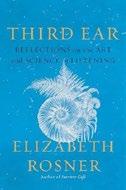
A gentle essay on the world’s soundscapes, many of which often go unheard. An elephant, writes novelist Rosner, gestates with its feet next to the lining of its mother’s womb, receiving information “at infrasonic levels inaccessible to our ears.” When it emerges, it listens with its feet as well as its ears. Human babies hear high-frequency sounds much more
Science and art meet in this eloquent study of the aural world around us.
THIRD EAR
clearly than do adults, which adults accommodate by heightening their vocal pitch when talking to them, which in turn “makes babies feel safe.” And who knew that a baby’s babbling might be a “way of processing stress”? Well, babies have plenty to be stressed about, and so too adults, one reason why it’s restful to read of Rosner’s immersion in a placid sea surrounded by a pod of chattering dolphins. She writes that she first became aware of the meanings of both words and silence in the speech of her multilingual parents, survivors of the Holocaust, who cloaked sensitive discussions in languages inaccessible to their children’s ears. “Maybe this prepared me for a life of eavesdropping on the world, listening with all of my senses, reaching toward sources of interconnection,” she writes. Without ever losing coherence, her narrative skips around to many topics: on one page she’s writing of the linguistic abilities of a beloved dog, which she’s convinced could pick out her toys by name, while on another she recalls a culture more revealed by a Cheyenne writer who would not “jump in” to a conversation, but instead waited to be invited to enter it, understanding that, that way, she would be heard. Horse whispering, telephones for calling the dearly departed, the terror of hearing loss in old age, “the holiness of birdsong”: This is a book packed with perceptions and revelations. Science and art meet in this eloquent study of the aural world around us.

Rubenstein, David M. | Simon & Schuster (496 pp.) | $30.99
Sept. 10, 2024 | 9781668067628

A look at the American presidency stressing the diversity of those who have held the office. Businessman and philanthropist Rubenstein’s new book follows in the path of his previous ones (The American Story, 2019, etc.): It’s a collection of interviews, this one with experts on U.S. presidents, plus four with former presidents. The goal, he writes in an introduction, “is to remind readers how truly different our presidents have been in their backgrounds, personalities, goals, and perspectives, and how these differences can really shape, for the good or bad, the country and the world.” It’s a fairly self-evident thesis, and for the most part the interviews yield little by way of surprises. In an interview with George Washington scholar Douglas Bradburn, Rubenstein asks questions such as, “Did he enjoy being president?” and “How did Washington die?” The questions sound even more contrived when Rubenstein inquires of historian Annette Gordon-Reed, regarding Thomas Jefferson and the enslaved Sally Hemings, “Why couldn’t they just get married? It was against the law?” He knows the answers, of course, so this rhetorical interview technique is jarring in print. Rubenstein fares better when he talks to actual presidents, including Bill Clinton (along with Hillary Rodham Clinton) and Joe Biden, but it would be a stretch to say
there’s much new in those either. Rubenstein comes across as genial and enthusiastic, but it’s unclear exactly whom this book is for, besides would-be presidential history buffs who are just now learning about the subject.
Entry-level sketches of former leaders of the free world: sometimes awkward, only occasionally interesting.
Schembari, Marian | Flatiron Books (272 pp.) | $28.99 Sept. 24, 2024 | 9781250895752

A woman’s self-discovery and acceptance as an autistic person. For years, the author thought she was weird. As a kid, she sucked her hair, spat on the floor, flared her nostrils, and displayed other tics. She also couldn’t read social cues, which made her few friends and led one assistant school principal to call her “the worst kid in fourth grade.” As an adult, others called Schembari lazy when she preferred staying home to going to a party and moody when she would scream or throw a chair in rage over a seemingly small problem. She consulted doctors and therapists who diagnosed her with a variety of disorders including “high sensitivity,” Tourette’s syndrome, and depression. But drugs left her feeling jittery or like a zombie, and no amount of writing in a gratitude journal helped ease the feeling that she was a square peg trying to fit into a round hole. She was 34 years old when she was finally diagnosed with autism spectrum disorder. And that knowledge freed her: “Learning that fact felt like crawling into a crisp hotel bed after a lifetime of sleeping upright in a barn.” Readers learn that autism is a highly heritable condition and can display differently in girls compared with boys. It can be expensive and difficult to diagnose, and it is still misunderstood. “People can’t be a little autistic or extremely autistic…a
spectrum is not a ranking of severity.” Rather, it’s “a collection of related neurological conditions, each one presenting differently depending on the person.” Schembari’s memoir, told in a sparkly, humorous, and personable way, makes the drier, more research-driven parts of the book engaging.
Personal experience combined with biomedical research shows the many facets of a still-evolving field.
Schneider, Rob | Center Street/ Hachette (288 pp.) | $30.00
Sept. 24, 2024 | 9781546007869

A conservativeleaning comedian and Saturday Night Live alum thunders about the loss of free speech in “woke” America.
“I am a traditional Liberal, which, apparently, makes me a right-wing fascist now!”
Schneider writes. When, for example, he spoke out against the Covid-19 vaccine mandates in 2021, he says, liberal media outlets made him out to be “dangerous,” but “no one in media dared call those Democrat vaccine skeptics antivaxxers like soon-to-be vice president and antivaxxer-while-Trump-is-president, Kamala Harris.” (Harris in fact said while campaigning that she wouldn’t necessarily trust Trump’s assurances about the rapidly developed vaccine but would trust a “credible” source that vouched it was safe.)
Schneider also found himself targeted for holding controversial opinions on transgender surgeries for children, which he likens to a radical form of gay conversion therapy except “at least ten thousand times worse.” He praises conservative Blacks such as SCOTUS member Clarence Thomas and economist Thomas Sowell, shaking his head because asking “inconvenient questions of the 2020s government” gets them branded as “race traitors.” The comedian suggests that for these and similar views on the “scamdemic” and the unnecessary
alarmism about global warming, he has become much like his stand-up idol, Lenny Bruce: a performer blackballed by mainstream late-night shows because “they don’t want an opposing point of view.” Schneider buttresses his views by citing historical events as examples of the government’s “sociopathic behavior,” such as the “Tuskegee Experiment,” in which the U.S. Public Health Service infected unsuspecting black men with syphilis for 40 years, and a CIA program that administered LSD “to unwitting subjects in social situations”—though it’s not clear what these cases have to do with the current federal government urging people to get vaccinated. “Dissent is democracy. Not allowing dissent is tyranny,” Schneider concludes. Readers need not care for his confrontational style to agree with that statement.
Provocative reading that will no doubt appeal to Schneider’s fans.
Skidelsky, Robert | Other Press (384 pp.) $29.99 | Sept. 24, 2024 | 9781590517970

Will technology liberate us, or further enslave us? That’s the big question underlying this treatise on machines and their discontents. British economist Skidelsky begins by revisiting John Maynard Keynes’ prognostication that our smart machinery would free us to work only three hours or so a day—then noting that, alas, it hasn’t worked out that way. In a rather scattershot look at how we’ve failed to free ourselves, Skidelsky serves up Marx, Mumford, and Marcuse, along with Toynbee, St. Augustine, Arendt, et al. Sometimes he sounds exactly the right note, as when he identifies the unfortunate Greek inventor Icarus as the poster boy for hubris, “the attempt by humans to usurp the place of the gods in the scheme
of life.” He is less convincing when he evokes pop culture, as when he calls Elon Musk “the Mad Max of the AI world.” (Mad Max was the good guy. If anything, Musk would probably self-identify as The Humungus.) Skidelsky rightly praises interdisciplinarity, but he’s at his best, if sometimes didactically so, when in his home fields of economics and history. On that ground, he writes interestingly of how Britain developed so rapidly as a tech nation because of both its non-predatory government (at least when not out gobbling up nations to build its empire) and its emphasis on property rights. He is less successful when on Jaron Lanier’s turf: the briar patches of AI and the philosophical implications of evolving machines. He may be too indulgent about the 1960s’ counterculture’s promise of the “transformation of human nature through sexual liberation,” though in closing the same sentence he hits on a hard truth: “Escape from the burden of work is open only to a tiny minority.” There’s good material here, but it takes burdensome work to get to it.
A mixed bag, more successful as historical description than cultural criticism.
Surya, Shirley & Aric Chen
Thames & Hudson (400 pp.) | $85.00
Sept. 10, 2024 | 9780500481028

A comprehensive monograph on the life and career of the esteemed Chinese American architect. I.M. Pei (1917-2019) significantly shaped 20th-century modern architecture. His innovative style merged modernist principles with geometric forms, seamlessly integrating contemporary structures into historic settings. This approach, combined with cultural sensitivity, solidified Pei’s position as one of architecture’s most influential figures. His notable works include the iconic glass pyramid at the Louvre in Paris, the East Building of the National Gallery of Art in Washington, D.C., and
the striking Bank of China Tower in Hong Kong. This deluxe, meticulously organized monograph, published in conjunction with an exhibition at Hong Kong’s M+ museum (June 29, 2024, to Jan. 4, 2025), showcases Pei’s extensive contributions and offers a deep dive into his influential legacy. Editors Surya, curator of design and architecture at M+, and Chen, artistic director of Rotterdam’s Het Nieuwe Instituut, have curated a rich selection of archival materials and commissioned essays that illuminate the breadth of Pei’s work. They structure the book around six defining themes, “each representing a direction or area of focus that remained remarkably consistent throughout his career.” These include Transcultural Foundations, Art and Civic Form, Material and Structural Innovation, and Regenerating Cultural and Historical Archetypes. Throughout, the editors emphasize Pei’s civic engagement and global perspective, writing, “He consistently addressed civic culture, the responsible and innovative use of materials and resources, and the place of a building in its surroundings.” Surya and Chen further note, “Throughout his life, Pei remained committed to a belief in speaking across cultures, contexts, and territories and in working together for an architecture that could be part of a global discussion as much as a local or national one.”
An absorbing visual feast celebrating an extraordinary and highly influential talent.
Kirkus Star
Vietnam War: A Military History
Wawro, Geoffrey | Basic Books (656 pp.)
$40.00 | Oct. 1, 2024 | 9781541606081

A treat for Disney fans and a revealing look inside the day-today workings of Big Entertainment.
DREAM CHASING
Military history of the Indochinese conflict, prioritizing politics and strategy over battlefield fireworks.
American anticommunists had long obsessed about Vietnam,
writes Wawro, director of the Military History Center at the University of North Texas and author of Quicksand: America’s Pursuit of Power in the Middle East. A communist-backed insurgency there had expelled French colonialists and threatened Vietnam’s southern half, which remained “free” after a 1954 treaty gave communists control of the north. President Eisenhower sent aid, President Kennedy added thousands of military advisers, and President Johnson sent fighting troops in 1965. It was no secret that South Vietnam’s ramshackle, corrupt, quasi-military government couldn’t get its act together. Unable to fix matters, America simply took over the war—a terrible policy, as Wawro emphasizes throughout. All too aware of China’s disastrous entry into the Korean War, Johnson refused to allow an invasion of North Vietnam and strictly limited bombing. Conservatives fumed (and still fume). In the South, Americans’ aggressive but ineffective “search and destroy” strategy inflicted severe casualties on Vietcong and North Vietnamese forces but even more on Vietnamese civilians, who made up 40% of the dead. In October 1968, with no victory in sight, opposition to the war increasing, and Richard Nixon (promising a secret peace plan) leading polls for the upcoming election, Johnson abruptly agreed to a withdrawal that conceded most of what Hanoi wanted. Wawro maintains that the war could have ended then if Nixon, in what was likely a treasonous act, hadn’t secretly persuaded South Vietnam’s president to refuse to cooperate. As a result, America “would fight on for four more years, condemn 28,000 more American soldiers to death, and end up getting the same deal that Johnson
was about to get.” Wawro’s contempt for generations of misguided policies leaps off the page in this worthy rival to Max Hastings’ brilliant Vietnam: An Epic Tragedy. Among the best Vietnam War histories, and just as painful as the others.
Weis, Bob | Disney Editions (448 pp.)
$29.99 | Sept. 24, 2024 | 9781368101035
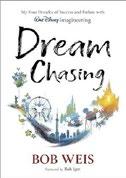
A longtime Disney Imagineer takes us behind the curtains at the Magic Kingdom. Weis, a five-decade Disney employee, was initially hired as a Disneyland “outdoor ice cream and popcorn vendor,” despite the fact that he was a talented set builder trained in both drama and architecture. On the job, he learned to pay attention to details: “As dry as they seem, popcorn kernels contain 14 percent water. As the kernel is heated to a high enough temperature, this water transforms into steam.” That gig didn’t last, and Weis wandered off, only to return as a coordinator on “a top secret project called Tokyo Disneyland.” Whereas there were just two Disney theme parks when he started off in the 1970s, half a century later there were a dozen. Each of the new parks, most of which he had roles in developing while climbing the corporate ladder, had its own problems, and each had to conform with Disney’s mores
while offering its own brand of magic. Weis writes in great but not overwhelming detail on all such matters. We learn that Disneyland Paris was built to a plan B that “was smaller and cheaper and lacked both charm and Disney warmth” until it was overhauled. Disneyland Shanghai had to lose a few trademark features: in a country full of high-speed trains to put American rail to shame, it didn’t add much to have a slow-moving steam locomotive poking around the place. Weis provides notes on such matters as how to direct traffic flow inside a park and how to leverage the latest technology to yield the greatest wow experiences for visitors—all of which were deeply compromised when Covid-19 came along, requiring a thorough cultural transformation in the face of a severe blow to corporate income.
A treat for Disney fans and a revealing look inside the day-to-day workings of Big Entertainment.
Kirkus Star
Witt, Emily | Pantheon (272 pp.) | $27.00 Sept. 17, 2024 | 9780593317648
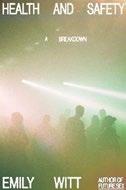
Sardonic memoir of sex, drugs, and rock ’n’ roll in the time of Trump. New Yorker staff writer Witt opens by wondering aloud what a given day in 2016 might hold: a writing assignment, perhaps, or yet another mass shooting, or “something…that would indicate the arrival of a new historical epoch, a sign that we were living in an era of meaning and purpose that would be remembered for many decades to come.” Alas, it’s life as usual, which requires tempering reality. Witt elaborates: first she spent a couple of years on the antidepressant Wellbutrin, which “confirmed my love of stimulants.”
Then there was cocaine, readily available on the New York party circuit, until, in 2013, she “decided to try as many psychedelic drugs as possible.” Her pharmacopeia won’t threaten Hunter Thompson’s crown, but the drugs flow in torrents for a few years: “As a straight white girl from the Midwest, the archetype of the nerdy midwestern acid freak from the land of crust punks and wooks was an established role I could comfortably inhabit.” Against this backdrop, Witt leads a complicated love life, the most stable episode of which descends into literal madness on the part of a boyfriend alternately paranoid and potentially violent. She is back on Wellbutrin when Trump, whom she’s covered as a journalist, enters the White House: “I didn’t need to do drugs anymore. There were no more parties to go to.” Her return to medication (as opposed to recreational drugs) coincides with that ugly moment when fascism becomes fashion—she prepares herself by reading stacks of books on Europe in the 1930s—and then Covid-19 shuts down the world. The double-edged title notwithstanding, Witt’s bleakly brilliant book is about a time when both health and safety are rare—and getting rarer.
Self-eviscerating, honest, often painful—a superbly realized chronicle of an ever-darkening age.
The Anti-Ableist Manifesto: Smashing Stereotypes, Forging Change, and Building a Disability-Inclusive World
Yu, Tiffany | Hachette Go (320 pp.)
$30.00 | Oct. 8, 2024 | 9780306833663

A Taiwanese disability rights activist outlines the path to recognizing and improving the rights of her community. Yu was just 9 when a car
accident took her father’s life and left her with permanent right-arm paralysis. Battling consistent grief and post-traumatic stress disorder for two decades afterward, in an effort to “take control of and reclaim my narrative,” she became a staunch disability advocate. She has since channeled her experiences as a disabled person into a speaking engagement circuit, TED talks, and a popular “Anti-Ableism” series on TikTok. Organized in three sections, the book first focuses on clearly defining disability terminology (including the concept of ableism) and paths to overcoming privilege, shame, and the harm done by modern society’s misconceptions. This is followed by discussions on how to interact within communities and in personal relationships with an anti-ableist mindset to intervene and counteract denigrating, micro-aggressive behaviors and promote sensitivity and inclusiveness. A final section details how we can participate in changing stigma and oppressive societal attitudes toward the disabled community and in creating positive, equitable, and inclusive solutions, such as advocating for improved accessibility to public spaces, expanded job opportunities, and a lower “disability tax” (the cost of items necessary for disabled people to navigate the world). Yu offers an impressive barrage of simple strategies, proactive tools, and action items to aid readers in becoming better allies to people with both apparent and nonapparent disabilities, and she includes “reflection questions” at the conclusion of each chapter. Perhaps the most useful and effective section in the book details how readers can make active, consistent contributions to demarginalizing disabled populations through awareness and civic and social engagement. In this universal appeal for societal change, Yu convincingly bridges the gap between those already sensitive to the disabled and those with lessons yet to learn. A practical, educative guide to empowering and respectfully approaching people with disabilities.


I FELL IN love with mystery novels as a tween (thank you, Hercule Poirot, Harriet the Spy, and the Boxcar Children), and my passion only intensified as I got older. The genre is a rich one. Whether readers prefer their mysteries hardboiled or light and frothy, they’ll find something to tempt them among the titles highlighted here.
Lou, the protagonist of Anne Rellihan’s Not the Worst Friend in the World (Holiday House, Feb. 6), fills notebook after notebook with her observations. When new classmate Cece, whose parents recently separated, confides that she believes her father has moved her to a new town without her mother’s permission, Lou puts her sleuthing skills to the test. But as she uncovers details Cece doesn’t want to hear, she worries about their friendship—will things fall apart, as they did with her former BFF, Francie? Lou’s authentic tween voice distinguishes this tender, tautly paced tale in which the ups and downs of friendship feel just as weighty as the narrative twists.
Tracy Badua and Alechia Dow’s The Cookie Crumbles (Quill Tree Books/

HarperCollins, June 11) sees Laila entering a live-streamed baking contest to win a full ride to Sunderland Academy, while best friend Lucy, an aspiring journalist, tags along to cover the competition.
Things heat up when one of the judges, Chef Remi, slips into a coma after tasting one of Laila’s desserts. A growing list of suspects, culinary mishaps galore, and plenty of mouthwatering food descriptions: Badua and Dow mix in all the ingredients for a fast-moving, lighthearted, and engrossing mystery.
Who stole the painting from the Penelope L. Brooks Museum? And why has a ghostly girl suddenly appeared in the room that once housed the work of art? Questions abound in Jasmine Warga’s A Strange Thing Happened in Cherry Hall (Harper/ HarperCollins, Sept. 10),
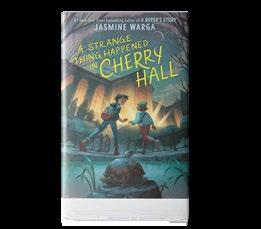

illustrated by Matt Rockefeller. Rami, whose mother works on the museum’s cleaning crew and is suspected of the theft, seeks answers, aided by his take-charge classmate Veda. Both gripping and contemplative, Warga’s story will pull readers in with its clever plotting and insightful musings on family, friendship, and the question of why we create art.
Two acclaimed history writers—Ruta Sepetys and Steve Sheinkin—team up for The Bletchley Riddle (Viking, Oct. 8), a work of fiction set at the real-life Bletchley Park, an English country house where the likes of Alan Turing cracked Nazi codes during World War II. Jakob, 19, works as a codebreaker, while his younger sister, Lizzie, 14, ferries messages and investigates the death of their mother. The authors
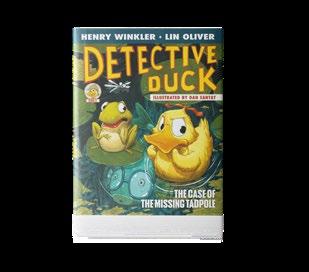
ratchet up the suspense; readers will be eager to learn more about this fascinating chapter of history.
Actor Henry Winkler and author Lin Oliver’s The Case of the Missing Tadpole (Amulet/Abrams, Oct. 15), the latest in their Detective Duck chapter-book series, finds Willow the duckling investigating once more. When Franny the frog’s son Tad disappears, Willow uncovers clues including blue-green algae that has invaded Dogwood Pond. Illustrator Dan Santat’s depictions of animal antics ramp up the humor, keeping the tone cheerful even as the authors fold in warnings about the dangers that humans potentially pose to the natural world.
Mahnaz Dar is a young readers’ editor.
A tween saves her neighbor’s life and finds herself on an unex pected adventure.
Twelve-year-old Melody Brooks, who has cerebral palsy, is looking out her window when she sees Miss Gertie, her elderly neighbor, fall. Melody, who is nonspeaking, uses her talking board to call 911. She’s hailed as a hero and learns that Miss Gertie was once a celebrated film star who’s now isolated from family back home in London. As the news spreads, Miss Gertie and Melody are sought out by the local media. Before long, Melody is invited to attend an international symposium that brings
together “gifted and visionary young people” so they can “exchange ideas and strategize solutions to the problems of the world.” Melody wonders what she could bring to such a gathering, but it means a trip to London for her and Miss Gertie. Accompanied by another trusted neighbor, Melody has a whirlwind of experiences, mostly positive. A major disappointment—an event she couldn’t attend because the space wasn’t wheelchair accessible—offers Melody something she can share with other conference participants. Among others from around the world, she connects with Elvira, who does wheelchair ballet and

Draper, Sharon M. | Caitlyn Dlouhy/Atheneum
320 pp. | $18.99 | Sept. 3, 2024
9781665949545 | Series: Out of My Mind, 3
wants to help other wheelchair users participate in it, too. This latest volume is a worthy addition to a highly acclaimed and popular series. Through strong characterization and powerful storytelling,
Draper once again successfully brings readers into Melody’s mind, allowing them to see the world through her eyes. A warm and beautifully told narrative featuring a beloved character. (Fiction. 10-14)
Àbíké-Íyímídé, Faridah, David Betancourt, Preeti Chhibber, et al. | Illus. by Jahnoy Lindsay | Marvel Press (336 pp.) | $17.99 Oct. 1, 2024 | 9781368095983
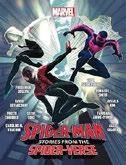
There’s room for everyone under the multiversal spider-tent. A mysterious variant of Doctor Octopus is pulling strings across the multiverse in order to antagonize multiple Spider-Heroes at once! Will the plucky Araña reunite with her friend and fellow superhero, Miguel O’Hara? That question only covers the bookending entries of this wide-ranging selection of stories about different heroes who spin webs to help others, from keeper of stories Kwaku Anansi to the fabulously queer Cooper Coen, aka WebWeaver. The characters all fully inhabit their chapters, which come complete with full-page illustrations to show off their costumes. References to the larger Marvel cast abound for fans to catch or let fly overhead. As an anthology, this book represents a string of successes when it comes to representing each protagonist’s community. Foiling villains is but one part of Miles Morales’ and his mother’s visit to Puerto Rico, where his abuela was born. Pavitr Prabhakar celebrates Navaratri in Queens by participating in a garba dance. Zarina Zahari enjoys a British Eid breakfast of her favorite beans on toast. The heroes all feel fleshed out to the point of demanding their own novels, or at
least an encore crossover to reunite so many talented web-slingers (and their respective authors).
An appealing anthology that zooms in on various walks of life while playing with the larger Marvel universe. (author bios) (Science fiction anthology. 9-13)
Alméras, Gaëlle | Trans. by David Warriner Greystone Kids (172 pp.) | $21.95 Oct. 22, 2024 | 9781778400681
Series: Science Adventure Club
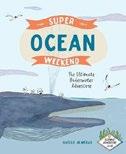
In this French import, four young animal vacationers learn about the world ocean and many of its marvelous residents.
With Echid, a spiny relative visiting from Australia, serving as the main lecturer, the Science Adventure Club camps out on a tiny island for a weekend of banter and learning. They offer infodumps on oceans, tides, and wave types, the water cycle, climate change, and primeval life and the “Biological Big Bang” 500 million years ago that led to more complex organisms from seaweed and corals to blobfish and blue whales. Aside from debatable claims that humans are the oceans’ “biggest predators” and the “only beings on the planet that produce waste” (both of which may be translation issues), Alméras lays out a solid but easily digestible informational load in unframed, pale-hued, free-form panels that flow along, effortlessly drawing young naturalists (and viewers) from polar surface to hadalpelagic zones. The
oceanic expedition fetches up at last back on the beach where it started. One of the friends notes that by 2050, floating plastic will “take up as much space as animals do in the ocean,” which serves as a spur for the author’s ensuing plea to get involved in cleanup and zero-waste causes.
A series of quick but thoroughly immersive dives. (Graphic nonfiction. 9-11)
Amato, Max & Brendan McAuliffe Sourcebooks eXplore (40 pp.)
$18.99 | Oct. 1, 2024 | 9781728289816

Dinosaur soundscapes dominate this unusual take on the familiar reptiles. Beat boxers and any readers willing to try a vocal cord workout will have a field day with this book, which features the sounds of the late Cretaceous. “Shhheka shekaaa… shkraaack.” “Booouuush.” “Kerrr kaaaw kaaaw kerrr.” And that’s just the warm-up. After we meet Terri the Triceratops, who’s just broken out of her egg, we hear and then meet a crowd of her coevals, among them a “yowling” Saurolophus, several “prowling” Velociraptors, a pair of fighting Pachycephalosauruses, and a roaring Tyrannosaurus. In the one little pinch of plot, the unseen narrator, who describes events in a conversational tone, counsels Terri, face to face with the T. rex, to stay silent to avoid becoming lunch. But defiantly, Terri emits her own distinctive sound: “meep.” And still louder, precipitating a hasty Tyrannosaurus retreat. A tiny Triceratops triumph! Striking illustrations depict the dinosaurs in dramatic—but not impossible—colors and patterns. The book takes place over the course of a single day, which readers can trace by noting the color and position of the glowing sun (and then moon). Terri’s encounter with the T. rex coincides with a mauve and then
indigo-dark night. Terri’s discreet appearances on most pages provide another interactive element; little ones will enjoy finding her on each spread. Backmatter explains how we know what these animals sounded like.
A boisterous invitation to roar, snort, and grunt like your favorite prehistoric creatures. (species details, sonic science, environment info, timeline) (Picture book. 3-7)
Anderson, Brian | Marble Press (224 pp.) $14.99 paper | Oct. 15, 2024 9781958325148 | Series: Sophie, 1

In new and reworked episodes of the webcomic “Doug Eat Dog” recast into graphic format, a small chocolate Lab finds herself part of a growing household.
Fans of the long-running cartoon series will find themselves in familiar territory as a frisky pooch accustomed to “infinite attention and belly rubs” is suddenly forced to accommodate some distracting new arrivals—notably genius kittens Chewy and Equinox, and a big-headed “hairless meatball” named Doug whose first, and only, word is an endearing “Bak!” Squirrels, a spider named Carl, Constance the closet monster, and other occasional guests wander in for cameos, and though some raucous playtimes are cast into short storylines (e.g., “Commander Doug vs. the Labradorian” and “The Fast and the Furriest”), most pages are, like the original strips, discrete incidents with punchlines in the final panels. If the mix of adult-sounding dialogue (“Hey! You’re not allowed on the furniture!” “What part of we’re cats do you not understand?”) and broad humor is reminiscent of “Calvin and Hobbes,” there’s plenty of snuggling and dancing to give the hijinks a cozily domestic tone all their own. And, following a partial cast list at the end, Anderson adds a practical tidbit
with the observation that dogs actually sweat through their paws. “So when they give you their paw, you’re actually shaking their armpit.” Good to know. The bright, dynamic art accentuates the characters’ hilariously expressive faces. Fun, funny, and likely to draw new fans to the dynamic duo. (Graphic fiction. 8-12)
Anderson, Brian | Marble Press (224 pp.)
$14.99 paper | Oct. 15, 2024
9781958325254 | Series: Sophie, 2
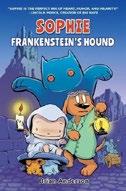
More “Dog Eat Doug” adventures, starring a chocolate Lab and her two-legged rug rat brother. In a dozen loosely linked chapters with titles like “The Bark Knight” and “Cat-ificial Intelligence,” sudden imaginary costume changes mark further high and low moments in Sophie’s ongoing relationships with an expanding cast of arrivals—from eloquent, if monosyllabic, toddler Doug (“Bak!”) to several shelter dogs fostered by the household’s humans. Meanwhile, the family’s two house cats, Chewy and Equinox, who are bent on world (or at least family) domination, summon mystical superbeing “Cat-Thulhu” for advice. The “great and powerful Cosmic Muffin” also explains that “a dog’s purpose is to love unconditionally,” and in the midst of an identity crisis, Sophie pursues a rabbit down a hole into a strange land where a pudgy caterpillar in a onesie (“Bak!”) tells her from atop a giant mushroom to follow her heart. Along with borrowing characters and running themes from the original webcomic, these fresh episodes preserve both its sly brand of humor and solid-gold values on the way to a cozy closing snoozefest…and a final bit of squirrel-based play on the side. Anderson’s lively panels accentuate the
charming animal characters’ rounded faces and bodies.
Doggy delights continue. Bak! (Graphic fiction. 8-12)
Avi | Quill Tree Books/Harper Collins (304 pp.) | $18.99 Oct. 29, 2024 | 9780063086951
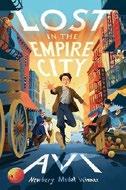
Separated from his family while immigrating to America, a teenage boy must learn to survive in New York City. When Santo Alfonsi was about 8, he promised his father he’d care for his family until they could all be reunited in America. Five years later, following an arduous journey from their Italian village, Santo’s mother, brother, and sister are detained at Ellis Island. Officials send Santo ahead, but when the ferry arrives, his father is nowhere to be found. With no money and little knowledge of English, Santo is left to fend for himself until a child gang leader takes him under his wing. Together, they commit petty crimes, until a chance encounter with a wealthy gentleman changes Santo’s fate. Welcomed into the home of the affluent Ashbury family, Santo glimpses the prosperous America he’s dreamed of. Still, his goal remains firm: to find his family and honor his promise to his father. Avi guides readers through Santo’s immigration journey, capturing the hopeful belief in an America paved with gold, the perilous Atlantic crossing, and the harrowing experience at Ellis Island that leads to Santo’s struggle on the streets. In a world where he has little control, Santo strives to navigate his way. Early-20th-century New York City comes to life through vivid descriptions of its people, smells, and sounds. The first-person narrative deepens the immersive experience. A gripping tale of one young immigrant’s resilience and determination. (author’s note) (Historical fiction. 8-12)
Badua, Tracy | Harper/HarperCollins (240 pp.)
$18.99 | Oct. 15, 2024 | 9780063346994

A fter accidentally destroying the home of magical Filipino tricksters, Thea must find a way to make amends. With her wins in Brazilian jujitsu, Thea Torres is finally the “popular sporty kid”—she’s even attending Junior Stunt Warrior summer camp with some of her cool new friends. But her self-image is threatened when she struggles with some of the obstacles and when Evan Rodriguez, a Mexican American friend from her old school who’s embarrassingly clumsy and geeky, shows up. Hoping to improve her skills, Thea decides to make a practice course in her backyard. Ignoring her father’s warnings about the goblinlike duwendes, Thea cuts a branch from the calamansi tree her late grandfather brought from the Philippines. That night, she’s awakened by a pair of angry duwendes who are tearing apart her room. Threatening to destroy her neighborhood next, they tell Thea she has to make a “true apology” within seven days: She must be sincere in her “words, heart, and offering.” As the damage escalates, Thea enlists Evan and her new friends to help. But the stresses of camp, saving her home, and keeping up her cool, fearless image might be too much. Infused with Filipino folklore and culture, this romp includes tricks, stunts, and an exploration of friendship. Thea’s struggles will resonate with many readers as she wrestles with her
reputation, others’ expectations, and just being herself.
A heartfelt and fun-filled story full of action, adventure, and mischief. (Adventure. 8-12)
Baptiste, Tracey | Algonquin (272 pp.)
$16.99 | Oct. 1, 2024 | 9781643753812
Series: Boy 2.0, 1

A Black boy has no reason to trust anyone and a lot to learn about himself. Ever since he was found by a firefighter as a baby 13 years ago, Win “Coal” Keegan has felt alone. He’d hoped that his latest foster parent, Tom, would adopt him, but after Tom’s sudden mental health episode, Coal is moved to the McKays’ home. They’re nice enough, but trusting is hard for “melanin-rich” Coal, a gentle and thoughtful young artist who’s experienced more than his share of trauma. One day, when he’s chalking the street in commemoration of a young Black woman who was shot during a routine traffic stop, a disgruntled stranger shoots at Coal, triggering an unbelievable response—his skin changes color, camouflaging and protecting him. After Coal eventually opens up to his best friend and the McKay kids, they all get caught up in a world of dangerous secrets, and information about Coal’s birth mom and complicated origins emerges. The novel thoughtfully illustrates some of the harsh realities of being a uniquely vulnerable, dark-skinned boy in a world that refuses to see you and the resulting
An experiment in grace and care that’s as hopeful as it is imaginative.
BOY 2.0
anxiety that can occur. Luckily Coal is surrounded by people who give him the support he needs in ways that are heartwarming and impressive, and they ultimately lead to a positive place. An experiment in grace and care that’s as hopeful as it is imaginative.
(Science fiction. 9-14)
Berke, Elly | Illus. by Luciana Navarro Powell | Tilbury House
(40 pp.)
$18.99 | Sept. 15, 2024 | 9781668945100
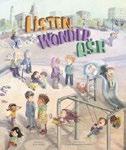
A child unwittingly starts a chain reaction that brings the community together. At the playground, Nadine hears a girl her age speaking to her doll in an unfamiliar language. Eager to learn more, Nadine asks the girl, Yan, if she has a “coming-here story.” Yan replies that she’s a recent immigrant from China, and the two children bond. Later, on her way home, Yan asks a woman named Symona, who’s singing in a different language as she gardens, about her coming-here story and learns that she emigrated from Russia as a young woman. Symona in turn connects with Rafid, from Bangladesh, after hearing him talking on the phone in a different tongue. In true “six degrees of separation” style, the book comes full circle as a young boy hears Nadine speaking Creole to her mother and asks about her country of origin; her mother explains that she herself is from Haiti, while Nadine was born here. Berke’s sweet tale of the domino effect that starts with one curious and accepting girl’s question is sorely needed in this time of division and discord, as is the characters’ use of the term “coming-here story” to inquire about others’ heritages, rather than the potentially more intrusive “Where are you from?” Powell’s soft and welcoming, watercolorlike illustrations capture present and past at once as each immigrant’s history is revealed.
An affirming narrative centering identity, belonging, and community. (Picture book. 4-9)
Berry, Cate | Illus. by
Margherita Grasso
Page Street (32 pp.) | $18.99
July 16, 2024 | 9781645678670

A classroom hedgehog longs to be seen as the fierce beast she knows she is.
“High on a craggy cliff she looms, looking out at her glass castle. No more being cute like her ancestors. Her destiny will be ferocious!”
But no matter what Scorch does—glowering, gnashing her teeth—the students of Room 402 react the same way: “Aww!” When she accidentally propels herself into a nearby terrarium, the snake that lives there decides to make a meal out of her. Scorch resorts to what might well be considered feminine wiles to save herself: striking adorable poses and planting a big smooch on the snake, who backs off. “She’s KILLER cute!” the kids agree. While Scorch ultimately triumphs, the book may leave readers with the retro, sexist message that for women and girls, physical appearance trumps all. In the garish digital art, sharp-toothed Scorch often looks downright demonic as she attempts to project a tough exterior. Though the children vary in skin tone, they all have large, oddly shaped, nearly identical faces, with overly animated expressions. Scorch’s dramatic language and her athletic antics may elicit some chuckles, but overall the tale feels like one long weak joke, with a punchline that grates against feminist ears. A one-note story with a problematic takeaway. (Picture book. 4-6)
Biedrzycki, David | Charlesbridge (56 pp.) $18.99 | Oct. 15, 2024 | 9781623543747
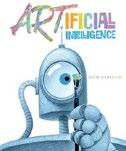
known he was different from the other automatons who work at the warehouse. Abstract washes of color fill his dreams at night—a welcome contrast from his monochromatic world—and he often daydreams, which leads to a wrong turn when he’s sent for reprogramming by a disapproving supervisor. Stumbling out of the warehouse for the first time, he’s struck by the vivid colors. When he wanders into an art museum, his creative spirit is unleashed—with some tech support from a painting course CD-ROM he inserts into his drive. The result is exuberant, expressionistic explosions of color brushed onto walls inside and outside, all over the city.
“It was big, colorful, and grand. Just like his dreams,” the author concludes, rounding off his AI epiphany with perhaps-prescient images of the metal artist taking a bow before his solo show at the art museum, followed by images of robots in an array of roles from chef and country singer to filmmaker and beat dancer. Young readers with unformed creative urges of their own will relate to Robot’s feeling of otherness and may take heart in seeing how he finds his way. The robots come in many shapes; Biedrzycki goes retro for his depiction of Robot. Human characters are racially diverse. A celebration of the artistic spirit, overlaid with wry topicality. (Picture book. 7-9)
Bijsterbosch, Anita | Clavis (32 pp.) $15.95 | Aug. 20, 2024 | 9798890630940

A misfit robot finds his métier— and his bliss—at an art museum.
Ever since a paint-speckled chip was inserted into his head at the assembly factory, Robot has
Everyone has fun in the tub.
Who enjoys the pre-bedtime ritual of a fun soak
more—young Georgie or his toy animals? It’s a toss-up, as kids will learn from this rollicking tale, originally published in Belgium and the Netherlands and translated from Dutch. The book first describes how a crew of critters—stand-ins for Georgie’s own stuffed-toy menagerie—derive pleasure from their bubbly escapades. Each
lathery lark is preceded by the cheerful, boldfaced jingle, “Bath time, [animal name]!” What fun! Bear bathes beneath some grapevines and munches on grapes. Crocodile soaks while waving his tail to a musical beat. Elephant showers off using her own trunk and with some help from Mouse, who sprays her with a watering can. Elephant then reciprocates by hosing Mouse with her trunk. Hippo hangs upside down from a branch and dips her ears into her tub, the better to clean them. After the animals have donned their pajamas, it’s Georgie’s turn for a playful, refreshing soak before he puts on his own pj’s, reads a bedtime story with his treasured, freshly bathed pals, and says good night. This endearing offering, a very pleasant addition to bedtime-story shelves, will satisfy children with its sweet depiction of familiar, structured routines; they’ll also appreciate the animals’ unique bathtime regimens, which incorporate onomatopoeic sound effects. The colorful illustrations feature charming, expressive characters. Brown-haired Georgie is pale-skinned.
Good clean nighttime fun.
(Picture book. 3-5)
Bingham, Winsome | Illus. by Molly Mendoza Beach Lane/Simon & Schuster (40 pp.)
$18.99 | Oct. 1, 2024 | 9781534469952

A loving matriarch shows her family how to appreciate the good times as she navigates the end of a life well lived.
Bingham tells another heartfelt, intergenerational story centered on a Black family. Granny Dee “lives in the heart of Harlem” but crosses town— “on three trains and one bus”—to spend weekends with her beloved granddaughter. Whether taking day trips throughout the city or painting each other’s nails, the two delight in every moment together. That is until one weekend when Granny Dee doesn’t
arrive. “She’s getting too old for the trains and buses,” Momma says. Daughter and granddaughter visit Granny Dee at her home, where it becomes obvious that she’s readying herself for a transition from this world, informed by her Christian faith. “Earth is a rented space,” she tells her granddaughter. “Heaven is home.” Depictions of the family’s loving memories echo Granny Dee’s words of wisdom. Her maxim—“Everybody should enjoy life. Life is beautiful”—is a final, bittersweet remembrance as the old woman takes her final breaths; readers are left with a reminder that holding on to happy moments with loved ones can help them sit with grief. Mendoza’s carefully composed images of urban scenes, subway rides, and loving moments have a pleasing retro vibe; she infuses her art with animated shapes and lines that pulse with energy—a perfect encapsulation of Granny Dee’s sage words. A soul-stirring opportunity for joyful reflection while preparing for one of life’s hardest yet most ever-present realities. (Picture book. 4-8)
Boldt, Mike | Dial Books (56 pp.)
$19.99 | June 11, 2024
9780593697740 | Series: Can Do, 1
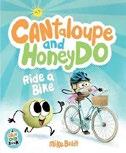
Two friends come together to learn an exciting new skill. Depicted as melons of nonspecific gender with googly eyes and flexible stick limbs, Cantaloupe and HoneyDo have different initial responses to Cantaloupe’s new bike. Cantaloupe’s already fallen off and is too timorous to mount up again, while HoneyDo is wild to put pedal to the metal but, it turns out, clueless about even which way to face. “It can be tricky,” warns Cantaloupe. “I have heard that,” responds HoneyDo. “But I will practice.” Cantaloupe protests, “But you could fall and get hurt!” “Oh, probably. Especially if I am learning. I will wear a helmet to
(BE SMART ABOUT) SCREEN TIME!
protect my melon.” The melons, bike, helmet, and occasional props, such as the pair of Groucho glasses that Cantaloupe dons while explaining what the pedals are actually for, are bright photographed elements to which the author/illustrator has added only a few drawn bits and dialogue balloons. The effect is as light and airy as the banter. A few false starts, falls, and encouraging comments later, both melons have just about caught the knack. Success is sweet, and so, in this first of a projected series, is Boldt’s dedication to “all the kids learning to ride a bike (and the parents running behind them).”
A delectable depiction of a fruitful relationship. (Picture book. 4-6)
Bourne, Shakirah | Scholastic (336 pp.)
$18.99 | Sept. 17, 2024 | 9781338783599
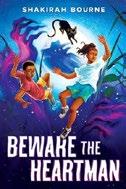
In beautiful Barbados, the Heartman emerges from folklore to terrorize a small fishing village, but a brave girl has fought the supernatural before and won.
It’s been 10 months since the events of Josephine Against the Sea (2021), in which Mariss, an evil sea spirit, set her eyes on Josephine’s dad and turned the lives of father and daughter—and everyone in Fairy Vale—upside down. Now, with the disappearances of her cricket coach, a teammate, and best friend Ahkai, Josephine suspects something just as magically nefarious is afoot. She initially suspects the
replacement coach, who is kind of a jerk, but promptly shifts her investigation toward Ahkai’s new crush, the mysterious Lynne. The characters have grown over the past year, and this sequel continues to build upon its robust Caribbean mythological base. Josephine remains zealously protective of those close to her as she aims to solve the mystery of the Heartman through cultural research, impressive savvy, and thoughtful engagement with her community. Reluctantly, as it becomes clear Lynne isn’t the threat to her friendship with Ahkai that she thought and rather something entirely different, the two become close and realize they must work together to save Ahkai and the others from the dangers of the Heartman’s lair. Their success relies on healing from the past while making new connections, and Josephine’s journey is as frightening as it is emotionally challenging. Cleverly reimagines Caribbean folklore while reinforcing friendship and family. (Fantasy. 9-13)
Brian, Rachel | Little, Brown (64 pp.)
$15.99 | Nov. 19, 2024 | 9780316575546
Series: Be Smart About, 3
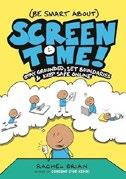
Having advised kids on consent and anxiety, Brian now offers a primer on healthy technology use.
“Congratulations!” this high-energy comic opens. “You’re getting some screen time,
maybe even a screen of your own”—language that will be familiar to many children and their adults. In eight quick chapters, simple cartoon figures who vary in skin tone explain how the brain’s reward system processes the dopamine hits that result from social media “likes,” the importance of establishing boundaries, and how to be a good digital citizen. Brian makes glancing references to the more dangerous aspects of unsupervised browsing, such as hate speech and “images and videos with naked people.” She tells kids to talk with parents or trusted adults about things that make them uncomfortable or upset. Throughout, Marble the cat pops up with reminders about staying safe, though a bit inconsistently. Dealing thoughtfully with a thorny, ever-evolving subject, this book will help shore up conversations about screen time and internet usage. Illuminating and instructive, the book is a first line of defense for parents and educators wanting to spark discussion or reinforce their established rules. Necessary guidance for kids starting to navigate smartphones and social media. (Graphic nonfiction. 6-10)
Browne, Hartigan | Workman (224 pp.) $12.99 paper | Oct. 29, 2024
9781523531677 | Series: Cluedle, 2
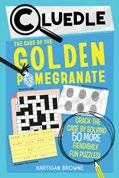
A special kind of catnip for the puzzle-inclined. Someone has stolen a clue that’s vital to finding the sheet music to a famous opera called The Pegasus, inspired by ancient Greek music. Browne invites readers to investigate. Unlike a Choose Your Own Adventure story or one of Jason Shiga’s Adventuregame Comics, this narrative progresses in a linear fashion, with readers solving a puzzle with nearly every page flip. The rich variety of brainteasers is this book’s biggest strength, since solving them all requires comparing suspect interviews
and fingerprints, navigating mazes that reveal codes, analyzing maps, and deciphering several kinds of coded messages, to name just some of the deductive mechanics involved. There is no fail state: The narrative always proceeds under the assumption that readers have taken the time to correctly solve each puzzle. Anyone in need of an assist can use the included hints or even peek at the answers in the back as a last resort. The details of each case build upon one another, with puzzles near the end requiring knowledge of past events and their resulting evidence. As for the mystery itself, readers who can imagine themselves summoned to sleuth around a secret luxury yacht will be indulged, from their plane ticket to… Well, they’ll figure it out. The cast’s pun-based names—Anita Sleep, May Wail, and May’s husband, Will Wail, among them—add to the amusement. Aspiring sleuths will enjoy navigating this accommodating gauntlet. (Puzzle book. 8-12)
Buckley Jr., James & Ellen Labrecque Illus. by Steffi Walthall | Sourcebooks eXplore (128 pp.) | $16.99 Aug. 6, 2024 | 9781728275062
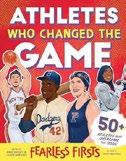
Profiles of more than 50 teams and athletes who broke barriers or beat the odds to succeed. While readers in search of role models will find familiar ones here—from Jim Thorpe and Jackie Robinson to Simone Biles—it’s the lower-profile entries that set this book apart. Along with athletes who broke color or gender barriers to play professional hockey, basketball, and numerous other sports, the authors salute several Paralympians, as well as Kim Ng, the first female general manager in Major League Baseball; Jim Eisenreich, the first known MLB player to have had
Tourette syndrome; transgender NCAA swimmer Lia Thomas; autism advocate and professional surfer Clay Marzo; and Justin Peck, a motorsports racer who’s been open about his bipolar disorder. Title IX also wins a full entry of its own, and the Haudenosaunee lacrosse teams, barred from international competition from the 19th century to 1990 and again as recently as 2020 (ironically, considering the sport’s Native American origins), are one of several teams to earn commendation for persistence.
“The world of sports,” the authors write, “more than ever before, has room in the lineup for everyone!”
Specific biographical information in the alphabetically arranged entries tends to be thin, but both these profiles and Walthall’s portraits of muscular, smiling figures exuding confidence offer inspiration galore. A plentiful gallery of role models, well beyond the usual suspects. (timeline, index by sport, further reading) (Collective biography. 9-12)
Burgess, Matthew | Illus. by Sirin Thada Enchanted Lion Books (68 pp.)
$19.95 | Nov. 5, 2024 | 9781592704224

A salute to a musical genius with a uniquely independent spirit. Burgess leaves out the “Artist Formerly Known As” conceit, not to mention his subject’s ultimately fatal addiction to fentanyl, to focus on role modeling—carrying Prince Rogers Nelson from bullied child to superstar, riding his “gigantic dream” and outstanding talents to a spectacular performance for millions in the 2007 Super Bowl halftime show. Along the way, the author pays tribute to both Prince’s musical gifts, which he inherited from his parents and began expressing with an original song at age 7, and the venturesome ambition that culminated in his distinctive look,
brand, self-made film, and hit song “Purple Rain.” Why purple? “Purple is regal,” the author emotes. “Purple is mysterious. Purple was perfect for Prince.” In explosive angles and lines (and, natch, pervasive notes of guess which color?), Thada likewise portrays the self-driven Purple One from a young boy sitting on pillows to reach his father’s piano to multi-instrumentalist and flamboyant band leader captivating an entire stadium packed with rocking, racially diverse fans. Even though its more tragic parts remain untold here, Prince’s meteoric career offers an example that will entice readers with big, creative dreams of their own. A soaring drive to inspire, with appropriately hued art and prose. (author’s and illustrator’s notes, quotation sources) (Picture-book biography. 6-9)
Carlin, Laura | Candlewick Studio (216 pp.) $27.99 | Oct. 8, 2024 | 9781536231434

A sweeping illustrated tour of London from the Pleistocene Epoch to the present. Starting 2.6 million years ago and ending with the death of Queen Elizabeth II in 2022, this account shows the numerous permutations of present-day London’s land and its many waves of inhabitants. Short chapters, some just a paragraph long, show the varied cultures of those who have lived in this spot beside the River Thames, from the earliest Stone Age settlers through to subsequent multicultural influences of Romans, Anglo-Saxons, Vikings, and Normans to its growth over the last few centuries to becoming the city it is today. Carlin covers key events—the signing of the Magna Carta in 1215 and the Great Fire of 1666—along with pivotal eras, such as the Black Death, which killed about half the population in the mid-14th century and the 19th-century Industrial Revolution; such descriptions provide context about the influences that shaped this metropolis. Primary and secondary
resources, including poems, quotations, and a nursery rhyme, add context and breathe life into the events. The soft, slightly impressionistic illustrations, executed in watercolor, ink, oil pastel, and colored pencil, use a muted palette that perfectly matches the tone of the narrative, which provides the essence of the history rather than describing fine details. Reds and blues provide occasional pops of color in dramatic scenes of wars, gladiator battles, and fires. Like a walk through a well-curated museum on the history of a great city. (historical notes) (History. 10-16)
$18.95 | Oct. 15, 2024 | 9781771476140
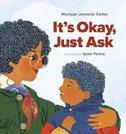
An inquisitive child has many questions as a family prepares to move. Mother, who has warm brown skin and black curly hair just like the young narrator’s, “always says, It’s okay, just ask.” And the protagonist obliges, posing questions as the family packs up boxes, boards an airplane, and relocates to a coastal setting with mountains in the distance. Some queries are typical for a story about moving: “Will we ever come back?” “What if I don’t make any friends?” Others break new ground. When the child asks Mother, “Are you okay?” she becomes surprisingly vulnerable in her honest answer: “Not completely.” Offering Mother a hug, the child becomes the parent for a moment—a welcome reversal in a text rooted in an adult’s instructions. Perera’s illustrations feel intimate, from the family’s expressive faces to the details of their new home: an Inuit inuksuk, the hockey game they watch on TV. Saturated earth tones portray a peaceful but somewhat homogenous suburb, which inspires the protagonist to ask, “Why is my hair black?” The mother answers, “That’s how you were made,” hewing to the book’s evenhanded tone. The comforting refrain of “It’s okay, just
ask” persists throughout the story, dovetailing with the child’s articulations of wise emotional responses. The tale doesn’t contain a great deal of drama, but the message will certainly sink in. Tenderly reassuring and useful for sparking curiosity. (Picture book. 5-9)
Cerra,
Kerry O’Malley | Carolrhoda (360 pp.) $19.99 | Oct. 1, 2024 | 9781728493220

Eighth grader Savannah Braden learns that the path to effective activism is bumpy. Sav has just moved from Orlando to Sandy Dune, Florida. While the rest of her family adjusts easily, Sav misses her best friend, Maisy, and has new-kid-at-school jitters. Fortunately, she isn’t selfconscious about her cochlear implants. Sav was born with hearing loss and is comfortable explaining her implants to people. When her father announces he’s booked the family for a sharkwatching dive, Sav is terrified. She’s scared of sharks and afraid of being submersed in water. Her implants can’t get wet, so she’d need special, expensive covers for them—and anyway, she relies on her sense of sight and “knowingness”; she’s sure she’d become disoriented in the darkness underwater. A disturbing encounter with shark fishing propels Sav into learning more about sharks’ role in the ecosystem, which then moves her to become an advocate for their survival. Initially, Sav’s combative form of activism gets her into trouble and loses her the few friends she’s made. She struggles with being patient and, in her passion for getting her message across, makes some unwise decisions. Eventually, however, she learns that the goal is to fight for rather than against something. Cerra skillfully weaves fascinating data about sharks and ocean ecosystems into Sav’s emotional journey, making this work appealing to readers who enjoy science
and character-driven stories alike. Major characters read white. A conservation tale with the ability to empower readers. (discussion questions, shark information, author’s note) (Fiction. 10-14)
Chirif, Micaela | Illus. by Joaquín Camp Trans. by Jordan Landsman | Transit Children’s Editions (40 pp.) | $21.95 Sept. 24, 2024 | 9798893389050

A familiar tale is upended in a show of magical realism… and flatulence. In this Argentinian import, readers meet Elisa, a diapered baby sporting a bowl haircut. One evening she begins to cry, slowly at first, then gaining in strength. Her parents try different tactics to quiet her but are unsuccessful, so the neighbors, unable to sleep from the racket, try their own techniques. They attempt everything from donning animal masks to dancing around in fruit costumes, all to no avail. As in any tall tale, the author employs exaggerated language; little Elisa’s cries are described in increasingly impossible (and impossibly funny) ways. Her roars are so powerful that characters in storybooks cry, too. “Her cry [is] so fierce it wither[s] the flowers and scare[s] away the little birds.” Finally, the next morning, Grandma stops by and immediately bicycles Elisa’s legs slowly. What happens next is a fart so colossal that it lifts the entire apartment building off its foundations and into space. While the fart is over-the-top, its presence is almost dwarfed by the sheer energy, color, and vibrancy of the accompanying surreal illustrations. Both story and art reflec t a passion for extremes, each equally ridiculous in their own ways. Elisa and her family are pink-hued, while the neighbors vary in skin tone. Come for the sobbing baby. Stay for the psychedelic cacophony of accompanying chaos. (Picture book. 3-6)
A familiar tale is upended in a show of magical realism...and flatulence.
A SLEEPLESS NIGHT
Clendenan, Megan | Illus. by Meegan Lim Orca (96 pp.) | $29.95 | Sept. 17, 2024 9781459836761 | Series: Orca Timeline, 7
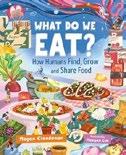
A plea to address food anxieties by wasting less, being more efficient with current resources, and exploring alternative sources. Best thought of as a discussion starter, Clendenan’s survey is light on fine details but spotlights a great array of food-related topics. The author makes quick nods toward both cautionary and inspiring incidents, from the ill-supplied Robert Scott Antarctic expedition to how a marooned group of Polynesian youths got by on a deserted island for 15 months in 1965. More recently, Clendenan describes the way the Russian invasion prompted Ukrainian restaurant owners to provide free meals to refugees. She also details creative ways in which people have met technical challenges, such as the invention of packaged salads for the military or growing food in outer space. In an overview of the history of farming, the author points to agroforestry (planting trees and shrubs alongside crops) as a potentially sustainable agricultural practice while warning of the problems posed by monoculture crops. She forthrightly suggests that, along with food that’s now being thrown away for cosmetic or other poor reasons (“landfill salad”), more seaweed, insects, labgrown meat, and 3D-printed foods will soon be on the general menu. The visuals—a mix of color photos and Lim’s illustrations—underscore the
worldwide diversity of different kinds of foodstuffs as well as the humans who consume them.
A wide-angled review, but useful for raising awareness of a topic of great and growing concern. (glossary, resources, index) (Nonfiction. 10-13)
Coco, Maria | Bloomsbury (32 pp.) $18.99 | Nov. 12, 2024 | 9781547613656

Who knew dogs fancied books? The kids in this story speculate about why dogs might enjoy books. Perhaps pooches love the way the pages smell? Or the way the pictures taste? Or “the sound of wonderful stories read aloud”? Dogs might appreciate the opportunity to learn about faraway places. Or maybe the magic of books allows them to have “big, perfect dog dreams.” The children ultimately decide that maybe dogs love books for the same reasons humans do: because books “make us feel…Like we are not alone.” A youngster pipes up, “When I read with a dog or two or more, I don’t feel alone either.” This statement is accompanied by a very endearing illustration of the child reading to caged dogs at a shelter; some empty cages bear “Adopted” signs. That seems to be the heartfelt conclusion of this gentle tale: Books provide us with company. How could we feel lonely under those circumstances? And with a trusty doggo beside us, we’re certainly never alone. This sweet story, expressed in simple text and rife with conversationsparking possibilities, will appeal even to kids who aren’t dog owners. Grown-ups should encourage children to
A real-life dog—and Murder, She Wrote provided inspiration for the author and illustrator’s new mystery series.
BY MEGAN LABRISE
IN THE CASE of Sara Varon’s new middle-grade mystery series, the real mystery is how it came to be.
“I’m not a mysterious or sneaky person,” she tells Kirkus, “and I don’t usually read mysteries, which makes it even weirder that I wrote one.”
Varon is the Chicago-based author/illustrator of Robot Dreams (2007)—which became an Academy Award–nominated film by Pablo Berger—as well as Odd Duck (2013), New Shoes (2018), and many other books for young readers. The Case of the Golden Bone (First Second, May 28) is the first book in a planned trilogy featuring Detective Sweet Pea, a creative canine gumshoe based on Varon’s real-life dog.
“Once I decided to write one, I thought, Well, what kind of mystery would I write? ” says Varon, who set out to research detectives of all stripes in literature and film. “Ultimately, I felt like my mystery would be more like the No. 1 Ladies Detective Agency, where it’s less about the mystery and more about somebody trying to help their friends get along.”
In The Case of the Golden Bone, the all-animal town of Parkville is rocked on the night of the dog choir’s seasonopening concert when museum director Lilian discovers the disappearance of the Golden Chew Bone. Everyone—especially the canine community, which receives considerable oral health benefits from gnawing on the bone—hopes Sweet Pea’s superior sense of smell can help recover the famous artifact. “Sniffing around for an adorable, exciting, and thoughtful tale?” Kirkus writes in a starred review. “This doggy detective delivers.”
Varon recently spoke with us via Zoom. The following interview has been edited for length and clarity.


Pea, while she’s kind to me, isn’t quite as kind and welcoming—but in the book she’s ready to meet new people, she likes to bring people together, she loves to smell, and she loves to eat garbage. A famous dog bone goes missing, and she has to figure out what happened.
When you’re writing a mystery, what are the main beats you have to hit?
out. The last third is her putting things right.
I know you’re not a mysterygeared person, but are you a Jessica Fletcher fan by any chance?
Tell us a little bit about Detective Sweet Pea and the mystery she’s attempting to solve in Book One. Detective Sweet Pea is based on this Sweet Pea [she points to a wall-
mounted photograph of her dog]. Sweet Pea solves mysteries with her nose. She likes to figure out what’s going on. In the book, she’s very kind and welcoming. The real Sweet
I modeled Golden Bone after this [mystery] I read that was really great [The Real McCoys by Matthew Swanson, illustrated by Robbi Behr]. My agent and I talked about [the plot], and we broke it down into thirds: The first third is establishing what’s normal—the town, the people—and then something goes wrong. The second third is [the detective] trying to figure it
I love Murder, She Wrote . So I did watch a bunch of shows, including ones where people are jerks and there’s murder and no one’s really nice, but I tried to model Sweet Pea after Jessica Fletcher, who’s really kind. And the No. 1 Ladies’ Detective Agency, as I’ve said. I also watched a lot of the TV show Miss Fisher’s Murder Mysteries , set in Australia in the 1920s. Initially, since it’s a series—and this is my first series—I thought about how I could have stories in each book, then have an arc that runs across all three books. I watched [various] series for that.
I watched Miss Fisher’s to learn how to introduce new subplots in subsequent stories, and have them build on what came before. I have to say, I feel like I haven’t really succeeded in doing that, but I did watch a lot of that particular series.
You’ve been making books ever since graduating from art school in 2002. Have you seen a lot of changes in the industry since then? Completely. There were no major publishers doing comics when I started. I got in early; I was very lucky. I feel like at many points of my life, I’ve been very lucky and in the right place at the right time. I got in right at the beginning of the big publishing houses doing graphic novels. Now the skill level of
the people making graphic novels is so much higher, light-years ahead of what it was Back then, there wasn’t so much competition. Now everybody’s so good—the drawing skills, the computer skills, the coloring skills are great—and the variety [is amazing]. Raina Telgemeier changed so many things by making books for girls in middle school that were about middle school girls, and making them cool.
Your work is usually marketed to readers ages 6-10. How did that become your sweet spot?
I don’t know, but I do think about it sometimes. I mean, I’m definitely writing so that I’ll have something to draw. I didn’t write till I was much older—I went to grad school
when I was 30 or so, and we had to write, and I had never done it, and it was painful. But I learned that it’s better to do your own writing, because you get to draw what you choose.
Later, I took a continuing education writing class at NYU. I feel like that was really helpful. It wasn’t fun. I think other people were having fun, but I was not having fun. It was writing for adults, and my stories were so bad. They were just boring and depressing. But for some reason, I can write a funny story for 6to 10-year-olds.
Elementary school, that’s a really good time. It’s before you get to that place where you worry about being cool. In a way it’s sort of a golden age, in my opinion, as someone who visits schools.
I don’t usually read mysteries, which makes it even weirder that I wrote one.

When you get to fifth or sixth grade, all of a sudden, the kids don’t want to draw, because they’re worried about what other kids think. Before [self-consciousness sets in] they’re amazing; they come up with the best ideas.
What’s your favorite part of school visits?
I always draw a picture with the kids where they tell me what to draw. It’s like, “Some of you think of a character, and then someone else think of the setting, and then we’ll build a scene together.”
Sometimes they’re terrible, but every once in a while, they’ll be so amazing. Sometimes I wonder, How am I going to make this work? But we always manage to finish it. We always come up with something unique, something one person could never make on their own. And because they’re 6 to 10, they think whatever you draw is great, which is great [in and of itself].
Would you be open to someone turning Detective Sweet Pea into an animated film or series?
Yeah! Why not? It went so well the first time.
What was the most surprising part of having Robot Dreams made into a movie?
That it actually happened. That it was so good. [Pablo Berger] did an amazing job. Anything could have happened; he could have changed it all. He just made so many great choices: set it in New York, added funny jokes in the background. He added great characters, great music. I feel so lucky about how everything worked out.

Ruth Wilson Narrates His Dark Materials Audiobooks
The actor starred in the TV adaptation of Philip Pullman’s popular fantasy trilogy for young readers.
Ruth Wilson is lending her voice to Philip Pullman’s His Dark Materials trilogy. Listening Library will release Wilson’s new narrations of Pullman’s popular fantasy novels for young readers, the audiobook publisher announced in a news release.
Pullman launched his trilogy, about two young

children who explore alternate universes, in 1995 with Northern Lights, published in the U.S. a year later as The Golden Compass. The Subtle Knife followed in 1997, with The Amber Spyglass hitting shelves in 2000.
The books proved popular with young readers. The Golden Compass was adapted into a 2007 film directed by Chris Weitz and starring Nicole Kidman, Dakota Blue Richards, and Daniel Craig, and the trilogy formed the basis for a BBC One and HBO series that ran from 2019 to 2022.
Wilson, known for her work in the series Luther and The Affair, starred as villainous, power-hungry Marisa Coulter in the television adaptation of His Dark Materials. The actor said in a statement, “I fell in love with Philip’s world… when I first read the books: they’re so complex in their themes, and playing Mrs. Coulter on screen allowed me to explore themes deeper than just her villainy: narcissism, freedom, motherhood, imagination.”
The new audiobook edition of The Golden Compass is set for release on Sept. 5; the next two installments will come out in early 2025.—M.S.

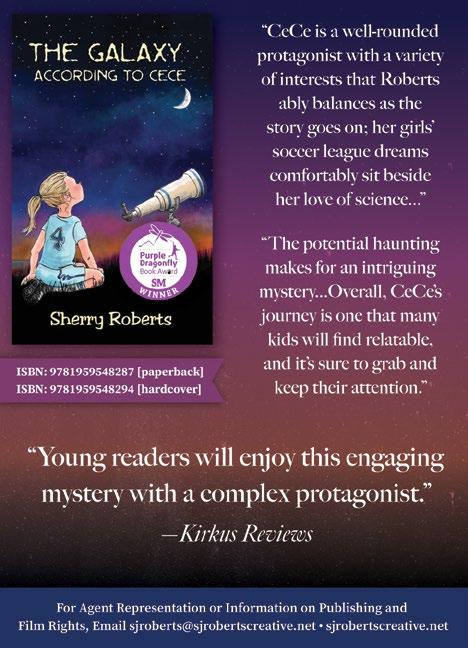

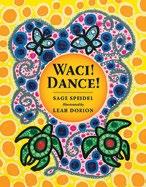
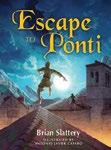
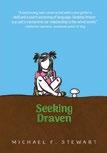

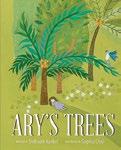


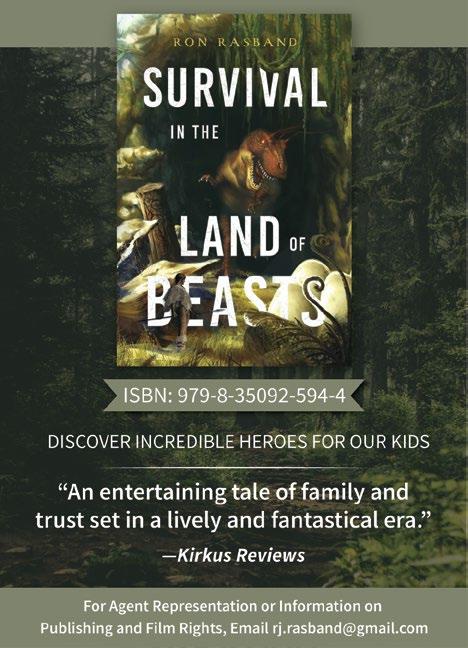

The chef and opera singer’s When Alexander Graced the Table will be published in January.
Chef and opera singer Alexander Smalls will release his first children’s book next year, People magazine reports.
Denene Millner Books, an imprint of Simon & Schuster, will publish When Alexander Graced the Table, co-written with Millner and illustrated by Frank Morrison, in the winter. The press calls the picture book “a tender celebration of family, traditions, and the little moments shared at the dinner table that make all the difference.”
Smalls won Tony and Grammy Awards in 1977 as part of the cast of the Houston Grand Opera’s production of George Gershwin’s Porgy and Bess and, starting in the

For more picture books illustrated by Frank Morrison, visit Kirkus online.
1990s, opened a series of restaurants including Café Beulah, Sweet Ophelia’s, Minton’s, and The Cecil.
His previous books include Grace the Table: Stories and Recipes From My Southern Revival and Meals, Music, and Muses: Recipes From My African American Kitchen, co-written with Veronica Chambers.
His children’s book follows Alexander, a boy who looks forward to Sunday meals after church and is asked to contribute a dish for the first time.
Smalls announced his book on Instagram, writing, “Beyond excited… grateful and thankful to my amazing team of artists and collaborators who helped and supported me in fulfilling yet another dream…life goal and milestone.”
When Alexander Graced the Table is scheduled for publication on Jan. 7, 2025.—M.S.

volunteer reasons why they and their dogs love books. The lively illustrations, created on acetate layers painted with a brush and black acrylic paint, feature a limited palette of white, orange, and blues and depict racially diverse characters and a variety of dog breeds. A delightful tribute to both bibliophilia and dogs. (Picture book. 3-7)
Collier, Nicole D. | Harper/ HarperCollins (272 pp.) | $18.99 Oct. 15, 2024 | 9780063326163
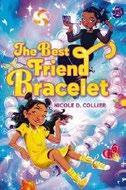
If only making a best friend were as easy as making jewelry. Zariah Brown, a Black 12-yearold, is a friendship bracelet master— the ones she makes are popular at Hurston Middle School. She’s busy fulfilling bracelet orders, trying not to attract negative attention (her brother says that clumsiness is her superpower), and keeping up her straight A grades, but Zariah secretly longs for a best friend; she hasn’t had one since a painful incident two years ago. It’s hard to see Naomi, her former best friend, always hanging out with another classmate, Kaira. When Kaira orders a bracelet for Naomi, the despondent Zariah heads to her favorite shop, Flaming Heart, for supplies. The eccentric shop owner gifts her with a special set of beads, which Zariah later discovers will instantly make anyone her best friend. She quickly finds herself on an emotional roller coaster as she learns about the drawbacks of forced relationships and searches for the perfect best friend before an upcoming school event that’s just highlighting how alone she feels. Collier shows readers the importance of being yourself and not changing just to fit in. Zariah finds herself in situations where she must decide how to proceed and whether she wants to change to blend in. Text messages with her father, who
travels a lot, offer great advice for tweens. The story also touches on the effects of social media. A lightly magical story that thoughtfully explores friendship and developing a strong sense of self. (best friend bracelet profile) (Fiction. 8-12)
Colvin, Claudette & Phillip Hoose Illus. by Bea Jackson | Farrar, Straus and Giroux (40 pp.) | $19.99
Nov. 12, 2024 | 9780374389734
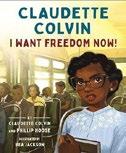
A Civil Rights activist who sat on a bus before Rosa Parks did and paid the price tells her story. Colvin and Hoose collaborated on a YA memoir in 2009 (Claudette Colvin: Twice Toward Justice), but this boiled-down version preserves both major events—as a 15-year-old Montgomery resident in 1955, she was arrested for refusing to give up a bus seat and later participated in an Alabama lawsuit that succeeded in making racially segregated buses illegal in the state—and her claim to have inspired, but subsequently been overshadowed by, Parks. Jackson portrays her as a neatly dressed, studious-looking teen who sits stubbornly with the spirits of Harriet Tubman and Sojourner Truth behind her while the white bus driver delivers an angry lecture; she then goes on to kneel fearfully in an empty cell after being manhandled by white police officers. Finally, she poses in forthright dignity before a panel of white judges as she delivers her testimony. What
emerges most strongly from her account is her forceful conviction, undimmed through all the years since, that injustice must be fought: “Because you can’t just ask for change,” she writes. “You can’t sugarcoat it. You have to take a stand and say, ‘This is not right.’ Like I did.” As well as honoring her as one of the earliest and last-surviving Civil Rights pioneers, the book might well inspire readers to take up Hoose’s closing suggestion to ask, “Is there a little Claudette in me?” Courageous acts, long undersung but well worth remembering. (note from Hoose) (Picture-book memoir. 6-8)
Conroy, Kelly | Illus. by Abigail Hookham Tiger Tales (32 pp.) | $18.99 | Nov. 5, 2024 9781664300484
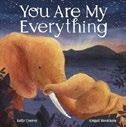
Conroy uses metaphors and similes to convey an elephant’s love for its calf. The book follows the duo on their wanderings from sunrise to their reunion with their herd and their bedtime snuggling under the night sky. Throughout, spot-on, gentle rhyming verses from the parent’s perspective address the youngster: “You’re my sunny, smiling treasure / when we’re splashing in the heat. // As we wander, you spread music / with the rhythm of your feet.” Many of the comparisons will resonate with parents reading this with their child (the comfort of an embrace, a “rocky path explorer”); some images especially tap into the intense emotions experienced by new parents: “You’re the heartbeat of this family.” “You’re the earth beneath our
Courageous acts, long undersung but well worth remembering.
CLAUDETTE COLVIN
feet / that keeps us grounded, rooted, strong. / You’re the twine that binds our loved ones— / together, we belong.” Hookham’s brightly colored illustrations combine realism and anthropomorphized expressions, which will appeal to the littlest listeners. A few other animal species are visible in the backgrounds, but the focus is on the parent-child pair, their slightly redder color making them stand out among the herd. While the book treads familiar ground, the sweet sentiments and focus on elephants help it stand slightly apart.
A solid new addition for the shelves of parents welcoming their own new additions. (Picture book. 2-6)
Costello, David Hyde | Farrar, Straus and Giroux (32 pp.) | $18.99 | Oct. 29, 2024 9780374391331 | Series: I Can Help
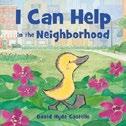
In this follow-up to Costello’s I Can Help (2010), a duckling receives assistance, which results in a chain of good deeds.
Peeking out from tall grass, the little duck laments, “Uh-oh. I’m lost.” A rabbit bounds by and cheerily offers to help. The rabbit jumps high and spots the duckling’s family. They are all reunited. When the perspective zooms out, readers can see that the animals are in a park. But now the rabbit, tangled in a kite string, needs help. A passing pigeon flaps down and says, “I can help.” A familiar pattern emerges as the book demonstrates how all the animals are interconnected. The setting changes as the pigeon flies out of the park and into an urban environment. In need of shelter, the pigeon laments, “I need cover.” A raccoon steps in to lend a paw; later, a rat and a squirrel join the fray. Day turns to night and back to morning, and the same little duckling helps the squirrel but gets lost again (someone get that duck a compass!). The repeating refrain of “I can help” will reassure
readers and is simple enough to be triumphantly parroted by the youngest of storytime audiences. Whether depicting a verdant park or moonlit city scenes, Costello’s artwork sets a soothing tone. Human characters are diverse. Infectiously charming. (Picture book. 2-5)
Dawnay, Gabby | Illus. by Alex Barrow Thames & Hudson (32 pp.) | $15.95
Oct. 8, 2024 | 9780500653630
Series: If I Had A...

A child indulges in a flight of fancy. A brownskinned youngster fantasizes about what it would be like to have a dragon. Sure, there are other cryptids to choose from. But the young narrator already has a unicorn, krakens require too much space, trolls are terrifying, and the yeti is abominable. Plus, dragons are “epic,” “amazing,” and “legendary.” And think of the fun you’d have with a dragon: learning to breathe fire, flying to school on her back, reading together at the library, and baking (you don’t even need an oven!). True, dragon ownership has its drawbacks: Dragons must eat a couple of knights “to keep their breath alight.” Meeting this need calls for weekly trips to the museum so the dragon can scarf down armored knights on display. (And just imagine the pile of flaming poop this would result in! Talk about epic—and epic fits of reader giggles, no doubt.) Another challenge: finding and storing caches of gold, because, you see, dragons love to bathe in it! Children who enjoy stretching their imaginations to the limit will appreciate this tale, narrated in rollicking rhyme. They’ll love discussing and even illustrating the adventures they’d have if they owned a dragon. Set against white backdrops, the colorful, dynamic cartoon images drive the story well. The graceful dragon, while toothy, isn’t fearsome. Background characters are racially diverse.
There’ll be no “dragon” of feet about reading this book: Kids will devour it. (Picture book. 4-7)
De Keyzer, Ilse | Illus. by Dana Martens | Clavis (40 pp.) | $19.95 Sept. 24, 2024 | 9798890630872

Does the Loch Ness monster eat pancakes?
Young Rhona is about to find out. Her beloved, if eccentric, uncle Allister’s plan to lure the legendary creature out of hiding hinges on the sweet breakfast treat—surely the monster won’t be able to resist Allister’s pancakes? When Rhona accompanies him out onto the loch in his fishing boat, she finds herself in just the right spot for a wondrous encounter. Martens sets the stage properly with misty views of a boat just large enough to have an enclosed galley, floating over kaleidoscopic wavelets and shadows that underscore senses of great depth and otherworldly realms just beyond sight. Fortuitously, Rhona is alone on the deck when the loch’s immense but peaceable resident actually does rear up, close enough to lock eyes with Rhona and share a moment of intimate connection before slipping away while the child distracts her oblivious uncle. Allister has long been a believer and has frequently regaled his niece with tales of sightings, but in the wake of her questions about whether monsters are real (and even if they are, why anyone would want to catch one), he eventually admits that perhaps she’s right to be skeptical. Attentive readers of this tale, translated from Dutch, will note that while Rhona now believes in monsters, her belief that they deserve their freedom remains unwavering. She and her uncle are light-skinned. A magical moment, enhanced by strongly atmospheric illustrations. (Picture book. 6-8)
relevant exploration of social, political, and personal upheaval.
SAVING KENNY
Delahaye, Rachel | Illus. by Maïté Schmitt | Sweet Cherry Publishing (176 pp.) | $7.95 paper | Sept. 3, 2024 9781782269069 | Series: Gruesomely Good and Monstrously Misunderstood

A young monster longs to fit in with his peers.
Frankie lives in a castle once inhabited by Dr. Frankenstein, in the remote outskirts of Monsterweld, a city where years ago monsters and humans cohabited peacefully until the overbearing humans were ousted; humans are now banned from Monsterweld. Thoughtful, clever Frankie, stitched together from body parts like his predecessor, can’t do fancy tricks like the other monsters, for fear of popping a stitch, and his peers tease him because he lives in a home where humans once resided. Frankie wants to have fun— and finally make a friend— but his overprotective mother wants him to follow in his family’s footsteps and become a great scientist. Stranded at home one day during a snowstorm, lonely Frankie turns to science to solve his problems—by creating a paleskinned pet human named Fido. But Fido seems to embody many of the worst traits of humankind. As Frankie attempts to put things right, he meets a kindred spirit and learns a few lessons in friendship. Children will find Frankie a sweetly naïve hero; many will relate to his difficulty with making friends. By juxtaposing the coarser side of humanity against Frankie’s soft-heartedness, Delahaye draws readers into a story with
unexpected details, plot twists, and a gratifying ending. Brief chapters are interspersed with frequent black-andwhite illustrations in which the monsters appear more sweet than scary. A monstrously charming exploration of friendship. (Paranormal fiction. 7-10)
Fisher, Valorie | Astra Young Readers (56 pp.) | $19.99 | Nov. 5, 2024 9781662620683 | Series: Look and Cook

Picture-perfect breakfasts. Novice chefs ready to prepare luscious breakfasts will appreciate this handsomely designed photographic cookbook featuring 20 nutritious morning repasts. The table of contents notes that the book uses symbols designating the number of servings that each recipes makes, the time needed to carry out a step or to prepare a dish, and, crucially, when a step requires adult supervision or intervention. A minimally worded, three-part introduction lists kitchen tools such as tablespoons and cutting boards, explains pre-cooking basics such as washing hands and gathering essentials beforehand, and offers instruction on using tools and measuring and preparing ingredients. The recipes follow; children will appreciate names such as “Bear Poop” (mixed berries with granola and yogurt), “Cinnamon Snail” (muffins with swirls of cinnamon), and “Choco Pillow” (a simplified pain au chocolat–esque creation). Recipes begin with captioned pictures of equipment
and quantities of ingredients, followed by numbered, wordless, step-by-step instructions, generally including visuals of final products. The directions are mostly comprehensible, though cooks may have to refer to ingredient and tool lists. As needed, variations and substitute ingredients are provided; for some dishes, Fisher suggests recipes elsewhere in the book that will go well together. The captivating images consist of photos of dollhouse “miniature sets” with racially diverse doll-size human figures. Endpapers highlight labeled photos of scrumptious fruits.
Ambitious young cooks will eat this up. (Informational picture book. 5-9)
Forgettable, Fern with Piper CJ Random House (256 pp.) | $14.99 Oct. 8, 2024 | 9780593810477
Series: Fern’s School for Wayward Fae, 1

A girl from small-town West Virginia who’s plagued by visions of death learns she’s actually magical.
Rosemary Thorpe is on her way to inpatient psychological treatment, thanks to her tendency to tell people how and when they’ll die, when she’s intercepted by Fern, the fairy who also serves as the book’s omniscient narrator. Rosemary becomes the newest student at Fern’s School for Wayward Fae, where her presence is disruptive to a community that’s dealing with mysterious intrusions from the outside world. Rosemary, who was raised by her human mother and never knew her father, isn’t sure how to answer questions about her origins. But she begins to settle in and make friends, including Trym, who’s deaf, uses sign language, and is part banshee, and Essie, who’s part djinn. When Essie disappears, Rosemary and some of her classmates venture into— and beyond—the dangerous Lost Woods to bring him back. Fern’s narrative voice is a lot of fun, and the magical boarding school setting is a
classic for a reason. Readers will be captivated by the imaginative otherworlds the students travel to and intrigued by the mystery of Rosemary’s background. Despite the abrupt ending, they’ll anxiously await the next entry. Rosemary and Trym are cued white, and Essie has “tan” skin. There’s some racial diversity among the secondary characters; Rosemary, expecting all ghosts to be light-skinned, is surprised that a brown-skinned boy can be part ghost. Magical fun from beginning to cliffhanger ending. (Fantasy. 8-13)
Gaile, Corinne L. | Charlesbridge Moves (224 pp.) | $17.99
Oct. 29, 2024 | 9781623545741
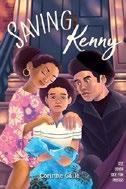
A 12-year-old African American boy living in the Boston neighborhood of Roxbury in 1968 finds ways to be true to himself and find support within a complicated family situation. When Kenny Reed’s big sister, Gwen, takes him to see the opera Aida , he becomes enamored with the Egyptian-themed production and decides he wants to become a costume designer—but he doesn’t want his big brother, Vaughn, or his mother to find out about these ambitions. The siblings constantly monitor their abusive mother’s moods to determine if it’s safe to be in the house. Soon Vaughn will graduate high school, however—and Gwen is just one year behind him—which will leave Kenny unprotected. Kenny’s thrilled to be spending the summer with his white friend Thomas Hamilton’s family in Vermont. But that invitation is rescinded after Vaughn encourages Kenny to use a fancy seafood meal he had with the Hamiltons as inspiration for a Black Panther flyer, making Thomas think Kenny’s mocking his father. Rather than going to Vermont, Kenny attends art classes at the
Afro-American Arts Academy, where he must decide between taking African drumming or sewing, which he really wants but which Vaughn says is for sissies. Debut author Gaile provides a touching, in-depth look at domestic violence, gender roles, and what it means to be a man, centered on an appealing protagonist whom readers will root for.
A thoughtful, relevant exploration of social, political, and personal upheaval through a child’s eyes. (content note, author’s note, resources) (Historical fiction. 10-14)
Gibney, Shannon | Illus. by Leeya Rose Jackson | Univ. of Minnesota (32 pp.) $17.95 | Nov. 12, 2024 | 9781517914448
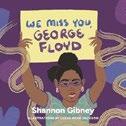
A Black child processes the loss of a neighbor, George Floyd, who was murdered by a police officer.
From its opening words, this work is unapologetic in its condemnation of Floyd’s murder. Gibney writes in simple, straightforward, and age-appropriate language: “We heard about a man who was murdered by police. Everyone was talking about it…Then the police came. They pinned him down. They didn’t listen, even when he said, ‘I can’t breathe.’ Even when he called for his mama.” The narrative doesn’t just remind readers of the senseless manner of Floyd’s death; it demands the recognition of his humanity: “He was a father, a brother, a son, a hip hop artist, a football and basketball player, and a friend.” Gibney also details the historic protests that erupted after his death and how the narrator and the entire community collectively healed and grieved. At its core, this book is also about the abolition of the police; the final words ask readers to consider “a world without police. A world without police violence. What would it feel like, sound like, look like?” The illustrations, dominated by hues of purple, capture the cacophony of
emotions that emerged in the aftermath of Floyd’s death; the depiction of tears falling from the eyes of the young narrator is especially haunting and memorable. Heavy yet cathartic. We will not forget. (Picture book. 8-10)
Gilstrap, Katie | Illus. by Lori Nichols Nancy Paulsen Books (32 pp.) $18.99 | Sept. 3, 2024 | 9780593326305

Will the titular fox kit overcome his anxiety and join his family outside their safe den?
The text’s soothing rhythm, rhymes, and near-rhymes set an appropriately tender tone from the start: “Finnegan Fox is asleep in his den. / He’s snuggled up close with his family of ten. / But now that the moon is beginning to rise, / the kits are all starting to open their eyes.” A cutaway in the earth reveals a simply drawn, softly colored family of red foxes (no teeth are visible as the parents smile benevolently). Finnegan is already subtly different, his coat a slightly lighter hue and his eyes tightly shut. When Mama announces that it’s time for the kits’ first outing, Finnegan’s seven siblings are excited, but an uncertain Finnegan whispers to Mama that he’s not ready to leave the den. So Finnegan and Mama stay home while Papa and the others venture out, occasionally returning to invite Finnegan to join them—especially for fresh raspberries by the creek. The beauty of the text—enhanced by Nichols’ stylized, gently humorous, folk art–esque illustrations—lies in the wisdom of the anxious kit’s family members. They encourage Finnegan to come outside but also give him the space and time to make that decision on his own terms. The book closes with an eloquent author’s note in which Gilstrap discusses her childhood experiences with agoraphobia. A sweet confidence builder. (Picture book. 3-7)
Goldewijk, Yorick | Illus. by Yvonne Lacet
Trans. by Laura Watkinson | Pushkin Children’s Books (256 pp.) | $13.95 paper Oct. 1, 2024 | 9781782694106

An inquisitive, offbeat, angry girl becomes a time-travel assistant in this translated Dutch import.
Cate’s mum died in childbirth 12 years ago, leaving Cate with a father who retreats into his own world, leaving her at the mercy of their overbearing, critical neighbor, Cornelia, who cleans for them and tries to get Cate to suppress her feelings. After discovering a mysterious business card her father left on their piano, Cate finds her way to a movie theater that promises “Movies Showing Nowhere!” There, Cate meets the strangely familiar Mrs. Kano, who offers her a job. But this theater doesn’t show traditional films—it gives patrons the chance to venture back to specific moments in their pasts. As Cate becomes a time-mate, accompanying visitors on their trips, she affirms her desire to remain forever curious while learning to sympathize with the people in her own life—and perhaps be kinder to herself, too. Small details threaded throughout the story join together in an ever-expanding interconnected web to deliver a clever tear-jerker of an ending. Cate’s strong sense of justice and her fear of becoming cowardly or dull combine with the pain she feels from not knowing her mother to create a compelling,
prickly veneer that explains why she lashes out at times and rings true to a preteen’s growing understanding of the world. All named characters are coded white. Lacet’s poignant art enhances the work. Quirky, original, and cathartic. (Science fiction. 10-13)
Kirkus Star
Gordon, Gia | Farrar, Straus and Giroux (272 pp.) | $17.99 Nov. 12, 2024 | 9780374392055

A tough kid earns a family. Twelve-yearold Ashley Dalton, who prefers to be called Ash, has one refuge in the world: a walnut tree in the yard of her foster mother’s rental house, where she lives along with her foster mother’s volatile son, his girlfriend, and their baby, who shares a room with Ash. Middle school, where Ash gets bullied for being unfeminine in her clothing and appearance, is scary and threatening. And then, making things worse, her new social studies teacher assigns the class to draw family trees. Ash’s past is no one’s business but her own. Eventually, with the help of her friends Gentry Noble (a gentle boy who’s lost his own mother) and Joss Cruz (a supremely cool girl who’s also concealing family secrets)—along with adults who listen to Ash, appreciate her talents, and ask the students to consider what they don’t
A finely drawn and cleanly written story that will give readers hope.
know—she finds the courage to confide in a teacher and her friends about the trouble she’s in. Gordon’s middle-grade debut is gritty, messy, and honest, with complex, nuanced characters navigating a realistically complex world that includes abuse, drug use, and homophobia. Ash’s simple request at the end—“I want to live with people who actually care about me”—feels earned, and attainable. Ash and Gentry read white, and Joss is cued Latine. A finely drawn and cleanly written story that will give readers hope. (author’s note, resources) (Fiction. 10-14)
Gravel, Elise | Chronicle Books (48 pp.) $17.99 | Oct. 29, 2024 | 9781797228204
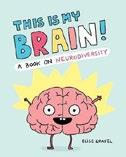
An affirmation that brains have plenty of important jobs and, often, different ways of doing them. Rightly noting that all brains “look pretty much the same,” Gravel keeps things simple, both conceptually and in her cartoon images of a pink lump resembling a “squishy [wad] of chewing gum” and kitted out with googly eyes. Brains, her cerebral narrator proclaims, have many “superpowers,” from thinking and feeling to collecting information and telling us what to do. While the brains of neurodiverse and neurotypical people may physically look similar, Gravel notes that we may learn at different speeds or in different ways; some may need help from a friend. Some of us may act or feel differently (“all our feelings are valid,” Gravel stresses), and sometimes those differences can be confusing to us or others. Still, if all brains were the same, the world would be “very boring.” Therefore, the author/illustrator concludes, we can keep our brains happy and healthy by taking proper care of our bodies and talking about our
feelings. The potato-shaped bodies in the illustrations come in a variety of sizes and colors; some wear eyeglasses or sunglasses of different styles, and one figure uses a wheelchair. A simple, wholesome message, focused more on reassurance than categorization. (Picture book. 5-7)
Gulovsen, Tracy | Illus. by Renate Vermeulen-Potter | Clavis (32 pp.)
$18.95 | Nov. 12, 2024 | 9781605379890

Ellie tries to connect with a new friend. As Ellie’s two fathers, Dad and Daddy, make dinner, Ellie draws a picture of a dinosaur that she plans to give to Dylan, a neurodiverse classmate who is partially verbal. Although Daddy expresses concern about Ellie befriending a child who “sometimes yells and throws toys,” Dad admonishes him, and Daddy quickly changes his mind. Several days later, a teary Ellie tells Dad that Dylan refuses to accept her picture or play with her. After some encouraging words from Dad, Ellie vows to try again. At the school’s open house, Ellie and her fathers meet Dylan’s parents, who thank her for her kindness to Dylan and tell her how much he values her friendship; her pictures now adorn his bedroom, and each night he lovingly caresses them. Though the author makes a laudable effort at helping neurotypical readers understand the experiences of neurodiverse children, the book falls flat. The illustrations are static, while the preachy, sentimental narrative consists mostly of Ellie unpacking her feelings about Dylan; readers never see his perspective. The story also veers into ableist tropes: Dad praises Ellie’s refusal to give up on Dylan, and Dylan’s mother tells Ellie how “lucky” he is to have her in his class—all of which sends the message that befriending a neurodiverse child should be seen as
brave or heroic. Dad and Ellie present white, while Daddy is brownskinned, and Dylan is Black. A well-intentioned attempt at exploring neurodiversity, laced with shortcomings. (Picture book. 4-8)
Gurevich, Margaret | Penguin Workshop (240 pp.) | $17.99
Oct. 15, 2024 | 9780593659434

Maya Greenspan, a sixth grader living in New Jersey, finds herself navigating her parents’ separation and school pressures, all while helping at her family’s deli and grocery store.
Maya’s dad has moved to New York City to work on his stand-up comedy career, while Maya, her mother, and Baba (her grandmother) live together above the Russian Gourmet, selling traditional Russian dishes. Driven to reunite her parents, Maya devises a plan: She’ll perform a stand-up routine at the school talent show in hopes that it will draw her father to reconnect with her and her mom. A sprinkling of Russian phrases and words throughout the text, as well as descriptions of the preparation of foods like piroshki, pelmeni, sufganiyot, and fried mashed potatoes, add to the cultural experience and immersion in Maya’s world. Themes of bullying, friendship difficulties, and mental health support are handled with sensitivity and authenticity. Budding comedians will also enjoy the humor and the useful sections that explain the process of creating a joke, along with tips for performing stand-up routines. There’s no unrealistically tidy resolution, but after a panic attack at school, Maya has an honest talk with her dad and starts seeing a therapist, where she begins receiving essential support for generalized anxiety and “OCD tendencies.” Maya’s family is Jewish. Pages from a notebook with a few family recipes follow the final chapter.
A culturally textured, heartfelt story of dislocation and growth. (mental health resources) (Fiction. 9-12)
Hale, Bruce | Illus. by Luke Séguin-Magee Penguin Workshop (160 pp.) | $7.99 paper Oct. 15, 2024 | 9780593660171
Series: The Outer Space Mystery Pizza Club, 1
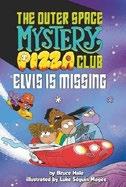
When Elvis the dog chases a strange creature through the neighborhood, an ordinary evening with the babysitter turns extraterrestrial.
Siblings Val and Mateo Garcia-Jackson, babysitter Jennica, and neighbor Booker know they’ll be in deep trouble if they don’t find Elvis before Mom and Dad get home. The only problem? Elvis has entered a portal to Boogbee City, located on Kroon, the “most awesome planet in Flooktar Nebula.” The gang enlists two friendly alien teens named Clorox and Noway to help them in their quest to rescue the beloved pup. The two don’t seem all that different from earthling adolescents, except for their pointy ears, their all-consuming obsession with pizza, and their tendency to butcher outdated Earth slang learned from old American media. The kids encounter a series of astronomical disasters along the way, from a hovercraft ride that ends in a collision with a band of broccoli smugglers to a trip inside the mouth of a giant monster that eats only once a year. Short, accessible chapters are peppered with angular, cartoonish, black-and-white illustrations, adding depth and humor to Hale’s out-ofthis-world text. Though this action-packed alien tale is light on character development, kids will surely gravitate toward it anyway. The Garcia-Jackson kids are cued Latine, while the alien teens are described as having medium brown skin. In the artwork, Booker presents
A visually compelling, compassionate look at an often-misunderstood situation.
Black, while Jennica appears brown-skinned.
A rollicking intergalactic adventure bursting with laughs and alien antics. (Science fiction. 6-8)
Heim, Alastair | Illus. by Michelle Tran Henry Holt (32 pp.) | $18.99 Oct. 22, 2024 | 9781250891419

Two friends have a silly conversation. A pale-skinned child holding a bunch of grapes meets up with an Asian-presenting friend in a park. “Is this a grape?” asks the first child. “It is shaped like a grape.” The second child agrees: “Of course. Every grape is shaped like a grape.” The first child replies, “I guess you could say it is in grape shape”—the first of many goofy puns. As the friends encounter a series of objects, the first child insists that each is a grape, or at least grape-shaped. Is that box grapeshaped? No, but what about the balloon inside? “It has to be a grape,” says the first child, “because if it were a balloon, you see, it would be raisin up in the sky.” The book takes an absurd turn as the pals visit a zoo and climb onto a giraffe (or is it a “tall-shaped grape”?) and then hitch a ride on a purple kite (a “kiteshaped grape”?). “This is a vine mess I have gotten us into,” says the first child before the two of them descend. Back at home, the second child asks why the first insisted that everything was a grape. “Because you are my friend…and I wanted you to have a grape day.” Tran’s artwork
relies on dialogue bubbles in borderless panels of varying sizes; textured, soft colors outlined in white create a cozy, charming feel. A quirky tale full of totally grape puns. (Picture book. 4-8)
Henry, Dara | Illus. by Olga Ivanov & Aleksey Ivanov | Sourcebooks Jabberwocky (40 pp.) $18.99 | Sept. 3, 2024 | 9781728284576

An unusual Hanukkah miracle.
On the first night of Hanukkah, Ruthie’s parents give her a pair of holiday-themed “pajamakkahs.” Dad says that she can wear them to the family’s “Hanukkah Pajamakkah Party” on the eighth night. Ruthie wants to wear them “all eight nights.” Mom agrees but tells her to keep them “spotless.” Despite Ruthie’s precautions, she accrues myriad stains as she helps cook latkes, lights the menorah, does arts and crafts, and crashes into a pile of jelly doughnuts. But there are no spots here, says Ruthie—just “streaks,” “splotches,” “sparkles,” and “squishes.” On the final night of Hanukkah, the whole family and even the dog sport pajamakkahs of their own. Mom’s aghast at Ruthie’s pj’s. Dad says it’s a miracle they lasted eight nights, but he sees spots. “Dotted, not spotted,” Ruthie counters. Other, racially diverse, pajama-clad family members arrive. Ruthie twirls the dreidel and, inexplicably, causes a whirlwind, upending latkes, art supplies, and more. Are those spots on Ruthie’s pajamakkahs at last? Finally, Ruthie
says, “a Hanukkah miracle!” This thinly plotted, only mildly amusing story is rife with logical holes. Even the youngest readers won’t believe Ruthie’s parents didn’t insist the badly soiled pj’s should get tossed in the washer sooner. It isn’t clear what’s so miraculous about Ruthie’s dirty jammies, and the child’s literalness wears thin. The cheerful, digitally created illustrations feature familiar Hanukkah symbols but are otherwise undistinguished. Ruthie and her immediate family are pale-skinned. An upbeat holiday tale marred by spotty logic. (Picture book. 4-7)
Hippely, Hilary Horder | Illus. by Matt James Neal Porter/Holiday House (32 pp.)
$18.99 | Oct. 15, 2024 | 9780823456666
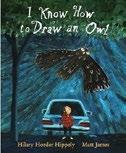
An unhoused child feels less alone in the world.
A racially diverse group of students draw owls for an art assignment. Belle’s depiction is especially praised for its lifelike quality and the wise nature behind the owl’s eyes. Little do Ms. Rio or the other students know that Belle has firsthand knowledge of owls. Belle and Mom are unhoused; Belle tells readers that one day the two of them drove far out of town to a park in their car, packed to the brim with their cherished belongings. Belle’s feelings of uncertainty were magnified by the spooky setting. Each night, Belle and Mom heard the “hooty lullaby” of an owl; one night, Belle had a close encounter with the bird. The experience brought a sense of comfort as Belle realized that someone or something was looking out for the family, as if to say, “I’m glad you’re here.” The next day at school, Belle pays it forward upon seeing a new student in a similar situation, letting the boy know he’s
not alone. Hippely’s lyrical, empathetic text complements James’ mesmerizing, at times haunting acrylic illustrations depicting vast landscapes dotted with houses and secluded natural scenes rendered with thick brush strokes in comforting dark blues and greens. Wordless double-page spreads throughout allow readers to assume Belle’s perspective and take in the child’s day-to-day feelings of uncertainty, fostering empathy along the way. Belle and Mom are tan-skinned; Ms. Rio is dark-skinned.
A visually compelling, compassionate look at an often-misunderstood situation. (Picture book. 4-7)
Hof, Marjolijn | Illus. by Annette Fienieg
Trans. by Bill Nagelkerke | Levine Querido (240 pp.) | $18.99 Oct. 15, 2024 | 9781646144532
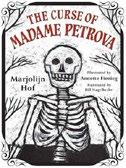
Cursed twins attempt to escape their predicted fate in this title translated from Dutch. Silke and her twin brother, Janis, were raised apart, out of their parents’ fear of a horrible prophecy made by the enigmatic Madame Petrova, who said they would kill one another. Now orphaned and brought together by greedy cousins who hope to claim the family home, they fake their deaths and flee into the woods, determined to defy their fate. Exposed to the elements and forced to poach and forage, the siblings find that surviving out in the wilderness is no easy task. To make matters worse, the adults they encounter don’t always have the best intentions, and everyone has something to hide. Who can they truly trust—and can they even trust each other? Set in historical Europe, the story is reminiscent of classic fairy tales. It succeeds in capturing the harsh realities of disadvantaged
people who are struggling to make ends meet. This title is a sequel to Hof’s Lepelsnijder, which hasn’t yet been translated into English. Although this story makes sufficient sense as a stand-alone work, some context and depth seem to be missing. The characters and their histories feel flat, and their motivations aren’t easily understood; the pacing also leaves something to be desired. The author excels in creating immersive scenes, but the prioritization of worldbuilding sometimes results in a meandering plot that often loses tension and momentum. All characters read white.
An interesting premise that falls flat in execution. (Adventure. 10-14)
$18.99 | Nov. 5, 2024 | 9781646144570
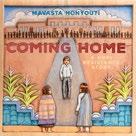
An Indigenous man passes on his culture of resilience. Renowned Hopi carver Honyouti
(Iswungwa) tells the true story of how his kwa’a (grandfather) Clyde survived the terror of residential boarding school. Despite his parents’ brave attempts to hide him from government agents, Clyde was taken to Keams Canyon, Arizona. He and the other Native children brought zassume “a good Christian name.” Yet every trauma the children endured was met with resistance. When they were punished for speaking Hopi, the kids “whispered to each other instead.” When Clyde and his friend were whipped for trying to run away from the school, they didn’t give up—they tried again to return to their families. Even the forced adoption of a new name became an act of rebellion. Though “Honyouti” became Clyde’s last name due to an
agent’s misunderstanding of his real name, Honkuku, his family takes pride in the name’s meaning: “a pack of bears that are running together.” Honyouti’s rich wood carvings, painted with acrylics, beautifully illuminate this account of ancestral pride, Indigenous power, and intergenerational memory. The text is presented in both English and Hopilavayi and concludes with backmatter about Hopi history, Parra’s work translating the story, and Honyouti’s art. This powerful tale is a much-needed reminder that the stories of Indigenous peoples, despite being threaded with trauma, are marked by defiance and pride. A stirring tribute to Hopi culture, language, and resistance.
(Picture-book biography. 6-10)
Hughes, Alison | Illus. by Ellen Rooney Orca (32 pp.) | $21.95 | Sept. 17, 2024 9781459837683
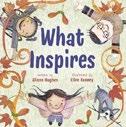
Just when you think nothing’s happening. Three friends—all dark-haired, one presenting Black and using a wheelchair, one tanskinned, one pale-skinned— visit the park one morning. Nothing’s going on. The wind rustles leaves, sending seedpods dancing. This inspires the kids to twirl. Others, inspired by the friends, also dance spontaneously. A delighted baby claps and sings; her mother joins in accompaniment. A neighbor taps a cane. The friends and other children draw instruments out of chalk on the pavement and then pretend to play them. Inspiration’s everywhere, with no signs of stopping! The kids construct a castle out of a tree and wave to a “passing ship”—children in a nearby jungle gym. A battle, chase, and parade ensue. Pausing to rest, the children look up to witness the “shifting stories” in the clouds. With the sun setting, the friends
Patrick Ness followed the voice—and found the genuine laughs—in his first middle-grade book.
BY MICHAEL SCHAUB
ZEKE, THE PROTAGONIST of Patrick Ness’ first middlegrade novel, Chronicles of a Lizard Nobody (Walker US/ Candlewick, Sept. 3), has a lot to worry about. The school’s wombat principal taps the young monitor lizard, along with his two reptile friends, Daniel and Alicia, for hall monitor duty, but Zeke soon loses the gig after punching a pelican bully who calls him fat.

The pelican, whose mother happens to be a supervillain, is in no mood to forgive and launches a reign of terror against Zeke, at one point enlisting a squadron of tiny jets to attack the nation of France, which happens to be located on Zeke’s knee. (It’s a long story.) Zeke has problems at home, too. His mother has been severely depressed ever since the death of Zeke’s father; she’s constantly accompanied by a black dog that sometimes growls when Zeke tries to get close.
Ness can relate to Zeke’s anxiety. “I was an incredibly anxious kid,” he recalls. “Looking back, I think, Oh, you poor guy. You needed some professional help. Kids worry. It’s a worrying world, and I think it would be a lie to not acknowledge that. My job is to tell the truth about what’s hard, so that when I tell the truth about what’s good, you’ll believe me.”
Chronicles of a Lizard Nobody, illustrated by Tim Miller, is the first middle-grade book from Ness, known for his novels for adults (The Crane Wife) and young adults (the award-winning Chaos Walking trilogy). Ness lives in London and Los Angeles; he talked about the new book via Zoom from LA. Our conversation has been edited for length and clarity.

what to write is the writer. Pick any genre, any age, any medium—it’s whatever the story needs. When the very silly, lovely idea for Chronicles came up, I thought, I’m not going to write it any differently. I was following a story, and what a delight it turned out to be.
creating this world that has villainous pelicans and metalhead pandas?
You’ve written for adults and young adults before, but this is your first middle-grade novel. What made you want to write for this audience?
This sounds very, very artsy, but it genuinely always begins with the idea. I’d written a couple of adult books, and then I was
working on what became the Chaos Walking series, and it revealed itself as YA. I remember making the decision, thinking, Great, great. There’s not going to be anything different in my process or my investment. It’s a core philosophy: The only one who tells the writer
Every book has a voice. This book is just voiced for a younger audience. To me, it’s very much the same process. I’m just trying to find the true voice of this story, and whether that’s a story for 15-year-olds or for adults, it’s the same process. What is true? How does the voice of the story speak so that it’s true? So the process isn’t different; it’s just this one speaks a slightly different language. It needs to, because that’s what the story is.
How did you go about
The biggest defense I have is that it makes perfect sense to me! I have a long-standing theory: There’s no such thing as a realistic novel—no such thing. It might look like our world, but it’s just as much fantasy as any fantasy novel, because it’s created. We are literally in a world made just of words. If I can embrace that, then I can tell any story I want, as long as it takes place in a world where that story makes sense. That’s the goal. That’s what I’m after in every single book. And so I thought, OK, I’ve got these monitor lizards who are hall monitors— you can see the pun —so what world makes sense? How do you make that world, and then make it feel true and touching and heart-
breaking when it needs to, and still be funny?
And the way you describe that world is so deadpan. You don’t draw attention to how crazy it is. I was a very serious child, and I did not respond well to the obnoxiously adult zaniness that adults often thought that I liked. I thought, What’s their problem? My world is much more serious than this. I also love the absolute acceptance that kids have of what is normal. So of course it’s deadpan, of course the villain is a pelican, and of course his mom is a supervillain, because that’s just what’s normal for them. It’s so much funnier and so much richer if they’ve just accepted everything as part of their
lives. My novel Burn was 1950s America, but with dragons. The idea was that dragons had just always been there, so nobody’s going to remark on them, because they’re just part of the world. That’s what I love as a reader, when a world is presented to me like that.
The humor in this book has appeal for adults, too. Was that deliberate?
It’s the language I speak, and it’s how I mostly speak to kids. I address the kids in my life with things that they might not always get, but they tend to laugh anyway. The thing about Hollywood comedies that don’t work is that they’re not written by people who think what they’re writing is funny. They’re written by people who are trying to
guess what other people will find funny, and that’s a losing game. If I tried to write jokes that I thought an 8-year-old might like, oh, what a disaster! I don’t necessarily know what 10-year-olds find funny except what I’ve been told on television. So I’m just going to write what I think is funny. And that gives me a far better chance to actually make a [young] reader laugh, because I’m laughing. The first rule of comedy is that I have to laugh when I’m writing it, or there’s no chance of your ever laughing when you read it.
Would you say that this book was more fun to write than any of your others? It was way more fun. I mean, it’s not that the book doesn’t have heartbreak and difficult
stuff, but I love these characters so much, and I want my lizards to experience the world, for all that it hurts and for all that it’s great. I wanted to keep them safe, and keep them learning, and keep them striving. That felt great. I really, really loved making a world for them.
Any plans to bring Zeke and the gang back?
It’s definitely a stand-alone book, not a serialized thing. But there’s definitely more to come. The plot of the next one is: [Zeke’s friend] Daniel wears a hat. But it’s a world where only birds seem to wear hats. So a kerfuffle ensues—let’s put it that way. It’s not any less bananas than this one, trust me. But again, it makes perfect sense to me.
Michael Schaub is a contributing writer.
The first rule of comedy is that I have to laugh when I’m writing it, or there’s no chance of your ever laughing when you read it.
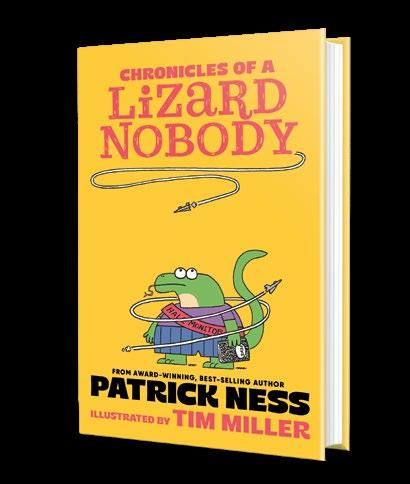
hurriedly head home, where more inspiration awaits. Marvelous ideas soon take flight in their dreams. This is an uplifting, beautifully written story about possibilities and letting creative ideas play out freely. It demonstrates that inspiration is everywhere, even in small things and moments; we need only look for it to unlock our own creative potential. The colorful, dynamic illustrations were created with pencil, textured and found papers, and digital drawing tools. Background characters are diverse. An inspired story about letting the creative spirit freely move you. (Picture book. 4-7)
Kirkus Star
Icinori | Trans. by Emilie Robert Wong Enchanted Lion Books (176 pp.) $29.95 | Nov. 19, 2024 | 9781592704231
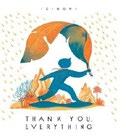
There’s much to be thankful for.
The book’s narrator—rendered in a blueish silhouette—rises and gets dressed before leaving home to follow a treasure map to something special. Along the way, our protagonist expresses thanks for a growing catalog of items and concepts, from individual colors (“Thank you, yellow / thank you, red”) to household items (“Thank you, alarm clock / Thank you, bed”) to ideas such as fear and homecoming to, finally, the colors again. Full-page illustrations highlighting single objects transition into grand, full-spread vistas and busy scenes as the protagonist traverses land, sea, and sky while the seasons pass. Paired with simple text made up of brief “thank you” sentences, the story unfolds through the elegant, textured images. It isn’t always readily apparent how some of the statements correspond to the action depicted; this is a tale that begs readers to linger
A whimsical, enriching, and deeply rewarding adventure in gratitude.
THANK YOU, EVERYTHING
and wonder about what it means to be grateful. Full comprehension will require a reread, given the sudden yet subtle and purely visual story developments, but the beauty of the artwork makes it well worth the journey. A limited but vivid palette of primary colors simultaneously soothes with its blues and energizes with its red and yellows, creating an aesthetically pleasing, thought-provoking, and engaging experience. A whimsical, enriching, and deeply rewarding adventure in gratitude. (Picture book. 4-8)
Imperi, Cole | Illus. by Bianca Jagoe Kids Can (200 pp.) | $18.99 Oct. 1, 2024 | 9781525309656
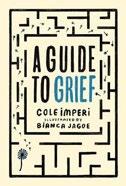
Advice on coping with loss, from the death of a family member or a close friend to a beloved pet’s demise to life-changing events such as divorce.
Imperi, a chaplain and thanatologist (“someone who knows about death, dying, grief and loss”), uses her own terminology to distinguish between “deathloss” (“when a person or an animal we love dies”) and “shadowloss” (“the death of something, not some one ”). These categories make sense, but kids grieving the death of a loved one may find it difficult to wade through sections about other serious problems. Although the recent pandemic caused many actual deaths, this book describes Covid as a shadowloss, a disrupter of normal life. Imperi
mentions a few religious traditions, but the book is primarily concerned with practical ideas and individual experiences. Specific thinking, writing, and creative exercises for moving through the grief process are included. She spotlights five diverse teens, along with their coping strategies for different types of loss; they appear to be composite portraits rather than real individuals. The black-and-white line illustrations and charts throughout will appeal to some, but the boxed affirmations on many pages may feel repetitive to others; the work overall feels a bit like an expanded magazine article. Still, patient readers will likely find guidance—and reassurance. Potentially useful insights for youngsters encountering loss. (grief journal, glossary, note for caregivers, resources, references, index) (Nonfiction. 11-14)
Jarvis | Candlewick (65 pp.) | $15.99
Sept. 10, 2024 | 9781536235449
Series: Bear and Bird, 3
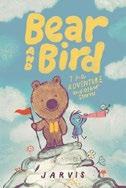
BFFs Bird and Bear continue to care for each other. Bird is ill, so Bear kindly provides “chips, chewy things, soup, custard, beans, [and] a cheese soufflé.” He also offers to read
The Complete History of Spoons (and to do “all the voices”) and to perform “The Dance.” Bird, wrapped in a blanket and looking peaked, politely
declines. Bird wants “nothing,” but as Bear leaves, discouraged, she asks, “Could you do nothing here with me?”
Bear is delighted: “It’s one of the things I’m best at.” By the next story, Bird has recovered, but on a cloudwatching walk, the pals find a hole with a sign: “DO NOT GO IN THE HOLE.” The friends end up separated. Bird erroneously comes to believe that Bear is in the hole and, while trying to extricate him, falls in herself. Luckily Bear is nearby and comes to the rescue. In “The Mole,” a new character arrives and threatens Bird and Bear’s pair-bond. Jealous Bird tries rude behavior to get Mole to leave. When that only makes Mole laugh, she mocks Bear to get more laughs, and Bear leaves—until the two set things right. In the final tale, Bear and Bird salvage a dud day through cheerful goodwill. Once more, Jarvis expertly weaves humor and heart into these friendship tales, resulting in a work that’s sweet yet never overly sentimental, brought to life by quirky illustrations. The ups and downs of friendship, delivered with wit and whimsy. (Chapter book. 5-9)
$17.99 | Nov. 5, 2024 | 9780593650431
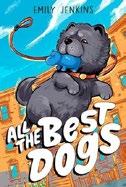
Every dog lover thinks their dog is the best in the universe, writes Jenkins in this cozy neighborhood tale…and they’re all correct.
Displaying sharp insight into how both pets and middle schoolers see the world, the author spins interwoven storylines around regular visitors to a Brooklyn dog run. In this safe social space, friendship crises, beloved companions lost and found, tempests emotional and digestive, and new family arrangements play out in benign ways over the course of one June weekend.
Narrated in third person, the book follows a bevy of canine and human characters, giving readers true-to-life glimpses of both viewpoints. The canine cast outnumbers the racially diverse human one and is large enough to necessitate an occasional flip back to Preitano’s opening gallery for a refresher. Still, in both the narrative and in the informal ink-and-wash scenes, generously distributed throughout, the dogs— from 50-pound puppy Cup-Cup to three-legged, “corgi adjacent” Panda—are as individualized in looks and temperament as their two-legged devotees. Free of tragedy if not occasional tears, guilty secrets, and moments of distress, this buoyant outing delivers nicely on a reassuring authorial promise at the outset that things will turn out well. Final art not seen.
A real good, feel-good, doggy delight. (Fiction. 9-11)
Ed. by Johnson, Leah | Freedom Fire/ Disney (320 pp.) | $18.99 Nov. 12, 2024 | 9781368098960

Acclaimed authors share 15 diverse stories that showcase the strength and humanity of Black girls who are facing a variety of challenges. This anthology, composed of stand-alone entries, spans multiple genres, including realistic fiction, fabulism, and fantasy. Readers meet middle school girls who are dealing with universal issues, such as family expectations, grief and loss, friendship troubles, bullying, and fear of rejection, plus some that are specific to being a Black girl. The stories overwhelmingly refute monolithic stereotypes, instead celebrating the girls’ creative
problem-solving, sense of humor, openness to learning and growth, strong family and community relationships, and powers of imagination. Some authors tell stories of ordinary moments that are transformed by courage, as in “The New Rules” by Elise Bryant, “An Aria for Abi” by Tọ lá Okogwu, “The Sleepover” by Kekla Magoon, and “Rice & Beans, Rhythm & Beats” by Ibi Zoboi. Others tell stories that take place in intriguing settings, like “First Bite” by Dhonielle Clayton and “Crème de la Crème” by Roseanne A. Brown. Whether the subject matter is serious, as in Sharon M. Draper’s “The Last Chocolate Cookie,” mysterious, as in Natasha Díaz’s “One of Those Days,” or heartwarming, as in Kalynn Bayron’s “Auntie Ro,” each chapter is a gift for readers to discover. The empowering messages of self-acceptance are perfectly encapsulated in Renée Watson’s powerful poem “Black Girl, Be.”
Electric: bequeaths confidencebuilding stories that sizzle with wisdom and a little bit of magic. (author bios) (Anthology. 9-14)
Joyce, William | Caitlyn Dlouhy/ Atheneum (48 pp.) | $18.99 Nov. 5, 2024 | 9781665961332

Can flying puppies, fueled by people’s hugs, save the world from gloom?
Light-skinned Snarly McBummerpants is busy sending out Mopey Smokes (evil-looking dark brown clouds) from his volcano on the Island of Woe to create a sad state of affairs. But the caped puppies, each equipped with a rocket and hailing from “the outer reaches of NOT-FROM-HERE,” use their abilities to conquer the morose McBummerpants and bring happiness back to everyone’s lives. The meticulously detailed illustrations carry the story, dark colors turning to
rainbow hues and frowns turning to smiles. From Big Brad to Tiny Brad, the smallest, most powerful puppy, who “[licks] a kiss right on the tip of Snarly McBummerpants’s nose,” these absolutely endearing pooches elicit a universal “AWWWWWWWWWW!” from all who encounter them. Joyce’s witty illustrations depict diverse children and adults who appear to hail from different decades. Two teenagers wear the bobby socks and saddle shoes of the 1940s and ’50s and sit atop a retro soda cooler. Other kids ride the skateboards of a later era. Laurel and Hardy, classic movie performers who may need introduction, are amusingly pictured as bullies turned florists (a little odd, since only Hardy bullied Laurel). Even McBummerpants seems reminiscent of an old-time movie villain. The text is less inventive than the pictures, but the message of good over evil is always timely.
Powered by whimsy and nostalgia, a doggone adorable tale of superheroes transforming the world for the better. (Picture book. 4-7)
Kaepernick, Colin & Nessa Diab Illus. by Gladys Jose | Scholastic (40 pp.) $18.99 | Oct. 1, 2024 | 9781339042947
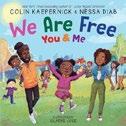
Activist and athlete Kaepernick and his partner, radio and TV personality Diab, introduce young readers to the idea of universal rights. Positive affirmations abound as children are told about their various freedoms: to move and play, to be safe, to live, to speak, and even to grow. Jose’s illustrations follow two young Black children taking part in a variety of activities alongside members of their diverse community: building a playground, painting a mural featuring an image of Malcolm X, playing music and dancing, and protesting in front of a school. Writing in rhyming verse, the authors
set an optimistic tone: “Your truth is your strength, like the roots of a tree.” They acknowledge that “life can be tough, and not always fair” but urge young readers to persist. The cartoonish visuals tend toward the predictable, often directly reflecting the text; as the authors encourage youngsters to “weather the storm on your path and not stray,” the accompanying images show a child gazing up at dark clouds and hunkering down under a folded newspaper held by a loving parent. Still, Kaepernick and Diab’s simple but resonant words are ideal for sparking conversation among youngsters. In their authors’ note, they discuss Know Your Rights Camp, the nonprofit they founded to further the well-being of Black and brown communities; the book ends with the organization’s 10 tenets. An upbeat and informative book for the next generation’s littlest leaders. (Picture book. 4-8)
Katzenberger, Lisa | Illus. by Miss Diabetes | Clarion/HarperCollins (48 pp.) $19.99 | Oct. 29, 2024 | 9780063236677

A simply told tale of how dedication and painstaking work led to the discovery of a treatment for a devastating autoimmune disorder. This exploration of the achievements of scientist Frederick Banting doesn’t explain the difference between Type 1 and Type 2 diabetes until the glossary and never mentions gestational or other types of diabetes at all. And some readers may be put off by descriptions of how his research involved removing pancreases from healthy dogs, especially given the author’s earlier, insistent references to Banting’s youthful love of farm animals. What does come through clearly, however, is his stubborn persistence (following a late-night
Eureka! moment about a new approach) in working with colleagues to find a way to isolate the pancreatic hormone he eventually dubbed “insulin,” as well as the laudable altruism that led him to pass up big bucks and give away the formula with the titular comment. Along with an indignant complaint about the unjustly high cost of insulin today, the author leaves readers with simple descriptions of the nature of Type 1 diabetes and the mechanism of insulin. In the simply drawn illustrations, the small bottles of medication, the green blood sugar indicators floating above the heads of joyful former patients, and even the lab dogs are depicted with smiling faces. Though major figures are white, brown faces mingle with lighter ones in most of the other lab and outdoor group scenes. Sugary but significant, despite its somewhat unsystematic presentation. (author’s and illustrator’s notes, bibliography) (Picture-book biography. 7-9)
Kendrick, Erika J. | Little, Brown (336 pp.) $16.99 | Oct. 1, 2024 | 9780316566025

Twelve-year-old Lyric Whitney Houston Darby feels destined to be a star. Her best friends, Saanvi Patel and Georgia Reign, support her every step of the way. Her mother found fame with her band (called Love, Jade), and Lyric feels that now is her chance to do the same. The next competition for the TV show American Rockstar will be in her hometown of Santa Monica, California. Her mother insists that the show exploits young people and offers them unfair contracts, but Lyric is determined and secretly takes the steps necessary to enter. For example, getting cast as Dorothy in her school’s production of The Wiz meets the “experience” requirement for entry. But as Lyric works to grow her
social media following, she quickly learns the true cost of fame as she gets wrapped up in stardom and begins to neglect important parts of her life. Witty prose and modern preteen slang make this an enjoyable and entertaining read. Readers get a glimpse into the life of a girl who, despite all the positives in her life, still grapples with “mental monsters.” Kendrick discusses therapy and the importance of protecting your mental health, as well as being your true self and a good friend. Lyric’s mom is Black, and her dad is white; there’s ample racial diversity in the supporting cast. A relatable story of navigating ambition and relationships, with valuable mental health representation. (Fiction. 8-12)
Kinew, Wab | Illus. by Erin Hill Tundra Books (48 pp.) | $18.99 Oct. 8, 2024 | 9781774883570

Kinew (Onigaming First Nation), premier of Manitoba, tells the story of a Native family returning home to the reservation on the winter solstice.
Baby, an Anishinaabe child, doesn’t want to go back to the rez for Christmas: How will Santa find the family if they aren’t in the city? On the drive into the country, Baby’s pressing concerns fill the car: Why are presents exchanged on Christmas? Why is the rez “home” if they don’t live there? Baby’s parents, who both have tan skin and black hair like Baby, answer each question by centering Anishinaabe language and values: Daddy explains that miigiwe
means “giving away,” while Mommy says that giiwedaa (“let’s go home”) reflects the Anishinaabe reality that “home is where we live. But home is also where we come from.” The tender reunion with Kookom (Grandmother) and Mooshom (Grandfather) includes storytelling, sipping tea and eating bannock, singing, and giving gifts. Indigenous illustrator Hill’s cartoon art brings warmth and heart to Kinew’s simple narrative. Backmatter briefly spotlights the Anishinaabe customs of sharing food and gifts during the winter solstice, as well as the community’s reclamation of feasting and miigiwe at the end of the year. The sense of cultural pride and holiday joy will resonate with many young readers and their families.
A sweet window into Indigenous Christmas traditions. (Picture book. 4-7)
In the Winter Woods
Kulot, Daniela | Trans. by Elizabeth Lauffer | Charlesbridge (32 pp.) $17.99 | Oct. 15, 2024 | 9781623544959
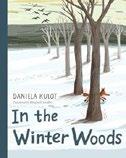
Fox, Mouse, and Crow wander the winter woods, looking for food, but there is none. As the animals search for sustenance, a refrain reminds readers, “But it’s winter, and winter is not willing to share.” Squirrel, the only animal who has stockpiled food, pipes up: “Have to dash and find my stash.” Overhearing him, the other animals feel he should share his bounty, but selfish Squirrel is unwilling to do so. Unfortunately, Squirrel’s unable to remember where he hid his food, so he returns to the threesome, promising to share if
they’ll help him find it. Crow and Mouse are miffed: “Now that you can’t find your stash, you come running back.” Fox points out that they must all cooperate if they want to succeed, and the foursome search together. Translated from German, the writing feels a bit off-kilter in its attempts at a colloquial sound (“Gosh-double-deerdung-darn-it, she is so hungry!”). The animals themselves are cartoonishly executed, but the painterly winter scenes created digitally, full of trees with empty, curving branches in subtle shades of brown and gray, are quite splendid. Though the lesson is heavyhanded and the story less than original, the book is aided by the attractive artwork and might make a good option for classrooms in need of titles for social-emotional learning and winter season units.
Preachy messaging about the value of sharing, uplifted by dazzling visuals. (Picture book. 4-6)
Larsen, Andrew | Illus. by Oriol Vidal Sourcebooks eXplore (40 pp.) | $18.99 Sept. 10, 2024 | 9781728283517

A tribute to a New York City sanitation worker who salvaged a museum’s worth of treasures from the trash. Though actual glimpses of the thousands of antique toys, old family portraits, and other evocative artifacts that Nelson Molina gathered over the course of his long career are limited to a paltry few photos at the end, his message that our castoff junk is rich in things that can be usefully recycled or upcycled comes through strongly in this brief biographical account. Following an appeal from Molina himself to search for the beauty and value in everything, even garbage, Larsen looks back to his subject’s youth in East Harlem. The author links the pleasure that Molina
Truly, you don’t need words to tell a great (and all-too-relatable) dog tale.
took in building birdhouses from discarded bits of lumber and repairing a broken toy truck for his little brother to later years on the job—arranging reclaimed items first in a locker room and then expanding into larger quarters as the first few finds grew into thousands. Vidal’s tidy, pleasant scenes of Molina hauling trash and sifting through garbage are implausibly clean and uncrowded. Still, suggestions for personal ways to “Reduce, Reuse, Recycle, and Rethink” at the end invite readers to carry on the good work. Molina writes that his parents were from Puerto Rico; figures in group scenes are racially diverse. Bags up a worthy takeaway about finding beauty in the most unlikely of places. (Picture-book biography. 6-8)
Lee, Avione | Simon & Schuster (352 pp.) $18.99 | Oct. 15, 2024 | 9781665939058
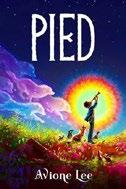
An accidental encounter turns a child’s world upside down. Eleven-year-old Rim Wickford is an oddity among his military school classmates: He’s often surrounded by animals that are acting strangely, he can’t see colors other than gray, and his uncle forbids him to have anything to do with music. But when he inadvertently hears the sound of a pipe, Rim can’t resist playing it, unleashing an explosion of color and chaos. Rim’s uncle finally accepts that he can no longer keep Rim from knowing his true identity as a Piper, or someone who “can control any living thing with just a
note, a beat, a rhythm.” This turn of events ushers in a series of fantastical sights and magical tests, a slew of newfound friends and enemies, and some in-depth exposition. The author is bursting with ideas—readers motivated by worldbuilding will savor the details, while others will be bogged down by the lengthy explication. The cozythird-person narration lends the story a classic feel, but the skimpy character development limits its emotional impact. Biracial Rim, who had parents who are cued as having been Black and white, is likable enough, but his motivations are often unclear. The supporting characters are painted in broad, predictable strokes, and some awkward word choices and sentence constructions may trip readers up. Ultimately, this installment ends with more questions than answers.
An ambitious debut that doesn’t quite land. (Fantasy. 10-12)
Lourenço, Estrela | Page Street (40 pp.)
$18.99 | May 14, 2024 | 9781645678717

Misery and affection go hand in hand when it comes to taking your pup out for walkies.
Upon returning home from walking the dog, all a kid wants is to get into dry clothes and play some computer games. The child’s overexcited pup has different plans, however. After the dog gets tangled in the electrical cords and knocks the computer over, the child dons a raincoat once more and takes the pooch out into the miserable weather again. The youngster is less than
pleased. The pup, in contrast, is ecstatic. Initially aggrieved, the kid begins to slow down and notice the beauty of the natural world. Things might be wet, messy, muddy, and slick, but sometimes it takes a canine to show what’s already in front of your eyes. In this entirely wordless tale, Lourenço evinces emotion on the page with admirable acuity. Both the child, who has paper-white skin, and the dog vie equally for readers’ sympathies at the beginning. Colors, like the yellow of the rain slicker or the vibrant red of the leash, pop magnificently when presented against the blue gloom of the day, the hues brightening in tandem with the kid’s mood. This is a natural successor to Doug Salati’s Caldecott-winning Hot Dog (2022). Truly, you don’t need words to tell a great (and all-too-relatable) dog tale. (Picture book. 3-6)
Lu, Shaina | Quill Tree Books/ HarperCollins (224 pp.) | $15.99 paper Oct. 15, 2024 | 9780063283404

Two kids try to save their beloved neighborhood from gentrification.
“This is a love story between people…and a town.” Momo grew up in Town 99. Her favorite place to eat, Noodle & Bao, belongs to Noodle, her best friend Bao’s grandmother. When the landlord sold the building, Noodle had to close the restaurant and instead open a food cart. Bao says the business is struggling. Ms. Jujube, the white-presenting owner of Fancé Café, the restaurant that took their place, is trying to force them out. Momo also notices changes—higher rent, “shiny new stores and big buildings appearing,” and neighbors moving away. Then Fancé Café’s owner announces that she’s opening Fancé Hotel, which she says will transform the “dirty old neighborhood.” Momo and Bao try everything they can think of to
protect Town 99—it isn’t easy, but gathering everyone together is the only way to protect their neighborhood. This fantasy world, which is populated with humans and anthropomorphized animals, is based on the real history of American Chinatowns and the struggles of community organizations against gentrification. Lu uses light humor to tell the story in an accessible way. Informative backmatter offers additional context. Illustrated in black and white accentuated by shades of salmon, the charming, whimsical illustrations highlight the food and various neighborhood details. Noodle is Taiwanese, and her dialogue is written in English and traditional Chinese characters; Momo’s family and some other characters use English and romanized Cantonese.
An empowering combination of food, humor, and advocacy. (Graphic fiction. 8-12)
Kirkus Star
Lubner, Susan | Illus. by Blythe Russo Pixel+Ink (64 pp.) | $14.99 | Nov. 5, 2024 9781645951162 | Series: Drag and Rex

Those irresistible besties are back. Drag and Rex, introduced in Forever Friends (2023), are back to being their helpful selves in the duo’s second series of comical adventures. Laid-back, literalminded Drag is a usually exasperating and very slow-on-the-uptake, fire-breathing dragon, while Rex is a practical, conservatively dressed, fastidious, square-faced, short-armed, uber-patient T. rex. Like their first outing, this offering features three stories, each comprising three short, very humorous, dialogue-laden chapters that winningly reveal the friends’ quirky personalities, their mutual love and respect, and their understanding of each other’s personal idiosyncrasies. In the first story, about Valentine’s Day
gift-giving, Rex demonstrates extreme forbearance when Drag hands him a box of “already eaten” chocolates. The second tale reveals the importance of the letter N when Drag sets out to prepare “oodles” for dinner. The final entry involves ways to help friends remember important things. This aptly named book will have young readers chuckling—and doing some face-palming. Drag and Rex are extremely charming, endearing characters whom anyone would want to have as pals, and kids will delight in joining them on their new adventures. The colorful, dynamic illustrations illuminate the friends’ warm, cozy relationship.
Children
Lundberg, Sara | Trans. by B.J. Woodstein | Eerdmans (66 pp.)
$18.99 | Oct. 8, 2024 | 9780802856333
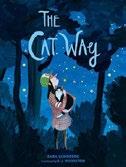
Stepping outside of one’s routine brings new experiences. An unnamed, pink-skinned human, clad in a plaid shirt and green trucker hat, and a black-and-white cat go for their usual walk. When the cat begins romping with another feline, the human decides it’s time to go. “Why are you always in charge?” asks the chagrined cat, and the human devolves into an existential crisis before coming to a decision: The next walk will be led by the cat. The following day, the human experiences life through the cat’s eyes as she chases butterflies and squirrels into a densely wooded area. The
human, finding it difficult to see amid the brambles, falls off a small cliff: “I don’t want to be here anymore.” As the cat comforts her owner, the human marvels at the night sky, filled with luminous yellow stars, shown in a gatefold spread, and realizes that it’s OK to take the “usual route” but also necessary to “get lost” sometimes. Lundberg sets her story in a surreal setting that’s grounded in reality (the apartment complex echoes an M.C. Escher painting in one particularly mournful spread), and many human characters have elongated limbs. The stunning, saturated watercolor and gouache illustrations, in tandem with the thought-provoking text, translated from Swedish, chart the emotional journey of both human and cat as they discover that changing things up can result in fresh perspectives.
A lovingly told exploration of compromise that leads to a new outlook on life. (Picture book. 4-7)
Lyons, Erica | Illus. by Siona Benjamin Levine Querido (40 pp.) | $18.99 Sept. 3, 2024 | 9781646144341

A grandmother tells her granddaughter about their ancestors, who fled Israel for India nearly 2,000 years ago. In 175 BCE, as Nani Penkar explains to young Maya, many Jews fought back against the Greek tyrant Antiochus, who ruled over Israel. Others—who became known as the Bene Israel—fled by ship. Their vessel was destroyed by a storm at sea; nearly everyone was killed, except for seven men and seven women who were rescued by Eliyahu HaNavi (the Old
An empowering combination of food, humor, and advocacy.
NOODLE & BAO
Testament prophet Elijah) and founded a community in their new home. Nani Penkar adds that Eliyahu HaNavi later appeared on a “flaming chariot” to tell the Bene Israel that they would one day return home. To mark the anniversary of this day, the Bene Israel prepare malida, a dish consisting of flattened rice, coconut, and fruit, and gather at Elijah Rock, where Eliyahu HaNavi is said to have come down from the heavens. Paired with matter-of-fact text, the intensely colored multimedia illustrations vividly highlight the stories of the past and the people who maintained their religious traditions while incorporating Indian customs into their daily lives (for example, speaking the Marathi language). A helpful author’s note explains that most Bene Israel have left India for other countries; Lyons also discusses other Jewish communities in India. A visually enticing testament to the diversity of Jewish life. (glossary) (Informational picture book. 6-9)
Kirkus Star
Beware the Dragon and the Nozzlewock: A Graphic Novel Poetry Collection Full of Surprising Characters!
Madan, Vikram | Wordsong/Astra Books for Young Readers (128 pp.) $19.99 | Nov. 12, 2024 | 9781635928174
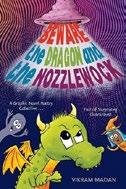
A new gathering of hazards and cautions in rollicking verse from the author of Hatful of Dragons (2020). A dragon smart enough to see through a knight’s “I DO NOT seek your gold!” might
seem fearful enough. But Madan’s collection of poetry, presented in comics format, features plenty of formidable characters, from the boneless “Squishosaurs” (“We glide across the countryside / And in our viscous wake, / The T. Rexes trudge terrified, / Velociraptors quake!”) to a young witch with a lucrative line of ghost pets. Perhaps worst of all is the Nozzlewock, which writhes its way into several poems to suck up the unwary with its prodigious proboscis: “Beware the Nozzlewock, my child! / The nose with super-vacuum strength!” Sharpeyed readers will find further visual links between various poems, as when a janitor’s “Little Oopsie” in a secret laboratory that “messed up time and space” goes on to turn a young explorer into a flaming “super-gal.” In varied but consistently tight verses accompanying expressive cartoon images depicting a diverse cast, Madan also trots in other memorable fancies, from a theatrical chorus line of grown-ups singing away a beleaguered child’s “Bad-Luck Bogeys” to a mummy happily joining a zombie rock band called the Rolling Moans, on the way to a gloriously glutinous finale in which a group of intrepid children tickle the Nozzlewock into a mighty sneeze of its own.
Juicy, joyful, and just right for reading aloud, too. (Graphic poetry. 6-10
Marks, Janae | Harper/HarperCollins (256 pp.)
$19.99 | Oct. 1, 2024 | 9780063212367
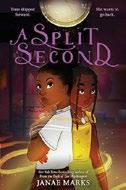
Two girls examine the shifting landscape of their friendship while trying to undo a magical spell.
Elise is celebrating her 12th birthday at a
fall carnival with her two best friends, Melinda and Ivy, when she sees Cora, someone she used to be close to. Cora tries to speak to her, but Melinda and Ivy pull Elise away. As the three girls settle in for a birthday sleepover, Elise’s mom gives her a bag that was left on their porch. Inside is a box containing a beautiful necklace with a silver locket that reveals a tiny clock. When Elise wakes up, she finds that her friends are gone, six months have passed, and she can’t remember anything since October. She arrives at school, only to find that Melinda and Ivy are mad at her but won’t say why. She also learns that Cora gave her the locket and has an identical one—she missed Elise and used a magic spell that caused them both to time jump. Now the girls must work together to solve the mystery and put things right. Elise and Cora, who are cued Black, have a relationship that feels unevenly developed at times but ultimately solidifies as the plot unfurls and their characters are fleshed out. This story, which will appeal to fans of light magical tales, also thoughtfully delves into the consequences of the social isolation many young people experienced during the Covid-19 pandemic.
A nuanced look at middle school friendships. (Time travel mystery. 9-13)
Electrica: The Guardians of the North Maxwell, Antonia | Illus. by Cecilia Bennett | Neem Tree Press (288 pp.)
$14.95 paper | Oct. 22, 2024
9781915584113 | Series: Terra Electrica, 1
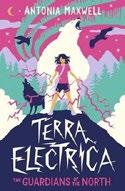
A girl journeys across a changed landscape in search of her father. Mani has been alone in a cave, waiting for her father to return, for nearly a month. At last, hunger forces her out, and she finds Dr. Leopold MacKintosh, the one remaining scientist at a research station. They discover that
Mani has the disease that has killed so many, but she isn’t sickened by it and may hold a cure. Leo becomes determined that they should go to the Ark, a scientific organization whose mission is “to use science to save the world.” He convinces her that they’ll find her father along the way. The journey is filled with dangerous obstacles, but they meet a girl called Tilde, who accompanies them after saving them from an angry mob who fear being infected. Throughout, Mani uses a carved, feathered mask to connect to another world, gaining comfort and strength from Ooshaka, her polar bear who’s the “best of all the spirit animals.” Only when they reach the Ark does Leo finally realize his mistake: “She’s a child, not an ‘asset,’ not a ‘discovery.’” Mani is a reluctant hero who’s doubly gifted: She can heal others from disease, and she can travel between two worlds. This series opener is a high-stakes adventure that unfortunately depicts Mani and her people in ways that evoke outdated fictional versions of the cultures of real Native peoples. Propulsive climate fiction marred by problematic use of Indigenous cultural elements. (map) (Dystopian. 10-14)
McAnulty, Stacy | Random House (352 pp.) | $17.99 | Oct. 1, 2024 9780593429662 | Series: The Evers, 2
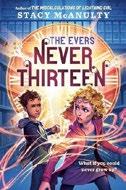
In this sequel to Forever Twelve (2023), the Evers face threats from their own kind and from seers. The book opens with Abigail giving Ivy a deadline for finding a way to become mortal again, Ronan learning more about the conflict between seers and
shadow people, and Juliet appearing at Gigi’s funeral. Most of the story takes place at West Archer Academy. Ivy and Abigail find a clue in Grace’s notebooks that leads them to the Ever who turned Grace mortal, and Ivy learns that there is indeed a second way to become mortal—but it’s as unthinkable as the first. In flashbacks, Este tells Ivy more about her past. Ronan’s family of seers discovers that he’s associating with shadow people at school, and they threaten to destroy them. Each of the Evers wrestles, rather repetitively, with their immortality—what it means to keep it, and what it means to relinquish it—knowing costs are involved, both for themselves and for others in the chain. For Ivy and Abigail, a theme throughout the story is the tension between providing mutual help and seeing the other as an enemy. Following a dramatic clash between Ronan’s family and the Evers, the conclusion feels satisfying, but in order to get there, the audience must first navigate a hectic and overly stuffed narrative. Readers need to be familiar with the earlier volume to follow events in this entry.
A busy plot that circles the same central problem. (cast list) (Fantasy. 9-13)
Meadows, Jodi | Holiday House (304 pp.)
$18.99 | Oct. 22, 2024 | 9780823456383
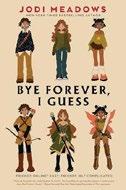
Thirteen-year-old Ingrid never wanted to be anything but invisible. In person, Ingrid Ant is shy, introverted, and content to let her
A timely, basic, and refreshingly frank overview.
real-life best friend, Rachel Allan, have the spotlight. But online, her Scrollr page “Bye Forever, I Guess” is ridiculously popular. Known as Anony Mouse on Scrollr, Ingrid maintains her anonymity and keeps her popularity under wraps while sharing the hilarious wrong number texts she receives. Ingrid’s life is a careful balance of school, a largely nonexistent social life, posting to Scrollr, and playing her favorite MMORPG, Ancient Tomes Online, with her online best friend, Lorren Watson, who lives in Michigan, far from Ingrid in Virginia; the two have never met in person. When a new family moves to town, Ingrid’s awkwardness causes a rift with her friend group. Lonely and isolated, Ingrid finds that a new wrong number text blossoms into a desperately needed friendship. This mysterious texter—known only by his ATO username, Traveler—gives her a chance to not only make a new friend, but to find her way forward after being isolated by her peers. And who knows—maybe this chance wrong-number encounter will turn into something beyond friendship. This online-savvy tale of friendship uses text message chains to add a digital dimension that perfectly matches Ingrid’s life. Ingrid’s experiences with navigating middle school, friendships, and the online world provide important lessons about online safety and boundary setting in relationships. Characters largely present white. Charming, funny, and endearing. (Fiction. 10-14)
Mihaly, Christy | Illus. by Doruntina Beqiraj | Whitman (32 pp.) | $18.99 Sept. 5, 2024 | 9780807512401

A ghostly cat and other residents of the U.S. Capitol give a newly elected representative’s
This review originally ran in the April 15, 2024, issue.
How far can YOU go?
Vern loves the playground swings, but he usually sits, letting the chains twist and spin him around, or lies stomach-first on the seat. He can’t soar like the other kids. When other children taunt him, he contorts his body in vain, ordering his legs to pump. Then a girl named Gretchen asks if he wants to learn. He painstakingly follows her instructions, and she stays with Vern, not letting him quit, until she finally must leave. Though tempted to give up,
Vern persists—and then… he PUMPS, touches the sky, and joins the birds! Earthbound again, Vern hears a small boy wistfully tell him he wishes he could pump. Guess who’s the expert now? Aiming skyward on a swing is, of course, a metaphor for attempting to reach any goal; the reassuring message in this dynamic, fast-paced tale: Don’t quit, keep trying, and you’ll succeed. Throughout, Lucianovic demonstrates a keen, child-friendly understanding of what it’s like to
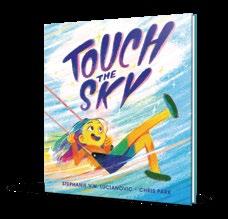
master a new skill: “It feels hard until you get it, and then it’s not.” The energetic, loosely drawn mixed-media illustrations zing with color. Amid all this fun, characters’ hair and skin shades are fancifully depicted, though hair textures suggest that
Lucianovic, Stephanie V.W.; illus. by Chris Park
Carolrhoda | 32 pp.
$18.99 | May 7, 2024 9781728460451
some characters might be people of color. Creative typesetting wizardry, with words and action lines “swinging” everywhere, emphasize the action. Swing by the zesty endpapers. It’s swing, hit, and no miss with this rip-roaring charmer. (Picture book. 4-7)


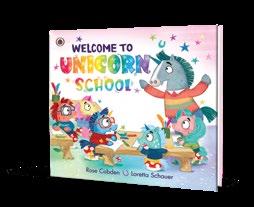

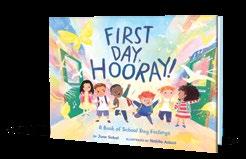


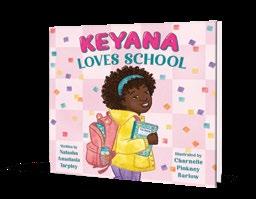
A
VOICE IN THE STORM
young daughter an introduction to Congress.
Left to her own devices while Mom takes care of official business, Alice finds a series of friendly tour guides— including the specters of a cat, James Madison, and Blanche Bruce, the first Black senator to serve a full term— who take her around the building and fill her in on the party and electoral systems, the jobs of each of the three branches as defined by the Constitution, and the legislative process. If Madison’s assertions that “we don’t put one person in charge of everything” and that only Congress makes laws “and even the president must follow them” will have ironic rings to readers up on current events (or, for that matter, U.S. history), such claims do at least indicate how the federal government is supposed to work. At times, though, the book offers a look at some harsher realities: A chart showing how bills become law includes some of the many ways a bill can die, Mihaly gives a nod toward the long struggle for equal voting rights for all, and the book provides a straightforward recap of the events of January 6, 2021. In the neatly drawn graphic panels, Alice (brown-skinned like her mother) encounters racially diverse groups of tourists, officials, and workers, including people who use wheelchairs. A timely, basic, and, at least in spots, refreshingly frank overview. (glossary, facts about Congress, congressional firsts) (Informational picture book. 7-9)

Miles, Brenda S. | Illus. by Monika Filipina Magination/American Psychological Association (32 pp.) | $17.99 Oct. 8, 2024 | 9781433843662

So many options. What’s Waffle to do?
A bespectacled, pigtailed waffle has trouble making decisions. Even if the choices at hand aren’t that important, she, well, waffles. For Waffle, “most decisions feel big and forever.” Her indecisiveness has consequences. Taking too long to pick out a pair of socks results in Waffle being late for school. When she dawdles at the ice cream counter, nearly all of the flavors eventually run out. So Waffle devises a plan: She selects a school outfit from her closet with her eyes closed. Oops: She’s picked out beachwear. She tries copying what everyone else is doing and asking all her friends for guidance (“I’ll mix all their ideas together… so I don’t have to decide”); neither approach works. Eventually, looking through her telescope gives Waffle her best idea: She learns to narrow down choices to make them manageable. Along the way, Waffle picks up a few tips. Getting more information can be helpful in the process, as is the knowledge that sometimes “either choice is fine” and “many decisions aren’t forever.” This sympathetic, bibliotherapeutic story, written by a clinical pediatric neuropsychologist, will resonate with children who have problems making decisions. Parents will appreciate both the narrative and
the closing note, the latter providing clear, useful guidance and tips for caregivers. The images of anthropomorphic foodstuffs— with cartoonishly large bodies perched atop skinny legs—leaven a serious topic.
Readers will have no difficulty in deciding to read this book; it’s a good, helpful choice. (Picture book. 4-7)
Miller, Debbie S. | Illus. by Michelle Jing Chan | Bloomsbury (32 pp.)
$18.99 | Oct. 1, 2024 | 9781681191997
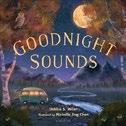
Who says bedtime must be quiet?
Not the pale-skinned young narrator of this noisy nighttime story. Gazing out the window at the nearby Golden Gate Bridge, the child soon falls asleep to the sounds of the foghorn. Readers are asked what sounds help them nod off; the narrator offers a litany of suggestions—sounds that can be heard in urban, suburban, rural, and even woodland settings. Many will be warmly familiar, like those that emanate from the comfort of kids’ own homes: a purring cat, a ticking clock, the tinkling of a music box, a brother’s soft breathing. Are there sounds more deliciously comforting than Grandma telling a story, a mother singing a lullaby, or a father “gently playing his guitar”? Even more enticing, all the noises the narrator mentions are accompanied by onomatopoeic “sound bites” set in black boldfaced type that playfully cavort on each double-page spread. If children haven’t heard these “goodnight sounds” before, they’ll be eager to and will gleefully stay awake to mimic them; they’ll likely have favorites. Finally, the narrator concludes, “the sounds of night are your lullaby”—whatever they are—and assures readers that they’ll soon fall asleep. The colorful and warm digital illustrations are
soothing. Background characters are diverse in terms of age and race. Winning bedtime fare. (Picture book. 4-7)
Kirkus Star
Mountford, Karl James Candlewick Studio (40 pp.) | $18.99 Nov. 5, 2024 | 9781536238884
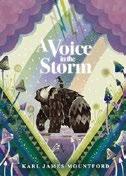
A rat, miserable thanks to her own internal storm, finds help in the midst of a real one. Though Rat seems deeply unhappy these days, her friend Jackdaw can’t get her to say why. One day, with blustery weather on the horizon, Rat runs into the heart of the storm, dodging friends and hungry enemies alike. When she finally collides with Bear, she finds a compassionate ear. Bear encourages her to be “a voice in a storm” and to let out her growls and roars alongside the actual storm. Afterward, Rat confesses the despair she’s been carrying around inside and explains why she couldn’t tell the others. In the end, Bear wisely states that “asking for help takes a lot of courage. But letting someone help, well, it takes worlds of the stuff.” By the end, Rat is finally able to start telling Jackdaw what’s wrong. Though the book’s message may feel a bit advanced for the elementary school set, that doesn’t diminish the truth beating at its heart; children grappling with depression and other intense emotions will feel seen—and held. Mountford couples the heaviness of the story alongside lavender, green, and blue geometric digital art, filled with beauty and coupled with care. In the end, the book feels like an older sibling to Cori Doerrfeld’s similarly mindful The Rabbit Listened (2018). Inexpressible feelings find an invaluable mouthpiece in one rodent’s lonely journey. Vital storytelling. (Picture book. 6-10)
Salvatore and the Goats of Mount Etna
Müller, Uschi | Illus. by Brittany Lane Greystone Kids (40 pp.) | $18.95 Nov. 5, 2024 | 9781771649285
Series: Listening to Animals
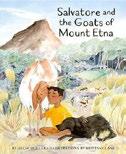
A young boy discovers that he can learn a lot from others if he just pays attention. Tan-skinned Salvatore and his family live on a goat farm at the base of Mount Etna. He bonds with a herding dog named Gina and the goats, led by Bianca. One day, Salvatore takes the herd up the mountain on his own, without Papa’s guidance, to graze on fresh herbs. As they ascend, the animals act strangely—much to Salvatore’s chagrin. Gina barks, the goats buck wildly, and all refuse to move. Though Papa’s words (“YOU herd the goats. They don’t herd you”) echo in his mind, he realizes that something’s wrong as Mount Etna starts to smoke and spew lava. The herd safely leads Gina and Salvatore down to their home thanks to their natural intuition. The author, coordinator of the ICARUS Project, a group that works to “make the extraordinary sensory capabilities of many animals useful to humans,” based the story on an incident at the real Mount Etna in Sicily. Her text and Lane’s dreamy, delicately rendered art will leave readers with an appreciation for the natural world. Lane’s portrayal of the goat herd showcases their humanity, with their playfully arched backs and expressive faces. Backmatter includes more information on Müller’s work and how it can contribute to creating more advanced warning systems for natural disasters—a must, given how these events have increased due to climate change.
A thrilling look at the benefits of connecting with the natural world and listening to one’s instincts. (Picture book. 5-8)
Nix, Garth | Scholastic (240 pp.)
$18.99 | Oct. 15, 2024 | 9781339012209
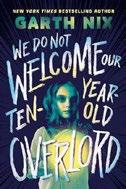
Six tweens band together to rein in a mysterious object that’s influencing people’s behavior in an alternate 1975 Canberra, Australia.
Chimera “Kim” Basalt and Benjamina “Bennie” Chance are 12-year-old best friends. Each has a 10-year-old sister: Eileithyia “Eila” Indigofera Basalt and Madir Sofitela Chance. Kim’s “alternative lifestyle” parents enforce daily chores and discourage him from reading fiction, while Bennie’s absentee parents are more permissive. The foursome enjoys exploring the surrounding suburbs and farmland. One day, “super, super smart” Eila finds a mysterious orb in the water. Kim is spooked by the globe’s attempt to speak to them, but Eila, feeling an affinity, names her Aster. With Eila’s help, Aster, whose origins are uncertain, begins learning about her new surroundings, a process that results in deaths, including of ants, guinea pigs, and a kangaroo. Aster starts asserting more influence, shape-shifting and administering electric shocks to those she perceives as threats. When even Eila, who’s been enjoying the power that comes from being in cahoots with Aster, agrees that the orb’s control has gone too far, the kids recruit two schoolmates’ help and attempt to break Aster’s hold. Nix infuses his latest with Dungeons & Dragons gamesmanship, maintaining dramatic tension through nocturnal rambles and chase scenes. Kim’s tendency toward anxiety and caution contrasts with Bennie’s headlong approach. Astute readers who see the neat end coming will still enjoy the ride. Main characters present white. An entertainingly offbeat sciencefiction romp. (author’s note, Nix’s Dungeons & Dragons campaign notes) (Science fiction. 9-12)
Kirkus Star
O’Connor, George | Colors by SJ Miller First Second (96 pp.) | $21.99 | $12.99 paper Oct. 8, 2024 | 9781250760784 | 9781250760791 paper | Series: Asgardians
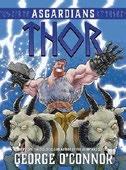
The Asgardian best known to modern readers, or at least moviegoers, struts his stuff. With his customary close and spirited take on original sources, O’Connor sets his portrait within a frame story that has Odin’s beefiest son—portrayed as a veritable mountain of muscle—relating several renowned exploits in order to earn passage from a cloaked ferryman at a river. In contrast to his depiction in the Marvel Comics Universe, this Thor turns out to be rather lacking in social skills. But when it comes to yarns, he does spin some winsome ones, like the story of how he acquired his hammer, Mjollnir, thanks to one of Loki’s schemes. He also recounts how he got the hammer back after it was stolen, by first urging Freyja to offer herself as ransom (her reply: “@#%!! ”) and then by masquerading as the thief’s bride. The author tucks additional tales into his closing barrage of source notes, analytical comments, and personal responses to many of the preceding panels and incidents. He also apologizes for one admittedly awesome view of Thor ripping off an ox’s head barehanded; for all the martial overtones, only rarely does the gore or violence turn visually explicit. Most of the deities are light-skinned, but the many
giants, dwarves, and other beings display a range of skin hues, along with often having deliciously strange and grotesque features. It’s hammer time! (author’s note, glossary) (Graphic mythology. 10-13)
Offsay, Charlotte | Illus. by Menahem Halberstadt | Doubleday (32 pp.)
$18.99 | Oct. 29, 2024 | 9780593808726

A family observes the first night of Hanukkah. Narrated in the second person, the story takes readers through the rituals, history, and most common symbols of the holiday. The grandparents make latkes and sufganiyot, and the children play dreidel. Together, the family lights the hanukkiah (or menorah), then celebrates with food, gifts, and songs. Most pages contain both narrative text and an explanatory note about the rituals depicted, making this book part mood piece and part educational tool. A few Hebrew and Yiddish terms are used and defined. The story is sweet and concise, while the notes on each page and in the backmatter provide more detailed information than many other Hanukkah books. Their pairing, however, makes it difficult to know who this book is for. Children who celebrate the holiday every year may enjoy the text but will find most of the notes too basic. Those learning about the Festival of Lights for the first time might struggle to understand some of the tale’s allusions, especially before reading the notes. Reading both story
A sensitive rendering of a child’s response to a loved one’s addiction.
and notes together will result in frequent asides and shifts in tone that may not be ideal for either reader. Bold, bright art boosts the book’s appeal. The characters vary in skin tone.
An illuminating holiday primer that may have trouble finding an audience. (author’s note) (Picture book. 4-8)
Oliveira, Inês Viegas | Trans. by Rosa Churcher Clarke | Triangle Square Books for Young Readers (64 pp.) $18.95 | Nov. 12, 2024 | 9781644214022

This Portuguese import contemplates war and peace by upending a planned duel. Two men decide to settle their disagreements by dueling. In a barren landscape, each begins the 100-pace walk away from the other, weapon in hand. Yet one, who narrates, simply walks on. He ambles through increasingly vibrant vistas in a pulsing city, witnessing a parade, a circus, and a puppet show. Skin tones, where discernible in the tiny figures, appear pale. With each page turn, the errant duelist encounters fewer people and more animals. In increasingly bucolic scenes, he trades his pistol for a walking stick. Narration—its meaning at times elusive—takes the form of a letter written to his dueling partner, the “Esteemed Mr Rodin Rostov.” Oliveira’s Klee-esque illustrations are stunning. Monochromatic early scenes metamorphose in successive palette shifts: saturated primary colors accented by neutrals for the cityscapes, then greens and ochers as the narrator treks through a village and a pasture. When he ponders his fate, constellations frame images of animals in an ink-blue sky. Over land and water, in fair weather and rain, he finally descends a mountain into a lush, flower-filled meadow. There, he pens his missive, posting it in his top hat. His note implores his friend to “put down your weapons and come on
over / to see me, would you?” A migrating white bird takes up the envelope, even as the narrator himself seemingly metamorphoses, achieving unity with nature.
Subtly beautiful, with a message of peace. (Picture book. 4-7)
Oliver, Jamie | Illus. by
Mónica Armiño
Tundra Books (336 pp.) | $18.99 Oct. 15, 2024 | 9781774884195
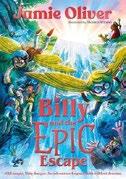
The Naked Chef dishes up further delectable exploits for his crew of preteen eco-warriors. Summoned back to the magical realm of Waterfall Woods by desperate pleas for help, Billy and his cohorts, Anna, Jimmy, and Andy— joined by reformed bully Bruno—find themselves up against a woman they dub “Scary Red” who’s stealing children by the hundreds from around the world. Why? To grow food crops for Terra Nova, a colony of scientists who produce a nutritional potion called Youth-In-ABottle. The celebrity chef author has his young characters take frequent breaks to make or chow down on lovingly described treats, from the first chapter’s lavish birthday party to a caramelized banana sticky toffee pudding he leaves them tucking into at the end. Before that, the book has enough rescues and casualty-free battles to nudge the storyline along, as well as some working out of personal frictions between reckless Anna and careful, cautious Jimmy. Fortunately, the young heroes’ foe depends on an elixir of youth that ultimately proves her downfall. Unfortunately, as the Myas (or personified mycelia of the fungal kingdom) warn, thanks to unsustainable practices in both worlds, the Rhythm of nature remains in deadly danger. Armiño’s lavishly detailed illustrations appear throughout, punctuating the dyslexia-friendly text. Main characters present white, apart from British Jamaican Jimmy.
Combine food-forward world-saving, personal issues, and a large cast both magical and mundane, then stir briskly. (recipes) (Fantasy. 8-12)
O’Neill, Diane | Illus. by Anastasiya Kanavaliuk | Whitman (32 pp.) | $18.99 Oct. 3, 2024 | 9780807552575
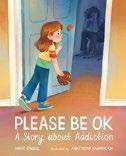
A young girl tries to help her older brother, who recently began using drugs. Dylan used to play with Fiona and comfort his little sister when mean kids teased her, but now he flakes out on taking her to the museum, and she spots him meeting up with a mysterious stranger. He argues with their parents and steals money. After Fiona sees him shoving something into his desk, she speaks up. When their parents realize that Dylan’s been using drugs, they explain what’s going on and arrange for him to enter rehab. Notably, this book makes clear that while drug addiction is harmful, those who use drugs aren’t bad people. The story also addresses the important elements of forgiveness and responsibility: Fiona shows a willingness to believe in her brother’s recovery, and Dylan apologizes for and takes ownership of his past mistakes. The recurring image of a large, blue bedroom door separating Fiona from her brother’s downward spiral acts as a symbol for his secrecy and her lack of understanding. Her emotional reactions range from loneliness to fear, gut-deep tension, guilt, worry, doubt, and optimism, with each one clearly portrayed through Fiona’s facial expressions. Dylan’s drug use is never visually depicted; Mom and Dad refer to it as “using drugs” as well as an “illness” and a “sickness.” Fiona and her family present white.
A sensitive rendering of a child’s response to a loved one’s addiction. (author’s note, further resources) (Picture book. 4-8)
Jasmine Is Haunted
Oshiro, Mark | Starscape/Tor (320 pp.) $18.99 | Oct. 1, 2024 | 9781250337290
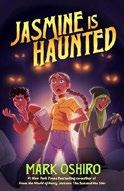
Ca n a young teen learn to communicate with the spirit who’s haunting her? Ever since Papi died, eighth grader Jasmine Garza, who’s Mexican American, has been haunted with poltergeistlike activity that has driven her and Mami to repeatedly move around California. At Jasmine’s latest school, she decides to follow Mami’s suggestion to try to make a friend. Jasmine, who’s queer, accepts English teacher Mx. Chen’s invitation to check out the school’s GSA, or Gay Supernatural Alliance. There she meets Bea Veracruz and Jorge Barrera. Once they learn Jasmine is being haunted, the pair dive into helping her rid herself of the spirit—but the spirit’s activity only increases. Can Jasmine make contact before the spirit’s growing darkness engulfs the whole neighborhood? At the center of this heartfelt ghost story swirls the lingering grief of those the dead leave behind, and the signal importance of family, friends, and community in ameliorating that grief. Jasmine’s community is vibrant, queernormative, and multiethnic, with strong Latine representation. Spanish phrases add texture and are easily comprehensible for those who don’t know the language. The complicated, layered characters all hold their own secrets, just as Jasmine holds hers—and they find the same freedom she does in letting those secrets go. The book’s only drawback is some occasional unclear phrasing that at times interferes with tracking the action. A sincere, spooky, supernatural mystery with Latine roots that explores powerful bonds. (Supernatural. 9-13)
A poignant and powerful tale of resilience.
Pau Preto, Nicki | Viking (352 pp.) | $18.99 Oct. 1, 2024 | 9780593528518 | Series: The Last Hope School for Magical Delinquents, 1
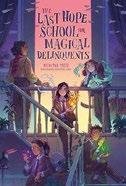
A girl ends up at a school for magical delinquents, desperate to fit in and gain control of her powers. Twelve-yearold Lavinia “Vin” Lucas is always in trouble. Lacking control of her magic, Vin has been expelled from multiple boarding schools for dangerous magical outbursts. With her parents off pursuing their fieldwork studies on dung beetles, Vin is sent to the Last Hope School for Magical Delinquents. Hoping this will be the place where she finally belongs, Vin is pleased to discover that the school is unlike any other: Her classmates admire her magical blunders, the headmistress encourages her to use her powers, and everyone’s magic blurs the boundaries of the standard categories. Even though it seems like a fresh start, Vin is determined to behave and refuses to use her magic, instead accepting being put in level one with the younger students. But when a fire sprite appears and Vin is held responsible for spells that seemingly don’t fit her powers, she starts to question whether she really is the cause of the trouble at her new school. With help from her new friends, Vin sets out to discover the truth before she’s expelled again—or destroys the school. This engaging magic school story has hijinks, humor, mystery, and action. The epilogue sets up for the sequel, which readers will anticipate. Vin presents
white; there’s racial diversity among the secondary characters.
An absorbing, mischief-filled fantasy. (magecraft categories) (Fantasy. 8-12)
Petty, Dev | Illus. by Mike Boldt
Doubleday (40 pp.) | $18.99
Oct. 15, 2024 | 9780593487167
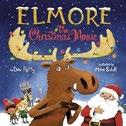
Santa tells readers about an unusual Christmas. Santa has a job opening, since Prancer will be attending a ventriloquist convention this year. So Elmore, a moose who’s long dreamed of pulling Santa’s sleigh, applies. He writes a letter to Santa describing his qualifications: He’s a “go-getter” with a “good sense of direction” who’s mostly overcome his elf phobia. Santa agrees to meet him but immediately notices that Elmore isn’t a reindeer. Elmore is sent home but mails another letter, promising to “hit the ground running.” Invited back, Elmore accomplishes just that: He remains on the ground. Back home, Elmore writes again, apologizing for omitting the “can’t fly” thing. Believing in the power of Christmas miracles, Santa decides to give Elmore another try. But Elmore, having made several unsuccessful attempts at flying, writes another letter wishing Santa good luck finding someone else and enclosing a batch of Chocolate Moose Cookies. This time, Santa offers Elmore a different job. This comical, warmhearted story with an original twist will not only have kids giggling and rooting for Elmore; it will also confirm their belief that wonders really do happen at Christmas. Elmore’s tongue-in-cheek correspondence will
elicit belly laughs. Nervous Elmore, in his necktie, cuts an endearing figure, as does gentle, brown-skinned Santa, eager to find a place for the wayward moose. Boldt’s energetic cartoon illustrations are rife with fun details; note the riotous “classified ads” in front and back endpapers. Santa’s elves are racially diverse.
A delightful Christmas tale that has it all—holiday cheer, joy, and a most persistent moose. (Picture book. 5-8)
Polonsky, Ami | Little, Brown (256 pp.) $16.99 | Oct. 29, 2024 | 9780316570978

A seventh grade gun violence survivor reckons with PTSD in this carefully rendered story about the fragility and power of human connection. Questions of “what if” cascade into a burden that feels too heavy for 13-year-old Stevie Jane Cohen-Kaplan, whose brain feels “broken” in the aftermath of a tragedy. A shooting at a summer festival in her New Jersey town has left her mom hospitalized. Given the large local Jewish population, was this a hate crime? Trapped in her grandparents’ Manhattan apartment and unprepared to visit her mother, who’s unconscious, Stevie Jane struggles to find coping mechanisms and relies on distractions to keep herself going. Seeking respite, she relies on Raisin, her emotionalsupport-dog-in-training, and her best friend, Avi. The friends begin piecing together the stories of those around Stevie Jane, from a neighbor’s life after surviving the Holocaust, to episodes in her grandfather’s life and her own mother’s activist history. Each revelation leads them around the city, contributing to Stevie Jane’s budding confidence; over time, she finds more and more pieces of her mother’s past. Centering on a Jewish family, the story hints at Manhattan’s diversity through some descriptions of minor characters. The realistic portrayal of trauma is handled with deft sensitivity,
from physical symptoms to therapeutic intervention. Interspersed poems add texture and vibrancy, weaving the delicate threads of the characters’ lives into a buoyant tale of hope.
A poignant and powerful tale of resilience. (content warning, author’s note) (Fiction. 8-12)
Quin, Tegan & Sara Quin | Illus. by Tillie Walden | Farrar, Straus and Giroux (240 pp.)
$22.99 | $14.99 paper | Oct. 1, 2024 9780374313036 | 9780374313043 paper Series: Tegan and Sara, 2
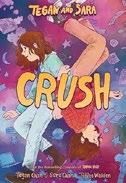
W hat’s worse: the weight of rising success or the pressure of awkward teenage attraction?
In this duology closer, white twins Sara and Tegan have more to deal with than your average eighth graders. For one thing, their songwriting hobby is getting serious. The sisters enter a contest to open for a popular star when she returns to perform in her hometown of Calgary. Although they end up losing, the artist’s manager wants to sign them on. Now they’re dealing with all sorts of new concerns—rehearsals, social media, wardrobe choices, music collabs, and shooting videos. Meanwhile, the tricky bits of middle school friendships don’t stop, like flat-out abandonment or discerning whether your crush likes you back. Throw in some sibling squabbles, and it all adds up to a lot of pressure. The characters handle everything with positive maturity, a phrase that also describes this narrative, which offers earnest, expertly executed storytelling. The characters act as the pop duo’s fictionalized avatars in a contemporary setting that offers more relatability for readers. The work includes representation of queer friends who are out and older musicians who encourage agency in what can be a controlling industry. The text stresses the importance of
appropriate supervision by trusted adults as well as both bodily and creative autonomy in professional spaces. Walden’s expressive and animated art enhances the book’s emotional impact.
A heartfelt story of staying grounded while shooting for stardom. (authors’ note, personality quiz, photos) (Graphic fiction. 9-13)
Reintgen, Scott | Aladdin (384 pp.)
$18.99 | Oct. 1, 2024 | 9781665946513
Series: The Dragonships Series, 1
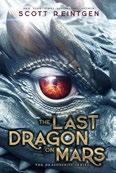
A tenacious 13-year-old battles to save Mars, the only home he knows, in this series opener. Lunar Jones, called “Dad” by the other orphans at the understaffed, underfunded Martian Relocation Clinic, is a scrapper in the dying Mars settlement, which is ironically named Harvest. Although the atmosphere supports human life, Martian plants, animals, and weather pose threats to survival, and the salvagers risk their lives with every expedition. A century ago, people killed Ares, Mars’ King-Dragon, hoping to make the planet “a paradise. A second version of Earth.” But that plan backfired. After a bloody attack by a rival salvage group, Lunar regains consciousness in an underground bunker, under the care of Gen. John Poppy, who’s secretly rearing a dragon named Dread. Poppy has rallied a group of young people with assorted special skills. Soon Dread will choose his dragoon, the human he bonds with for life. In the world of the story, which is reminiscent of Mad Max and Star Trek, each celestial body has its own dragon avatar. The backstory is fairly well developed, and the short chapters are packed with action. Lunar and some other key characters show positive growth, while the minor characters feel more like types. Lunar presents white; there’s some diversity in race among the supporting cast.
Fast-paced dragon flights and mid-space fights—plus underdog heroes who are easy to root for.
(Fantasy. 10-14)
Reul, Sarah Lynne | HarperAlley (32 pp.)
$5.99 paper | Oct. 22, 2024
9780063295537 | Series: I Can Read! Comics
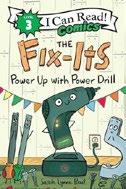
A cheerful group of anthropomorphic tools known as the Fix-Its learn about the value of a power nap. One morning, the hand drill excitedly tells the two screwdrivers about a new arrival to the workbench. “Is that the brand-new, super-duper Power Drill?!” asks one of the screwdrivers. The three get to work while Power Drill finishes charging. The hand drill makes a hole, and a screwdriver turns a screw. It’s hard work. “Would you like some help?” asks Power Drill. Yes! “They’re so powerful, they didn’t even need to pre-drill!” says the hand drill while observing Power Drill’s work. Power Drill acknowledges the secret to their impressive speed and energy: “ELECTRICITY!” Like groupies gushing over a celebrity, the wide-eyed hand tools cut hilarious figures as they look on in awe. They take the opportunity to rest by basking under a lamp (“Relaxation looks good on us”), and they plan a party for Power Drill as thanks for all the work getting done. But Power Drill is slowing down, their “ziip” turning to an “urr…urp.” It takes several tools to hoist Power Drill back onto the charger to recover. Reul accomplishes a lot in the Fix-Its’ second graphic novel: She gives readers an up-close look at various woodworking tools, reminds them that rest and recharging are essential, and demonstrates the importance of respect and cooperation. The crisp panels and gently animated look of the workbench denizens add to the welcoming feel. Hooray for teamwork, hard work, and friendship! (Graphic beginning reader. 4-8)
may
SUZIE AND BLUSH
Rigaud, Debbie | Illus. by Rachel Más
Davidson | Nancy Paulsen Books (32 pp.)
$18.99 | Sept. 24, 2024 | 9780593530375
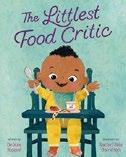
A young child is a very picky eater. Baby Sebastian’s critical of the meals his parents serve and has developed a rating system: He awards meals one to five binkies, depending on whether they meet his exacting standards. The fancy restaurant his parents take him to is a one-binky experience: The highchair’s too tight, and Sebastian gets cranky listening to the waiter drone on about the specials. Time for a kid-friendly eatery, where they cook noodles similar to those that Sebastian’s parents make. OK, three binkies. Next day, when Mom and Dad serve Sebastian a favorite, though imperfect, dish, he recognizes a “special ingredient he had not noticed before—his family’s tender loving care.” The meal wins Sebastian’s highest rating: the coveted five binkies. Many parents will recognize Sebastian’s dining idiosyncrasies: He dislikes foods touching each other, and certain textures and consistencies bother him. Children old enough to appreciate the humor, however, may not relate to a story about a baby’s fussy eating habits. It’s also unclear why Sebastian suddenly learns to appreciate his parents’ efforts when the meals they’ve provided have always reflected their love; the story’s optimistic conclusion feels a bit like wish fulfillment for caregivers. The energetic illustrations were created from various media, including pastel, crayon, marker, colored pencil, spray paint, chalk, book pages, and old photos. Chubby, expressive Sebastian and his mom are brown-skinned, while his dad has pale skin.
Rinaldi, Sue | Clavis (32 pp.) | $18.95 Aug. 6, 2024 | 9798890630827

Overcoming shyness, one blush at a time. Suzie loves to sing, dance, read, and dream. She performs these activities secretly because she often feels self-conscious—an emotion that’s visually embodied by a furry red creature named Blush who follows her everywhere. One day, Blush joins her in class. When Suzie must answer a question, Blush grows in size; her classmates stare. Blush glows; so do Suzie’s cheeks. Her classmates giggle. At home, Mom—a small figure who inexplicably inhabits a fishbowl—says that “most people have a Blush…Things that make them shy or worried…But if you’re brave and believe in yourself, Blush might shrink and become less scary.” At school the next day, Suzie notices other kids’ Blushes and joins their activities. Voilà! Blush shrinks. Later, when Suzie must stand up in class, Blush grows again, tugging at her leg. Suzie bravely faces Blush, confesses that Blush makes her sad, and asks the interloper to shrink. Gradually, Blush slips away entirely, and Suzie becomes “Suzie Strong, Suzie Happy.” This sympathetic tale should empower many children, though shyness isn’t so easily conquered in real life. Still, it offers hope that kids can confront their shyness, just as Suzie learns to do. The delicate illustrations are calming; red Blush occasionally looks fearsome, making Suzie’s power over it more impressive. Suzie and her mom are pale-skinned,
Suzie’s teacher is brown-skinned, and her classmates are diverse. A gentle story that offers support and may help allay some fears. (Picture book. 5-8)
Rodriguez, Edel | Abrams (48 pp.)
$18.99 | June 11, 2024 | 9781419745867
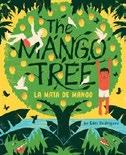
In this poignant, wordless picture book, a ferocious storm separates two friends.
A tall mango tree stands in the center of an island teeming with creatures great and small. In a village on the island, two children— one blond-haired and light-skinned, the other dark-haired and brown-skinned— climb and play on the tree, flying colorful kites, feasting on its luscious fruit, and even evading fierce beasts. Rodriguez’s textured, vivid woodblock-printed artwork imbues these serene childhood scenarios with well-worn wistfulness. Landscapes of blue skies and warm sunlight set a suitable backdrop against the sturdy mango tree. Then, dark clouds unexpectedly creep in on a standout double-page spread showing each child asleep on a long tree limb, separated by the book’s gutter. A vicious storm sweeps across the island, blowing the mango tree and the dark-haired child away. Adrift at sea, the lost child avoids oceanic creatures under the moonlight, eventually washing ashore on unfamiliar land. There, a community of black-haired, blue-skinned people welcomes the young newcomer, who resurrects the mango tree on new soil to send a message back home. Inspired by youthful experiences per an author’s note (presented in both English and Spanish), Cuban American Rodriguez’s latest is a touching tribute to the uplifting joys of friendship and the thrilling unknowns of adventures, told with acute detail from a child’s perspective. Simply spellbinding. (Picture book. 4-8)
Rogers, Alexandria | Little, Brown (368 pp.)
$16.99 | Oct. 22, 2024 | 9780316523837
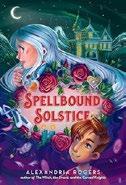
A young teen’s biggest problem was stage fright—until she learned of her family’s curse. In the seaside town of Chanterbrooke, Maine, Alice Ambrose, a 13-year-old ballet dancer from a family of enchantresses, has one mission: to make her parents fall in love so their family will finally be whole. Her parents never married, and her father is constantly traveling for work. Ensorcelled Cottage, the inn her family runs, is the perfect location for Alice’s plan: Every year, people who stay at the inn over the winter solstice fall in love. This year, her dad will be there for their Winter Solstice Festival for the first time. When Alice, who’s cued white, discovers that the women in her family are cursed to never fall in love, she decides to break the curse with help from best friend Marcela, who’s white and Mexican, and Chanterbrooke newcomer Ronan Knight, a 14-year-old French medium with secrets of his own. But trying to break the curse could have deadly consequences. Alice also needs to conquer her fear of performing in public, which could cost her a future as a professional dancer. The blurred lines between good and evil contribute to this thought-provoking novel, which is as much a study of its complex characters as it is a whimsical fantasy. The action-packed descriptions of perilous situations will keep
thrill-seekers reading, while others will be charmed by the sentimental family connections and sweet romance. A wintry delight filled to the brim with magic, friendship, and unexpected twists. (Fantasy. 10-14)
Romero, R.M. | Illus. by E.K. Belsher Little, Brown (368 pp.) | $16.99
Oct. 15, 2024 | 9780316539487
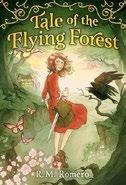
Eleven-year-old Anne Applebaum lives in Silverthorne, adjoining the mystical flying forest of Bei Ilai. Anne and her mom share a love for the tales of the Bei Ilai queens, witches and prophetesses contained in a special book, The World To Come. Mom tells Anne of a dream she used to have in which she was expecting twins— Anne and a boy she called Rainer. But Anne was born alone. When Mom dies soon after Anne’s 11th birthday, she’s left grieving with an undemonstrative father and a deep desire to solve the mystery of her brother’s possible existence. She sets out on a quest—one filled with adventure, danger, terror, new friends, and one terrible enemy— that takes her into Bei Ilai, where she encounters some of the characters from the book. A narrator tells “our heroine’s” story in great detail, addressing the “gentle reader” directly and offering interludes, backstories, insights, warnings, and assurances. The narrator also displays sympathy, compassion, and admiration for Anne and her companions. The enemy is a true monster, one who cruelly uses others for his own gain.
A wintry delight filled to the brim with magic, friendship, and unexpected twists.
References to Jewish traditions, prayers, and symbolism are integral to the storytelling. Although some readers may find the text dense and difficult to follow, the novel is ultimately well worth the effort. Final art not seen. An exciting, tender, and appealing adventure. (map, author’s note) (Fantasy. 9-13)
Schwartz, Ella | Illus. by Juliana Oakley | Kar-Ben (32 pp.) | $19.99 Nov. 5, 2024 | 9798765604199
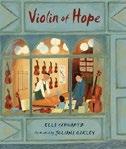
A beloved violin is lost and found. The lives of Papa, Mama, Itzak, and Feiga are filled with love and celebration of their Jewish traditions. Papa is an accomplished musician whose beautiful violin has a place of honor in their home. When he plays “quick and lively” songs, the children dance with joy. When Papa’s music turns “slow and sorrowful,” it invites quiet contemplation. Itzak attempts to play the instrument, with ear-bashing results, but Papa assures him that that he’ll improve with practice. Then everything changes. One Shabbos night, soldiers show up and take the violin. It ends up in a cellar, languishing with other looted items “in silence” for many years until it’s rescued by a luthier who lovingly restores it to its former glory. The luthier passes the violin on to a young boy named Isaac, whose father recalls his grandfather’s violin skill. Isaac’s first attempt exactly matches Itzak’s initial screeches, the luthier echoes Itzak’s father’s encouraging phrases and sentiments, and Isaac’s tunes are, by turns, “quick and lively” and “slow and sorrowful.” As a master violinist, in concert halls around world, he plays music of hope. The book doesn’t explicitly mention Nazis or the Holocaust until the author’s note, and the family’s fate is left unspoken. But the striking, detailed, multi-perspective illustrations contain hints for sharp-eyed readers as the author brings this
sorrowful yet optimistic tale full circle. The main characters are tan-skinned; background characters are diverse. Tender, moving, and hopeful. (photographs, website) (Picture book. 6-11)
Seacrest, Ryan & Meredith Seacrest Leach Illus. by Bonnie Lui | Simon & Schuster (32 pp.) $19.99 | Oct. 8, 2024 | 9781665949873

TV presenter and producer Ryan Seacrest and his sister, Meredith Seacrest Leach, encourage readers to use their imaginations to the fullest.
“You can be a make-believer,” the authors tell readers. Your mind can take you anywhere—up and away in a hot air balloon, blasting off on a rocket ship, or traveling across a rainbow, atop a majestic unicorn. Clouds transform into colorful fish; a child joins a llama in song. Though the simple, stream-of-consciousness text accompanying these images suggests that there’s no wrong way to daydream, it nevertheless offers examples in case readers feel a bit stumped. And once dreams become bold enough, they may serve to improve young people’s lives. These are laudable messages but ones that are clumsily delivered. The prose is tepid, verging on cliched (“Dreams to dream while the sun shines bright, and your eyes are wide open”). The authors deem these vivid experiences “Dreamy Moments”—which feels like an at best distracting and at worse cynical attempt to commodify childhood wonder. Visually, a digitally rendered palette of mellow hues emphasizes comfy purples, warm oranges, and
calm aquatic blues and greens. The cast of children traipsing through the scenes are diverse in terms of race and ability and include kids using wheelchairs and hearing aids. Lukewarm attempts at sparking creativity. (Picture book. 4-8)
Seblon, Joséphine | Illus. by Robert Sae-Heng
Photos by Lauren Winsor | Thames & Hudson (96 pp.) | $19.95 | Oct. 15, 2024 9780500660249 | Series: Mini Artists, 2
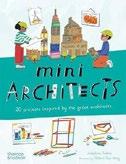
Crafts projects made from simple materials echo aspects of iconic structures from Stonehenge and the Sagrada Família to a Zen garden.
Confusingly switching from addressing children in some passages to adult caregivers in others, Seblon opens each entry with a description of the chosen structure alongside a not-always-helpfully angled photo. She adds several discussion questions, then goes on to pair terse instructions with photos or diagrams of the neatly assembled project at successive stages. The “little hands” (as she puts it) that are visible in some pictures will generally need help from adult hands to finish most of these projects—the rounded river pebbles prescribed for Stonehenge, for example, will be hard to balance atop one another, and the cardboard walls for the “Tower block box” inspired by Le Corbusier’s brutalist Cité Radieuse (“Radiant City”) will require more than the
An introduction to common—and uncommon—occupations involving animal care.
SNAKE MILKER AND OTHER ANIMAL JOBS
suggested safety scissors. Several will also require waiting for paint, glue, or papier-mâché to dry partway through before they can be finished off. Still, even if many of the completed models don’t resemble the buildings that supposedly inspired them, they will require enough effort to satisfy hands-on builders, and more than a few could potentially exhibit spectacular forms and colors. The skin hues of photographed hands and SaeHeng’s small figures of painted children are diverse.
Uneven but worthwhile. (list of buildings) (Nonfiction. 6-9)
Sekaninová, Štěpánka | Illus. by Jakub Cenkl | Albatros Media (40 pp.) $16.95 | Oct. 8, 2024 | 9788000072807
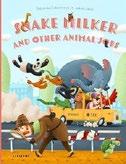
An introduction to common— and uncommon—occupations involving animal care. Of the “hundreds of jobs [that] involve animals,” this Czech import spotlights both the obvious—dog walker, cat sitter, wildlife rescuer—and the lesser known, from animal bodyguards to baristas for cat cafes to drivers for animal taxi services. Animal physiotherapists, pet psychologists, and animal rights advocates require extensive training that’s barely mentioned here. An animal-food taster needs good taste buds (and doesn’t swallow). Sadly, Sekaninová doesn’t mention that “marine mammal trainer” is a job that’s being phased out. The author notes that pet photographers need “a great eye and artistic talent”—what about sensitivity and a knack for soothing standoffish critters? The book lists the exotic-sounding “animal hairdresser” rather than the more common term: animal groomer. No pay scales or educational prerequisites are provided. The cheery
illustrations are more facetious than accurate: In the accompanying image for animal taxi service, dogs, monkeys, a cat, and a parrot are crammed in together without carriers or crates; in the section devoted to animal rights advocates, a handcuffed dog is on trial, rather than an abusive owner; the pet photographer is wearing a bathrobe. Humans are diverse in terms of skin color. A somewhat entertaining but superficial career guide. (Informational picture book. 6-9)
Sitja Rubio, Cristina | Trans. by Vineet Lal | Eerdmans (52 pp.) | $18.99 Oct. 15, 2024 | 9780802856272

One little woodland creature fights for his right to party. If there’s one thing children can identify with, it’s animals uninterested in going to bed. It’s winter, and Badger is full of plans. Unfortunately, it’s hard to put those ideas into practice when everyone else is tucked into bed. After visiting Bear, Marmot, and Nighthawk, Badger attempts to amuse himself, but “clearly being alone isn’t his thing.” It isn’t until the bats tell him to “go and play with the birds” that he realizes that he’s not the only one up this winter. The birds, foxes, rabbits, and more are happy to party and have a wonderful time. And when Badger’s other friends do emerge in the spring, little wonder that it’s Badger’s turn to fall asleep. Backmatter distinguishes between torpor and hibernation, and an additional factual section offers guidance on helping animals during the winter. Meanwhile, front endpapers feature illustrations of “animals that sleep a lot in winter,” while the back endpapers list animals that don’t. The soft ink, gouache, and watercolor renderings of Badger and friends give the story a gentle, identifiable hero for whom bedtime is
in no way a necessity. Translated from French, this tale will pair well alongside nonfiction picture books on similar subjects, such as Summertime Sleepers by Melissa Stewart, illustrated by Sarah Brannen.
In a sea of hibernation titles, this one’s worth staying awake for. (Picture book. 3-6)
Smith, Alex T. | Macmillan Children’s Books (56 pp.) | $12.99 Oct. 15, 2024 | 9781035051984

A whimsical version of a classic Christmas song. Brownskinned Eloise, an Edwardian-era girl wearing a red hair bow and a dress with a white collar, receives very unusual presents from Grandma, mailed to her daily over the course of 12 days. Initially, the text hews closely to the lyrics of the time-honored song, except that instead of “my true love” doing the sending, “my grandma” is the benefactor. It’s a sure bet that readers familiar with that ditty will sing the words instead of reading them, because they’re fun to croon and the presents are so over-the-top. They get even quirkier in this clever U.K. import: After the sixth day, the gifts begin to differ sharply from those in the original as Grandma sends Eloise “seven squirrels a-snorkelling,” “eight bears a-balancing,” and more very odd items, until the last day, when something unexpected arrives in a large, striped carton. (Hint: No animals are involved this time!) Readers will hoot with pleasure, just as Eloise does. (She appreciates this gift, which is much more practical than the others.) The colorful illustrations are comically energetic, enhanced by the inclusion of Edwardian-esque stamps and
postage marks in the corner of almost every right-hand page, signifying the cities and companies from which the presents came. Eloise’s thank-you note to Grandma appears on the final page, as does brown-skinned Grandma. Be generous this holiday season: Display this delightful book widely at Christmastime. (author’s note) (Picture book. 3-8)
Smith, Jennifer E. | Illus. by Leo Espinosa Random House Studio (40 pp.)
$18.99 | Nov. 5, 2024 | 9780593434611
Series: A Creature of Habit Story
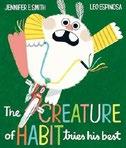
The titular character, introduced in The Creature of Habit (2021), returns for a lesson in perseverance. Clever wordplay immediately elevates Smith’s story beyond mere moralizing about the value of a growth mindset: “Habit” is the name of a tropical island, home to the eponymous creature, a large, rabbitlike being who prefers the tried-and-true to the new and unfamiliar. A “very small creature,” a bespectacled blue sphere with skinny limbs, encourages the very big creature to stretch himself, first by finding a way for the two of them to leave the island for a snowy place with “trees shaped like triangles. And rocks covered in moss. And snow that [falls] from the sky like dust, like magic, like stars.” Here, the very small creature excels at trying new things, such as climbing trees and riding a bicycle. The very big creature struggles and fails to do the same, much to his disappointment, but a shift in his thinking makes all the difference. The very big creature soon realizes that attempting to be the best is fruitless; it’s better to try to be the best at trying. Throughout, Espinosa’s comic-style illustrations have a retro feel that will appeal to fans of Zachariah Ohora
SHADOW FOX
and Bob Shea, with an expressive flair that captures a range of emotions from frustration to triumphant glee. Try your best to find this great storytime pick. (Picture book. 3-6)
Sorosiak, Carlie | Walker US/ Candlewick (224 pp.) | $17.99 Oct. 29, 2024 | 9781536228960

A hungry fox and a girl with a lively personality wield magic together. Events unfold from the viewpoint of the narrator, a fox named Shadow who lives near the shore of Lake Superior. Food is scarce, she’s thin and has patchy fur, and the loss of her sister some months before is constantly on her mind. Shadow steals shoes from rooms at a nearby motel— she has 257 piled in her den—and distrusts all humans except for one. But Nan, the white-haired woman from the motel who used to feed her, is inexplicably gone; a red-haired girl is there instead. Bee, Nan’s granddaughter, is a bit wild and out of step with others herself. To Shadow’s initial annoyance, she and Bee forge a bond that turns out to be deep and magical; indeed, Bee can understand and give human voice to Shadow’s thoughts. Meanwhile, the island of Whistlenorth, accessed through a portal on Lake Superior, is the site of imminent (and foretold) devastation—and Bee and Shadow must attempt to thwart the danger. The Night Islanders’ greedy and indiscriminate reaping of the environment to distill
“ultra-concentrated magic” has laid waste to much of what grows in the magical islands and threatens Minnesota’s forests. As Shadow navigates the dangerous territories of trust and power, the fox has a compelling voice that’s prickly, proud, and subtly funny. The book convincingly depicts a singular brand of northern, woodsy, wild magic. An appealing combination of animal magic and low-key hero fantasy. (Fantasy. 8-11)
Sumner, Jamie | Atheneum (224 pp.)
$17.99 | Oct. 22, 2024 | 9781665947848
Series: Roll With It

As 13-year-old Ellie Cowan faces high school, her relationships undergo difficult changes. Months after the events of Time To Roll (2023), Ellie, Coralee, and Bert are entering “the grand finale of middle school.” Ellie dreads high school, with new therapists and new classrooms that might not be wheelchair accessible. Even worse, Bert, for whom she’s developed “fish-swishy” romantic feelings, might be attending boarding school in Kentucky next year—nine hours from Oklahoma. And while Mema always has wise advice, Grandpa’s worsening Alzheimer’s disease is taking a toll on the family. Ellie just wants everything to stay the same. Sumner poignantly explores complicated emotions ranging from crushes to grief, and readers will sympathize with Ellie as she struggles to express herself. The
depiction of Grandpa’s decline is particularly heart-wrenching. The bond between the friend trio remains strong, and Ellie and Bert’s relationship brims with sweetness. Unfortunately, the author’s handling of bullying is less successful; bullies’ violent treatment of Bert, who’s cued as neurodivergent, goes unreported, setting a troubling example for bullied readers and their peers. Though Bert retains his uber-logical charm, his lack of self-confidence remains largely unaddressed, which is particularly disappointing, given the increased focus on his character. While his persecution may, sadly, reflect reality, readers will likely wish his character arc would more clearly convey that he realizes he doesn’t deserve to be bullied. Those facing life changes like Ellie’s will find her experiences resonant and, ultimately, comforting, however. Most characters read white.
Equal parts heartbreaking and heartwarming. (Fiction. 10-14)
Sir Callie and the Witch’s War
Symes-Smith, Esme | Labyrinth Road (400 pp.) | $17.99 | Oct. 29, 2024 9780593711088 | Series: Sir Callie, 3
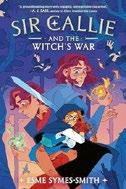
Torn apart by war, Callie, Willow, Elowen, and Edwyn confront new enemies, grapple with difficult decisions, and rally the courage to fight for a better future.
Callie and Willow, exiled to Eyrewood after escaping Helston, wait and train for their next battle. Guilt and worry eat away at Callie’s patience as the adults hesitate to plan their next move. Any day now, the forces of Helston or Alis, the Witch Queen of Dumoor, could attack. Meanwhile, Elowen swears an oath to Alis, who promises to make Elowen her heir. By remaining at the Witch Queen’s side, Elowen plans to protect everyone she loves, but as Alis makes demands of her trust and dismisses her concerns, Elowen starts to
question whether she’s made the right decision. Edwyn never wanted to return to Helston or to see his father again, but now he rides beside him on a secret mission to prove his loyalty and atone for betraying Alis. More than anything, Edwyn wants to prove his bravery to himself. This third installment continues to expand the world around Callie and their friends, increasing the stakes and scope of the imminent war. Identity and autonomy remain core themes of the story. Symes-Smith builds momentum and suspense right up to the cliffhanger ending by alternating among the perspectives of the four main characters. Callie, Willow, Elowen, and Edwyn are cued white; the world around them reflects racial diversity. A page-turning continuation of an adventuresome series. (author’s note) (Fantasy. 8-12)
Tougias, Michael J. | Christy Ottaviano Books (272 pp.) | $18.99 | Oct. 22, 2024 9780316556217 | Series: True Survival, 2

T hree small lobster boats unknowingly head into a massive storm in Georges Bank, off Cape Cod, in this nautical survival story that is a young readers’ adaptation of Tougias’ 2007 adult work of the same name.
Thanks to governmental delay in replacing a defective weather-forecasting buoy, the crews of the Fair Wind , Sea Fever, and Sea Star set out in November 1980, unaware that they were heading straight into 87-knot winds and waves as tall as 10-story buildings. Highlighted by the nearly 50-hour ordeal of Ernie Hazard, the sole survivor of the Fair Wind , on a leaky, wave-tossed life raft, the ensuing events were certainly harrowing. But despite the removal of some (but not enough) repetitive and extraneous detail from the original
edition, Tougias’ narrative remains a slog, alternating prolonged, similarsounding passages featuring tough men struggling to endure pounding seas with flights of overwritten melodrama and insufficient efforts to individualize the people involved. Aside from a paragraph explaining the specially designed Givens raft, the author likewise neglects to provide specific descriptions of either the working boats or the vessels involved in the eventual rescue, details that would have helped readers better visualize events. While the material is promising, the presentation unfortunately fails to make the conditions seem real or the participants come alive for audiences.
Tragic but at once both sketchy and too long. (list of characters and vessels, appendix, author’s note) (Nonfiction. 10-14)
Twomey, Beverly | Snowy Wings
Publishing (236 pp.) | $12.99 paper Oct. 1, 2024 | 9781958051368

Twelve-year-old Georgie Smith would do anything to help his father, the Blacksmith, even if it means learning Necromancy. Georgie doesn’t really remember his mother, but he’s witnessed the years of grief her death has caused his father. He does his best to help around the house and the forge, but Georgie still doesn’t feel like he’s doing enough. When a special commission he delivers for his father turns out to belong to a Necromancer, Georgie has an idea: If he can learn the art of Necromancy, he could bring back his mother, and his father would be happy again. The Necromancer agrees to take Georgie on as an apprentice but cautions that, when it comes to restoring Mum’s life, “I cannot help you. Not with this…But I can teach you.” Despite this warning, Georgie knows that there’s more to
Necromancy—and the Necromancer— than meets the eye, and he’s intent on using his training to find an answer to his family’s grief. This character-driven story explores poignant themes of grief, loss, and family through the lens of fantasy and magic. The interesting, complex characters with compelling narrative arcs make up for the somewhat lackluster worldbuilding. Though the core themes are sad ones, this isn’t a heavy read but rather a well-rounded exploration of moving forward in the face of hardship. Major characters read white.
An effective, well-characterized exploration of grief set in a fantasy world. (Fantasy. 9-13)
Velez, Ana | Page Street (32 pp.)
$18.99 | Aug. 13, 2024 | 9781645678694
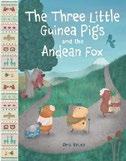
Three South American guinea pigs attempt to reconstruct their homes in this take on the wellknown story. When floods wash away the homes of Urku, Inti, and Nina in an Andean valley, they hike in search of a new place to rebuild. Urku heads toward a mountain peak and builds a house from hay, Inti goes to the woods and makes a home from sticks, and Nina goes into town and opts for a house made from stone. But the trio are troubled by a persistent Andean fox who tries to oust them from their homes: “Guinea pig, guinea pig, come with me. / I have something for your family. / Your home design just isn’t wise. / Strong winds could blow it across the skies.” Unlike the wolf in the familiar story, however, the fox is trying to get the guinea pigs to attend a party in their honor; the community has come together to build them a much sturdier home that combines all the materials. It’s a far less scary story than the source material, accompanied by lively, warm illustrations rendered in a muted palette.
References to South American culture— the use of Kichwa and Spanish, and the inclusion of Andean animals such as condors—make for an original reimagining. Adults will want to make sure kids are familiar with “The Three Little Pigs” first to ensure they get the most out of this one.
A clever upending of a beloved fairy tale. (glossary, information on animals of the Andes, snow treat recipe) (Picture book. 4-8)
Wambach, Abby | Illus. by Debby Rahmalia | Roaring Brook Press (40 pp.)
$19.99 | Oct. 8, 2024 | 9781250766854

In FIFA Women’s World Cup soccer champion Wambach’s latest, children are urged to be themselves. Wambach turned her popular 2018 commencement address at Barnard College into a New York Times bestselling book for adults—Wolfpack (2019), an inspirational treatise that encouraged readers to be themselves and dream big. A second adaptation was published for a middle-grade audience, and now comes the picture book, which breaks down Wambach’s message into a series of simple, declarative statements about taking on adventures, facing fears, and being true to oneself, because “you are a Wolf— and that’s the Wolfpack way.” The eight-point Wolfpack way, which is strung throughout the book and organized as a list at the end, is all good Chicken Soup for the Soul–esque advice, from “create your own path” to “let kindness lead the way.” A rallying cry, “we can do hard things,” appears on a hat worn by one of the children in Rahmalia’s boldly colored illustrations, which provide the basic storyline: A racially diverse ensemble of kids (including one who uses a wheelchair) traverse their neighborhood, board a school bus, spend the day at
school doing a variety of activities (including playing soccer), board the bus again for home and dinner, then perform in a musical together. Although the text is somewhat didactic, the presentation of a group of children respecting and supporting one another is a welcome contrast to the U.S.’s divided, conflicted society.
Light on story but delivers an uplifting message all the same.
(Picture book. 3-6)
Watson, Renée | Illus. by Sherry Shine
Amistad/HarperCollins (48 pp.)
$19.99 | Nov. 5, 2024 | 9780063219991

A lyrical salute to the long-lived performer, fashion plate, and human rights activist.
“Nine decades she lived: / 96 years. 35,105 days,” Watson writes of Cicely Tyson (1924-2021). She goes on in flights of free verse to lay out a life lived “to do good in the world,” from early days growing up in the South Bronx as a “brown-skinned girl with twig legs” through early devotion to music and modeling, successes on stage and screen, and later years as a U.N. goodwill ambassador. “We cannot do enough, we cannot give enough, Cicely said. / We have to give back.” The author tucks in lines from spirituals to give her tribute further feeling and sonority and, to add broader context, intersperses biographical poems with general evocations of Black experiences in different historical eras: “Black is Emmett Till / and Medgar Evers / and
Rosa Parks / and that preacher man King.” Shine, best known as a quilter, incorporates brightly hued and patterned fabric piecework into elegant, fashion-forward portraits of Tyson posing with dignity at various ages and in group scenes with other stylized, brown-skinned figures. Further brightens a light who was already shining. (timeline) (Picturebook biography. 6-9)
Wenjen, Mia | Illus. by Victor Bizar Gómez Red Comet Press (48 pp.) | $18.99 Nov. 12, 2024 | 9781636550879

The story of Simon Tam, a Chinese American activist who took his fight for the right to trademark his rock band’s name to the U.S. Supreme Court. Born in 1981, Simon Tam grew up loving music and working in his parents’ restaurant in San Diego. His early experiences with racism informed his worldview, so when he decided to pursue music and didn’t see many people in the industry who looked like him, he named his rock band The Slants in order to “take ownership of hurtful words and give them a new meaning.” When the U.S. Patent and Trademark Office rejected his trademark application on the grounds that the name was racist, Tam decided to fight back. The legal battle went all the way to the Supreme Court, which in 2017 ruled in Tam’s favor.
A lyrical salute to the long-lived performer, fashion plate, and human rights activist.
CICELY TYSON
Wenjen’s writing is forceful and emotional but doesn’t explain the specific legal arguments, reducing them to generalizations such as “Asians [were] being treated differently by the government” and “the judicial system was racist.” When dialogue is used, it’s sometimes unclear who is speaking. Where Wenjen shines, however, is in communicating the passion with which Tam dedicated himself to fighting for equality and combating racism. Gómez illustrates the narrative with dyanmic, collagelike digital art in a limited palette of muted colors. Each spread also features a quote from the song “We Sing From the Heart” that The Slants wrote about the experience. Inspiring in spirit, if not in specifics. (about the band, information on other activists who have fought anti-Asian racism, sources, author’s and illustrator’s notes, lyrics to “We Sing From the Heart”) (Informational picture book. 6-12)
Wilson, Kimberly | Illus. by Mark Hoffmann
Page Street (32 pp.) | $18.99
Oct. 1, 2024 | 9781645678847

The newest addition to the wallet likes to shop till the other shoe drops.
Goldie the credit card has joined a family consisting of different kinds of money, and when she offers to bankroll an upcoming vacation, the coins and cash are thrilled. Goldie, who’s illustrated with the microchip and tap-to-pay symbol of modern credit cards, works fast! Even little Penny declares her generosity “magnifi-cent,” though Goldie has a tendency to upgrade their frugal travel plans at great cost. Bill cautions Goldie not to overspend, but she ends up maxing out her credit limit and wallowing in a sea of debt. Goldie takes responsibility and works extra hard to pay off her debt by the
An upbeat “you do you” message delivered with a valuable side of “your body is your own” awareness. SLOUCH
statement due date. She returns to the wallet to be used for planned, affordable expenses instead of luxurious splurges. The artwork fills each page with onomatopoeia as Goldie swipes and taps up a storm, along with images of the safari, cruise, and doughnuts she purchases. Constant wordplay and puns lighten the sound lessons of this personified money drama. The other wallet denizens encourage and embrace Goldie as she works toward debt relief, welcoming her back into the wallet with friendly forgiveness. Backmatter caps off the story, offering a timeline of the history of credit and charting the benefits of responsible credit card use alongside the pitfalls of excessive splurging.
An accurate and entertaining account of the pros and cons of wielding credit. (bibliography) (Informational picture book. 4-8)
Wyman, Christina | Farrar, Straus and Giroux (336 pp.) | $17.99 | Oct. 22, 2024 9780374391904
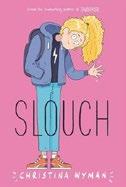
A girl who feels like a “freakish giant” navigates seventh grade friendships, family drama, and the New York City subway, bolstered by skills learned on her junior high debate team. Though she’s not quite 13, at 5 feet, 10 inches tall, Stephanie “Stevie” Crumb is taller than her classmates
and even most teachers; people routinely think she’s older than she is. She’s comfortable in casual clothes but tired of unkind nicknames (her brother Ryan’s favorite: “Flood Watch”), leering men on the subway who treat her body as public property, and people’s intrusive observations about her appearance and basketball potential. Although money is tight, Stevie can’t help but notice her parents buy “Prince Ryan” new basketball shoes, while she’s expected to wear too-short pants that pinch her middle. Stevie’s curiosity is piqued when she overhears the newly formed debate team’s after-school practice. Mrs. Crenshaw, the coach, expects her debaters to be as committed as athletes, and after joining the Opinionators, Stevie builds confidence, finds nonjudgmental peers, and learns to speak her truth to her family. Wyman imbues Stevie’s story arc with blossoming self-awareness. Side plots include Stevie’s crush on fellow debater Cedric, and the pressure Ryan feels to get a college basketball scholarship. Stevie’s bestie’s unsafe use of social media results in expository teachable moments. Stevie’s family is cued white; secondary characters bring diversity to the cast.
An upbeat “you do you” message delivered with a valuable side of “your body is your own” awareness. (author’s note) (Fiction. 10-14)


THE REAL WORLD can be messy: People don’t always get their just deserts, burning questions can remain unanswered, and unfair situations too often go unrectified. But within the world of the mystery genre, we can enjoy the satisfaction of engaging with a clever puzzle and seeing justice meted out. This year, readers will find a delightful variety of whodunits that offer a pleasing range of settings and themes.
Kill Her Twice by Stacey Lee (Putnam, April 23): Lee’s latest is an atmospheric tale set during the Great Depression. In Los Angeles, Chinese American sisters May and Gemma Chow


struggle to help keep their family afloat financially after their flower-seller father falls ill. The girls are shocked to discover the body of Lulu Wong, a friend of May’s who was poised for Hollywood success; they investigate her murder against a backdrop of threats to Chinatown’s very existence.
How To Die Famous by Benjamin Dean (Little, Brown, July 9): Hollywood continues to provide great material for murder mysteries, as this celebrity journalist’s twisty sophomore novel, set in the world of a high-profile teen TV drama, proves. Abel, a Black British boy, joins the cast of

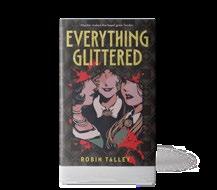
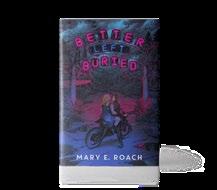

a show that’s been plagued with misfortune—including the death of his older brother, Adam, who was a junior assistant on the set. Abel investigates Adam’s suspicious demise while navigating the often toxic entertainment world.
Better Left Buried by Mary E. Roach (DisneyHyperion, Aug. 6): Roach’s debut is filled with all the intrigue of a small Tennessee town that’s been dominated by a powerful family and is haunted by its dark past. Lucy’s private investigator mom is hired to look into the death of a wealthy patriarch and businessman, derailing her spring break. But then Lucy meets Audrey, an alluring local girl, and the two do some sleuthing of their own.
Murder on a Summer Break by Kate Weston (Harper/HarperCollins, Sept. 10): Readers seeking a hilariously witty satirical take on the classic English village cozy mystery should look no further: BFF amateur sleuths Annie and Kerry, aka the Tampon Two, are back! They’re thrilled that a nearby influencer festival will be hosted by their online feminist hero, Winona Philips. But everything changes when misogynistic Timmy Eaton (“the most popular and dickish” influencer in
attendance) is found dead, suffocated by a condom.
Everything Glittered by Robin Talley (Little, Brown, Sept. 24): Talley situates her latest lesbian historical work in Washington, D.C., during Prohibition. Gertie, Clara, and Milly move between the well-realized, carefully researched, and highly contrasting milieux of their elite finishing school and the city’s speak-easies, where good times and alcohol are found in abundance, along with members of underground queer communities. After their headmistress is found dead, the girls set out to uncover the truth.
Tangleroot by Kalela Williams (Feiwel & Friends, Oct. 15): The mysterious grave of an 18-year-old who shared her unusual name sets contemporary Black teen Sophronia on a quest for answers. Her mother, a newly appointed college president, has her own research goals as she digs into the institution’s past. Generational trauma and small-town Southern politics are woven into this remarkably powerful debut that also explores comingof-age issues, family history, and a bumpy motherdaughter relationship.
Laura Simeon is a young readers’ editor.
An introduction to the seemingly harmless flowers, leaves, and seeds that hold dark potential as unexpected tools for murder and warfare.
Appealing illustrations abound in this collection of facts and cautionary tales about the world’s most poisonous plants. Readers learn about familiar plants, such as tobacco, habanero chili, and poison ivy, along with more mysterious ones, such as henbane, mandrake, and aconite. Each chapter contains harrowing anecdotes about poison victims and subsections relaying scientific information and concludes with a detailed description of the
plant’s toxic effects on humans (and sometimes animals, too). Hirsch includes a bulleted list of “Deadly Details” for each plant, providing surprising facts (“People have been poisoned by eating honey made by bees gathering nectar from heartbreak grass flowers”). The striking page design evokes a strong sense of the macabre and is reminiscent of dark academia. Botanical drawings and other images break up the blocks of text. Color photographs of the plants provide a glimpse of how these dangerous species appear in the wild. Bookended by a thoughtful prologue and cautionary epilogue, the
By Edith Eva Eger with Esmé Schwall
By Rebecca E. Hirsch; illus. by Eugenia Nobati
By Rebecca Stafford
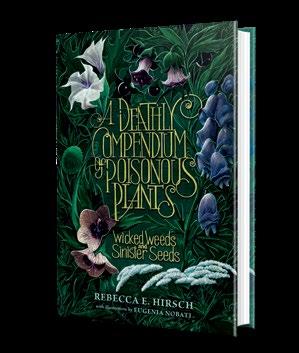
Hirsch, Rebecca E. | Illus. by Eugenia Nobati
Zest Books | 200 pp. | $18.99 | Oct. 22, 2024 9798765625248
contents are organized alphabetically, allowing for quick reference. Source notes, a selected bibliography of high-quality works, a comprehensive glossary, and teen-appropriate further resources (including a quirky blog by a professional
horticulturalist) invite readers to continue their education beyond the text. An engaging, visually appealing guide for science buffs, true-crime enthusiasts, and herbalists alike. (index, photo credits) (Nonfiction. 13-18)

Bacon
For some great mysteries and thrillers, visit Kirkus online.
The writing is lyrical, providing an avenue for the family to deal with guilt and grief.
LONELY PLACES
Addison, Amanda | Neem Tree Press (272 pp.) | $14.95 paper | Oct. 1, 2024 9781911107682
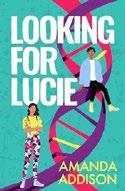
An English teen turns to DNA testing to find answers about her heritage. With her “mahogany brown hair and caramel skin,” 18-year-old Lucie Hansen has always stood out from most people in Norwich, including her white mum, stepdad, and half sister, Maisie. Tired of not knowing how to answer questions about her origins, she purchases a DNA test kit, seeking to learn more about her biological father, an anonymous sperm donor. On the day the test results are due, a collision at school with classmate Naveed Chowdery breaks Lucie’s phone, which she needs to access the results. Nav promises to fix it, and as the two start chatting, Lucie’s aggravation turns into friendly interest. Like Lucie, Pakistani British Nav is used to thoughtless strangers asking where he “really” comes from. When Lucy’s DNA test results disappoint her, Nav offers to help her track down relatives through a genealogy database. Lucy’s search for her identity holds the potential for emotional impact, and the introduction of Nav’s own family’s secrets in the second half adds a layer of mystery. Unfortunately, readers must wade through choppy prose, chunks of informational text, and stilted expository dialogue to reach the truth of Lucie’s background. A long epilogue drags out the conclusion.
A tedious tale that lacks momentum. (partial family tree, complete family tree, author’s note) (Fiction. 13-16)
Anderson, Kate | Flux (304 pp.) | $14.99 paper | Oct. 29, 2024 | 9781635831016

A teen becomes convinced that she needs to save her sister from a dark force in the woods.
Seventeen-yearold Chase, her 10-year-old sister, Guthrie, and their parents have been on the road for years in their skoolie, an old school bus converted into an RV. Six months earlier, Guthrie stopped speaking after a traumatic event for which Chase blames herself. To provide some stability, their father finds work in Utah as a fire lookout. Chase gets a job at a local summer camp, makes friends, and develops an interest in lifeguard Wilder. But she can’t focus on their burgeoning relationship, since her priorities are saving money to return to their hometown of Boone, North Carolina, for college. She’s also trying to look after Guthrie, who’s acting increasingly oddly; meanwhile, her father has become detached and moody, and her mother refuses to believe that anything is wrong with either of them. But when Guthrie goes missing, Chase and her parents must confront the deep darkness that they’ve been trying to outrun. The writing is lyrical, particularly the descriptions of the natural world, and though there are a few creepy moments, the supernatural elements are handled lightly, mainly
providing an avenue for the family to deal with the guilt, pain, and grief they’ve been holding, both collectively and individually. Main characters are cued white. A beautifully written, emotionally astute story about confronting trauma, told through a spooky lens. (author’s note) (Horror. 14-18)
Baker, Kylie Lee | Harper/HarperCollins (384 pp.) $19.99 | Oct. 22, 2024 | 9781335091758

In this follow-up to The Scarlet Alchemist (2023), Fan Zilan, the newly appointed Scarlet Alchemist, must find a way to resurrect her loved ones after they sacrificed their lives to destroy the evil Empress. Zilan once dreamed of becoming a royal alchemist, but although she’s achieved this goal, she’s also lost almost everything: Her friends, family, and beloved prince have all died as part of her quest to kill the Empress and enact justice. Hoping to resurrect them all and create a better world, Zilan, her alchemy duck, and her brother, Wenshu—who’s been resurrected in the prince’s body—search for legendary Penglai Island, said to be home to eight immortals who possess an elixir for eternal life. With only her white foreign father’s scant notes and a riddlelike poem as guides, Zilan and Wenshu set off on a daunting journey. Each clue brings them one step closer to Penglai Island—and deeper into the dangerous, secretive world cloaking its whereabouts. Along the way, they encounter new threats, old enemies, and unexpected allies, making Zilan question whether the sacrifices she’s made (and continues to make) are worth it. This sequel, whose setting evokes Tang dynasty China, is just as dark and gruesome as the first volume. Full of action and gore, this fastpaced story centers around love,
sacrifice, family, and death. The presence of new, powerful alchemists opens up more of this mesmerizing, terrifying world.
A dark, thrilling duology closer. (content note, historical note) (Historical fantasy. 14-18)
Bandy, Lindsay K. | CamCat Books (368 pp.)
$19.99 | Oct. 15, 2024 | 9780744310849
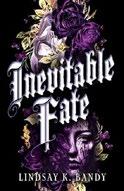
Is a 17-year-old student’s acceptance to NYU’s elite art program a lucky break or preordained?
Rather than returning to high school for his senior year, Evan Kiernan is settling into college, thanks to a portfolio that included an impressive oil painting he did called The Green-Eyed Girl . During his first week in New York, a sudden rainstorm leads a stranger to share his umbrella—a green-eyed stranger who looks exactly like the girl he painted from his imagination. Evan and Mara Cassidy feel an immediate connection that strengthens as they spend time together. Mara’s physical likeness to the painting isn’t the only strange coincidence, however. At a Coney Island gallery, Evan finds a 1911 photograph of a young man— one of the people with unusual physical traits who was on display at an amusement park. Apart from his numerous tattoos, the young man looks exactly like Evan. Flashbacks send Evan back in time to the amusement park and even to the Puritan witch trials; each time, he encounters Mara. Interspersed among Evan’s narrative are entries written by a certain Kieran Flynn from the Kings Park Asylum in 1911. Readers will enjoy spotting parallels between the characters across the different time periods, and Evan is engaging as he tries to solve the puzzle. For all her charm, Mara, a drummer in a rock band, remains woefully passive and
underdeveloped. Main characters present white.
A clever tale about breaking free from the past that falls short on secondary character development. (playlist) (Fantasy romance. 14-18)
Barnett, Maija | West 44 Books (200 pp.) | $25.80 | Oct. 1, 2024 9781978597327 | Series: West 44 YA Verse
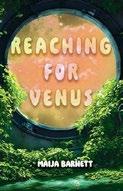
A young girl assumes her sister’s identity for a chance at survival—and unexpectedly falls in love.
On an environmentally devastated Earth, Leah and Rachel Silverton, orphaned sisters born a year apart who can pass for identical twins, struggle to get by. Leah has severe asthma, but each year the government offers 16-year-olds the opportunity to try out for a chance to live in the Floating City on Venus. Only 50 boys and 50 girls may go, however—and they must be healthy. When Rachel is selected, she devises a plan for 17-year-old Leah to go in her place, before the pollution kills her. Leah takes on Rachel’s identity and leaves for Venus. Determined to survive, she adheres to the strict rules and her job assignment. She forms new relationships, becoming especially close to Rose Palmer, who lives on her floor. Falling in love with Rose gives Leah a new sense of purpose, but lying is taking its toll. An accident risks undoing everything the sisters have sacrificed for. This verse novel for reluctant readers is a heartfelt journey of finding oneself that explores the sense of becoming that accompanies discovering a new home. Leah is a sympathetic protagonist, the blossoming romance is endearing, and the conclusion is satisfying and feels genuine. Main characters read white. An appealing romantic adventure set against a harrowing backdrop. (Verse science fiction. 12-18)
Bilen, Tracy | BHC Press (236 pp.)
$23.99 | $14.99 paper | Oct. 8, 2024
9781643974033 | 9781643974040 paper
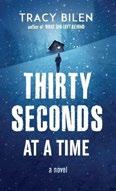
A Michigan girl takes on her father’s unsolved murder in this romantic thriller that begins and ends with a bang. After bullets shatter her living room windows, killing her police officer father, high school junior Kate’s life changes forever. As he lies dying, Dad gives her a piece of paper, issuing a cryptic warning: “Don’t read it…Don’t show anyone. Burn it.” Kate does get rid of the paper—but only after reading it. When she and her mom are allowed back in the house to collect some possessions, she stumbles upon $250,000, stashed in her guitar case. Fearing that her father was a thief, she hides the cash in a safe place. When Kate’s mom is offered a spring semester teaching position at a private school for competitive athletes in Vermont, the change feels like a respite from the trauma. Kate quickly settles into her new environment and even falls for a handsome skier named Ryan. But when people involved in her dad’s murder investigation wind up dead, Kate realizes that she’s in grave danger and must act. The novel’s pacing is a bit bumpy, ranging from slow to frenetic, but the payoff at the end is worth it. The characters are sympathetic and likable, and the development of the protagonists, who are coded white, is solid. Kate and Ryan’s whirlwind relationship is a testament to the power of first love. An appealing choice for readers who like their mysteries with a side of romance. (Mystery. 14-18)

For another mystery exploring family secrets, visit Kirkus online.
Bitz, Allison L. | Harper/HarperCollins (352 pp.)
$19.99 | Oct. 1, 2024 | 9780063266759
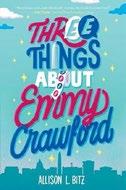
A senator’s daughter struggles with perfectionism amid familial, academic, and romantic tensions.
For Emmy Crawford, “being mediocre isn’t an option.” With unscrupulous paparazzi on the prowl, 17-year-old Emmy and her sisters, 16-year-old Issy and 9-yearold Lucy, can’t risk any behavior that might jeopardize Mom’s presidential campaign. But Emmy’s got everything under control: She’s determined to protect her beloved Issy (who deals with anxiety from headlines such as “State Senator’s Daughter Mentally Ill: If Crawford Can’t Help Her Own Child, How Can We Expect Her to Help the Nation?”) and win nationals in debate, burnishing her family’s reputation. Emmy has no time for weakness—including her Crohn’s disease, which she stubbornly ignores, lying about not following her doctor’s treatment protocols. But when Gabriel Castillo, the handsome debate opponent who vanished after she shared a vulnerable moment, returns, Emmy’s defenses against romantic distractions weaken. Complicating matters, Issy appears to be crushing on Gabe. As misunderstandings mount and her health worsens, Emmy realizes that she’s losing control—and she risks losing her relationship with Issy, too. Bitz, who has Crohn’s and anxiety herself, sympathetically portrays both. Readers struggling with anxiety will find Issy’s growing self-confidence particularly empowering. Emmy’s gradual self-awareness is satisfying but hard-won; realistically, the consequences of her actions are not instantly resolved. Additionally, the author examines such issues as health care disparities and parental mental
illness. Emmy and her family present white; Gabe is Mexican American. An honest exploration of trust, family, and self-care. (author’s note, resources) (Fiction. 14-18)
Bou-Montes, Louangie | Harper/ HarperCollins (384 pp.) | $19.99
Sept. 10, 2024 | 9780063296725
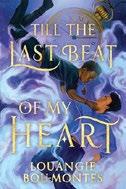
A teen discovers his necromantic powers and the cost of defying death when he accidentally resurrects his ex–best friend.
Jaxon SantiagoNoble, a gay Afro-Latine boy who’s Puerto Rican and Dominican, lives with his mom above his family’s funeral home. Unlike his father, who lived and died a mystery, Jaxon’s mother has never hidden her work from him. Having dead bodies in his basement feels like a normal part of life—until Christian Reyes arrives in the morgue after a fatal car crash. Against his mother’s wishes, Jaxon sneaks into the basement to say goodbye, but as he’s processing his unresolved feelings, he unknowingly calls Christian’s soul back into his broken body. With the Mami’s help—and the use of his father’s heirloom pocket watch—Jaxon temporarily brings Christian back to life, but reversing death requires a sacrifice. Mexican American Christian will die again if he and Jaxon can’t find a way to fully restore his life force. This emotional and heart-poundingly suspenseful debut intertwines romance with supernatural horror. As Jaxon
attempts to understand and control his powers, he navigates complex relationships with his family and friends. Forgiveness and accountability are important parts of Jaxon’s character growth, elements that pair well with the underlying themes of culture and community. Bou-Montes also includes destigmatizing representations of mental illness; Jaxon’s anxiety is sensitively woven into his characterization. A nuanced romantic thriller. (Paranormal romance. 14-18)
Crittenden, Loni | Harper/HarperCollins (352 pp.) | $19.99 | Oct. 29, 2024
9780063296435

It’s illegal for 16-year-old tinker’s assistant Kellan DuCuivre to use the metal-carving magic of makecraft on her own, but it’s worth the risk to save her mentor. Kellan, a Black girl, is the descendant of traitors to Nanseau, someone regarded as being among the lowest members of society in the city of Riz. But when she impresses Madame Minora Mesny, a courtier and Master Engineer in makecraft, Kellan’s life is transformed. She accepts Mesny’s offer to become her apprentice and so breaks generations of tradition and law forbidding people of her status from rising up. Orphaned Kellan dreams of finding a cure to help her ailing guardian, Edgar, but the dangers surrounding her unlikely ascent are heightened by a mysterious, encroaching darkness that makes people disappear…or worse. In order to
This heart-poundingly suspenseful debut intertwines
triumph, Kellan must navigate the cruelties of both the darkness and high society. She’ll have to unpack years of trauma carved into the very fabric of her existence. The worldbuilding is strong, with complex connections and a robust history for readers to delve into as they adventure with Kellan and her friends. This steampunk version of New Orleans is recognizable in the quarters that make up Riz and the twists of the bayous beyond the city. The magic gets lost when it’s time to knit the characters and their interactions together, however: Their profiles are distinct but not cohesive, and some of the camaraderie feels forced. A promising debut that lacks unity but showcases mountains of glorious imagination. (map) (Fantasy. 13-18)
Currie-McGhee, Leanne | ReferencePoint Press (64 pp.) | $33.95 | Sept. 15, 2024 9781678207861

A work that aspires to motivate teens by highlighting the power of grit and perseverance in overcoming adversity.
Each of the five chapters tackles different categories of challenges, showcasing stories of triumph in the face of learning and physical disabilities, homelessness, the struggles of being an immigrant, and mental illness. A recurring theme is encapsulated early on in a quote from a teen who survived an abusive family: “I tried to take a negative and turn it into a positive.” The persistent and repetitive optimism edges into toxic positivity, however, such as with a queer teen who, thrown out by her homophobic parents, is praised for the unerring focus that led her to graduate as co-valedictorian, win acceptance to Georgetown University, raise funds for college through GoFundMe donations, and appear on Ellen DeGeneres’ talk show. Excepting the chapters on learning disabilities and
mental illness, the narrative largely and frustratingly lacks concrete details on how to manage setbacks and gain critical confidence and skills, context that would make the stories more useful and relatable. The selection of often incongruous stock photos and the somewhat dry, detached language also detract from the narrative. Ultimately, this work could leave ordinary teens feeling disheartened, as the approach it espouses seems unrealistic.
A lack of nuance and overemphasis on positivity undermine this work’s potential positive impact. (photo credits, source notes, organizations and websites, for further research, index) (Nonfiction. 12-18)
Currie-McGhee, Leanne | ReferencePoint Press (64 pp.) | $33.95 | Sept. 1, 2024 9781678208103

What is a family? This work examines a wide range of possibilities, emphasizing that regardless of configuration, what matters most “is the love and support that members feel—or expect to feel.”
Happy families are truly not all alike: “every family is unique, particularly in the United States,” due to “varying family compositions and the ethnic mixture” of the population. CurrieMcGhee uses this broad diversity to explain that “statistical averages” are not the same as being “typical.” She provides relevant quotations from and brief portraits of members of families that diverge from the racially homogeneous, heterosexual, nuclear model. The book covers immigrant, multiracial, adoptive, LGBTQ+, and single-parent and multigenerational families. The author delves into the variability that exists within each of these broader categories, as well as common concerns. For example, immigrant families often experience the stresses of being
separated from beloved relatives, navigating cultural differences, feeling pressure to succeed, worrying about the deportation of undocumented members, and experiencing difficulties with intergenerational communication gaps. Societal prejudice and discrimination are challenges for many of the groups the author describes; she identifies practical sources of support and notes strengths that can result from the family’s composition. The writing is clear, and the tone is accepting. Unfortunately, landmark cases, such as those legalizing interracial and same-sex marriages, go unmentioned, weakening readers’ understanding of the broader context. Attractive stock photos add to the book’s appeal.
Presents and validates a rich tapestry of diverse family patterns. (source notes, for further research, index, picture credits) (Nonfiction. 12-17)
Daigle-Orians, Cody | Jessica Kingsley Publishers (224 pp.) | $19.95 paper Oct. 21, 2024 | 9781839977343
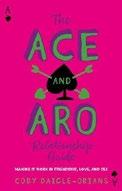
Decentralizing romance and sex, this guide explores skills and pathways for building healthy, fulfilling, identity-affirming relationships.
Daigle-Orians explains that Western society prioritizes one type of relationship—an exclusive partnership between two cisgender, heterosexual people that’s based in romantic and sexual attraction and leads to marriage and procreation. They challenge the myth of this “perfect relationship,” exposing its pervasive and harmful impact on asexual and aromantic people. The first half of the work presents 10 tools for building a “New Kind of Perfect” relationship—autonomy, consent, boundaries, communication, commitment,
compromise, trust, respect, recognition, and care. After discussing each tool, the second half examines them in action in “relationship beginnings, platonic connections, sex, romance, nontraditional forms of relationships, and relationship endings.” Within each chapter, the author encourages readers to engage with and practice the tools; breakout sections include prompts for self-reflection and action. The prose flows in an engaging, conversational style that helps to break down the complex concepts. When read from cover to cover, the text at times verges on repetitive, but for those using the guide as a reference tool, the repetition supports the treatment of chapters as self-contained essays. Although Daigle-Orians aims to speak to and support a targeted audience, the tools they share have universal value. This is a worthwhile text that centers readers who are often left out of relationship guides. An empowering and important tool. (resources) (Nonfiction. 13-adult)
Denner, Adi | Tundra Books (384 pp.)
$18.99 | Oct. 1, 2024 | 9781774885253
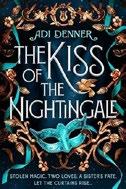
A poor orphan who’s given the chance to use stolen magic to become an opera star finds herself tangled up in romance and treachery.
In Lutèce, a city located in a world inspired by historical France, those with a Talent—a gem that enhances a specific skill, passed on through generations via blood magic—fare much more easily than those without. Cleodora Finley was devastated when her father died unexpectedly, before passing on his Talent for tailoring. Now his dress shop is floundering, and Cleo is unable to get her sick sister the care she needs. When the mysterious and seductive Lady Dahlia Sibille offers her a stolen Singing Talent, Cleo accepts. In return, Cleo must steal the Talent
belonging to the arrogant yet alluring Vicomte Nuriel Lenoir. As danger and deceit swirl around her, Cleo grows closer to both Dahlia and Nuriel. Ultimately, however, she must decide where her loyalties lie and what kind of person she wants to be. The original magic system and captivating setting are accompanied by a fast-paced narrative as the story engages with themes of class and art. While Cleo eventually finds gumption and grit, the poor decisions she makes on her journey to that point become more frustrating than relatable. Additionally, neither of her love interests feels developed enough to create a believable romance that will help readers become invested. Main characters are cued white.
An intriguing world unfortunately populated with uninteresting characters. (Fantasy. 14-18)
Dent, Helen | Enclave Escape (256 pp.) $24.99 | Sept. 10, 2024 | 9798886051506

Something is rotten in the town of Bishop’s Gap, and the tree burning at the heart of its woods is to blame.
Two of the town’s founding families, the Casters and the Levys, have been feuding for generations. The only thing they share is fear and hate—of each other and of the curse-bearing marks that appear on their doors at random. The third founding family, the Finches, are caught in the middle. Loner Ellie Caster is determined to get to the bottom of things, especially when her 8-year-old sister succumbs to the curse. But when she makes an impulsive decision that unleashes the evil upon the whole town, she must work together with Charlotte Levy, whom she loathes, as well as close friend Drew Finch (who’s fallen for Charlotte) to right this generational wrong—before they and the town tear themselves apart. First-person narrator Ellie is both fallible
and unreliable; her emotional myopia makes it difficult to become deeply invested in her story and unfortunately does the development of other characters a disservice (a shame, since most of them display hidden depths that would have been interesting to explore further). Although the plot moves on apace to an exciting conclusion, the ending feels detached and abrupt: The narrative jumps from one plotmandated point of convenience to the next without pausing to let characters’ emotions or the story itself breathe. Main characters are cued white. An interesting premise clumsily executed. (Fantasy. 12-18)
Dougherty, Terri | ReferencePoint Press (64 pp.) | $33.95 Sept. 1, 2024 | 9781678207960

A guide to careers that allow people to apply their math skills. Dougherty opens by explaining the many ways that math is applied in the real world, including online data encryption, digital animation, and even when strategizing specific plays in sports. The six subsequent chapters each focus on specific careers that center on math— being an actuary, economist, financial analyst, math teacher, physicist, and operations research analyst. Each section follows a consistent format, clearly breaking down what goes into preparing for this particular career and what to expect when working in that field. Helpful sidebars cover the number of jobs, median salary, educational requirements, desirable personal qualities, work settings, and future job outlook. The coverage also includes working environments, how often people work independently or with others, the types of organizations that have these positions, and the potential for travel. A brief discussion of artificial intelligence shows that mathematics careers are an
ever-changing field for which flexibility is key. The chapters conclude with sections titled “Find Out More,” which offer links to relevant professional organizations. Some first-person narratives add a personal touch to this straightforward text. Stock photos demonstrate racial and gender diversity. Clear, concise information that readers considering math-related careers will find useful for decision-making. (picture credits, source notes, interview with a financial analyst, list of math-focused careers, index) (Nonfiction. 12-18)
Drews, CG | Feiwel & Friends (336 pp.) $19.99 | Oct. 29, 2024 | 9781250895660
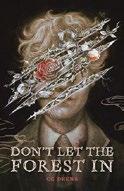
When the monsters they imagine come to life, two boys fight for their lives— and each other. Andrew Perrault, who’s from Australia, writes beautiful, macabre fairy tales. His roommate at his American boarding school, Wickwood Academy, is talented artist Thomas Rye, who brings his stories to vivid life in paint and charcoal. Andrew’s twin sister, Dove, is all but ignoring him, so he has plenty of time to focus on Thomas’ increasingly odd behavior. Thomas’ parents disappeared just before the new school year started, and Andrew noticed blood on his roommate’s sleeve on their first day back. When he follows Thomas into the forest one night, Andrew discovers him fighting one of the monsters that Thomas has drawn from these stories. The boys soon find themselves coping with vicious bullies by day and fighting monsters by night. At the same time, Andrew struggles to reconcile his feelings for Thomas with his growing awareness of his own asexuality. But when the sinister Antler King breaches Wickwood’s walls, Andrew realizes that he and Thomas may not survive their own creations. This novel, written in rich, extravagant
Eger’s present-tense narrative allows readers to experience the brutality of the Nazis.
THE BALLERINA OF AUSCHWITZ
prose, features frank portrayals of disordered eating, self-harm, bullying, and mental illness. Andrew grapples realistically with his sexual identity, and the story has ample genuinely creepy moments with the monsters. Andrew, Thomas, and Dove are white.
Lush, angsty, queer horror. (content warning) (Horror. 14-18)
Ballerina of
Eger, Edith Eva with Esmé Schwall Atheneum (192 pp.) | $18.99
Oct. 1, 2024 | 9781665952552

A memoir of one teen’s experiences in Auschwitz and rebuilding in the aftermath of war, adapted from the 2017 adult edition.
Edith was the youngest of three daughters in an ethnically Hungarian Jewish family in a Czechoslovakian town. She trained as a gymnast and made plans beyond high school with her sweetheart, Eric. Edith was 16 in 1944 when all appearances of normalcy were torn away, and Jewish families were crowded onto trains destined for Auschwitz. Her parents were killed on arrival at the camp. Edith and her oldest sister, Magda, labored amid horrific conditions and uncountable deaths. Dreams of reuniting with Eric sustained Edith, but her hope eventually dwindled. Over a year later, they and other prisoners were close to death when American soldiers liberated them. Recovery was a long road: Edith
weighed only 70 pounds when she was rescued. Over 15,000 Jews from her hometown were deported; fewer than 100 returned and began rebuilding their lives. Eger focuses primarily on her teen years, with the exception of an epilogue detailing her return to Auschwitz nearly 40 years later, alongside her husband, Béla, whom she met when they both were sent to a TB hospital following the war. Eger’s present-tense stream-of-consciousness narrative allows readers to experience the brutality of the Nazis but also the cooperation and encouragement among the inmates and the events that gave her postwar life meaning. A luminous memoir of human resilience. (author’s note) (Memoir. 14-18)
George, Erica | Entangled Teen (400 pp.) | $12.99 paper Aug. 6, 2024 | 9781649375414
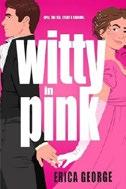
An enemies-tolovers Regency romance in which love wins out over legacies. Eighteen-yearold Blythe Rowley has no interest in seeing “certified man-child” Briggs Goswick—not since the cruel prank he perpetrated four years earlier that landed her in a literal pigsty. But his celebrated return to Mistlethrush Hall, his family’s home, forces them into close proximity. Briggs is heir to his late father’s estate as well as the debts from his gambling habit and keeping of a mistress. He’ll most likely lose the property, but he’s hoping to marry well and spare his
For this bestselling YA author, a mystery novel is much more than just solving the crime.
BY MARION WINIK

MAUREEN JOHNSON IS having a brilliant career. She is the author of more than a dozen YA novels, with more than two million copies sold worldwide. Her collaborations with Cassandra Clare and with John Green and Lauren Myracle have yielded multiple books and a hit film on Netflix (Let It Snow). As a special badge of honor, the American Library Association has listed her novel The Bermudez Triangle, featuring a relationship between two girls, as frequently challenged; Johnson is now the New York/Connecticut co-chair of Authors Against Banned Books.
Johnson’s latest mystery, Death at Morning House (HarperTeen, Aug. 6), echoes several elements of her much-loved Truly Devious trilogy: Along with six murders, the novel also features a 1930s cold case plus unfolding mayhem in the present and a diverse crowd of teens, including a character with an interest in podcasts. Well, writers do have their obsessions, and to that list, Death at Morning House adds a setting that Johnson has been dreaming about since she was a girl. We talked to her about that and other matters on a recent Zoom call; we reached her in London, fresh from a meeting at her U.K. publisher. Our conversation has been edited for length and clarity.

teenage years, so all I ever did was try to find the escape route. It turns out that “I gotta get out of here” and “Who are these people, and why are they in charge?” are really good places to start.
Did you also finish your master’s thesis?
more hours in the day. I’m perfectly happy to write all the time.
Tell us about your road to writing YA fiction. I kind of fell into it, almost on a dare. My closest friend, Kate Schafer Testerman, was my roommate in college; then we lived abroad together and moved to New York together. I was in grad school at Columbia, doing two MFA programs at once, dramaturgy and narrative nonfiction, which any child can tell you is a very silly
thing to do. Kate got a job at a literary agency, Janklow & Nesbit. She said, “I have something I want you to try: a novel for teenagers.”
“Well,” I said, “I would never be able to write that, and to prove it to you, I’ll write a little bit of it.” Suddenly I had The Key to the Golden Firebird, my first novel. It was that fast.
I went to a Catholic girls’ school, and I wasn’t allowed out for my entire
Dramaturgy, no—though I had most of the credits— but nonfiction, yes. It was on the idea of staging worlds, or pretending in reality. I found the woman who created the first Renaissance faire and spent a week interviewing her. And I wrote about my first job in New York, in a haunted house–themed restaurant.
What a cool idea.
Thank you. I hope to include it in the book of essays I’m going to write just as soon as they put
Let’s talk about Death at Morning House . Tell us about your main character. Marlowe has been in love with her classmate Akilah all through high school. She finally asks her out, and the date is going so well that she suggests they go out to a little cabin on the lake that she’s taking care of. She’s gotten Akilah a petrichor- scented candle—it smells like the air after a storm. She lights the candle, they start making out…and just then, the candle explodes, the curtains catch on fire, and the cabin burns down.
Poor Marlowe is so freaked out that she leaves town. She gets an opportunity to be a tour guide in [the St.
Lawrence River’s] Thousand Islands, at a house that was built by a very rich family, but abandoned in the 1930s after two of the kids died on the island in separate accidents on one day.
The setting is so important in this story, and evoked in such gorgeous detail. Had you spent a lot of time there? No, I’d never been. When I was growing up in Philadelphia, people would always talk about going there, and I’d read about it, but when I decided to set the book there, I finally got to go. I was scheduled to fly up there the day of the great Northeast fire—the one in 2023, with all the smoke— and had to postpone my trip a week. But since fire is so important in the book—
—it was a sign!
I thought so. Anyway, when I finally got to the Thousand Islands area, it was so ridiculously beautiful. The water is so clear and pure. It looks tropical; it glows green. Some of the islands are only big enough to have one house on them, or one tree. In the summer, everyone hangs out on the river, going from island to island. I met a teenager who leads a boat tour. She commutes to work on a Jet Ski. I gave the kids in the book that kind of life. And as I always do, I did much more research than I could ever actually need or use. Currents. Depths. History of the islands. Lore about pirates and buried treasure.
Do you do all your plotting in advance, or does some of it come to you as you’re writing?
The first thing I do is develop the crime. I always, always, always start with the why and the how. I’m very precise: I write entire solution documents and work from there, backward and around. And as you start pulling out threads, you figure out how justice will be served.
Murder mysteries are more than just solving the puzzle, though—that’s a part of them I love. Let me show you something. [Pulls out a binder, starts leafing through.] This is what we were working on this morning at my publisher. It’s a dossier murder mystery, which was a thing in the 1930s. You get pages of documents, pictures, newspaper articles, fake New
Yorker pieces, poison pen letters—just evidence, no narrative. You work out the crime based on that, then open the sealed solution document at the back and see if you’re right. This one’s called You Are the Detective: The Creeping Hands Murders , and it’s coming out next year.
How fun! Can you tell us some of your favorite authors?
Well, I’m very lucky, because many of my favorite authors are my best friends. Back when I started, John Green and Emily Jenkins and I used to sit in a coffee shop together from 9 to 5 every day.
These days, Holly Black, Cassie Clare, Robin Wasserman, Leigh Bardugo, Kelly Link, and I work
The first thing I do is develop the crime. I always, always, always start with the why and the how.
together. We live all over the place but talk constantly. If you’re stuck in the middle of the night on a problem with your book, you can call Holly. She’ll say, “Send it to me,” and she’ll call me at 4 a.m. She always knows what’s wrong, and it’s never what you think. She’s like the Dr. House of books.
A couple of times a year, Cassie rents a house in Mexico, or France, or we all go to Amherst [Massachusetts], and we write together. These are my people, my ride or dies, and they’re also really brilliant writers. It’s a beautiful world I’ve landed in. I’m very lucky.
Marion Winik hosts the NPR podcast The Weekly Reader.

mother and brother from learning of his father’s exploits. Blythe’s family has never been as wealthy as their relatives, and she’s hoping to turn her passion for beekeeping into an apiary business to help with much-needed repairs of the family home. Blythe and Briggs’ first encounters are charged and rocky, but as they keep getting thrown together, they realize they could help each other out: Blythe agrees to help Briggs woo the cold, wealthy Sabrina Dixon, and in turn, Briggs will help connect Blythe with potential business investors. Both try to squash their burgeoning feelings, which leads to great pining, bubbly dialogue, and palpable chemistry. The momentum builds to a gratifying ending. Characters present white. A satisfying period romance that’s sure to delight. (content note) (Romance. 13-18)
Hammond, Mel & Teghan Hammond Knopf (256 pp.) | $19.99 Oct. 8, 2024 | 9780593814055

Lucy Myers and her best friend, Callie Katz, go on a road trip to explore a women’s college in the hopes of finding a place where Lucy can finally be herself. Lucy is tired of the daily transphobia she experiences at her small-town Pennsylvania high school. She imagines college as a place where she’ll be accepted as the woman she is. She and Callie plan to live out their dreams at Central University, a nearby state school with a prestigious drama program. But after attending a disastrous campus tour where two of her bullying classmates are in attendance and harass her, and then having the queer reimagining of The Tempest that she and Callie wrote censored by the school board, Lucy sets her sights on going farther afield. Botetourt, a women’s college in Virginia, is said to be LGBTQ+ friendly, but it’s unclear
whether they’ve ever admitted any trans women. So the two BFFs, who are white, set off on a road trip to go see the place for themselves. The novel examines the daily microaggressions Lucy faces, while also scrutinizing institutions that claim to be inclusive. The authors balance out these serious topics with lively banter, humorous situations, and pop-culture references as readers follow Lucy on her journey to discovering how to live as her most authentic self.
Provides honest insight into the life of a trans girl who’s fighting to live her truth. (Fiction. 14-18)
Havranek, Dina | Peachtree Teen (352 pp.) $19.99 | Oct. 8, 2024 | 9781682637142
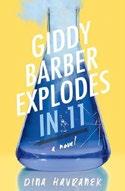
Sometimes, being “the responsible one” takes a toll. Ever since her older brother started college, 15-year-old Giddy has been expected to care for her three younger siblings. From getting them up and on the bus in the mornings to fixing dinner and ensuring their homework gets done, Giddy does it all. She can’t remember the last time she smiled, her stomach constantly burns, and she’s exhausted. She sees a post on an alternative medicine forum about “opposition therapy”—a term coined by the poster for their experiment in reversing their habits and doing something unexpected each day. Intrigued, Giddy begins her own trial to see whether 11 days of doing the opposite of what everyone expects of her will snap her out of her
grayness. Her new behaviors quickly grab the attention of her family, teachers, and peers. The level of detail that debut author Havranek provides about Giddy’s thought processes behind each choice bogs down the story’s flow. Giddy’s mother, an overworked nurse, is impatient for her oldest daughter to go back to the way she was. Not until a tragic accident does her mother show true remorse for the weight she’s put on Giddy. While Giddy ultimately realizes on her own that she needs therapy, there’s a missed opportunity in not further addressing mental health ramifications within the story or in backmatter. Major characters are cued white.
A well-meaning if sometimes muddled story of one teen’s efforts to break free of parentification. (Fiction. 12-18)
Janae, Micki | Three Rooms Press (400 pp.) | $17.00 paper Oct. 8, 2024 | 9781953103444
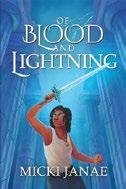
A teenage girl and her friends must harness the powers of the Greek gods to save the world.
After Ophelia’s father dies unexpectedly, she leaves Austin and moves back to New River, North Dakota, to live with her aunt Cherice and uncle Janus; her mother’s identity has always been a mystery. Still grieving, high school senior Ophelia, who’s Black, meets new people and tries to settle in, though she starts to realize that her family may be harboring some secrets. When a series of unusual dreams plagues
A queer reimagining of a classic Chinese folktale that feels timeless.
LEGEND OF THE WHITE SNAKE
Ophelia and her racially diverse group of friends, they soon discover that they’ve each been given the power of a different Greek god. As they’re learning what this means, they learn from a mysterious messenger that not only are they in danger, but the future of humankind is as well—and they’re the only ones who can help. Armed with this information, they set off on a series of quests to stop a total apocalypse. Janae’s writing style is compelling but occasionally moves too rapidly, not allowing readers to fully digest the new information she’s introduced. Additionally, while fans of similar contemporary fantasies based on Greek mythology might enjoy this story and its many nods to classic tales, the lore, which contains many moving pieces, is difficult to follow at times. A fast-paced debut. (Fantasy. 14-18)
June, Jason | Melissa de la Cruz Studio (352 pp.) | $18.99 | Oct. 1, 2024 9781368089241 | Series: The Spells We Cast, 2

Soul mates
Nigel and Orion possess knowledge that could upend the magical world, but some magicians will stop at nothing to prevent that information from getting out. Picking up where The Spells We Cast (2023) left off, Nigel and Ori, who are white, are on the run from the Guild and under the protection of the Resistance. After being brought back from the dead, Nigel isn’t the same: There’s an evil voice in his head that grows stronger with anger. And while the boys and their friend Bex, who’s Japanese American, know that magical imbalance is a lie and that the Guild is unnecessarily stripping teen magicians of their powers, a spell prevents other members of the Resistance from remembering this fact. Thankfully, Nigel has a secret informant who’s still in the Guild. South Asian American Jaleesa wants to learn more about
Nigel’s and Ori’s powers, which are amplified through their soul mate connection; she might be able to do the same with her girlfriend, white-cued Laurel (although Laurel wants to take down Nigel and Ori). Unlike the first book, which focused on Nigel, this ensemble piece shifts focus among several characters. While this structure slows the pace, particularly in the beginning, it ultimately makes the themes richer as the story delves into relationships, parental expectations, empathy, and animosity from various viewpoints. Filled with riveting magic, this dazzling, queer-affirming world will sweep fans up.
Love conquers all in this satisfying duology closer. (Fantasy. 13-18)
Kouno, Fumiyo | Trans. by Ko Ransom Udon (132 pp.) | $12.99 paper Oct. 8, 2024 | 9781772943085
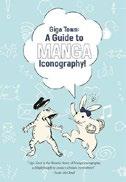
A n engrossing guide to manga symbols translated from Japanese.
Kouno, an award-winning Japanese manga artist, offers a detailed look into the world of manpu, the iconography used in manga, which comprise everything from symbols hovering around characters’ heads and bodies to elements in the backgrounds of the panels. In his introduction, Tokyo-based author, reporter, and translator Matt Alt describes the rich history of manpu, from symbols adopted from foreign cartoonists to ones developed by Japanese artists for what was initially a national readership; today manga and anime adaptations have achieved phenomenal global success. Surprisingly, this is the first English-language guide to understanding manpu. The work opens with a table of contents showing each symbol and the pages where it appears. Kouno’s manga panels portray each manpu in context, with explanatory text
on the side; many manpu appear on multiple pages, reinforcing readers’ grasp of their meaning. Some will be intuitive to Western readers, but others are deeply embedded in a Japanese cultural context that’s explained in text boxes. An interesting afterword teaches the flow of manga reading, information that will be particularly helpful for beginners. This is a useful book for those who are looking to get into manga but don’t know where to start, but it’s also riveting reading for anyone interested in manpu’s cultural roots. A fresh and intriguing manual of tremendous use for English-language manga fans. (Nonfiction. 12-18)
Lee, Sher | Quill Tree Books/ HarperCollins (352 pp.) | $19.99 Oct. 15, 2024 | 9780063327191

Fate complicates the budding relationship between a young prince and a snake spirit.
Seven years ago, Xian’s and Zhen’s paths crossed when, as a snake, Zhen saved the 10-year-old Prince Xian from drowning. Xian is left haunted and bewildered by that day—the white snake who saved him also swallowed the spirit pearl that would have cured the pain his mother has experienced ever since being bitten by a white snake. Now, with her death imminent, Xian is desperate to find another white snake, the last ingredient he needs to complete an antidote. When an oracle reveals where they should look, Xian sets off for the town of Changle. He meets Zhen, now in the form of a stableboy, and is instantly drawn to him. As Xian’s and Zhen’s trajectories collide once more, the recently transformed snake spirit Zhen is left to reckon with his feelings for the prince. Against his own instincts, Zhen is unable to leave Xian alone, but revealing the truth of his identity—that he’s the white snake Xian is hunting for—could ruin everything. Set in a
captivating xianxia world inspired by the titular Chinese folktale, this work is packed with earnest romance and drama. Lee skillfully packs her story with angst and action, creating stakes that will have readers rooting for Xian and Zhen’s love to succeed. A queer reimagining of a classic Chinese folktale that feels timeless. (Fantasy romance. 14-18)
Lerose, Robert | ReferencePoint Press (64 pp.)
$33.95 | Sept. 1, 2024 | 9781678207724

A n overview that presents a contentious topic in a clear and dispassionate light. The introduction describes the state of abortion rights in the U.S. in the wake of the 2022 Supreme Court decision in Dobbs v. Jackson Women’s Health Organization, which rescinded Roe v. Wade, the historic 1973 case that legalized abortion. The first chapter recounts the historical context, starting from the early 19th century. Two subsequent chapters focus on risks to women and medical professionals as a result of abortion restrictions. The two final chapters present current efforts to completely ban abortion and the opposing drive to restore abortion rights. Short narratives depict and quote people who have been affected by the Dobbs ruling, showing the emotional impact and medical hazards of pregnancy complications and limited health care access. Relatedly, the book describes the “sizable segment of women” who are avoiding pregnancy “because they are fearful that Dobbs robs them of the health care…they require.” Textboxes present relevant background information, such as the story of the actual Jane Roe. Graphs, charts, and photographs break up the text. Lerose describes anti-abortion groups’ embrace of “the personhood of every fetus,” highlighting the spread of student groups. Disappointingly, the book doesn’t connect positions on
abortion with various religious teachings, and some complex information, such as the possible mental health impact of abortion, is presented without sufficient context. Nevertheless, this is an accessible and timely resource.
A brief, balanced overview of a fraught and complex issue. (source notes, organizations, for further research, index, picture credits) (Nonfiction. 13-18)
Lowham, Elizabeth | Shadow Mountain (272 pp.) | $20.99 Oct. 1, 2024 | 9781639933204
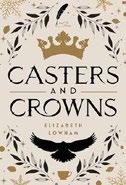
Crown Princess Aria has mentally tallied every mistake she’s made since she was 8, but one moment of misguided optimism sees her trapped by the greatest mistake of her life.
The execution of Charles Morton, heir to his family’s estate, drags the kingdom to the brink of war. Eighteen-year-old Aria, against her father’s orders, tries to broker peace with the grieving Dowager Countess Morton, who stands for the maligned magic-wielding Casters, but her negotiations fail, with terrible consequences. Charles’ mother places a curse that will kill off the king’s line one by one over the course of 100 days. Meanwhile, newly orphaned Guillaume Reeves faces troubles of his own. As a Caster, he’s stripped of the title of baron, crushing his hopes of having a voice in the kingdom. When circumstances bring Aria and Guillaume together, what starts off as an exercise in mutual benefit (and distrust) steadily blossoms into something deeper—something that might mend the break between Casters
and crown for good…assuming they don’t run out of time. Though the worldbuilding is somewhat shallow, the intricate plot unfurls steadily, allowing for deep character development. Lowham gives familial relationships as much weight as the slow-burn romance, which feels wonderfully believable. Heavy themes—the overcoming of internal and external trauma, the difficulties of effecting change against generations of prejudice—are handled sensitively and are served well by the rich prose. Most characters present white. A leisurely paced fantasy with refreshing emotional depth. (Fantasy. 13-18)
Luken, Erin | Bloomsbury (384 pp.) $19.99 | Oct. 1, 2024 | 9781547613960

A magic-wielding girl tricks her way onto enchanted Estaralla but discovers that the island—and its magic—are more likely to kill her than to save her.
Lucia Arduini
must get to the exclusive island of Estaralla and steal its source of magic in order to pay off the gangs to which her family is indebted. With craftiness and the use of insider information from her Estarallan ex-boyfriend, Antony, Lucia makes it onto the island as part of a luxury tour for the wealthy Rubellian family. Even as she lies to everyone about her motives for visiting Estaralla, Lucia firmly believes that finding and stealing its source of magic is her only path to freedom. Once on the island, however, she discovers that the enchanting illusions aren’t the only things that aren’t quite what they seem. Unsure if
she can trust intriguing host Calista, moody Oriana Rubellian, or Antony, who claims to still love her despite his multiple betrayals, Lucia must uncover the island’s secret before she becomes another one of its mysterious and violent casualties. The bisexual love triangle offers a fun diversion from the confusing plot’s twists. The Italian-influenced world of the novel is built on excessive, minute detail and sprawling worldbuilding that can be difficult to track. The main characters are diverse in sexual orientation and read Mediterranean. An appealing queer romance that buckles under the weight of the fantasy world’s intricacies. (Fantasy. 14-18)
Macek, Sandra | Snowy Wings Publishing (388 pp.) | $19.99 paper | Oct. 22, 2024 9781958051733 | Series: Scorched Earth, 1
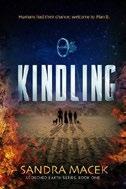
A futuristic vision of an unsustainable Earth. A diverse group of four protagonists—Mercy Adams, Van Elder, and siblings TJ and Eddie LeRoux— together bring their varied narrative voices and skill sets to this novel’s world of political intrigue. Due to climate change, Earth is now called Scorch. In response to a fertility crisis, scientists created the praenex, humans who have telepathy, precognition, rapid maturation rates, and the ability to talk directly to the Creator via a sensory organ in their foreheads. Large humans called sapiens coexist with the smaller praenex and rely on them for guidance. Over time, Scorch has become divided into two political factions: Terrans believe that the planet can be healed through science, while Pilgrims, who outnumber them, believe that humans should colonize outer space. Major and minor characters regularly introduce themselves along with their pronouns, although they do this inconsistently and at times repetitively. Descriptions
of characters’ skin color are also abundant throughout the text, emphasizing the world’s wide-ranging racial and ethnic groups. Some of the language used seems to undermine the goal of inclusivity, however. The novel’s multitude of storylines create a disorienting reading experience that is intensified by the confusing worldbuilding, poorly handled flashbacks, overuse of opaque dialect, the manner of introducing and defining invented terminology, and switches between multiple points of view.
An overly complex, disorganized work with some mixed handling of diversity. (Science fiction. 16-18)
McLeod, Albert with Elaine Mordoch & Sonya Ballantyne | Illus. by Alice RL HighWater Press (56 pp.) | $18.95 Sept. 10, 2024 | 9781774921043
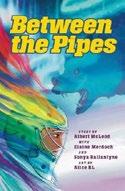
A wholesome story about self-acceptance. Cree teenager Chase has two close friends, Kevin and Jade. His homophobic hockey teammate Leo continually picks on him for hanging out with Kevin, calling them boyfriends. School is hard enough already—add in feeling different from the other boys, and for Chase, it’s too much. He distances himself from Kevin and starts hanging out more with Jade, even trying to kiss her just to fit in. When the hockey team learns that a scout is coming to see them play, Chase decides to focus wholeheartedly on sports. As he pushes his friends away and lashes out at his grandmother, isolating himself, everything comes to a boiling point. The story focuses on Chase’s internal conflict: He dreams of a giant, imposing bear (which an elder explains is a symbol that can inspire “us to face our greatest enemy—ourselves”) as well as of worst-case scenarios in which he’s bullied by his teammates and coach. In reality, only Leo is outwardly
hostile, and his school offers support for queer students, including running a gay-straight alliance and hosting a Two-Spirit filmmaker from Manitoba’s River Winds Nation; it’s largely Chase’s internalized homophobia that holds him back. The straightforward story, which prominently features shades of pink in the illustrations, also includes positive depictions of Indigenous culture, through acts of smudging and Cree vocabulary. Highlights the importance of community and cultural connection as roots for embracing one’s identity. (content warning, authors’ note) (Graphic fiction. 12-18)
McNicoll, Elle | Wednesday Books (336 pp.) $24.00 | Oct. 1, 2024 | 9781250335517
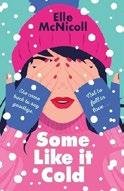
Returning home after 18 months away at university, a neurodivergent girl discovers herself amid the chaos of a family wedding and the filming of a documentary. Jasper Montgomery is Lake Pristine’s golden girl, a label her influential family adores, especially after working hard to hide Jasper’s autism. Jasper agrees to help cast and direct her mother’s ballet company’s production of The Nutcracker and plan her often tyrannical sister’s wedding, all while trying to explain to her family why the life they’ve planned for her doesn’t make her happy. Oddly, the only person who seems to understand her emotional and sensory needs is Arthur Lancaster, a former classmate who’s always been a bit short with her. Arthur accepts a plea from Marcus, his cousin, to join him in creating a documentary on their small town to enter in a contest for a cash prize—a short film that will expose “the rigid oppressiveness” beneath the shiny, respectable surface of the town and families like the Montgomerys. Arthur films and interviews Jasper for the project, and the two form a bond that
breaks through their usual brusqueness. Jasper’s interactions with her family are often troubling, highlighting her self-awareness and grit in the face of their unkindness, while Arthur is lovably quiet and gruff. Readers will appreciate the thoughtful examination of social dynamics and expectations. Main characters read white. A sweet coming-of-age story that provides important representation. (author’s note) (Romance. 12-18)
Miller, Linsey | Disney Press (384 pp.) | $18.99 | Oct. 1, 2024 9781368085489 | Series: Princes, 3
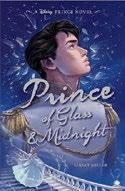
T he latest hero’s backstory from the Disney universe stars Cinderella’s prince. Although the king wants him to marry, Prince August clings to the memory of his first crush, Ella, who lives in Fresne. The two were close even though August, at his parents’ urging, kept his royal status secret, but Ella withdrew after her widowed father remarried and then died. Warned off by her stepmother, August reluctantly gave up trying to reach Ella. His friend Martin’s investigation of a series of strange occurrences in Fresne gives August the chance to return to his mother’s hometown. He finds Ella wary but happy to see him, and she joins their search to learn why several townspeople have forgotten someone close to them. Solving this mystery occupies much of the novel. Miller works to update the world of the original 1950 movie version, but the prince unfortunately remains a bland placeholder (he dances; he grapples with the mystery of the glass shoe). The French-inflected world includes LGBTQ+ characters who are woven naturally into the story. (Martin becomes smitten with a young man named Oliver, whom he meets in Fresne, and one of the amnesia victims, Blaise, uses they/them pronouns.) The leads are
cued white; there’s some diversity in skin tone among the supporting cast. An underwhelming spinoff that may satisfy avid Disney fans. (Fantasy. 12-16)
Mix, Rebecca | Illus. by Heather Burns & Luiz Fernando da Silva | Andrews McMeel Publishing (112 pp.) | $14.99
paper | Oct. 22, 2024 | 9781524880590
Series: Neopets, 1
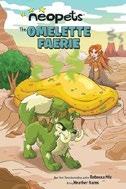
A delightful adventure set in the world of the popular online game. In the heart of Tyrannia sits the popular Giant Omelette, which mysteriously regenerates itself so that all the Neopets can have the chance to eat it. Sabre-X’s job is to stand guard and ensure that no Neopet has more than one slice of omelette each day. But when exiled faerie Seraphina approaches Sabre-X to tell him that the omelette is in trouble, he doesn’t believe her—and soon those who eat it become sick with Ugga-Ugga. Sabre-X goes after Seraphina, hoping they can fix the problem together. During their journey, they discover that Marina, Seraphina’s ex-girlfriend, has gone missing—and they must put everything right before the equinox arrives in two days. As the duo (plus their two cute companions) run into more obstacles, they also discover a hidden agenda and the reason for Seraphina’s banishment from Faerieland. Fans will appreciate that the brightly colored illustrations are drawn in the same style as the website and feature adorable animal characters and faeries drawn as beautiful girls
(Seraphina and Marina are lightskinned, with red and blond hair, respectively). The satisfying ending, likable main characters, and fun banter make this an appealing adventure for nostalgic readers who grew up playing Neopets as well as those who are new to this world. Exciting and endearing from start to finish. (Graphic fiction. 12-18)
Moldover, Joseph | Margaret Ferguson/ Holiday House (304 pp.) | $19.99
Oct. 29, 2024 | 9780823456192

A teen becomes a reluctant caretaker for her nephews in this contemporary novel set in the fictional moneyed town of Evans Beach, near Portland, Maine. Seventeen-yearold Hannah Lynn has lived with her absent-minded but loving dad, an employee of the public works department, as her sole parent since her mother died when she was 4. Selfreliant and smart, Hannah plans to get out of Evans Beach once she graduates. She’s eager to leave the snobby town behind for good. When her dad agrees to a kinship placement for his grandsons—Henry, 13, and Simon, 9—after Hannah’s troubled older sister, Pauline, has them removed from her care, she finds herself pulled into more involvement with them than she intended. Hannah and her father’s warm, imperfect relationship and the realistic, sometimes intense portrayal of her nephews’ struggles permeate this nuanced story. The details about the complicated child welfare system are spot-on, and a sweet romance between
An honest, moving portrayal of life’s challenging moments.
Hannah and her quirky, kind classmate Richard Greene will pull readers in. If the dialogue feels a little too clever and snappy in moments of stress, it’s also often very funny and balances this earnest, heart-wrenching story. Major characters read white. An honest, moving portrayal of a family finding their way through life’s challenging moments. (author’s note) (Fiction. 13-18)
Moore, Rachel | Harper/ HarperCollins (368 pp.) | $19.99 Sept. 3, 2024 | 9780063284685

Amateur archaeologists race to claim an allegedly magical Roman relic. Margot Rhodes isn’t exactly famous for her follow-through; she’s quit activities from watercolor painting to taekwondo. So it’s no surprise that her snooty boarding school classmates are more than a little skeptical when she impulsively applies for and is accepted into a six-week archaeology summer class in southern Italy. Armed with a special volume from her school library—the personal journal of archaeology wunderkind Van Keane, who tragically died in a 1932 dig site collapse in Pompeii—Margot is determined to find the missing pieces of the Vase of Venus Aurelia that Van was searching for. But when she stumbles upon a marble statue that eerily resembles the boy whose words have captured her heart, she gets more than she bargained for. Her discovery awakens the long-frozen Van, who’s decidedly less poetic and a great deal surlier than his journal let on. The two become unlikely partners in the hunt for the vase and must prove themselves worthy of the treasure by completing tasks that test their wits and courage before their competitors—and the curse that turned Van to marble to begin with—beat them to it. Unfortunately, Moore neglects the setting’s
potential, and the story’s minimal attention to detail undermines its rich historical aspects. Plot holes and unconvincing villains also weaken the story, but Margot and Van’s banter and chemistry are engaging. Main characters are cued white.
A fun but insubstantial genre mashup. (Romantic adventure. 12-18)
Oakes, Colleen | Simon & Schuster (416 pp.)
$19.99 | Oct. 22, 2024 | 9781665952583

The residents of Weymouth Island have a secret. Hidden off the coast of Nova Scotia, their island is a gateway between the living and the dead. Roughly every decade, the Storm comes, bringing the dead up from the ocean. They’re drawn to the foundation stones of each of the eleven houses of the island’s families: Cabot, Beuvry, McLeod, Gillis, Nickerson, Pope, Pelletier, Des Roches, Bodhmall, Grimes, and Mintus. The dead attempt to reach the mainland, but the family members prepare by laying traps. Seventeen-year-old Mabel Beuvry knows the Storm’s danger; the last one killed her father. Her mother turned to alcohol, and her younger sister became agoraphobic. Now, Mabel and her House Guardian, Jeff, care for their estate. The arrival of Miles Cabot is a bright spot—he and Mabel feel an instant, almost mystical, connection. But the island’s inhabitants fear their attachment, blaming Miles for changes they sense, and rumors swirl of an impending Great Storm. Oakes’ swoony, gothic tale blending elements of White Walkers and The Fog features an original history that vividly breathes life into Weymouth. Historical journal entries explain the island’s rituals and beliefs, and a surprise twist and action-packed fight scenes against the dead keep the suspense alive. Most characters are white, the Nickersons are the island’s only Black family, and
Miles is described as having generically “Asian heritage.”
A robust plot and worldbuilding makes for an engaging, atmospheric read. (map, list of Storm years, list of houses) (Fantasy. 14-18)
Raasch, Sara & Beth Revis | Sourcebooks Fire (320 pp.) | $18.99 | Oct. 1, 2024 9781728277554 | Series: Witch and Hunter, 2
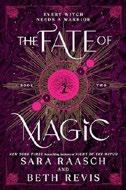
A witch and a warrior must form a sacred bond to protect all magic in this sequel to 2023’s Night of the Witch Fritzi and Otto have settled in at the Well, and the local villagers, aware of the existence of magic following their battle with Dieter, largely accept the Black Forest witches. With Dieter assumed to be dead “or as good as,” the couple turn their attention to other matters—becoming a bonded pair, chosen by the goddess Holda to be a champion (Fritzi) and a warrior (Otto). They also hope to convince the coven that wild magic isn’t inherently bad. But the bonding ceremony goes awry, and they discover that Dieter is not only still alive, but he’s also secretly bonded with Fritzi, using her as a conduit to uncover the council’s secrets, thus putting all magic in danger. Fritzi, Otto, and their friends embark on a quest to find magical artifacts in order to stop Dieter. This book continues the exploration of paganism and Christianity in 16thcentury Germany with a focus on free will versus fate in both religious traditions; knowledge of the earlier entry is a must. The slow pacing of the book’s first half picks up as the action intensifies. The authors switch between the leads’ first-person perspectives, but it’s easy to lose track of who is speaking. The cast members’ camaraderie, humorous dialogue, and sense of found family elevate the story, however. Returning fans will be pleased with this neatly wrapped up duology closer. (content warnings) (Fantasy. 14-18)
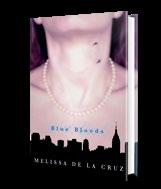
Melissa de la Cruz’s series of young adult vampire novels is headed to the small screen.
Melissa de la Cruz’s Blue Bloods series of young adult vampire novels is
headed to the small screen, Deadline reports.
Entertainment company Awesomeness, which is behind series including PEN15 and XO, Kitty, is
Melissa de la Cruz
developing de la Cruz’s books as a series.
The Blue Bloods series follows Schuyler, a teenage girl who is a member of a family of high-society vampires in New York. The series debuted in 2006 with Blue Bloods , which a critic for Kirkus called “delightfully trashy.” More than a dozen installments in the Blue Bloods universe followed, including Masquerade, Revelations , and, most recently, After Death .



For reviews of the Blue Bloods books, visit Kirkus online.
Jacquie Walters, who has written for TV series including Just Add Magic and Polly Pocket, will write for and executive produce the series. De la Cruz will also serve as an executive producer.
De la Cruz said in a statement, “I am so excited to bring my beloved Blue Bloods series to life with a stellar team at Awesomeness, Gotham, 3Arts and our incredible writer Jacquie Walters who understands my story and characters deeply. Cannot wait to see them on screen at last!!! LFG!!!” Walters announced news of the adaptation on Instagram, writing, “We are cooking up something GOOD for y’all, just wait.” —M.S.

By Ferin Davis Anderson and Stephanie Sammartino McPherson

Joy Hakim
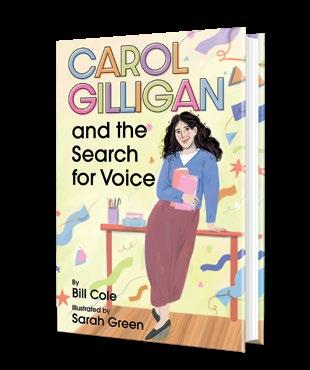
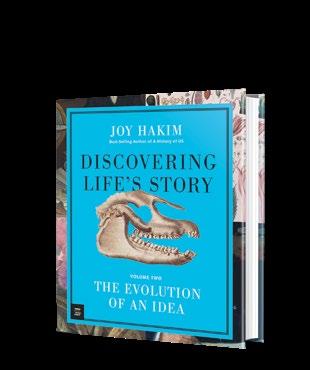
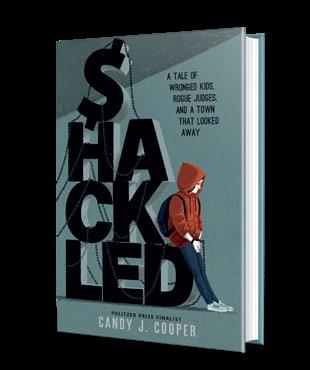
Candy J. Cooper


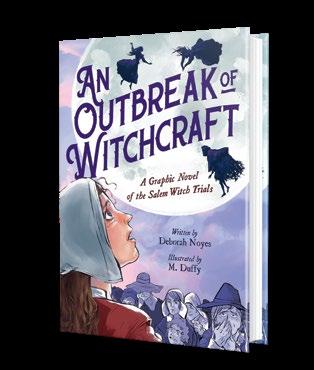
Reekles, Beth | Delacorte (384 pp.)
$12.99 paper | Oct. 22, 2024 | 9780593809082
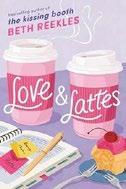
A n English girl finds herself caught up in a messy romance during a prestigious London internship.
Anna Sherwood has put everything into getting a paid internship at electric vehicle manufacturer Arrowmile, including lying about the fact that she has only one year at the University of Leeds under her belt. She’s determined to take full advantage of the opportunity in hopes of laying the groundwork for her future career. While out clubbing and drinking tequila shots with the 14 other interns during their icebreaker evening, Anna meets a cute stranger named Lloyd, and the mutual attraction is instantaneous. After a night of cheesy chips and an intoxicating kiss, they part ways, never expecting to see each other again. But on Anna’s first day at Arrowmile, she discovers that Lloyd is CEO Topher Fletcher’s son. He initially pretends not to know Anna, hurting her feelings. But when it turns out that Lloyd wants more, Anna pushes him away, afraid she’ll be seen as using him to get ahead. Prickly, misguided, and prone to overwork, Anna shows growth and better self-understanding as she learns that she doesn’t have to sacrifice love to get ahead. Lloyd reveals his own layers, remaining steadfast in his interest, despite Anna’s barriers. The taut romantic tension becomes steamy and rewarding when they do get together. Lloyd is cued as biracial (Indian and white); Anna presents white. A satisfyingly textured office romance. (Romance. 15-adult)

A realistically complex yet hopeful account of eating disorder treatment.
Rishi, Farah Naz | Quill Tree Books/ HarperCollins (352 pp.) | $19.99 Oct. 8, 2024 | 9780063251502
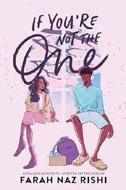
A college student gets a muchneeded lesson in letting go of perfection.
Anisa Shirani, a young Pakistani American Muslim woman, strives to maintain a picture-perfect image for her Instagram followers, peers, and almost-fiance, Isaac Jamil. Lately, however, Isaac has seemed distant, and tensions at home are escalating between Anisa’s parents. Anisa is paired with Marlow Greene, a Jamaican boy who’s Black and Indian, for a project for her Race & Ethnicity class. She’s initially put off by his fashion sense (cargo shorts and Crocs?) and open demeanor, but when Marlow witnesses Isaac flirting with another girl, he offers to be Anisa’s “love coach” and help her win him back. When Anisa and Marlow build an actual relationship, complications arise as they confront secrets and disapproval. The novel provides a realistic backdrop and a refreshingly diverse set of characters but lacks depth. While Anisa’s struggles with perfecting her image and Rishi’s use of trending pop-culture references may be relatable to some readers, Anisa’s obsession with her looks largely feels like a caricature, and her eventual growth doesn’t come across as earned or satisfying. Marlow’s romantic interest in Anisa isn’t convincing, particularly given her apparent judgmental behavior when they first meet. Similarly, the progress in most of Anisa’s relationships isn’t built on a foundation of believable
interactions, making the happy outcomes feel rushed.
Timely themes undermined by an absence of the emotions required to make a lasting impact. (Romance. 14-18)
Rockler, Naomi | ReferencePoint Press (64 pp.) | $33.95 | Sept. 1, 2024 9781678207908

Though teen girls have always faced immense pressure, today’s generation is encountering different challenges than earlier ones.
Rockler presents an overview that’s separated into chapters on anxiety, social media, body image, cyberbullying, and getting and providing help. While many stressors have long been around, social media and isolation caused by the Covid-19 pandemic are new. The author summarizes important findings showing how the pandemic has adversely affected how teens socialize and negotiate friendships. In addition, anxiety in the form of school avoidance has also increased as students have reverted from virtual to in-person learning, a mental health crisis that some schools have handled punitively. Exposure to perfectly curated social media content has also contributed to unrealistic comparisons and heightened feelings of insecurity, amplified by cyberbullying, which can be vicious in its anonymity. Rockler presents this information in a direct voice, one that is accessible both to teen girls themselves and to adults who need
to understand what teens are contending with. This concise but thorough guide also touches on the body positivity movement and the impact of racism and homophobia, closing on a positive note with a chapter that reassures readers that they’re not alone and directs them to avenues of help. Color photographs showing a diverse range of girls enhance and break up the text. A helpful volume that presents useful research to support teen girls and the adults in their lives. (photo credits, source notes, for further research, index) (Nonfiction. 12-18)
Sattin, Samuel | Illus. by Steenz | Versify/ HarperCollins (208 pp.) | $18.99 paper Oct. 8, 2024 | 9780358616375

In this conversationally narrated graphic novel, Sattin and Steenz (starring as themselves) explore the history of role-playing games.
Tabletop role-playing games combine elements of imaginative play, interactive storytelling, and statisticsbased tactical gaming. The evolution of the TTRPG began long before the creation of Dungeons & Dragons. After explaining the basics of modern TTRPGs, Steenz (a nonbinary Black person) and Sattin (a light-skinned man with dark hair) invite readers on a nonlinear journey through time and around the globe. They discuss how interactive theater and tactical war games contributed to the creation of role-playing games—both live action and tabletop. The information is well organized and appealingly illustrated, divided into six parts that each focus on a different aspect of TTRPGs—“Beginning the Adventure,” “Books of Lore,” “From Battlefield to Sandtable,” “Assume Your Role,” and “Magic in the Modern World”; “Continuing the Adventure” then describes how the modern TTRPG is still evolving.
Throughout, Steenz and Sattin acknowledge and critique the racism, sexism, and other forms of discrimination embedded in the ideologies that influenced the development of modern TTRPGs, including The Lord of the Rings and Conan the Barbarian. They also highlight the work of gamers from marginalized backgrounds who are increasing inclusion and accessibility. The concluding miniadventure offers an exciting, conflict-filled setting, but an overinvolved nonplayer character creates a rigid story structure and dampens the thrill of the heist.
Engaging, informative, and comprehensive. (creators’ note, glossary, bibliography) (Graphic nonfiction. 12-18)
Schrefer, Eliot | Harper/HarperCollins (464 pp.) $19.99 | Oct. 1, 2024 | 9780063343764

Outside Us (2021).
After establishing a struggling colony on a new planet, Ambrose’s and Kodiak’s clones must survive new threats in this sequel to The Darkness
Only two children have survived attempts to bring viable embryos to the new world: Owl, who yearns to explore much like her aunt Minerva, from whom she was cloned, and sensitive, steady Yarrow, who has “no blood relations.” Upon turning 16, Yarrow starts acting oddly, but the threat of a comet strike takes priority, and he hides what’s happening to him. The narrative following their problems in the year 32,481 alternates with a past timeline in which the original Ambrose and Kodiak learn the truth of their mission. Not only do they have their own heartache and grief, but after being brought together in an attempt to destabilize Earth’s two remaining governments, they’re left to deal with the fact that the fates of all of humanity lie in their hands. Though the storylines eventually wind together, their initial
disjointedness delays the book’s full emotional impact. But when it finally lands, it packs the full punch of humanity’s potential ills balanced with hope of the good we might achieve. The realism of the struggles the characters face keeps the story engaging, and returning fans will appreciate the time spent with the original Ambrose and Kodiak. Ambrose and Owl are brown-skinned, and Kodiak and Yarrow are coded white.
Complex and brimming with pathos.
(Science fiction. 14-18)
Seal, Lauren | Rocky Pond Books/ Penguin (352 pp.) | $19.99 Oct. 8, 2024 | 9780593700143

A girl’s experience of being hospitalized with anorexia illuminates the complicated nature of treating eating disorders. This skillfully crafted verse novel follows white 14-year-old Evie, who’s recently been diagnosed with “extreme malnourishment” due to anorexia, as she enters and completes a course of a few months of inpatient treatment. Evie is placed on a strict and steadily increasing calorie regimen, and as she improves, she meets others who are struggling with eating disorders, learning how diverse these patients’ backgrounds are and how varied the presentation of their disorders can be. As Evie works through therapy and makes strides toward going home, she worries that she won’t be able to maintain her progress on the outside—a not-unfounded fear, which, combined with the range of secondary characters’ experiences, gives Seal the opportunity to show readers why eating disorders can be so hard to treat. The story is informed by the author’s own life, lending tenderness and understanding to its insights. The spare details support strong characterization: Evie’s mother’s good (but poorly expressed) intentions and her sister’s open, vulnerable conversations
illustrate well how family members can hurt or help recovery efforts. Readers who are grappling with these issues may find it difficult to read about specific calorie counts as well as the explicit descriptions of dangerously familiar patterns of thought and unhealthy weight-loss strategies. A realistically complex yet hopeful account of eating disorder treatment. (author’s note, resources) (Verse fiction. 13-18)
Searle, Sarah Winifred | First Second (240 pp.)
$25.99 | $17.99 paper | Oct. 22, 2024 9781250863195 | 9781250863188 paper

In Maine, a newly diagnosed diabetic and a newly turned vampire form an unlikely connection. Perley and Amandine both missed weeks of school during their junior year. Perley had a health crisis that led to the discovery that he has Type 1 diabetes. After Amandine was in a serious car accident, she received a blood transfusion that turned her into a vampire but saved her life. The teens bond as they catch up on missed schoolwork and reflect on how different their lives have become: Perley lives on a family farm and needs to be more mindful about physical labor, while Amandine loves field hockey, but her photosensitivity prevents her from playing. After Amandine attends a first aid course and discovers her ability to accurately taste blood glucose levels, the friends decide this is the perfect solution: The vegan Amandine could use the energy boost from real blood, while Perley can save money on testing strips and stay on top of his readings. A sweet romance blossoms between them. Both teens have concerned and supportive parents and friends. Importantly, the book also discusses the various ways that chronic illness has an impact on daily life. Clear dialogue bubbles make for an easy reading experience, and the soft color palette adds an appealing warmth, as do the adorably
fluffy farm animals. Perley is Jewish and reads white, while brown-skinned, black-haired Amandine is from a multiethnic Cajun family.
A cozy paranormal romance that’s full of heart and humor. (minicomics, character sketches) (Graphic paranormal. 14-18)
Sølvsten, Malene | Trans. by Adrienne
Alair Arctis Books (590 pp.) | $22.00
Oct. 15, 2024 | 9781646900275
Series: Whisper of the Ravens, 2
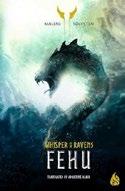
A girl’s prophecydriven journey through the landscape of Norse mythology continues in this sequel to 2023’s Ansuz , translated from Danish.
Clairvoyant Anna’s giant wolf, Monster, reappears from the gods’ world on the verge of death, bearing a dire warning. The ruler of Hrafnheim, Ragnara, has captured Anna’s sister, Serén, and intends to capture Anna, too, because of the prophecy linking Anna’s blood to Ragnara’s downfall. Rather than wait for the danger to find her, Anna makes her way to Hrafnheim through an ill-fated deal, is captured upon her arrival, and escapes with a soldier named Rorik. Anna embarks on an epic quest, experiences violent visions of death, and navigates an important case of mistaken identity to rescue Serén from her sacrificial fate before Ragnarök begins. The expansive worldbuilding and intricate web of coinciding storylines are fairly smoothly plotted with few expository sections, although the story feels overlong and confusing at times. Those interested in the myriad Norse mythological details woven throughout will be satisfied, and the glossary of people, places, and things is extremely helpful. But even though the central mysteries are compelling, the individual characters are rather flat and read more like adults than teens. The story is weakened by some troubling content around questions of consent in a sexual relationship, the presentation of a
transgender character, and a reference to “normal skin color.” Most characters present white.
A complex mythological adventure that suffers from its length and shallow characterization. (translator’s note) (Fantasy. 14-adult)
Spencer, Chloe | Tiny Ghost Press (286 pp.) $21.99 | Oct. 1, 2024 | 9781915585196

A queer ghost hunter is on the hunt not just for a ghost but a murderer. Everyone expects Melody Myere to be as talented a ghost hunter as her parents are. But when she fails her First Sacred Hunt following an unfortunate confrontation with a wraith, she brings shame to her family. Hoping for a fresh start, her parents take an assignment on Murkmore, a dump of an island where two adult men and three high school boys have “turned up as mutilated, ectoplasm-covered corpses.” While her parents focus on their task, Melody, who’s white, is determined to prove—to herself as well as everyone else—that she’s a worthy ghost hunter. What Melody doesn’t anticipate is meeting Cyrus Paredes-Pantazis, a butch violinist of Greek and Ecuadorian descent who doesn’t know that she’s a ghost. An unlikely romance develops between the two as Melody tries to find out how Cyrus died. There’s a dangerous connection between the two teens because Cyrus is slowly deteriorating, and she’s a ghost whom Melody should be capturing, not canoodling with. Melody is also proving to be a skilled detective; the closer she gets to the truth, the more imperiled she becomes. The narrative is filled with surprises, as well as further insights into the complexities of ghost culture.
Illuminating, riveting, and entertaining: a fantastic foray into a ghost hunter’s worst nightmare. (content warning, glossary) (Paranormal mystery. 14-18)
Kirkus Star
Rabbit & Juliet
Stafford, Rebecca | Quill Tree Books/ HarperCollins (336 pp.) | $19.99
Sept. 24, 2024 | 9780063351363

A small-town teen meets a promising new friend.
Both Sadie, who goes by the nickname “Rabbit,” and her dad are mired in grief, but they’re coping in different ways: Her dad’s remedy is gin, while Rabbit attends group therapy. Rabbit is lonely—her sorrow over her mom’s death is so all encompassing that she’s alienated herself from her friends. It’s summer break when Juliet, the daughter of the only movie star in Hart’s Run, Georgia, turns up in her bereavement group. Rabbit is immediately bowled over by Juliet. Early in their friendship, Rabbit spots Richard, her wealthy ex, at the local diner. Without yet knowing the details of how awful Richard was, Juliet senses from Rabbit’s discomfort that something troubling happened, and she slams a food tray into his face. Rather than setting off warning bells, this moment solidifies Rabbit’s awe of Juliet. Told with wry humor and unfolding with a sense of impending dread, the narrative homes in on how easy it is to misplace your trust—whether in people you’ve known your whole life or someone shiny and new. The impact of misogyny reverberates throughout the book, which centers on girls who want to speak out but are cautious to do so. It also offers a window into the complexities of how vengeance feels while taking a hard look at the consequences of revenge. The leads are cued white.
A thrilling ride into the heart of a dangerous friendship. (Fiction. 14-18)

Told with wry humor and unfolding with a sense of impending dread.
RABBIT & JULIET
Stone, Leia | Bloom Books (304 pp.)
$12.99 paper | Oct. 8, 2024
9781464218880 | Series: Wolf Girl, 1

For another story of misogyny and revenge, visit Kirkus online.
B eing a participant in the equivalent of Werewolf Bachelor isn’t a bed of roses! Stone’s previously selfpublished series opener explores 21-year-old Demi Calloway’s relationship with her inner wolf. Ever since elementary school, she’s been mockingly called “Wolf Girl,” yet she’s the only magical creature not permitted to move freely like the trolls, witches, vampires, and fey around her. Other wolves live in the heavily guarded Werewolf City, but Demi’s parents were banished; she lives in Spokane, Washington, and wears magical cuffs that keep her “wolf at bay.” Everything changes when she meets the gorgeous Sawyer; the sparks between them are steamy and intense. Soon, Demi’s in Werewolf City, where a witch removes her cuffs. She becomes one of many female wolves who are vying to marry Sawyer. As the Alpha wolf’s oldest son and a college senior, Sawyer must select a mate in order to graduate. What neither of them can anticipate is how complicated his ascension will be, how desperately the vampires want Demi dead, or what makes Demi so dangerous to their world. The fast-moving novel is filled with secrets, betrayals, and other traumatic emotional hurdles that are parsed out at an impressive pace. The layered characters veer away from tropes but remain loyal to their inherent wolf natures. Class bias and elitism are
prevalent within the magical beings’ society. Most of the cast presents white. An enjoyable, original, and fresh take on the werewolf genre. (trigger warning, author’s note) (Paranormal. 16-adult)
Tirreno, Lisa | Atheneum (416 pp.) $19.99 | Oct. 15, 2024 | 9781665957786
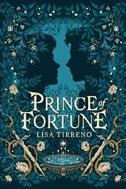
The story of two young men in love who are caught up in war and others’ expectations. Lord Aubrey Ainsley is excited to attend his first event at Talstam Palace. There, he meets heir to the throne Prince Edmund, who’s also 16. The two strike up an amiable conversation before Aubrey saves the prince’s life during an attack by political protestors. Edmund finds himself reluctant to leave the young man’s side during his recuperation. Soon, their friendship blossoms into a deep attraction. But Edmund is a rare Prince of Fortune, someone who’s able to magically influence the weather and plants (the rest of the royals control other elements), and he’s slated to lead the country to greatness. He feels burdened by pressures that prevent him from leading a happy life of his own choosing. In alternating third-person narratives, Tirreno’s debut gives romance fans the chance to revel in the love of a happy couple, while adventure-seekers will particularly enjoy the second half of the story, after Aubrey joins the army. Aubrey has prophetic dreams, and some citizens are Seers, people whose “visions always come to pass”—a worldbuilding element that
weakens some of the suspense; the intriguingly imagined antagonists also remain largely offscreen. In this fantasy realm of racial, gender, and sexual equality, Aubrey is pale, and Edmund, who has “rich olive” skin, is biracial. An entertaining blend of romance and action. (Fantasy. 14-18)
Varga, Emily | Wednesday Books (400 pp.) $20.00 | Oct. 29, 2024 | 9781250877383

A young woman framed for murder seeks vengeance with the help of a new friend and some dangerous magic. For almost a year, Dania has been in prison, framed for a murder she didn’t commit. With plenty of time to think, she’s become consumed with rage, plotting her escape and her revenge on those who put her there. At the top of her list is Mazin, her childhood best friend and first love, who betrayed her out of his loyalty to Emperor Vahid. Dania manages to flee with cellmate Noor, who’s also seeking retribution against the emperor. Since Noor has access to zoraat seeds, the powerful djinn magic that Vahid used to overthrow Dania’s kingdom, the girls devise a plan to use it to obtain justice. After consuming zoraat powder to change her appearance, Dania executes an elaborate scheme to hurt her betrayers as they hurt her, slowly chipping away at their power. But the djinn magic threatens to overtake her, and she can’t forget her feelings for Mazin. Dania must be careful not to succumb to her own trap. Varga’s debut, a Pakistani-inspired retelling of The Count of Monte Cristo, is a compelling story with a strong, sword-wielding female lead, intense fight scenes, unpredictable magic, and fiery romance. Chapters labeled “Before” offer insight into Dania’s relationships with Mazin and other characters.
Pakistani cultural elements are woven into the worldbuilding. A vividly realized, page-turning revenge story. (Fantasy. 13-18)
Visaggio, Magdalene | Illus. by Paulina Ganucheau | Colors by Avery Bacon
Harper/HarperCollins (224 pp.)
$26.99 | Oct. 15, 2024 | 9780063060661
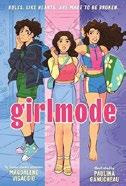
New girl Phoebe Zito finds herself torn between cliques, boys, and different ways to be a girl. Phoebe, a transgender 16-year-old, has just moved to California from the East Coast. She initially befriends nerdy outcast Ben Wheelock, but soon queen bee Mackenzie Ishikawa notices Phoebe and takes her on as a friend—and a project, partly out of her (subconsciously transphobic) desire to teach her how to be a girl. (Fans of the 1995 version of Clueless will instantly recognize the inspiration—starting with the book’s cover.) In addition to a makeover, Mackenzie offers an introduction to feminism that provides information that many readers need to hear. Phoebe starts dating, but heartthrob Ethan Rackley is a stickler for gender roles, while nice guy Ben seems a little too into her transness. Meanwhile, Mackenzie is cast as Audrey in Little Shop of Horrors and comes to relate to the character’s struggle to survive. Despite some ups and downs, Mackenzie and Phoebe slowly learn how to be real friends to each other, come of age as young women, and deal with largely the same hurdles through the lenses of their cis and trans identities and experiences. This exploration of young womanhood will ring true to many who currently are or have been teen girls. The cute and colorful art features appealing character designs.
Phoebe and Ben present white, Mackenzie is cued Japanese American, and Ethan reads Black. A positive and insightfully honest exploration of teen girlhood. (Graphic fiction. 13-18)
Wang, Tiffany | Violetear Books/ Bindery (320 pp.) | $16.95 paper Oct. 15, 2024 | 9781959411772
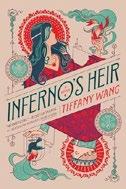
Amid the approaching coronation of her cruel half brother, Jura, and agitation by pro-democracy rebels called the Dawnbreakers, Princess Teia Carthan of Erisia carves out her own fate. Following her parents’ death, Teia learned to fight. In addition to being able to wield fire and water, she’s not above resorting to blackmail, bribery, and murder to ensure her survival. Through master thief Enna, she learns that Jura is after the Dawnbreakers’ symbolic figurehead: Kyra Medoh, a young woman said to be able to control fire, a skill believed to be passed down through the royal lineage. When Teia intercepts Kyra after the thief infiltrates the Golden Palace, the princess tells her she wants to join the Dawnbreakers. Teia plans to gain Kyra’s trust, discover the location of the Dawnbreakers’ base, and use this information as leverage with Jura to get out of the betrothal he’s arranged for her to an abusive murderer. As Teia works undercover, her camaraderie with and attraction to Dawnbreaker Tobias grows, and, moved by Kyra’s idealism, she starts to question her own motivations. Debut author Wang’s tightly written narrative deftly unravels surprising twists and intrigues. While several characters in this duology opener appear too eager to spill their deepest secrets, readers will forgive this weakness and anticipate the second volume. Teia’s mother came from the
country of Shaylan; her skin tone is darker than most Erisians’. Kyra has coppery skin and black hair. A fantastical romp filled with intrigue and suspense. (Fantasy. 13-17)
Woolf, Freja Nicole | Walker US/ Candlewick (320 pp.) | $19.99 Oct. 15, 2024 | 9781536235302
Series: Never Trust a Gemini, 2
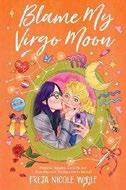
Trying to blend friendships with romantic relationships can be hard.
Newly 15year-old Cat really wants her new girlfriend, Morgan, to get along with her friends, but they’re just not gelling. English Cat is part of the fashion-conscious, makeup-wearing group surrounding her school’s queen bee, Siobhan, while Irish Morgan hangs with an edgier, goth-leaning cohort. To make matters worse, Morgan and Siobhan are both running for head girl. The competition gets fierce, and to avoid favoring one person over the other, Cat auditions for the school play, Romeo and Juliet —and lands the lead! Now she’ll be too busy to help out with any campaigns. Meanwhile, Cat’s best friend, the Polish Zanna, is acting weird—it seems like she doesn’t want to listen to Cat’s many woes. What’s up with that? This sequel to 2023’s Never Trust a Gemini , which traverses the zodiac calendar from the selffocused Aquarius to the grounded Taurus, allows for solid character development while still delivering plenty of farcical rom-com antics. Cat and Morgan’s relationship remains strong, despite various elements attempting to foil them, which is sweet and refreshing. Cat’s narration (and much of the dialogue) is still chock-full of slang as well as her own hilarious coinages (she’s fond of invoking Aphrodite and exclaiming “gooseberries!”), and her chatty style
will draw readers in. Woolf’s sophomore novel firmly establishes her as a young adult author to watch. Über-groovy! (Fiction. 12-15)
Worley, Olivia | Wednesday Books (352 pp.)
$14.00 paper | Oct. 29, 2024 | 9781250881465

The case of a missing New Orleans girl reveals buried secrets.
April Whitman, Vivian Atkins, and Piper Johnson are debutantes in the annual Les Masques ball for high school girls. Chosen as Maids for senior Lily LeBlanc, who’s been crowned Queen, they’re considered to be Mardi Gras royalty. But following Lily’s grand entrance at Les Masques, the lights go out. Suddenly images of Margot Landry, the previous Queen, who was found dead from an overdose the day after last year’s ball, are projected in the ballroom—and, in a scene out of Carrie, one of the masked Jesters throws red paint over Lily before running off. Ominously, Lily never returns home. The Maids—Lily’s best friend, Vivian, her boyfriend’s twin sister, Piper, and her friend April (who also had ties to Margot)—receive texts from Lily asking them to meet her at the Deus Den, a warehouse where Mardi Gras floats are stored. After they arrive, Piper gets a cryptic email from Lily that leads them to find her signature diamond necklace, sparking a police investigation. The atmospheric, well-described New Orleans setting brings much-needed personality to the story, since the main characters are largely unremarkable. The flat characterization, coupled with an unsatisfying resolution, together make the journey feel unfulfilling. The debutante tradition’s racist, classist, and sexist origins are brought up but not fleshed out enough to make an impact. Main characters are cued white. A promising setup let down by lackluster personalities and a disappointing plot. (Thriller. 14-18)
Zhao, Katie | Illus. by Cathy Kwan
Random House (416 pp.) | $19.99
Oct. 1, 2024 | 9780593646410
Series: Descendants of the Zodiac, 1
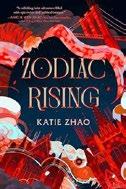
A series opener infused with Chinese folklore and populated by supernatural creatures. As punishment for the first Emperor’s greed, the gods unleashed nightmarish Wrathlings to terrorize the Middle Kingdom, later known as China. The heavenly Jade Emperor eventually relented and provided the kingdom with protection: 12 warriors, each descended from a Chinese zodiac animal. Generations later, during the Second Opium War, the zodiac warriors’ source of power, a fountain called the Circle of Twelve, was dismantled, and the Descendants were cursed, becoming supernatural beings. In present-day Manhattan, the Earthly Branches Academy trains the Descendants and assigns them to protect mortals. When Julius Long, Chancellor of the Descendants’ High Council, dies while attempting to restore the Circle of Twelve, dissatisfaction with the Long family’s leadership begins to stir among the Council, and vampire Evangeline Long is compelled to continue her brother’s mission to prove her worth. To recover the Circle’s stolen pieces, Evangeline forms a specialized team: expert criminal and werewolf Tristan She, fox spirit Nicholas Hu (a master of disguise), Lei, a shaman with valuable knowledge of the Faerie realm, and Alice Jiang, a human who can read minds. This story has many appealing elements—a dangerous heist, a potential second-chance romance, and fantastical beings—but some of the more original elements are overly complex and unconvincing. The book also covers so much worldbuilding that it descends into infodumps and doesn’t fully coalesce. Engaging but overloaded. (illustrated character guide) (Fantasy. 14-18)
MANY CLASSICS OF American mystery fiction take place in New York or California, but those states hardly have a stranglehold on the genre. Texas, for one, is the setting for crime fiction from such disparate and popular authors as Joe R. Lansdale (whose Hap and Leonard novels inspired an AMC TV series), Susan Witting Albert, Bill Crider, Kinky Friedman, and this issue’s cover subject, Attica Locke. Here are a few more recent whodunits set in the state, all recommended by Kirkus Indie: Micheal E. Jimerson’s series entry Draw a Hard Line (2024) continues the story of former Texas Ranger E.J. Kane, who’s now the 50 something head of security for a Texas energy company. He’s had his share of troubles and tragedies: His son, Konner, was killed while deployed in Iraq; afterward, he and his wife, trial lawyer Rebecca Johnson, divorced. Currently, their daughter, Sharla, is pregnant and in treatment for meth addiction; not long ago (in 2022’s White Gold ), E.J. rescued her from
human traffickers. His family’s struggles haven’t kept him down, though; in fact, their tribulations drive him to help the Blakes, whose daughter’s brutal murder remains unsolved. Our reviewer calls the novel “a wellpaced thriller” with sharp dialogue, noting that “the author, a Texas attorney, has the real life experience to back up his storyline, and he gets bonus points for referencing Chuck Norris.”


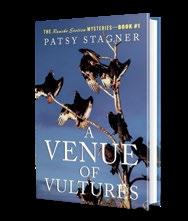

A Venue of Vultures (2024), a series starter by Patsy Stagner, introduces senior sisters Claire Browning and Avery Halverson, two retired legal assistants living in a gated community in East Texas called Rancho Exotica. When they find the corpse of their wealthy and unsavory neighbor, Thorne Mondae, on their property with an arrow in his chest, they become potential suspects in a murder case. It turns out the siblings’ trail camera captured an image of the perpetrator, so they end up investigating the murder with former Dallas cop Jay Vidocq, Ranch Exotica’s head of security. Our reviewer praises this “delightfully cozy detective story,” calling it “an engagingly witty whodunit brimming with inventive twists and turns.”
Adam Taylor Barker delivers a grim and timely tale in All the Bones in Brooks County, Texas (2023), the first installment of his mystery series. Sheriff’s deputy Hondo Velasquez responds to a call from a Texas rancher who’s discovered the bones of five unidentified people, including a child, on his property. The cop finds a number of shell casings nearby, which makes him think that the victims, almost certainly Mexican migrants, were murdered, but his colleagues quickly dismiss the idea: “Spent ammunition all over this county, Deputy,” says the local
justice of the peace. “Especially on ranch land.” Hondo, whose Mexican mother was a migrant, soon enlists the help of Baylor University forensic anthropologist Magnolia Moss, who finds a bullet in one of the victim’s skulls. This discovery sets Hondo on an investigation that leads to terrible revelations— and some very dangerous people. It’s a “gripping, multilayered crime novel,” writes Kirkus’ reviewer, who adds that Barker— co author of the screenplay for the action film Savage Salvation (2022), starring Robert De Niro—“brings rich cinematic dimensions to his fiction debut, making the most of the bleak Texas landscape.”
David Rapp is the senior Indie editor.
In Resau’s SF novel, a teenage girl travels to a tropical island to learn the secrets behind a tech empire and save her dying sister in the process.
The year is 2154, and 16 year old Liv is on a mission to save her younger sister, Shell. Sickened by living in a “contaminated, offlimits zone by the Chesapeake Bay,” Shell is preserved in a state of suspended animation in which she’s “technically dead with the potential for revival.” But in only two months, her “hibernation” will max out and Shell will die forever. This situation compels Liv to join an internship program on a remote island, ostensibly to learn about the dazzling technological advances of the Virch Empire, the tech
company responsible for making the virtualreality lenses almost everyone wears. In reality, however, Liv intends to find a cure for her sister. She finds unexpected help when she meets Wolf, the rogue son of the Virch Empire’s founder. Disillusioned with his father’s work and at odds with his corrupted brother, Spiro, Wolf teams up with Liv as they stumble upon plans for Project Dragon—a horrific bioweapon that could help Wolf’s father gain the immortality he so desperately seeks. With Liv’s visionary lucid dreams guiding the way, she and Wolf struggle to find answers as they become increasingly unsure of what is reality and what is illusion. Resau has created a hero who is smart, determined,

and vulnerable—a dynamic combination that is sure to keep readers hooked. While there are some lighthearted moments (hightech gadgets like the virtualreality “virchlenses” exist alongside oldfashioned hand sanitizers), the majority of the novel is a tense savetheworld journey leavened by a budding romance. Quick
pacing and naturalistic dialogue, along with a series of authentic twists and turns, make for an actionpacked yet frequently philosophical look at what makes us human.
An expert blend of SF yarn, thriller, and romance that results in a compulsively readable and imaginative novel.
Anhalt, Jackson | Rainbow Quartz Publishing (304 pp.) | $19.99 paper May 29, 2023 | 9798218211912

Anhalt’s memoir provides an insider’s account of life in a 911 dispatch center. Public safety workers including paramedics, firefighters, and police officers have captured the popular imagination across all manner of media. By contrast, 911 dispatchers have remained somewhat faceless, surfacing mostly as disembodied voices in audio recordings. Author Anhalt lifts that veil in his entertaining insider’s account of a vital profession that, in the U.S., handles hundreds of thousands of calls a day, many of them lifeordeath emergencies. “Every call has the potential to be something huge,” he notes: “The possibility to save a life or the potential to lose one.” Thousands of primary “Public Safety Answering Points” (PSAPs) in the U.S. handle emergency calls directly. Anhalt focuses on one of them, detailing shifts that he worked there from 2011 to 2021. The callers he describes range from the suicidal to disgruntled restaurant customers: “911 dispatchers have become a complaint line for a nation’s worth of issues because, above anything else, we always answer the phone,” the author laments. Amid the mayhem—“We get to see the most horrific side of humanity several hundred times a day. We talk to people in their darkest hours, repeatedly. Sometimes, we are the last voice a person hears in their life”—dispatchers experience a daily diet of the bizarre; Anhalt delivers the anecdotes in a deadpan voice that mimics the cadence of a 911 transmission. After a man tries to flag truckers down with a sex toy, the sheriff’s deputy “advised the subject to find a more conventional means of attracting a mate”; a man reported to be clowning in a parking lot turns out to be, literally, “a drunk clown molesting people in an Arby’s parking lot”; a
house “crawling with drunken teenagers” would later be described as “a clip from The Walking Dead.” Anhalt perfectly captures the humanity, personality, and gallows humor of his coworkers, including a supervisor who “isn’t called Mike The Dick for nothing.” As we learn, the stress of the job can be overwhelming and the wages “average” but, says Anhalt, “I love my job. I can’t imagine doing anything different. Every day is something new.” Engagingly captures the anything- goes nature of emergency services work.
Bacon, Susan | Porter Street Press (354 pp.) | $14.95 paper Aug. 15, 2024 | 9781733082761

In Bacon’s novel, a 38 year old New Yorker’s friend is murdered, and she soon discovers the many secrets she was keeping. It’s 1987: Andy Warhol has recently died, the Iran Contra Affair is on the news, and artist Seal Larson lies dead on Manhattan concrete. Emma Quinn, a history professor at Columbia University, had found a lot of common ground with Seal, her 30 something neighbor. Like Emma, the visual artist lived alone, and she shared Emma’s passion for art, music, and nightlife. The academic had thought that they were great friends and trusted each other, but upon Seal’s sudden, violent death, she learns her friend’s real name: Lucille Lawson. Emma’s determined to find justice for the friend she thought she knew—even if she must dive into years of secrets. Helping Emma investigate are her friend Bill Kidman, who’s with the CIA, and her boyfriend, Angus McLearan of British intelligence. Emma finds out Seal’s mother, an art collector, wasn’t living in England, nor was she estranged from her daughter; she actually died years ago from cancer and was originally from Tennessee.
Seal—or rather, Lucille—has just one living relative, her Aunt Jenny. As Emma digs into Seal’s connection to Warhol, and her unexpected financial situation, she comes closer to finding a solution to the mystery. Bacon expertly interweaves details of the time period into the characters’ backstories, with Seal effectively narrating the story of her life in some chapters: “I wonder. Will anyone even care that I’m gone?” Emma’s chapters, told from the thirdperson perspective, feel as if one is observing a real person, and they effectively show her trying to find her friend’s killer while also dealing with the political atmosphere in which her friends live. The mystery is compelling and takes unexpected turns, and it’s supported by a steady pace and unique characters. Bacon also provides a satisfying ending—not only to the mystery, but also to a subplot involving Emma’s personal life.
An intriguing whodunit with memorable characters.
Borcyckowski, Robert | Self (357 pp.) $24.95 | $15.95 paper | Jan. 15, 2024 9781962624978 | 9781962624961 paper

Residents of a homeless camp fight to head off eviction and shore up their fragile community in Borcyckowski’s luminous novel.
Phibius Emerson is a Black student who was recently expelled from college after he tried to burn his dormroom furniture—now, he lives in a Sacramento homeless encampment. When he’s on his bipolar meds, he’s a smart, upstanding kid trying to bring some stability and aid to the camp by getting his friends legal assistance and drafting rules on trash and noise. His fellow campers include Lucy, a recently unemployed woman living in her car;
supports a thoughtful and (mostly) thrilling plot.
William, a man on disability who edges toward a romance with Lucy; Mr. Maxstead, an uncannily nondescript man obsessed with military aircraft; Paul, a 60 something saxophonist who functions well on heroin; Mike and Linda, a couple who barely function at all on meth; Thomas, a Marine vet with PTSD; and Joseph Little Bear, an Indigenous orphan and itinerant street preacher. The campers survive on meager benefit payments, leftovers scrounged from restaurants, and panhandling. Sometimes, they don’t get by: Phibius has a breakdown and gets sent to the psych ward, Linda overdoses, and Mike gets arrested for possession. These disturbances attract the ire of local homeowners who claim the camp poses a danger to a nearby preschool. When the city tries to bulldoze the camp, Phibius fights back with the help of idealistic law student Lin Yang. Meanwhile, campers start drifting away: William and Lucy head north to Mendocino to pursue the dream of starting a marijuana farm, while Joseph wanders down to Bakersfield, walking the highways and hitching rides.
The author takes a deep dive into the lives of his characters, exploring everything from their legal status (Phibius bones up on the niceties of Martin v. City of Boise, a federal court decision that bans cities from evicting the homeless from camps if they are not provided indoor shelter) to their everyday challenges. The meandering narrative unfolds as a set of character studies; some get back on their feet after a bout of bad luck, others stay mired in addiction and mental illnesses, many feel a wariness about forging relationships with other people who may be either judgmental or damaged, and all glean simple pleasures from threadbare circumstances, like an unexpectedly
delicious soupkitchen dinner. Borcyckowski’s subtle, evocative prose delves into his characters’ psychological travails and skillfully orchestrates the tangible details of the camp and its denizens with a blighted lyricism. (“It seemed she was suffering, and her body jolted slightly against Mike’s shoulder as the spasms of tears swept through her; repeatedly, like an insistent wind that blows against you. It blows the papers away and the food wrappers around you away and the note you made about tomorrow; where you were going tomorrow, all of them gone. Forever.”) The result is a vivid and captivating yarn that reveals the offbeat humanity of this most marginalized group.
A rich, moving saga of people living on the edge, full of plangent defeats and unsung victories.
Brys, Tim | Illus. by Ann Huey Great Texas Line (48 pp.) | $18.95 July 19, 2024 | 9781892588753

In Brys’ debut picture book, a fouryear old boy discovers a new type of dinosaur while fossil hunting with his dad. “A little boy, his name is Wylie. / He’s seldom sad AND often smiley.” Wylie is a young boy with pale skin and brown hair whose father’s hobby is digging for fossils and other buried treasure. Wylie goes out with his dad one day. While the father methodically investigates a hill, Wylie wanders ahead and comes across a bone. Analysis by professors from Southern Methodist University reveals the bone to be from a hitherto unknown type of dinosaur—a
Nodosaur. Wylie makes the news and is featured in a presentation at the zoo. Brys tells Wylie’s story in rhymed verse across 21 doublespread pages. The use of iambic meter lends the proceedings a childfriendly singsong quality but also a meandering vagueness as redundant phrases are used to conclude the rhymes. (For example: “They wrap in tissue, cloth and plaster, / Bill joins in and is a master.”) Huey’s illustrations are suitably dirty and chaotic, capturing the enthusiasm and investigative spirit that is in evidence throughout. The text, equally wild, could prove a bit too drably colored for younger readers. The absence of any living dinosaurs may disappoint those drawn in by the title; nevertheless, there is much here to stimulate inquisitive young minds. A bright-eyed paleontological tale diminished somewhat by its forced adherence to a rhyme scheme.
Cagin, Seth | Self (312 pp.) | $24.99
$18.99 paper | April 11, 2024
9798990109551 | 9798990109568 paper
Series: The Tom Austin Mysteries, 1
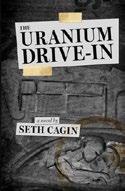
A newspaper publisher with a secret past tries to solve a local missing person case in Cagin’s novel. Tom Austin was once known as Ken Hanley. Ken lived in Boston and worked as an upandcoming journalist with the world at his fingertips. Then Ken blew up his life and moved to Naturita, Colorado, a town known for its past mining of uranium. Now Ken goes by the name Tom and is the owner and editor of the West End Forum . When local mechanic Ray Walker vanishes right before his daughter’s wedding, Tom looks into the case—for the sake of his newspaper and to sate his own curiosity. During his investigation, Tom learns that Ray is actually the illegitimate son of Dick Klein, “the richest man in the entire Four Corners,”
whose fortune comes from uranium mining. Later, Sarah Walker—Ray’s wife—informs Tom that Ray may have run away with Anya, a woman who escaped from her abusive and methaddicted husband. While leads abound for Tom—from Ray’s garage doubling as a meth lab to his possible affair—he is still no closer to solving Ray’s disappearance. Cagin combines the mining history of the region with detailed descriptions of the landscape, bringing the reader directly into an environment in which the natural world is beautiful and what is manmade feels desolate (“the long views of distant blue peaks and rocky redhued canyons spiked with juniper and pinion…where abandoned cars sat rusting away on some ledge or precipice where they had landed after their driver had crashed them”). While the prose is strong, the story has some minor issues—Tom’s intense commitment to Sarah and his involvement with her family feel a bit hurried. Additionally, religious polygamy is introduced almost out of nowhere late in the story, though it proves to be a major plot point. Still, this remains a highly captivating and evocative tale.
Magnificent scene-setting supports a thoughtful and (mostly) thrilling plot.
Cochran, Rick | Self (276 pp.) | $14.95 paper | June 15, 2021 | 9798744220389 Series: Cape Cod Mystery, 3

The law and the mob clash in 1950s Cape Cod. As the third volume in Cochran’s series opens, his hero, retired “Cape Cod basketball legend” and special police consultant Rob Caldwell, is dealing with several virtually simultaneous emotional revelations: Rachel, the woman he loves who had long been married to his best friend, has agreed
to marry him, and his grandfather, the most influential person in Bound Brook (on Cape Cod), has been murdered and has left a private note for Rob, apologizing for a lifetime of neglect and injustice. The Mafia is making inroads into Bound Brook, which not only involves Rob’s grandfather, but also recurring series character Rocco Marini, a former Mafia enforcer who’s been sent to find the daughter of a Mob connected man in France (not knowing that this woman and her children are deeply connected to some of the people he’ll meet when he brings them to Bound Brook). “The Mafia didn’t like witnesses and tended to take a scorched earth approach to their problems,” Rocco reflects about his erstwhile employers. The situation is further complicated by the presence of State Trooper Mike O’Connor, who is hopelessly in debt to the local Mafia boss. This is the third entry in the Bound Brook Cape Cod series, which follows the personal and romantic complications of Rob and Rachel in a fictionalized Cape Cod. Cochran assures his readers that each book in the series can be read independently, and he’s right; the author unobtrusively fills new readers in on all the context they need in order to understand the many personal issues at stake in this volume, from the somber undertones of Rob’s relationship drama to the inner personal transformation of Rachel’s former husband, who hopes he can be a better friend than he ever was a husband. Cochran evocatively captures the feeling of a bygone Cape Cod at season’s end, and he fills his story with characters readers will want to cheer—particularly Rocco, who steals the novel. A fast-paced and satisfying tale of the Mafia and murder on old Cape Cod.
Cole, William E. | Authority Publishing (348 pp.) $39.99 | $29.99 paper | April 28, 2023 9798886360196 | 9798886360202 paper
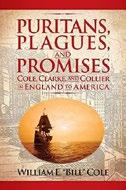
Religious persecution, deadly infections, and the lure of a new life drove the Pilgrims to Plymouth, according to this sprawling genealogical history. Cole investigates the lives of his English forebears in the Cole, Clarke, and Collier families during the late 16th and early 17th centuries, and the forces that propelled them to Massachusetts. He starts with his ancestor Thomas Cole, a farmer in a village in Northamptonshire, England, who was excommunicated from the Church of England for his Puritan convictions. The book’s first section follows the struggle between the two Christian groups, fought with bureaucratic crackdowns, vitriolic pamphlets—one Puritan polemicist called church bishops “vile servile dunghill ministers of damnation”—and the prosecution of vicar William Proudlove and eight other Puritans for sedition in the 1590s. The book’s focus then shifts to the Collier and Clarke families, whose bustling lives as London tradespeople were threatened by plague outbreaks. Cole’s narrative later details the contentious relationship between the Mayflower ’s Pilgrim colonists and London’s Merchant Adventurers company—a group of private investors, including grocer William Collier, who financed the Plymouth colony in the
A captivating exploration of the fervent dreams and harsh realities of the colonial era.
PURITANS, PLAGUES, AND PROMISES
expectation that fur trapping would repay the debt. The venture seemed doomed, as half the colonists died the first winter in 1620 and ’21, and French seamen and Barbary pirates stole shipments of beaver pelts. However, the Adventurers kept shipping over supplies and colonists, including Collier and his family and apprentice Job Cole. Overall, this book is very much a genealogist’s work, pegged to birth and death records, wills, and lengthy accounts of legal proceedings. However, Cole effectively fleshes it out with lucid, colorful evocations of Elizabethan life, from period prayers to a scene at the famous Globe Theatre, as well as with dramatic imagined dialogue and ruminations: “Jane [Collier, William’s wife] was gripped by conflicting emotions and started to cry. ‘William, our boy is inquisitive, smart, strongminded, independent, and strong for his age. But he’s not yet fully grown—he’s only sixteen!’” The result is a captivating exploration of the fervent dreams and harsh realities of the colonial era. A rich panorama of deeply faithful and daring English colonists.
Cooper, Christine | Oak Leaf Publishing (186 pp.) | $14.99 paper May 19, 2024 | 9798989841707
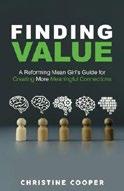
Pharmacist
Cooper offers a guide for fostering connections and living a more personally fulfilling life.
The author, a selfproclaimed “reforming mean girl,” shares her journey from a period of social disconnection to her discovery of how to find and build value in relationships. The book covers a broad range of topics, including establishing healthy boundaries, fighting fairly during verbal disagreements, resisting gossip, and embracing kindness and respect. Each
chapter provides insightful strategies and reflections on how readers may improve their interactions with others. The discussion on the damage of gossip is particularly poignant; reflecting on her past, she admits, “We judged people’s outfits and attitudes—yet we were the ones who needed help.” This honest selfreflection sets the tone for a book that’s as much about personal redemption as it is about building stronger personal ties. Another powerful message is the importance of recognizing and valuing the uniqueness of others: “When you stop to identify what makes a person unique, you are stopping to identify part of what makes them valuable.” This perspective shift is a cornerstone of the book’s philosophy, as it promotes empathy and deeper understanding. Overall, this is a compelling and practical guide for anyone looking to enhance their social lives and general wellbeing. Its blend of personal narrative, actionable advice, and philosophical insight makes for an enjoyable book, and perhaps its most inspiring message is that small, positive changes in one’s behavior can have a significant and cumulative impact: “When you focus on improving your small part of the world, you make the greatest impact in your life.” Readers may find this emphasis on personal responsibility and incremental change to be motivating and empowering.
A book of practical and valuable advice, whether one is looking to mend old relationships, forge new connections, or simply be a kinder person.
DaVeiga, Cheryl | Illus. by Luis Peres Waterhole Productions (43 pp.)
$13.99 paper | June 11, 2024 | 9781958050125

Noah Gouda craves a victory in a lunar carracing competition in DaVeiga’s picture book. Noah lives on a moon made of cheese and dreams of driving in its biggest race: the Great Amoonican
Grand Brie. A year out from the big event, Noah and best friend Bleu build their racer, the Muenster Monster. They’re thrilled by their creation until they realize that Noah is too short to reach the pedals. By the time the Grand Brie rolls around, Noah has grown enough to drive the car, so he and Bleu enter the race at the last second. They’re up against a number of formidable opponents like Mac N. Cheese, Gorgonzilla, Hank the Hunk, and Betty Cheddar. The Monster’s competition slowly falls away until it’s just Noah and Bleu against Betty in the final turns of the track. This fresh installment in the Biff Bam Booza series is chockfull of cheesebased wordplay, from Noah Gouda’s name to “It could happen, you know? Once in a Bleu moon!” Peres’ illustrations pull inspiration from the bold lines, panels, and dialogue bubbles of comics illustrations to enhance the excitement. Although Noah’s problems solve themselves at two key moments rather too miraculously, that still doesn’t spoil what is ultimately a fun read. A solid picture book for families looking for a new spin on car-racing stories.
Kirkus Star
Sam Lacy and Wendell Smith: The Dynamic Duo That Desegregated American Sports (Routledge Historical Americans)
Dawkins, Wayne | Routledge (198 pp.)
$180.00 | $49.99 paper | July 17, 2024 9781032255668 | 9781032233864 paper
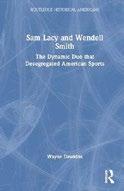
Dawkins presents a dual biography of two desegregation heroes. In this new entry in Routledge’s Historical Americans series, the author tells the life stories of Sam Lacy and Wendell Smith, from their childhoods and early years through their careers as baseball journalists for Blackowned ventures (Lacy for
Baltimore’s Afro-American and Smith for the Pittsburgh Courier) to the very different ends of their lives. Smith only lived until his 50s and died in 1972 (Chicago mayor Richard Daley paid his respects: “We have lost a great citizen, who was interested in the city and most of all the city’s children”), whereas Lacy lived into his 90s and eventually moved to writing for the whitemajorityowned Chicago American. As Dawkins notes, however, they shared the same journalistic mission: “To reason, ridicule, and report to owners and the commissioner that Black ballplayers deserved to compete on Major League Baseball teams.” The author fleshes out the tense racial politics of the 1930s and ’40s in densely documented pages (the book has extensive notes and a bibliography) and fills his narrative with many notable personalities of the period, from Kenesaw Mountain Landis, the adamantly prosegregation baseball commissioner, to his successor, former United States senator A.B. Chandler, who ended the unofficial ban on Blacks playing professional ball. And, of course, the narrative returns frequently to the iconic figure of Jackie Robinson, who was often caught up in the intricacies of standing against the institutional racism of the sport he loved. Robinson is by far the book’s most threedimensional character, but Dawkins also excels at bringing his two main subjects to life, skillfully distilling the bite and acerbity of their writings and capturing their voices (when a manager said of a former Negro League pitcher, “Johnny’s not ready yet,” Lacy responded, “Certainly he can’t get ready riding the bench”). Much like its subjects, the book strikes a fine balance between baseball and civil rights. A biographical look at a pivotal period in the racial history of baseball.

Downey, Lianne | Jolibro Publishing (390 pp.) | $17.99 paper | July 6, 2024
9781953474087 | Series: Psychics & Aliens, 1

This mindbending SF novel combines mysticism with thrills.
provided by the golden artifact occasionally grind the tale to a halt. Despite this, there are enough twists, cliffhanger chapter endings, and rich details about the Dutch Reformed community to set this gripping book apart from similar SF novels. An engaging tale with plenty of genre intrigue to satisfy SF fans.
For more Indie content, visit Kirkus online.
In the opening pages, Minda Blake, a psychic known as a “remote viewer” for a black ops government contractor, uses her ability to dig up a mysterious gold artifact in the deeply religious Dutch Reformed part of Michigan. Almost immediately afterward, she passes out, later realizing that a colleague wanted the fragment and tried to kill her. After recovering, she resolves to find the golden object and take it to the media, even if her employer will hunt her down and, in the best case scenario, have her institutionalized. Her quest to recover the artifact leads her to smalltown chef Garritt Vanderhoeven, who has his own special abilities following a plane crash and miraculous recovery in the rainforest of Peru. Since the accident, he has seen “flashing, twinkling, golden sparks,” which guide his way, including circling around Minda like “fireflies all around her dark wavy hair” when they meet. Their paths further intersect when Juan Talamantes, a worker at Garritt’s restaurant, is arrested by people claiming to be cops who believe he knows a man who discovered a piece from a UFO. These different narratives collide as Downey offers revelations about the golden artifact and the true history of Earth’s people. The plot intensifies as more is disclosed about Garritt’s family and his break with his religious upbringing. In the middle third of the novel, some of the plot momentum stalls when the tale starts following the interior lives of the expanding cast of characters. The backstory of the black ops government contractor and extended sequences in which Minda learns about the heightened powers
Fernandez, Alexander Self (233 pp.) | $6.99 paper
June 24, 2024 | 9798321144381
Series: The Blood and Hexes Trilogy, 1

The first installment of Fernandez’s Blood and Hexes trilogy weaves a tale of witchcraft, vengeance, and supernatural conflict across centuries. The story opens in Plymouth, England, in 1689, with 15yearold Sybil Cotterill and her mother, Olivia, fleeing for their lives. The Cotterill family are no strangers to persecution, due to their practice of witchcraft. Olivia prepares Sybil for a life of secrecy and gifts her a magical silver pentacle, but they’re ultimately unable to avoid the witchhunters pursuing them. Once caught, Sybil and her neighbor, Constance, are sentenced to death; however, Sybil’s magical abilities keep her alive while entombed for 300 years. She awakens in modernday Salem, Massachusetts, struggling to understand the new world around her. She’s driven by a desire for vengeance against those who victimized her and her family, and soon finds herself entangled with Marcelo Abana Flores, a Spanish conquistadorturnedvampire, and Cauac, an Incan spellcrafter. Marcelo was transformed into a vampire after an encounter with an Incan demon, and he still struggles with his new identity and his powers, as well as guilt and a desire for redemption. Cauac’s failed attempt to summon a demon in 1532 led to the destruction of his people and connected
BECOMING HUNGARIAN
him to Marcelo and to a broader conflict involving supernatural forces. The narrative converges in Machu Picchu, where Cauac is working to amass a demon army. Overall, Fernandez successfully conjures multidimensional characters, as when he shows Sybil’s evolution from a witch on the run to a powerful and vengeful figure. Marcelo’s conflict with his vampire nature and his quest for redemption effectively add another layer of emotional complexity. Additionally, the author’s writing style is engaging and descriptive as it captures the romantic tension between Sybil and Marcelo: “He lost himself in her eyes that had seen so much life and tragedy. She seemed on the verge of tears, and he only desired to bring her joy and respite.” However, the book’s brevity may leave some readers unsatisfied. A blend of the paranormal and the romantic that ably sets the stage for the next series entry.
Ferrone, Jo | Life to Paper Publishing (231 pp.) | $20.24 paper Nov. 17, 2021 | 9781777373689
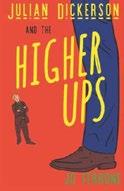
In Ferrone’s comic novel, a shortstatured teacher attempts to reinvent his life following his divorce. Fivefoottwo Julian Leon Rainflower Dickerson was born two months prematurely on a commune (in a hot tub), which explains, in part, his small
proportions. By the time he was a teenager, the straitlaced Julian was fed up enough with his hippie parents to go live with his grandparents. He now works as an English teacher at a New England prep school and finds himself unhappily married to a woman who cruelly insists on wearing high heels. His only friends are his large black Lab, Barcus, and his lesbian colleague, Lois Coronetti Carson, who teaches gym. His balanced life becomes upset by the dual intrusions of his wife, Amanda, who demands a divorce, and his most flirtatious student, the precocious Donna Capucci, who seeks his attention outside of class. When a bus crash during a field trip lands Julian in the hospital, co chaperone Lois comes up with a plan to sue the prep school and walk away with a large settlement. (The two also move into their favorite bar after losing their jobs.) Will this finally be Julian’s opportunity to get out from under the “higher ups” who have long dominated his life, or is he about to fly too close to the sun? Ferrone’s humor is dark and dry, as here, when Julian agrees to meet with a lawyer about suing the school (largely to counterbalance his divorce woes): “Their appointment happened to fall on the same day that he received a call from his divorce attorney informing him that Amanda had sold the house to her mother for ten dollars and had expressed a willingness to split the proceeds with Julian despite the fact that she was under no legal obligation to do so.”
Despite the book’s surface cynicism, the colorful assortment of allies Julian draws to him provides the comic story with an earnest heart.
A humorous ode to the value of community in fending off the world’s cruelties.
Giles, Erika Reich | Montiron Press (288 pp.) | $16.99 paper
June 4, 2024 | 9798218336974
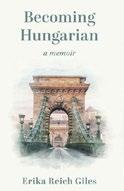
Giles reconstructs her family’s perilous escape from Communistcontrolled Hungary and recounts her attempt to reconcile her American upbringing with her Hungarian ancestry in this memoir.
The author’s parents, Sándor and Vilmy Reich, enjoyed a happy and prosperous life in Szombathely, a Hungarian town only 10 miles from the Austrian border. Sándor worked for his father, the founder and owner of a thriving factory, where Vilmy worked as well as a payroll clerk. However, in 1948, all that changed when Sovietbacked Communists took over the factory, eventually leaving both Sándor and his father jobless. Only a month later, the author was born into this familial crisis, which dramatically concluded with a dangerous escape to Austria, one thrillingly described by Giles. They ultimately made their way to Billings, Montana, enticed by the draw of “enclaves of Hungarian refugees,” and attempted to begin their lives anew, though they were now much more financially constrained. Giles had no personal remembrance of her homeland, and no sentiment of national pride; she did her best to be American, impressed by how “carefree” her countrymen seemed in comparison to her own family, who were emotionally freighted with worry and trauma. Their alienation was only heightened by the profound challenges they faced: Giles’ mentally challenged younger brother, Robie, was sent to reside in a state institution. Additionally, the author and her family witnessed a murder, but they were too afraid to alert the authorities (an expression of immigrant insecurity, per Giles). The author eventually
became deeply interested in her roots and began to pepper her parents with questions about their past—her curiosity culminated in her own trip to Hungary with her husband, Leon. Giles poignantly depicts her experiences there and the elusive sense of identity the visit finally restored. (“For the first time in my life, I am whole.”)
Giles’ account is now a familiar one—there are so many memoirs like it by nationally dispossessed children like herself—so readers should not expect great originality here. Nonetheless, this is a profoundly affecting story, written in thoughtfully lucid prose. The author endeavored to bury her ancestral origins—her experience in college made her feel “unshackled” from both her past and her heritage. (“I navigated between my Hungarian and American worlds, trying to keep them separate, never feeling fully part of either one.”) As she grew older, though, she became increasingly dissatisfied with a gnawing “sense of rootlessness,” an incompleteness exacerbated by the tangle of family secrets that were only ever begrudgingly clarified. What emerges in Giles’ account is not only a vivid portrayal of Hungarian culture and the pressure it endured under tyranny, but also the peculiarity of American culture, famously hospitable to exiled foreigners, but also, paradoxically, insistent on an emotionally costly assimilation. Especially during a time when immigration has become such a contentious political issue, this is an edifying remembrance, one that tenderly and intimately reminds the reader of the human stakes.
A stirring account of the author’s search for identity amid dislocation.
Harper, Josh | Propinquity Produces Books (282 pp.) | $11.99 paper
July 30, 2024 | 9798328920759
Series: A Paul Whatshisname Mystery, 1

In Harper’s mystery series starter, a Brooklynite investigates the murders of his wife and her suspected lover. In the summer of 2022, Paul is a 40 something journeyman actor with dwindling prospects. Alina, an aspiring novelist in her 30s, works the front desk of his luxury highrise in the Greenpoint neighborhood of Brooklyn. He suspects that his estranged wife, Laura, is having an affair; meanwhile, Alina’s inertia keeps her in a deadend job, but deep down, she wants to be fired. Paul may have the key to making this firing happen: Specifically, he suggests using Alina’s master key to enter the apartment of Ernest Whitaker, whom he suspects of being his wife’s lover. She eagerly complies, but when they enter the dwelling, they don’t find a couple in flagrante delicto, but rather Ernest’s strangled corpse. Things go from bad to worse when Paul finds his wife in their own apartment, also strangled—and Paul is the prime suspect in both killings. That’s the setup for a wryly told mystery in which tenants hide some downanddirty doings. This is welltrod territory, of course, but Paul’s firstperson narration adds a metafictional spin that keeps readers on alert, as when he’s just about to find his wife’s body: “Reader, I’m feeling guilty because I should have prepared you better for what’s about to happen.” The audience’s
A diverting whodunit with an unconventional sleuth who tends to go off-script.
mileage will vary on this narrative device, especially when Paul worries that they may be ahead of him: “Maybe you’ve been shaking your head impatiently as I doddered around, even screaming to your spouse, ‘Jesus, it’s so obvious!’” But Harper does a deft job of producing red herrings that will misdirect even the savviest of armchair sleuths. The conclusion may require some suspension of disbelief, but it intriguingly sets up a sequel.
A diverting whodunit with an unconventional sleuth who tends to go off-script.
Heberden, Marc | Camerado Press (344 pp.) | $18.21 paper Jan. 13, 2014 | 9780615937878
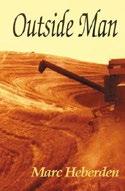
A drifter sets out on a winding journey of selfdiscovery in Heberden’s novel. After leaving home early on (there are vague hints of childhood abuse), Sam Lawrence has been on the move in his car, stopping to earn just enough money to get to the next little town, the next highway offramp. The story opens in the farm town of Gainesville in the Palouse country west of Spokane, Washington, where Sam has stopped to get gas and something to eat. But he decides, for reasons unclear to himself (as most of his decisions are), to stay for a while. Then a guy in a bar gets him some work on the Petersen farm. He’s a fast learner and a good worker. Soon the old man, Harley Petersen, takes notice, and suddenly Sam is inching toward a real job and slowly falling in love with a woman named Ruth Kirby. Will this be the end of Sam’s roving? Or will he eventually take to the road once again, continuing his journey of selfexploration? Heberden is a pro, and it shows. He is also an elegant stylist, and Papa Hemingway would be proud to own sentences like this: “The line on his reel was still clear and bluish on the spool and he knew it was strong and supple and he began
threading it out through the guides.”
His descriptions almost always do justice to the natural world and the Palouse countryside that he celebrates. The book includes a scary account of the big wheat harvest (Sam is driving a combine) when the stubble catches fire—this is Heberden at his best. The author has an impressive knack for capturing the flavor of everyday chitchat in a small town. On the downside, however, he occasionally withholds too much detail when drawing his characters, such as Dan Petersen, the flaky younger son. But this tendency toward subtlety often hits just the right balance of physical description and psychological insight.
An absorbingly introspective study of human nature set against an inspiringly idyllic backdrop.
Jacomet, Josef | The Thinking Press (384 pp.)
$17.99 | $9.99 paper | May 27, 2024 9798990699427 | 9798990699410 paper

In Jacomet’s YA SF series opener, an adolescent girl living on the streets stumbles into a team of police investigators from another dimension on the trail of a conspiracy.
In Columbus, Ohio, unhoused orphan Kes Gatner fell through the cracks of social services after her foster family gave her up and moved away. Now she lives rough and resourcefully on the streets. When Kes tries to pick the pocket of Jack Boundang, a tall, strange man, he turns out to be a detective—and not just any detective, but one who works for the police force of Jheer, a smallish world in another dimension (not a parallel universe, Jack emphasizes). Superior Jheer technology has long made clandestine teleports back and forth between Jheer and Earth a possibility. Interactions between humans and Jheer folk (who include a race of singlesex reptilian humanoids called thimps) are in a
legal gray area—the Jheer are not always good about obeying rules. Twentyseven years ago, a ruinous classtinged civil war on Jheer concluded with the rebels defeated. Now an upstart gang, the Nekov Syndicate, has dispatched its operatives, led by disaffected dimensional scientist Edward Thoxx, to Columbus, where they systematically case houses constructed 27 years earlier by a Jheer front company. What can they be seeking? And in which world does the homeless Kes rightfully belong? Twists and turns are minimal in this caper, which emphasizes characterization over story gimmicks (even putative villain Thoxx begs for compassionate understanding) and establishes ground rules and characters for presumed future installments. One compelling but undercooked idea is the conceit that Jheer people innately have varied superpowers—but in “about one in ten million” instances, an unlucky “insipid” is born mundane, with no paranormal talents. Glib, fastthinking Jack is such an unfortunate, but he refuses to let that hinder him. Jheer (thimps notwithstanding) does not seem particularly exotic; it’s the notion of Columbus, Ohio, as a nexus of SF weirdness that’s the novelty. Jacomet writes in a solid, non condescending YA voice and, at least here, eschews any contrived romantic angle. A plucky orphan, dimensional gates, and snake-people cops mix in this surprisingly straightforward story.
James, Seth W. | Self (340 pp.) | $22.99 $14.99 paper | June 1, 2024
9798322482734 | 9798322482574 paper
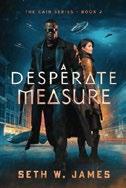
In James’ sequel to Ethos of Cain (2023), set in the future, a former mercenary and a strongwilled diplomat work to protect coastal Europeans while also keeping each other safe from harm.
Cainhas been engineering offthebooks heists his whole life, but he’s lately settled into a new, more reputable occupation in Brussels. He’s the chief of security for Francesca Pieralisi, the former mayor of Venice who’s now the director of implementation for the European Seawall Foundation; she and Cain also happen to be lovers. His new job allows them the luxury of living together for the first time, and it also gives him access to the full gamut of European intelligence technology. Among them is Serval, artificialintelligence surveillance that should be able to recognize someone who’s been stalking Francesca lately; however, for some reason, the tech can’t even detect the interloper’s presence. Meanwhile, Francesca feels the limits of diplomacy as Black Horizon—a commercial entity that’s been legally recognized as a sovereign state—and other companies attempt to seize votes in the ESF to control the factories that will construct the seawalls. All eyes are on Francesca as she attempts to navigate growing threats to the ESF’s best interests, as well as to her political reputation and safety. In this series installment, James’ already expansive world grows, juxtaposing the backdrop of reallife Brussels (and its Berlaymont building) with new, fictional locations, including lush resorts in outer space and abandoned shipyards on Earth. New technology, such as Serval and weaponheavy NMX23 exoskeleton suits, heighten the tension of the ESF politics and add interest to the thrilling action sequences: “Four men in NMX23 assault exoskeletons jumped down, shattering the flagstones beneath them, before the less armored team members fastroped down.” Despite some drawn out platitudes about abuses of economic and political power, Cain and Francesca’s dialogue crackles with chemistry, whether they’re bantering over a candlelit dinner or planning a quick escape from rogue military operatives gunning for their lives. A sharp, sexy high-tech adventure about two lovers working within easily corrupted systems.
Jensen, Janice | She Writes Press (200 pp.) $17.99 paper | Oct. 15, 2024 | 9781647427948
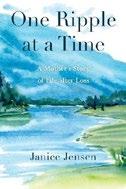
A moving debut memoir about a mother’s loss.
In June 1972, Jensen, her husband, Oskar, and their children, Brian and Erika, traveled to Europe for a vacation. While in Innsbruck, Austria, the children skipped stones along the Inn River. As Jensen watched, she noticed with alarm that the water was rapidly rising around Brian and Erika. Oskar saved Erika, but Brian was swept away in the surging waters and presumed dead. Jensen returned to Oregon determined to follow her son’s joyous approach to living. Oskar, however, full of guilt and sorrow, withdrew and gradually descended into alcoholism. Jensen’s narrative then moves back in time prior to the trip and describes a family where “each person belonged, found their path, and thrived.” The contrast between their lives before and after the accident is striking. The author also poignantly limns the connection between Jensen and Oskar that endured even after the couple eventually divorced. While Jensen worked to rebuild her life, thoughts of Brian called her back to Austria, where a rafting trip along the Inn River gave her some solace. Jensen is a gifted storyteller whose writing style is confident and wise, especially when describing the lessons she learned while grieving her son: “Women have traditionally been expected to ‘grin and bear it,’ an attitude I took literally from my mother. This meant some pieces of advice I gave Erika were, in retrospect, not helpful.” Several elements of the narrative timeline are unclear, however. Still, Jensen’s nuanced portrait of grief will resonate with readers who’ve experienced the loss of a loved one.
A ruminative exploration of the grieving process.
enthusiastic championing of folk music by an ethnographer ahead of her time.
Kerst, Catherine Hiebert | University of California Press (376 pp.) | $34.95 April 2, 2024 | 9780520391314
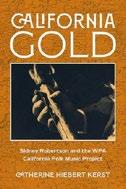
Kerst shares with readers a fascinating compilation of California’s folk music in the late 1930s and the passion and ingenuity of Sidney Robertson Cowell, its unsung collector.
To combat the Great Depression, President Roosevelt’s Works Progress Administration set out to employ desperate jobseekers in public works projects. Founded in 1938, the WPA California Folk Music Project was one of these programs, an ethnographic survey of the varieties of folk music in the Golden State, created and led by Robertson Cowell. Prior to the Depression, Robertson Cowell had been raised in a prosperous family as a welltraveled, highly educated polyglot with considerable experience in music. Yet as a folk music collector, her documentation went far beyond just recordings; it also included observations in animated prose about her tools, methods, and travels to find artists, as well as the artists’ personalities, senses of humor, and family origins. Kerst, working from these notes from the Library of Congress, shares Robertson Cowell’s recordings from 1938 to the project’s closing in 1940, ranging from a paso doble at a Mexican wedding, psalms by the Russian Molokan sect, offcolor Englishlanguage ditties, and many more. Commentary on how
certain lyrics evolved, reflected the racial prejudices of the time, and used bawdy or downright erotic subtext adds a contemporary context to each entry as well. The resource is dense and includes translations of the songs from their original language and biographies of the collectors, with helpful endnotes and indexes. The book is organized by the cultures of the performers, providing full cultural pictures of their subjects, be they Portuguese Azorean folk traditions, the mythological influences of Icelandic ballads, or the heartbreaking influence of the Armenian genocide. There is an infectious, boundless adoration for its subject and her pedigree throughout, one that rivals even Robertson Cowell’s own passion when capturing a variant sea shanty or locating a blind gusle player. Even those with little interest in 1930s folk music can learn valuable lessons from her approach to fieldwork. An enthusiastic championing of folk music by an ethnographer ahead of her time.
Law, Sarah | Wipf and Stock (250 pp.) | $24.00 paper
Sept. 23, 2022 | 9781666735901

Law’s historical novel tells the story of St. Thérèse of Lisieux (the “Little Flower”) in short vignettes. The author has concocted a tale ostensibly about the spiritual life, the abnegation of the larger world, and especially about the
almost angelic deportment of a young woman named Thérèse, who would become the most beloved French saint of the 19th and 20th centuries. All five Martin girls enter the religious life in Normandy, France, four (including Thérèse) as Carmelites. There is the eldest, Marie (Marie of the Sacred Heart), Thérèse’s godmother after their mother’s death; Pauline (Agnès of Jesus), the second oldest and most practical one; and Celine (Genevieve), the artist. Troubled Leonie (FrancoiseThérèse), who styles herself “Léonie the LeftOut” after many false starts, is admitted to the Visitation Convent. Cousin Lucie Guérin also becomes a Carmelite but dies young. The priest is the Rev. Maurice Bellière, whom Thérèse is assigned to pray for. The whole Martin family was deeply religious; in fact, the parents were canonized as a couple in 2015. Thérèse is especially precocious in her vocation, eager to join Marie and Pauline in the monastery at age 14, even begging the pope for a dispensation. Before that, however, she has an attack of scrupulosity (“I have done nothing but sin!”) and must be counseled out of that trap. But through all her pain, she puts others’ needs before her own and dies of tuberculosis at 24. Importantly, what survives is her book of reflections, “The Story of a Soul,” still in print. She is, to this day, much beloved among the faithful; her basilica in Lisieux is second only to Lourdes for French pilgrimages.
Law writes with a poet’s sensitivity. At one point, Marie says of her sister Pauline: “I glint; she gleams.” Thérèse is described as “clutching the handkerchief like an inadequate toy.” A hint of lust comes to Marie as “an unnamed sensual flickering persists, perhaps, in my soft body’s alcoves.” And the Martin sisters are drawn with vivid individualistic detail: Marie is instinctively a mother, while Pauline is the practical realist who will eventually become the prioress and lead the terrified sisters through the horrors of WWII and survive an Allied bombing. The talented Céline has her sketch pad and camera (a surprising indulgence in the cloister?). But of the four blood sisters it is Léonie the misfit who will garner the most interest. She tries for years to be accepted as a
religious figure and finally succeeds, although not as a Carmelite. She thinks herself unworthy, clumsy, even stupid. Interestingly, she often refers to herself in the third person. Does she suffer from a dissociative disorder? The author makes none of this too apparent. Thérèse died in 1897, but the story goes well beyond this point: The last Martin sister to die was Céline, who lived into the era of Sputnik and the space race. Much of the postThérèse story concerns itself with the meticulous promulgation and preservation of her legacy.
A moving story of convent life and a bygone world that now seems downright exotic.
Mebane, William | Self (199 pp.) | $28.01 paper | May 11, 2024 | 9781940387093

Mebane offers strategies and insights for dealing with the climate emergency in this nonfiction work. In his nonfiction debut, a collection of pieces previously published in Wall Street International Magazine, the author presents readers with reflections on many aspects of the ongoing and worsening climate emergency, which is becoming more apparent and unavoidable with every passing year. At the heart of his book is a resistance to the fatalism that tends to characterize discussions of the subject. The fatalism is understandable; the world’s industrialized nations are a long way from reaching the goals for lowered carbon emissions set by environmental scientists years ago as the only way to avoid catastrophic climate change in the lifetimes of the current generation’s grandchildren (if not earlier). The problem seems too big to be solved; as Mebane puts it, “only an urgent systemwide transformation can avoid
a climate disaster.” But the author has spent years in the environmental movement, including a stint spearheading Italy’s energy revolution in the 1980s, and he offers what he calls a “story of transformation—a story that proves that even in the face of daunting challenges, the power of human ingenuity and collaboration is essential.” In a series of beautifully illustrated (and wellresearched—the book’s reference section is extensive) chapters, Mebane looks at the practicalities of green investment in all its forms, from renewable energy sources to improved grids and electric vehicles to what he calls “forest therapy”—the power of green spaces to help with ailments like diabetes, heart disease, hypertension, and asthma.
The tone of tough, informed optimism the author adopts is crucial to the convincing power of his argument: This work combines the research of a professional with the optimism of a true believer. Mebane never sugarcoats how dire the current climate situation is, particularly in the energyhungry developing world. He acknowledges that we have “more unresolved problems than solutions” and notes that “the primary issue is how to help developing and evolving countries invest in mitigation and adaptation,” coming to the ethically inevitable conclusion that a large part of any such help will have to come from the developed countries that caused the climate crisis in the first place. Mebane is very skilled at deploying his many charts and graphs in ways that fit naturally into his text—readers never feel bludgeoned with facts or statistics, even though much of what the author is describing can get fairly technical. Those skeptical of the industrialized world’s ability to reach “net zero” goals by target dates like 2050 will emerge from this book not only immeasurably better informed about every aspect of the challenge, but also invigorated to take it on. Mebane may have spent many years in Italy, but he himself is a Texan and the son of a petroleum geologist, and this background gives the factheavy sections of his book an air of authority and personal involvement. This tone is crucial for staving off the despair that readers might
otherwise feel when the author hits them with plain talk about how bad things are: “Weather and climaterelated disasters are growing exponentially,” he warns. “We may not know the hell we are creating.” A knowledgeable and ultimately upbeat look at mitigating climate change.
Mills, Tyler | Unbound Edition Press (330 pp.) | $26.04 paper March 12, 2024 | 9798989233304

This dreamy, elliptical narrative loops fragments of evidence and observation to destabilize the history of the atomic bomb. In this work, Mills, an American essayist, poet, teacher, and artist, probes emotions of the Cold War era that have often been ignored. Many people have only basic knowledge about the testing of the first atomic bombs and their deployment, but Mills enriches the story with a plethora of astonishing details, some of which come to light when she reconsiders her grandfather’s war stories. Was he part of the mission that laid waste to a Japanese city with a nuclear bomb? After all, he possessed an unauthorized photo of the atomic bomb cloud spreading over Nagasaki. Answers don’t come easily, but Mills embraces ambiguity. She makes visible the people displaced by bomb testing, the people who still reside in Los Alamos, New Mexico, in proximity to hazardous nuclear waste decay, and communities like the Tularosa Basin Downwinders, who were not warned of early testing and were thus poisoned by radiation. She notes the erasures “of peoples, places, and facts that cloud the development of the atomic bomb. I make no claim to fill in the gaps. What I have done is to articulate the shape of the cloud that obscures them.” She has crafted a lyrical story that embraces feelings of terror, grief, and hope, including her own meditation on her attempts to conceive a
child, and her subsequent role as a parent in a frightening world. The visual nature of explosions is also a frequent focus; Mills expresses her attraction and revulsion regarding them in a series of collages and paintings, which she reproduces and interprets in these pages. The abstract and challenging structure of the book is, for the most part, effective. However, some sections, such as a lengthy one concerning a dog in her neighborhood, are perhaps a bit too far from the memoir’s thematic center. Repetition and reverie propel this unusual and often riveting memoir about the terror of atomic power.
Miniuk, Colleen J. | Analemma Press (352 pp.) | $29.95 | July 8, 2024 9780998785707

Divorce sends a woman on an unforgettable paddleboard journey with her mom in Miniuk’s memoir.
Lake Powell is manmade, formed by a dam in the Colorado River. It’s no placid recreational lake—the second largest reservoir in the United States, it “slices through the Colorado Plateau like a blue lightning bolt starting near Hite, Utah, and ending near Page, Arizona,” its 1,960 miles of shoreline “a mostly treeless collection of hardened buttes, chiseled bluffs, and crusty, petrified sand dunes.” What’s more, the lake has a river’s current, one that has only increased in strength as drought has lowered the water level. Sailing the length of it—on an inflatable standup paddleboard, no less—is no easy feat. Yet that is precisely what the author, a photographer, decided to do in the fall of 2015, following a difficult year that included both her 40th birthday and the dissolution of her marriage. When Miniuk, who did not even own a paddleboard when she decided to make the trip, was advised it would not be smart to do so alone, she recruited her mother,
Jacque, to accompany her. Despite her inexperience and the dangers ahead, the author set off with a swell of confidence. “The comical comments from doubting Thomases and nervous Nellies made me laugh and then check my head for loose screws,” she remembers. Was that confidence misplaced? Miniuk’s frank prose illuminates both the desert river and her own interior landscape: “I hadn’t ever lived alone except for one year, my senior year in college…I had never faced the shadow of myself unaccompanied. For forty years, someone had always sheltered me. Until now.” It’s a divorce memoir as much as it is a travel book, though Miniuk’s brilliant fullcolor photographs keep the journey from ever feeling too dark. One can’t help but finish the book wanting to embark on a wild adventure of one’s own.
An inspiring tale of self-discovery and mother-daughter friendship.
Norwood, James | New Generation Publishing (255 pp.) | $14.85 paper Sept. 19, 2023 | 9781803698120
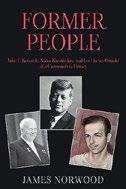
A scholar offers a revisionist take on the intersecting lives of John F. Kennedy, Nikita Khrushchev, and Lee Harvey Oswald in this nonfiction book. The phrase “former people” was first used by Russian writer Maxim Gorky in reference to former aristocrats, nobility, and elites who simply vanished from Russian historical memory following the 1917 Bolshevik Revolution. Extending this concept to the context of the Cold War, Norwood argues that the phrase equally applies to Kennedy, Khrushchev, and Oswald (“Each life merits a careful reappraisal based upon the realities of the Cold War”). The author observes that Kennedy and
Khrushchev were leaders of the world’s two largest superpowers and guided the United States and Soviet Union through the Cuban Missile Crisis in the early 1960s, but by 1964 they had joined the ranks of “former people” (Kennedy was assassinated in 1963, and Khrushchev was deposed in 1964). Though Kennedy and, to a lesser extent, Khrushchev remained household names, the historical narratives that shaped their lives were warped, per Norwood. Representative of this lack of meaningful remembrance is the abstract sculpture at Khrushchev’s 1971 gravesite, which would have “appalled” the former Soviet leader, who notoriously despised the aesthetics of modern abstract art. Even Kennedy, whose mythologized Camelot has been the topic of countless books and movies, has not been given his historical due, asserts Norwood, as academic scholars have largely avoided wading into the conspiracyladen terrain of his assassination. Regarding Oswald, the author purports to have uncovered the “true story” of the alleged assassin (the book advances the idea that, like Kennedy and Khrushchev, Oswald was a victim of the CIA and Cold War). Quest ioning the official narrative of the Kennedy assassination, Norwood supports his argument with 570 research endnotes. Holding a doctorate degree from the University of California, Berkeley, Norwood carefully balances a solid grasp of the relevant literature (even while questioning the underlying conclusions of mainstream scholars) with an accessible writing style. The book’s seven “Pictorial Essays” offer insightful analyses and visual images to accompany its reevaluation of the three men. An engaging revisionist history of Kennedy, Khrushchev, and Oswald.

Orr, Elaine | Self (248 pp.) | $9.99 paper May 19, 2023 | 9798394629556
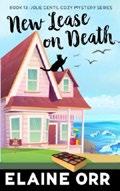
A couple’s romantic, relaxing beach weekend goes very much awry.
coffee shop and brightly colored boardwalk, helps lighten the mood between murders.
An engaging mystery and a fun return to familiar players.
For more Indie content, visit Kirkus online.
Jolie Gentil has a pleasant life in Ocean Alley with her husband, Scoobie, twin toddlers, a successful career as a real estate appraiser, and a warm community of friends and family. The past 15 months, however, she’s been nagged and irritated by Buck Brock, an ambitious, greedy property developer and landlord. Meanwhile, after Eleanor Fielding and her husband have a horrible stay at one of Buck’s shortterm rentals, at the behest of the Landlord Tenant Commission, he gives them a free weekend stay with complimentary cheese, crackers, and chocolates. At Java Jolt, the local cafe, Jolie is happy to run into Eleanor, whom she knows, but is shocked when she collapses. Eleanor had mentioned feeling queasy after eating some chocolate, and people assumed she’d be fine after a quick run to the hospital. But Eleanor may not recover. In other news, Josh, a man with a complicated past, shows up in town. Jolie had taken pity on him and helped him get a job with Brock. Is he somehow involved in the town’s recent nefarious development? When the hated landlord mysteriously dies, the case gets even more puzzling. Orr’s latest is a welcome addition to the Jolie Gentil Cozy Mysteries series, developing the narrative arcs for established characters while seamlessly introducing new ones. The large cast, however, will make it difficult for new readers to join the series at this point; it’s better to start with the first book, Appraisal for Murder (2011). Orr’s plain prose rarely calls attention to itself (“I took my coffee to a twoperson table near the window and glanced up and down the boardwalk. The day was overcast, so even the bright colors of boardwalk businesses didn’t lighten my nervousness”), and the friendly, smalltown environment, with its local
Priest, Gail | Red Adept Publishing (370 pp.) | $15.49 paper April 27, 2024 | 9781958231487
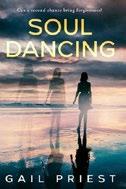
A woman gets another chance at life in Priest’s supernatural novel. When 90yearold Shirlene Foster is breathing her last breaths at a hospice facility in Philadelphia, she decides she’s not ready to go; her husband, Stan, has a failing heart, and she’s worried he still needs her to take care of him. Determined not to leave him behind, she resists death and wakes up in the body of 20 yearold Rain DeLuca, right as she’s giving birth. With a new daughter—and no idea who Rain is—Shirlene does her best to play along. But with Rain comes Cameron Michaels, the baby’s uncle. Cameron, who always wanted his own children, decided to help take care of the baby after his brother got Rain pregnant and abandoned her. He knows something is up with Rain when she suddenly starts acting nicer (he describes Rain as “unreliable, selfish, uncouth, unethical, and an energy vampire”). Shirlene, knowing she can’t keep lying, confesses who she really is and tells Cameron she needs to bring Stan home for his final days. This confession sets off a unique relationship between the pair, which only gets more complicated as Shirlene struggles to deal with her growing attraction to Cameron—and her feelings toward Stan after a secret is revealed. The use of dual narration alternating between Shirlene and Cameron provides an indepth view of their backstories and emotions and makes them both feel well rounded and relatable. The story also features a colorful cast of supporting characters who each breathe life into the
pages, making for a vibrant read. A whirlwind of a twist in the second half throws the plot into turmoil; it may be a divisive factor for some readers, but those who stick it out are in for a compelling journey filled with love and heartbreak. A captivating look at motherhood and romance with a unique twist.
Rader, Laura C. | Acorn Publishing (394 pp.) | $28.00 | $17.99 paper
May 21, 2024 | 9798885280785 9798885280778 paper

In Rader’s 17thcenturyset drama, an English settler in the New World attempts to rescue his wife, who has been kidnapped by Indigenous people. In the 1670s, war breaks out between English settlers who are arriving in the New World in increasing number and the River Indians who have been dispossessed of their land, led by Metacomet, whom the English dub King Philip. Benjamin Waite, who lives in Hatfield (part of the Massachusetts Bay Colony) with his wife Martha and his three daughters, is reluctantly drawn into the conflict and marches off to attack a neighboring Indian village—to his great horror, his band massacres the mostly defenseless natives, including women and children, in a grotesque slaughter chillingly captured by the author. “I wiped away hot tears and sweat from my face with my gloved hand. Men torched wigwams and watched them burn. The mighty river swept people and canoes over the falls, and the white water sparkled in the sun, mocking the horror.” In a cataclysm of retaliation, the River Indians raid Hatfield while the men are working in the fields and kidnap Martha and her daughters. Overwhelmed by fear and grief, and not even sure who is responsible, Ben attempts to organize a search party and retrieve his family before it is too late. Rader paints a stirring picture with the subtlest of brush strokes—this
A moving work, dramatically compelling and historically searching.
is no simplistic struggle between good and evil. Both sides have earned the right to some grievances, and both commit unspeakable atrocities. Martha, in particular, is an impressively drawn character, deep and complex; she is horrified, even while in captivity, by the terrible things Ben has done to her captors. The conclusion of the book may strike some readers as a bit tidy and even sentimental, but overall, this is a moving work, dramatically compelling and historically searching. An engrossing novel that challenges stale narratives of colonial America.
Royce, Adele | Madweek (398 pp.)
$28.00 | $17.99 paper | June 20, 2024
9798990326934 | 9798990326903 paper
Series: The Neon Diaries, 1
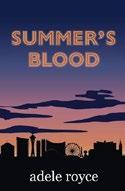
A handsome, rich, successful ad exec tormented by his past discovers that, contrary to the slogan, what happens in Vegas doesn’t necessarily stay there.
Royce’s first book in her Neon Diaries series features Craig Keller, one of four partners (another partner is Jane, his spicy second wife) in a midsize advertising agency in Santa Monica, California. Craig was not the favorite child of brilliant, wealthy serial cheater Donovan C. Keller; the preferred son and heir apparent to his father’s law firm was the nowdeceased Donovan James “D.J.” Keller. After the elder Donovan’s sudden death, it’s Craig who speaks at his father’s memorial service,
calling him “brutal, unforgiving, full of rage and fury.” In attendance are countless friends and business associates—platinumhaired, steelyeyed Luuk Van Ness was both. Craig muses that though Luuk “was something of an unofficial godfather,” he never knew if he could trust him. Luuk owns the Regal Oasis, a highend Las Vegas resort; in the late 1980s, Donovan successfully defended a mobster who was an Oasis regular. Donovan’s law practice made him incredibly wealthy, and D.J. would have taken the firm over had it not been for a tragedy nearly 30 years earlier. It was Craig’s 17th birthday, and he and D.J. and some of D.J.’s law school buddies were partying until they passed out on Donovan’s yacht. When D.J. came to and the waves got choppy, he looked below deck for Craig. Instead of his brother, he found a tall, burly man and bags of cocaine. “Dude, you’re…running dope on my father’s yacht?” D.J. blurted out. They fought and toppled into the water, close to the yacht’s propeller; only body parts were found. Craig blames himself for his brother’s death. He is haunted by the tragedy, to the point of thinking he sees his brother from time to time. He constantly worries about losing others, even Jane, who pledges she is his (even though she, like him, has an adulterous past). When their ad agency gets involved with Luuk and his chainsmoking son Hendrik on the rebranding of the Oasis, jealousy mounts, as does danger, particularly when a mobster who went to jail due to a mistake made by Donovan’s firm is paroled.
Though the novel is plotdriven, it has rich character development. There are enough characters— casino kingpins, mobsters, ad agency staff, and family members—to stir up the story and lead to sequels, but not so many that a scorecard is needed. Aside from Craig’s four children (two with Jane, two with
the ex), no one is beyond reproach. Every character is compelling, particularly Craig, who “could dazzle clients by being goodlooking and glib,” and Hendrik, whose shoulderlength blond hair streams down “like rays of light.” The language can be gritty, and the sex can get steamy—Jane has a thing for getting her clothes ripped off. Rich descriptions fill the narrative: Craig’s teeth are “unusually straight and white, with slightly elongated canines”; Jane calls them his “vampire teeth.”
A graphic, gripping start to a new series.
Sabino, Mariana | k+p Press (212 pp.) | $16.99 paper May 15, 2024 | 9781735934624
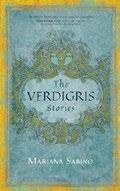
Women and men search for purpose in Sabino’s globespanning debut fiction collection. A Czech woman returns to a seaside Brazilian village following the death of her husband, a wealthy eccentric known for building the town’s strangest house. Despite a lessthanwarm welcome from the locals, she begins to fix up the house—but it takes a major change in her circumstances to win the townsfolk over. In a parallel story, the same woman returns to Prague after years in Brazil to an apartment in her grandmother’s building and her old job at the National Film Archive. “I’d always been drawn by unknown places and people presented to me through photographs, films, and documentaries,” she muses, wondering if she’s made a mistake coming back after the death of her husband. “At home, I tended to feel like part of the furniture.” In these 11 stories, time and distance conspire to erode people’s sense of belonging—in their jobs and relationships, in whatever country they happen to be living in. A woman about to be married on a Greek island in “Carol’s Mole” has second thoughts—inspired, in part, by her absent mother’s odd warning about the
mole the woman has always borne on her shoulder. In the aptly named story “In Between,” an American woman who recently left her marriage in Hungary finds herself living in a San Francisco hotel with no plan, seeing her dislocation mirrored in the unhoused people she meets on the street. Sabino masterfully finds tension in her characters’ intolerable stasis. “She’s usually someone’s assistant, collaborator, goto person, but suddenly there was nothing to do in Buda but watch her marriage hold its breath,” she writes of the San Francisco woman. “A tense pause with no end in sight.” Sabino excels at evoking place—not only its physicality, but the psychology of a place—though she doesn’t always force her characters toward a point of crisis. As a result, these pieces often feel more like vignettes than full stories, memorable as they are.
A richly drawn collection of tales about exiles caught between eras of their lives.
Searle, Newell | Calumet Editions (298 pp.) | $18.99 paper Oct. 11, 2023 | 9781960250964
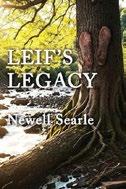
An elderly woodsman’s will leads to a legal fight over his valuable farmstead in Searle’s mystery novel. Minnesota newsman Boston Meade interviews
Leif Nielsen, a former forest ranger, who represents the last of a dying breed of woodsmen. Leif is determined to protect his farmstead on Tarn Lake, one of the last undeveloped pieces of land in the area. When a bout of pneumonia lands Leif in the hospital, the value of his property attracts the attention of his brother, Harald Nielsen, and Harald’s ambitious wife, Regina. They draft a will for Leif that gives Harald power of attorney. When Leif dies suddenly, the Nielsens are enraged to discover that Leif went behind their backs and left his estate to a professor, Sandy Brewster, who had been like a son to him. The
Nielsens plan to contest the will on the grounds that Leif was mentally incompetent, and they intend to fight dirty. Sandy needs the support of allies like Meade if he is to honor Leif’s wishes. But how far are the Nielsens willing to go? The heart of the story is Sandy’s fight for Leif’s legacy—unfortunately, this theme is often overshadowed by the cartoonishly villainous exploits of Harald and Regina. (Regina, especially, increasingly becomes a maneating cliche as the story progresses, and the time the author spends on the couple seems wasted.) The passages about Leif’s passion for the land contain the book’s most artful prose: “He pecked out descriptions of hanging gardens with a few flowers, grass and ferns clinging to tiny ledges…Each thin stratum of rock read like a page from half a billion years of planetary history.” Sandy’s task in the story is to prevent this beauty from being lost to Harald and Regina’s scheming—the narrative should have followed his example. Still, it takes a skilled writer to make a legal battle over a will a pageturner; Searle deftly fills potentially dry conversations about land preservation with drama and tension. A legal thriller with some uneven characterizations redeemed by a satisfying conclusion.
Senick, Laurel H. | Sophie’s Treehouse Media (296 pp.) | $14.99 paper May 10, 2023 | 9798988215806

Cassandra “Cass” Lee, a surfer by day and a freelance journalist by night, finds herself entangled in a conspiracy in Puerto Rico in Senick’s thriller. When Bradley Cunningham, Cass’ boyfriend of six months, asks her to leave her beloved North Carolinian beach town to live with him in Halifax, Nova Scotia, she’s ready to go with the flow. But once they
arrive, nothing is as she expected—especially Bradley, who’s clearly keeping secrets from her about the pharmaceutical job that’s taken over his life. Just after they make a plan to get married, Bradley dies in a suspicious car accident. Cass escapes to her personal paradise, Puerto Rico, to process the loss, and soon finds a new job waiting tables. She makes new friends and finds a new love interest, Mario, who continuously helps her to test her limits, leading her to the story of her career: a legendary sunken treasure underneath an island where “the drugs…are as notorious as the pirates.” But as tragedies mount and foul play is suspected, Cass’ investigative journalism skills take over. Senick’s portrait of a grieving woman is beautifully backlit by a vivid portrayal of the beach town of Rincón, Puerto Rico. The author never portrays Cass as one who sees things through rosecolored glasses, so readers get the opportunity to feel completely present in her firstperson perspective; indeed, they’ll smell the setting’s salty, spiced air every time she steps outside. It’s a complex and involving story with multiple plotlines that makes for a perfect beach read. Some aspects aren’t given as much care as others—such as Bradley’s demise—but the end result is still satisfying. As one character notes, “Laughter and tears are [an] ancient healing balm,” and Senick provides plenty of both in these pages. A fast-paced, lively read, set against a suspenseful Caribbean backdrop.
Shelley-Grielen, Frania | Self (422 pp.) | $17.99 paper
April 30, 2024 | 9798323912698
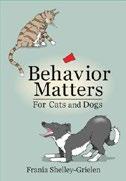
Shelley Grielen offers an exhaustive treatise on the behaviors of cats, dogs, and their humans as they interact with one another. Through comprehensive discussions of the evolutionary history of cats and dogs, the
author details the influences on their behavior visàvis their human caretakers. Cats, for example, “process information through primary senses not our own.” They see the world through “scent, pheromones, and sound.” Major topics are covered in individual chapters dedicated to specific issues. A thorough examination of the natural behaviors of cats and dogs, involving their social structures, communication methods, and cognitive abilities, forms the basis for addressing behavioral problems. Under the broad category of environmental enrichment, ShelleyGrielen highlights the importance of providing a stimulating environment that meets the physical, mental, and social needs of the animal, which helps prevent boredom and subsequent behavioral issues. The author is a great advocate for positive reinforcement techniques in training to promote desirable behaviors while minimizing stress and fear in pets, and she offers solutions for addressing especially troublesome behavioral issues such as aggression, anxiety, and inappropriate elimination. Beginning each subject with her personal experience with an animal to illustrate the builtin biological differences between humans and the animals with whom they are trying to communicate, ShelleyGrielen follows up with a compendium of scientific data. The author has a tendency toward verbosity, which will likely cause readers to begin skimming. (“While dogs, whose primary sense is smell, have keyed more into our reliance on the visual, honing shared eye contact with us…[cats] rely on our ability to interpret the meaning in a range of auditory signals or words for humans.”)
Still, the organizational structure of the book, with its standalone chapters addressing specific issues, makes this an accessible, useful reference book for pet parents. Readers will likely appreciate the plethora of engaging factoids offered, such
as the observation that humans have the most expressive faces of any animal thanks to their 52 separate face muscles. An information-packed guide to managing and modifying cat and dog behaviors sensitively and effectively.
Smith, Scott Russell | Christmas Lake Press (350 pp.) | $22.95 paper
July 1, 2024 | 9781960865069

Rotting organic matter inspires this collection of personal anecdotes, garden science, and historical digressions.
We meet the author behind a coffee shop in tony Westport, Connecticut, as he’s gleefully putting a garbage bag full of coffee grounds—still warm!—in his car. This brown gold is on its way to Smith’s compost pile, where its nitrogen will transform fall leaves into rich soil. His dumpster diving isn’t just a way to get free nutrients for his garden. By liberating these spent beans and reusing them, he’s keeping them out of an already overflowing landfill. He may also be keeping leaves out of a landfill; yard waste makes up a rather shocking amount of all that people throw away in the United States. Smith’s investment in his own patch of land extends to a concern for the environment generally, and his sense of alarm is woven throughout the text. But this diary of a gardener’s year is more than a call to action. Smith’s composting career began when he was an editor at a food magazine,
Part memoir, part backyard gardening guide, and altogether charming.
and his cooking colleagues started giving him their kitchen scraps. The prose here is stylish but never showy. Smith’s sentences have the patient pacing of someone attuned to the seasons. Any observant and curious writer is likely to go off on tangents, and this writer certainly does. The author includes quotations from Wendell Berry and Henry David Thoreau, but he also shares Natalie Goldberg’s meditation on mental composting from Writing Down the Bones. Anyone claiming to be any kind of authority on compost would reveal themselves as a fraud without a chapter on worms, but not every author will mention that Cleopatra declared earthworms sacred or that the landmass that we call North America was denuded of earthworms during the last ice age, only returning with European settlers. Even when he offers glimpses of his personal life beyond the garden, Smith’s sense of time is connected to the state of his compost. Part memoir, part backyard gardening guide, and altogether charming.
Sonnenberg, Shannon | Illus. by Birdie Rook Orange Hat Publishing (22 pp.) | $15.99 June 18, 2024 | 9781645387657

An imaginative kid learns about managing his emotions in Sonnenberg’s picture book.
Niko, who has lightcolored skin and a mop of short black hair, has an imaginary new job as a bus attendant. After breakfast, Niko grabs his fake mustache from under his bed, next to a yellow toy school bus. When Niko gets to class, he sits beside his best friend, Nina, who has brown skin with her hair in two curly brown buns. Niko pretends he is a bus; his first passengers are Silly, Happy, and Impulsive. Happy and Silly board first; then Niko puts Impulsive in the driver’s seat, thinking, “Why not?” While Impulsive drives the bus, Niko notices his teacher’s pink dress and blurts out: “Ms. Moreno!! Your dress makes you look like the big, fat pink frosted donut with blue sprinkles that Dad bought me from the gas station this morning!” Niko’s
next passengers are Guilt and Tummy Troubles. Rook’s clever illustrations unravel the metaphor of the bus passengers, each of whom is a uniquely colored little version of Niko. The pictures use luminous, highly pigmented colors for the characters and fun, comicstyle accents against mostly grayscale and muted backgrounds. The exciting thirdperson narration brings Niko’s imagined world to life and drives the plot. At the end of the book, a couple of pointed questions for reflection invite the reader to look deeper into the emotions that arise throughout the story.
A deeply engaging examination of emotions and how they work, made fun and funny.
Staffel, Megan | Regal House Publishing (223 pp.) | $18.95 paper Oct. 22, 2024 | 9781646034932
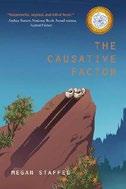
An accident links the lives of two lovers in Staffel’s novel. Rachel Goodwin first sees Rubiat Elsayem when they attend a New York college together and meet in a performance art class called Body Expression. They’re partners on a project in which each must define the other’s essential quality. They fall in love over a 24hour period before finding themselves on a long hike at Stony Brook State Park. Rachel watches Rubiat impulsively dive from a cliff and assumes (incorrectly) that he’s dead. She tries desperately to move on from the shock. The novel is split into two halves: The first follows Rachel through the aftermath as she builds her career as an artist and language teacher in Queens, eventually meeting someone new. The second follows both Rachel and Rubiat. Rachel unpacks her deep feelings for Rubiat, and he explores his issues with impulse control and pressure in the wake of leaving Rachel in such a spectacularly weird way. Staffel also incorporates perspectives from Dusty, Rachel’s boyfriend, whom she meets through her
friend Angela, who’s Chinese American. The book movingly depicts the complexity of human psychology, such as Rachel’s inability to forget Rubiat. Other weighty themes, like Angela’s exoticization by her German boyfriend, are glossed over—a missed opportunity. Ultimately, the novel becomes a fascinating portrayal of identity, expanding on the moment that brought Rachel and Rubiat together (which lends its name as the title), explained by their teacher as an exercise that would guide the participants toward finding “their deepest motivation, the hidden foundation of their character, that quality that makes them the person they are.” A suspenseful plotline, sometimes slowed by flat secondary characters, continues to investigate the cast’s motivations, and Staffel probes Rachel’s and Rubiat’s personalities right until the final page. A gripping, unusual romance fueled by an ongoing mystery.
Supplee, Aud | Wild Rose Press (294 pp.) $19.99 paper | July 24, 2024 | 9781509255955

In this YA fantasy, teens undertake a rescue mission in a magical alternative world.
The third book in Supplee’s fresh, wellcrafted Winnie and the Wizard fantasy series begins with the return of 14yearold Winnie Harris, her 6yearold stepbrother, Mikey, and teenage magician Kip to Winnie’s family beach house on Earth after a dangerous mission on an alternative “Frama” world known as Hutra. (The “Frama” worlds, introduced in Book 1 [Frama-12, 2022], are accessed through the use of “Framascopes,” magical devices once solely the province of powerful time guardians.) Winnie, famed on Frama worlds as army general Windemere, learns that the pet toad Mikey brought back from Hutra is actually an enchanted princess from Aylen Isle. In a dream visitation, Princess Gwen begs Winnie to take her home and undo the spell. Winnie can’t resist. She “had already encountered
her share of crazies” during her previous Frama missions. “But a fairytale world? The possibility sounded too nutty to pass up.” Besides, Winnie needed to return another travel companion, a large bird, to its original world to ensure its survival, so she might as well do both. By mutual consent, the three adventurers and the toad/princess jump through a time portal to Aylen Isle. With an ear for wellpaced, plotfurthering dialogue and a flair for worldbuilding, the author molds familiar fairytale tropes (tree sprites, “leafling” fairies, two princesses, and a kingdom in peril) into a dynamic adventure involving “mother” trees as healing havens, carnivorous plants, an attempted royal coup, a lethal, gatekeeping “Myst,” and sentient, magic “glow stones.” This vivid fantasy can be enjoyed on its own. Readers of the first two books, however, will find a rewarding progression of intriguing elements, including an amphibian military general that inhabits Mikey’s small body, Winnie and Kip’s thorny and evolving relationship, and the motivations of Winnie and Kip’s interfering nemesis, Krell, whom innocent Mikey still loves as his “nonDad.”
A gripping adventure enhanced by a creative plot, lively dialogue, and strong female characters.
Tam, Kelvin Christilius “Hue Ping“ FriesenPress (192 pp.) | $29.99 $19.99 paper | May 1, 2024 9781039197633 | 9781039197626 paper

Tam’s memoir offers a detailed, contemplative journey through his decades of work as a Catholic priest around the world. The narrative spans the entirety of the author’s life up from his birth in Trinidad in 1927 into one of the three Chinese families in his village at that time—to his current semiretirement in his 90s. Tam is judicious about how much space he
devotes to each era in his career, so the book is well under 200 pages in length. Still, he allows himself enough space to give readers a strong sense of the environment and culture of each place he’s lived; readers learn about his childhood in Trinidad, his time spent at a seminary in Quebec, his missionary assignment in Owerri, Nigeria, and his work with orphans in Cali, Colombia, to name but a few. Throughout his accounts of his time as a missionary and at various educational facilities (both as pupil and teacher), he details the connections he made with many friends and students over the course of his life, some of whom went on to impressive achievements in a wide range of fields, including athletics, medicine, and education. However, the author tends to mention every notable person he encountered, as well as each accolade they received. These mentions are sometimes quite impressive: “Another student started his musical career, taking part in the college’s wellknown Gilbert and Sullivan operas. Later, he founded a musical band, Boomtown Rats, that became world famous, planning the concerts, Band Aid and Live Aid….His name: Bob Geldof.” That said, it’s a narrative device that becomes repetitive, as most of these people are not recurring figures in the text, and not all are very well known. Nonetheless, Tam’s recollections proceed effectively despite this, and his overall message of care and his focus on helping others are worthy and important.
A meditative, if sometimes overcrowded, remembrance with an appealing emphasis on compassion.
Tripoulas, John | Dos Madres Press (138 pp.) $23.00 paper | April 1, 2024 | 9781962847056

A book of poems that toggles between the head and the heart.
Tripoulas combines philosophical ponderings with indelible memories. He opens with “Fish Hooks,” a
contemplation of bronze fish hooks from the 4th century BCE, preserved behind glass at the Piraeus Archeological Museum in Greece. He notes that despite “centuries beneath the sea,” they’re the same shape of hooks found in tackle stores today. While in Florence, Italy, the speaker of “Ekphrastic Theology” realizes that “Uffizi’s many Annunciations / often portray literate Mary / with book in hand. In “Asemic,” the speaker observes that Buddha, Christ, and Socrates never held a pen, perhaps because “Only their disciples turned to / written manifestation (manus, hand), / trying to make revelation / tangible, like grasping the wind.” Other poems have a more modern, personal tone; “Insomnia” recalls a grandfather’s cigarettes singeing “the skin of his two fingers / and turning them yellow.” Still others tell stories that are certain to surprise readers, such as “Mike Gabel in Hell,” in which a deceased friend visits the speaker in a dream to inform him that the friend didn’t die by suicide, but that his wife murdered him—a dream proven true when police reinvestigate the friend’s death. Tripoulas is primarily a philosophical poet, which can occasionally make for cumbersome lines, such as “Opposites are one, / wrote the Riddler, / like lyre and bow they beget / the clashing power / of polar strife” (“Looking for Heraclitus in the Samaria Gorge”). Other works can be quite dark, such as “Faces Are Silent Words,” inspired by a 10 yearold girl who drowned during a refugee crossing: “Her face is missing, scoured by sea brine, / her small nose eaten by fish.” Whenever the poet turns his gaze toward nature, he does so stunningly, as in this evocative description of autumn: “leaves swoon to their death / like costumed tragic actors. / Bereft bare branches / high above, grieve” (“Two Views of Autumn”). Throughout, the author unearths remarkable truths about what he sees as timeless and universal in the human experience. An intellectually stimulating and emotionally resonant collection.
Ripped paper: Raul Ortin

Kirkus presents Indies Worth Discovering , a sponsored feature spotlighting an array of fiction and nonfiction works recommended by Indie editors. Here readers can find a useful sampler that shows the excellence and breadth of Indie titles. Find pulsepounding thrillers, revealing memoirs, twisty mysteries, fiery romances, thoughtful business books, problem-solving self-help guides, and incisive poetry collections, among many other works. Searching for something new and exciting? Read on.
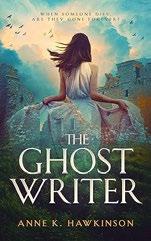
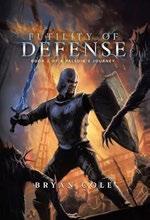
By Anne K. Hawkinson
A creative paranormal love story for fantasy fans.
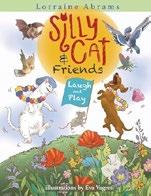
By Lorraine Abrams
Illus. by Eva Vagreti
A book with lively rhyming text and humorous characters, enhanced by charming, fully realized illustrations.
By Bryan Cole
A dazzling cast brightens this tale of clashing swords and spellcasting.
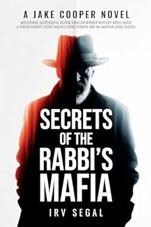
By Irv Segal
An engrossing detective story teeming with memorable characters.

By Nanette Lavin
Illus. by Kate Eroshina
A colorful celebration of food and culture— children will delight in cooking (and eating) their way around the nation.

Kirkus Star
By Tom Farrell
A smart, gripping crime thriller about the corrosive price of vengeance.
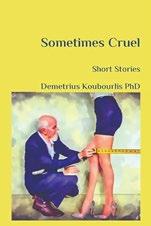
By Demetrius Koubourlis
A memoir in stories contextualizes the author’s striking experiences throughout his adventuresome life.

By Amy Meislin Pollack
An endearing, plucky girl endures and overcomes in this absorbing quick read.
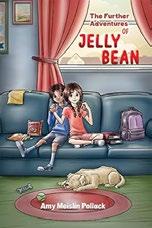

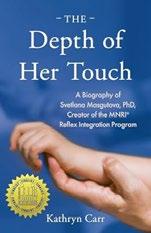

By Amy Meislin Pollack
A winsome series lead effortlessly carries this breezy tale.
By Chris Wieland
A delightful and surprising mystery that bodes well for further installments.

By Emily Benson-Scott
A perceptive set of poems that find the extraordinary in the ordinary.

By Matt Bloom Illus. by Pippa Mayell
A sweet and simple tale of forgiveness that teaches kids and adults alike the value of helping others.
By Kathryn Carr
A captivating blend of portraiture and scientific explanation.

By Tim Stobierski
A vivid portrayal of love, sex, and desire using natural imagery.
By Nancy Hartney
Realistic, sharply descriptive, and movingly observant writing.

By Dan Birk
An engaging novel with a consistently smart, funny, and self-reflective narrator.




By Marc R. Micciola
A fun adventure in a fantastical land.

By Tracy Cram Perkins
A valuable, sympathetic guide to the highs and lows of elder care.

Kirkus Star
There’s a Tortoise in My Hair
By Calvin Barry Schwartz
A rich, resonant, and vividly imagined character study.
By Wesley Moore III
Dazzling characters front this quietly sublime period piece.
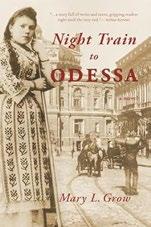

Kirkus Star
The Cathedral Murders
By J.E. Morales
Amen to an absorbing thriller that succeeds on many levels.
By Margo Bowblis
A poignant homage to animals and the psychological ties they forge with human companions.
Mary L. Grow
A beautifully written portrayal of a Ukrainian family that perhaps resonates now more than ever.
Escaping Pygmalion
By R.M. Burgess
A sometimes bleak but wholly absorbing comingof-age story.
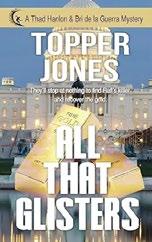

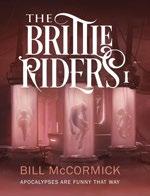

By Topper Jones
A tension-fueled mystery with plenty of twists and two appealing sleuths.

By M.A. Monnin
A romantic mystery that re-energizes its genre.
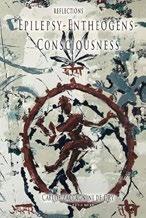
By Bill McCormick
Densely packed, SF-tinged high fantasy that mildly satirizes the genre.

By Amanda Terry Hamm
Inspiring and actionable advice to help readers envision and achieve desired goals.

By Farah Harris
A passionate and richly readable plan for extending the reach of emotional intelligence.
By Carlos Zaccagnini de Ory
An enlightening read for those looking to buck traditional epilepsy treatments in favor of plant-based, spiritual therapies.
By P.G. Kahmann
A well-written, powerful account of trauma and parental love.
By Ryan Wakefield
A colorful fantasy with wondrous characters in a strange land.

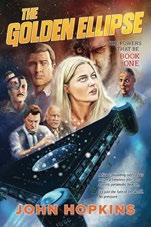
By Joe Klingler
A gripping race-theclock tale featuring savvy female supporting characters and sobering social commentary.
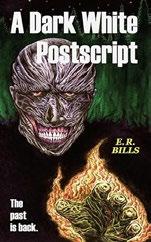
By John Hopkins
A flighty, seriocomic excavation of SF tropes and doomsday conspiracies.

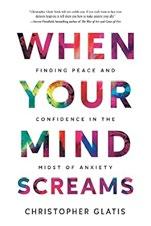
By Christopher Glatis
A well-written, starkly personal look at the toll anxiety can take— and a set of the tools for managing it.
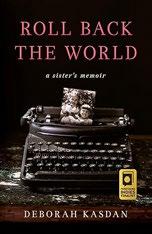
Kirkus Star
By Deborah Kasdan
Intricate and affecting, Kasdan’s debut finds hope in the saddest of stories.
Kirkus Star A Dark White Postscript By E.R.
Bills
A compact, harrowing story of a vengeful curse unleashed.
Ed. by John A. Valenti 3rd & Evelyn Kandel
This diverse collection celebrates the power of poetry, blending emotional unburdening with joyful wordplay.

Max Wants It Quiet!
By Tomi Saga Illus. by Mackenzie Ott
A well-worn tale given new life by sumptuous illustrations.

Galaxy According to CeCe
By Sherry Roberts
Young readers will enjoy this engaging mystery with a complex protagonist.





